This volume includes the dicots known as members of the ast er family, and the monocots - including palms, grasses, lilies, and orchids.
TABLE OF CONTENTS
1 Introduction
2 Asteraceae
3 Anthophyta - the Monocotyledons
4 Alismataceae
5 Arecaceae
6 Araceae
7 Commelinaceae
8 Eriocaulaceae
9 Juncaceae
10 Bromeliaceae
11 Cyperaceae
12 Poaceae
13 Pontederiaceae
14 Liliaceae
15 Iridaceae
16 Agavaceae
17 Smilaceae
18 Dioscoreaceae
19 Orchidaceae
20 References Cited
21 Index
Chapter 1
INTRODUCTION
False Hellebore (Veratrum viride Aiton var. escscholzianum)
This is the third “volume" of my plant travelog. It begins with the aster family (Asteraceae) which is the most complex and evolutionarily advanced of the dicotyledonous plants (two seed leaves) and ends with the orchids (Orchidaceae) the most complex and evolutionary advanced of the monocotyledonous plants (one seed leaf).
Like the previous two volumes, I’ve tried to follow as much as possible the arrangement of plants of Flora of North America and this has been helped significantly by completion of all the volumes encompassing this group of plants.
Also like before, there are inevitably going to be errors in identification - due strictly to me.
Two things stand out to me in this volume. First, I can’t believe I photographed and identified (hopefully correctly) so many members of the aster family (149 species). Second, when I was working on my masters, the lily family was not as large as it is now. DNA analysis has apparently placed a lot more into the family since my graduate days.
Chapter 2
Asteraceae
I never know what to call this family. When I was in graduate school, the old name was Compositae. I learned Asteraceae. When I restarted my interest in taxonomy, most sites used Compositae and as a consequence, organized my photographs accordingly. Flora of North America, volume 19-21 uses Asteraceae but volume 19 was published in 2006.1
I don’t guess it really matters what you call the family but it is one of the larger families of plants in North America if you dedicate three volumes to cover one family of plants as Flora of North America does.
In the three volumes, there are 418 genera, 2,413 species (of which 1,518 are endemic) and 426 considered conservation taxa.2
The name Compositae comes from the “composite” nature of the flowers. Individual flowers are found grouped together into a “head” of flowers. The head is often surrounded by leafy bracts called an involucre. The head of flowers may be a few individual flowers or hundreds of individual flowers.
Flower types in the family fall into two types: disc flowers and ray flowers.
Both flowers have an inferior ovary where the petals, stamens, stigma and style are found above the ovary.
The disc flower has five petals fused for most of their length. Sepals are not present or they may be modified into spines, awns, or pappus. Often the stamens are fused at their anthers. Disc flowers may be either fertile or infertile.

Ray flowers have the petals fused into one large petal which looks like a tongue or spatula.
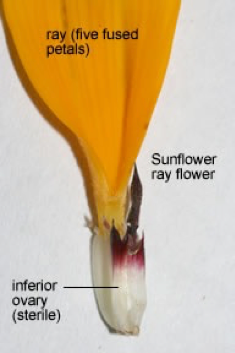
They may also be fertile or infertile. In some genera, the head is composed of disc flowers in the center with ray flowers around the periphery. The disc flowers in this case are often fertile and the ray flowers are often infertile. Think of the sunflower as an example of this.

When fertilized, often by insects, the ovary develops into an achene. An achene is where the seed is loosely attached to the ovary wall only at one point. Again, think of sunflower seeds. The seed “coat” is the ovary wall. The seed within is loose within the ovary.

A lot of the work on the family Asteraceae was done by Arthur Cronquist. I met him once when he visited the herbarium at the University of Mississippi. He was in a hurry and was a little put out when Dr. Pullen asked him to annotate any species he pulled from the herbarium, but he did it anyway. It may have been my comparison with Dr. Pullen, but Cronquist seemed to me to have a bit of an ego. Dr. Pullen later felt he has misidentified several species he annotated.
Basically, an annotation is when someone utilizes a specimen in a herbarium, they confirm the identification, usually by placing an exclamation mark with their name. If they do not confirm the identification, they are supposed to write their identification on the herbarium sheet and then sign their name.
The aster family is complex and one must pay particular attention to numerous features of the plant for identification. You must always examine the involucre, the type of structure at the top of the ovary: pappus, awn, bristle, and determine whether the ray and/or disc flowers are fertile. In order to do this you really need a dissection scope so you can dissect the flower. That’s impractical on camping trips which most of my excursions are.
For that reason, I’m very reluctant to photograph members of the family and only do so when there is a possibility of identification only through the photograph. I assumed, as I began to collate the genera that I would have very few photographs of composites. Wrong! I have photographed 82 genera and 152 species.
For this reason, I’ve put the family in its own volume, sharing with the monocots. Considering Flora of North America published three volumes of the family, I guess I can make one separate volume for the family.
Adenocaulon bicolor Hooker
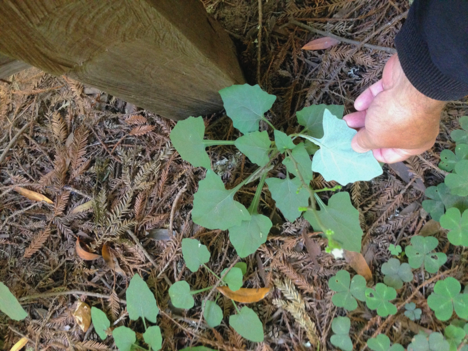 American Trailplant (Adenocaulon bicolor Hooker)
American Trailplant (Adenocaulon bicolor Hooker)
I was introduced to this plant by Tom Martell during his walking tour of Muir Woods. Supposedly, you can mark a trail by twisting a leaf over showing the white undersurface of the plant. Which leaf you turn marks the trail. That presupposes there are a lot of these plants growing in the proper place on the trail. It sounds good in theory but I suspect the practice leads a little to be desired.
I’ve found this in one other place - Mount Hood National Forest near Corbett, Oregon along the Columbia River Gorge - some of the most beautiful scenery in the west.
Carduus pycnocelphalus Linnaeus
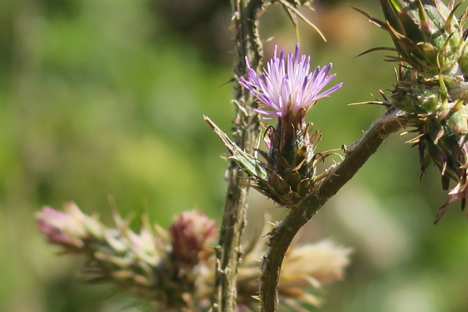 Italian Thistle (Carduus pycnocelphalus Linnaeus)
Italian Thistle (Carduus pycnocelphalus Linnaeus)
First, I have great difficulty distinguishing between the genus Carduus and the genus Cirsium. They look the same to me.
Also, why this is called Italian thistle, I have no idea. I suppose it came from Europe. Perhaps it is so named because I found it in the Italian section of San Francisco - not. Actually, I photographed this on the way up to Twin Peaks.
Most thistles are considered pests in the United States.
 Italian Thistle (Carduus pycnocelphalus Linnaeus)
Italian Thistle (Carduus pycnocelphalus Linnaeus)
As you can see, it has the hairy pappus of many members of the aster family for seed dispersal. They simply float away on the breeze.
Cirsium vulgare (Savi) Ten.

Bull Thistle (Cirsium vulgare (Savi) Ten.)
There are several genera commonly referred to as thistles. I like thistles, partly because it is the national flower of Scotland and I’m part Scottish. I like this particular genus of thistle because it almost sound like my name.
As a Boy Scout, I learned most thistles were edible if you could peel away the spines on the plant. Tricky business, that.
Flora of North America reports 62 species of the genus Cirsium.3 This, to me, is one of the more beautiful thistles. Unfortunately, it is introduced and has spread to all 48 contiguous states and some provinces in Canada and is considered a noxious weed.4
Thistles don’t have ray flowers. Instead, they are all disc although some of the disc flowers can be elongated. What you see in the photograph are numerous purple disc flowers surrounded by a spiny involucre of bracts.
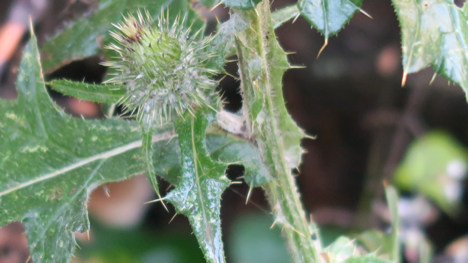
Bull Thistle (Cirsium vulgare (Savi) Ten.)
Even the leaves and stems have spines. In this photo you can see the stem is a bit winged (leaf-like enations on the stem and you can also see the leaves are clasping the stem without a petiole present.
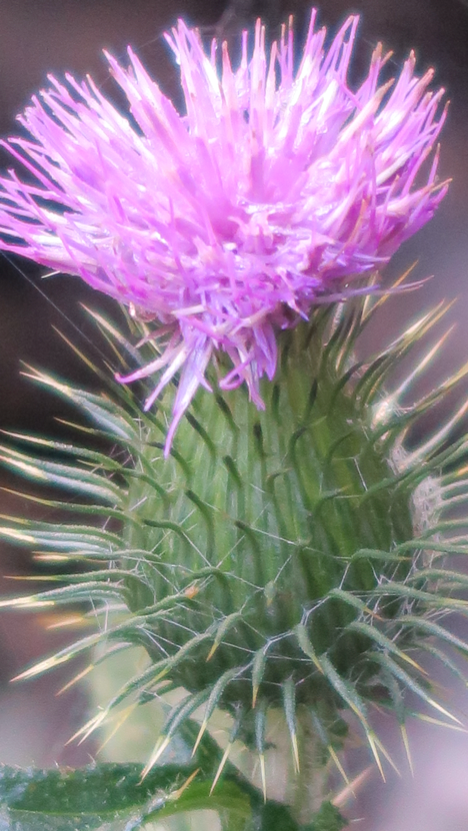
Bull Thistle (Cirsium vulgare (Savi) Ten.)
Note the disc flowers but also look very carefully and you can see some structures projecting from the disc flowers which are bilobed at the tip. That’s the stigma of the pistil.
I was at the start of my hike along Avalanche Lake Trail in Glacier National Park when I came across this beauty. I have to admit, it was hard to look for plants to photograph when the scenery itself was so spectacular.

Avalanche Lake Trail View - Glacier National Park
Cirsium arvense (L.) Scop.
 Canada Thistle (Cirsium arvense (L.) Scop.)
Canada Thistle (Cirsium arvense (L.) Scop.)
Appropriately, I found this in Canada but not before I found it at Mount Rushmore. Like C. vulgare, this is an introduced plant which has become a noxious weed throughout the U.S. and Canada. This one is even found in Alaska.5
To me, it’s not nearly as attractive as C. vulgare.

Canada Thistle (Cirsium arvense (L.) Scop.)
Again, the head is composed entirely of disc flowers.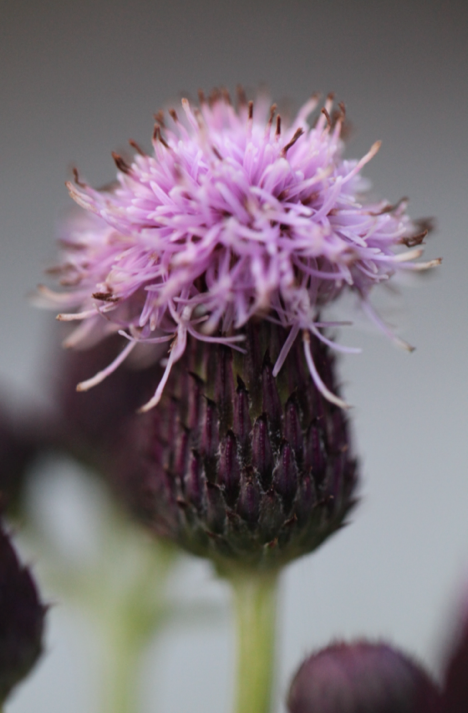 Canada Thistle (Cirsium arvense (L.) Scop.)
Canada Thistle (Cirsium arvense (L.) Scop.)
The stigmas of the pistils are turning a little brown here. This was photographed at Lake Louise in Alberta.
Cirsium horridulum Michx.
 Purple Thistle (Cirsium horridulum Michx.)
Purple Thistle (Cirsium horridulum Michx.)
I think the specific name a little hyperbolic but at least you can definitely see the purple stems. If you look at the involucre on the two previous species, the bracts are not lobed. On this one, you can see the bracts are distinctly lobed.
I’m always amazed to find thistles pretty much anywhere I travel in the United States and Europe. Typically they like open places like fields and roadsides but I’ve also found them deep in the woods.
This particular one was along the roadside at Lake George State Forest near De Leon Springs, Florida.
Cirsium nuttallii DC.
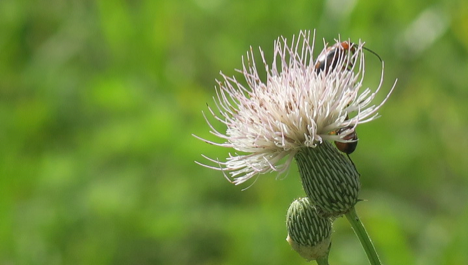 Nuttall’s Thistle (Cirsium nuttallii DC.)
Nuttall’s Thistle (Cirsium nuttallii DC.)
Here again, the involucre is unlobed bracts. The flower color in thistles can be highly variable but I see a bit of pink in this one.
 Nuttall’s Thistle (Cirsium nuttallii DC.)
Nuttall’s Thistle (Cirsium nuttallii DC.)
I was lucky to find one in flower and one in fruit on the same plant. Note the tufted achenes. Each tuft contains tiny hairs arranged like the barbs on a feather. The technical term is plumose. The tufts carry the achene on the breeze and then drops it down as the breeze stops - an excellent means of seed dispersal but one that strews the seeds on one direction only.
This particular one was photographed on the River Trail at Silver Springs State Park at Silver Springs, Florida.
Cirsium neomexicanum A. Gray
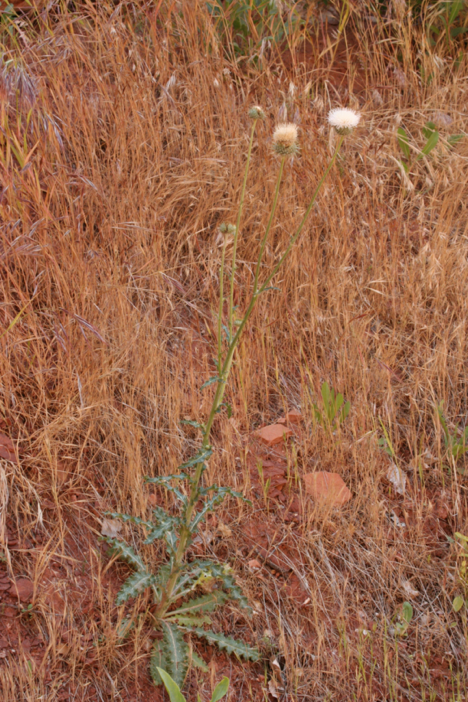
New Mexico Thistle (Cirsium nemomexicanum A. Gray)
This is a southwestern species as you might assume from both the common name and scientific name and indeed, I photographed it along the roadside of Zion National Park.

New Mexico Thistle (Cirsium nemomexicanum A. Gray)
I like the powder puff effect of the head of flowers on this one.
The nice thing about Zion is that even the roadside has spectacular views of the canyon.

Roadside View of Zion Canyon
Cirsium occidentale (Nuttall) Jepson
 California Thistle (Cirsium occidentale (Nuttall) Jepson)
California Thistle (Cirsium occidentale (Nuttall) Jepson)
I’ve probably mentioned the difficulty I’ve had in distinguishing between the genus Carduus and Cirsium. This is one of the reasons. This was at one time named Carduus occidentalis. I suspect a lot of what I learned as Carduus is no longer in that genus.
The common name is appropriate since I found it at Lands End in San Francisco.
Cirsium arizonicum (A. Gray) Petrak var. bipinnatum (Eastw.) D.J. Keil)

Cardimine Thistle (Cirsium arizonicum (A. Gray) Petrak var. bipinnatum (Eastw.) D.J. Keil)
I usually don’t do varieties of plants without the aid of a dissection scope but I apparently found a source somewhere that allowed this distinction. I suspect I found a checklist of plants of the Grand Canyon North Rim.
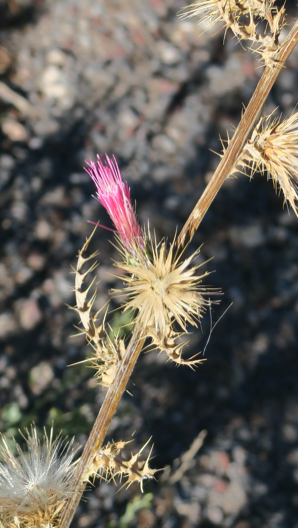
Cardimine Thistle (Cirsium arizonicum (A. Gray) Petrak var. bipinnatum (Eastw.) D.J. Keil)
This was at the end of its life (gone to seed) and I suspect it could be more attractive earlier in the year but this thistle didn’t inspire my Scottish roots.
Cirsium scariosum Nuttall
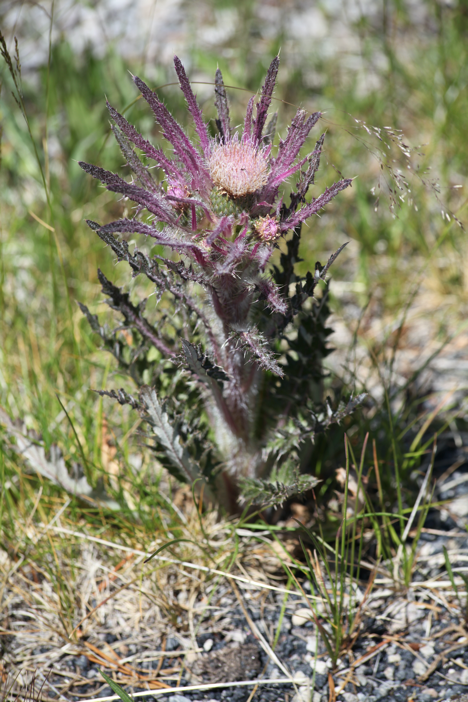
Elk Thistle (Cirsium scariosum Nuttall)
Flora of North America has this as a highly variable species with 10 varieties, all in the western U.S. and Canada.6 I photographed it in Upper Geyser Basin of Yellowstone National Park. I wonder if the short size of the plant has anything to do with growing in an area where the soil is extremely hot from geyser activity.
It could also be that the plant was grazed by either bison or elk within the park.
Centaurea stoebe L. subsp. micranthos(S.G. Gmelin ex Gugler) Hayek
 Spotted Knapweed (Centaurea stoebe L. subsp. micranthos(S.G. Gmelin ex Gugler) Hayek)
Spotted Knapweed (Centaurea stoebe L. subsp. micranthos(S.G. Gmelin ex Gugler) Hayek)
The only reason I can give subspecies here is this is the only species/subspecies found in North America. This is an introduced species from Europe and DNA analysis indicates this is the same one from Europe.7
I photographed this while waiting for the helicopter at Spillimacheen, British Columbia. The helicopter was waiting to whisk us away to the Bugaboo Lodge for three days of hiking in the Columbia Mountain Range. The Columbia River flowed near by.
Notice there aren’t any visible spines on the stems or leaves.
Elephantopus tomentosus Raeuschel
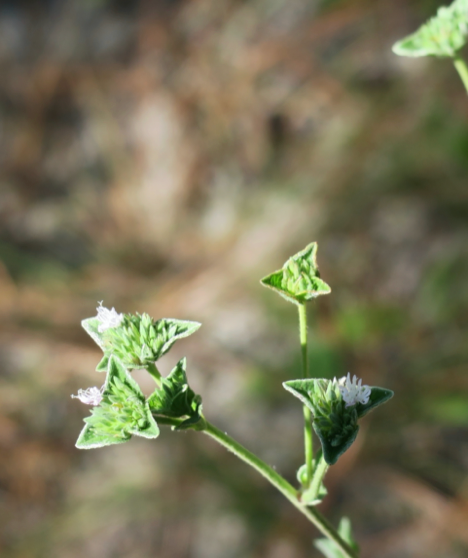 Elephant’s Foot (Elephantopus tomentosus Raeuschel
Elephant’s Foot (Elephantopus tomentosus Raeuschel
Another soft spot in my heart. I collected two species of Elephantopus during my Tishomingo days: E. carolinianus and E. tomentosus.8 I was startled to find it at Torreya State Park near Bristol, Florida. The plant is so distinctive that after all the intervening years, I was able to recognize the plant immediately.
What stands out to me in the plant are the three large deltoid bracts underneath the head of flowers. The specific term tomentosus comes from the hairs or trichomes that cover the plant.
 Elephant’s Foot (Elephantopus tomentosus Raeuschel
Elephant’s Foot (Elephantopus tomentosus Raeuschel
The flowers are disc flowers but there is more of the five petals showing than typical in most disc flowers.
You may wonder why it is called elephant’s food. When the plant is in bloom, most of the leaves are found on the stem. However, when it starts out in the spring of the year, there’s a basal rosette of leaves.
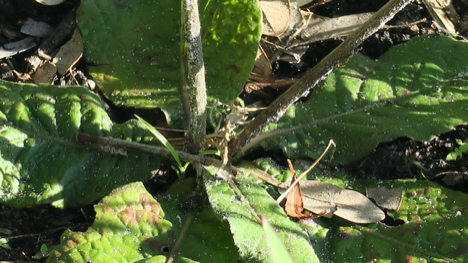 Elephant’s Foot (Elephantopus tomentosus Raeuschel
Elephant’s Foot (Elephantopus tomentosus Raeuschel
The leaves are quite large and taken all together one might be led to think of an elephant’s foot print.
Cichorium intybus L.

Chicory (Cichorium intybus L.)
My introduction to chicory was on my first trip to New Orleans to visit my cousin Jo with her sister Jimmie. It was at Cafe du Monde off Jackson Square in the French Quarter and I had the coffee with chicory and beignets. I still love both. I still stop in every time I am in New Orleans
I will admit to a learning curve with coffee with chicory. I really became addicted when I was stationed at the Communications Station in New Orleans for two years.
The leaves of this plant have long been used as salad greens and, of course, everyone from the south knows the story of the siege of Vicksburg where the citizens of the town used roasted, ground chicory roots for a coffee substitute.
I found this growing on the Sand Hill Trail at Silver Springs State Park. It was the first time I’ve ever found the plant in the wild.
Note that the flower is composed of all ray flowers. There are no disc flowers in chicory.
Crepis atribarba A. Heller

Slender Hawksbeard (Crepis atribarba A. Heller)
This is another example of all ray flowers in the head. I was hiking the Rimrock Trail at Black Canyon of the Gunnison National Park when this jumped out at me. I would normally have left it alone and not photographed it due to the difficulty in identification but something told me it was unique enough I would be able to identify it.

Slender Hawksbeard (Crepis atribarba A. Heller)
I was able to find it on a web site specific to the Black Canyon of the Gunnison. It’s hard to tell in the first photograph, but the leaves are rather linear.
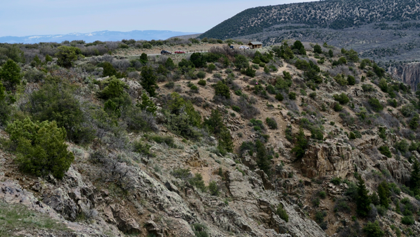
Rim Rock Trail - Black Canyon of the Gunnison National Park
Taraxacum officinale F.H. Wiggers
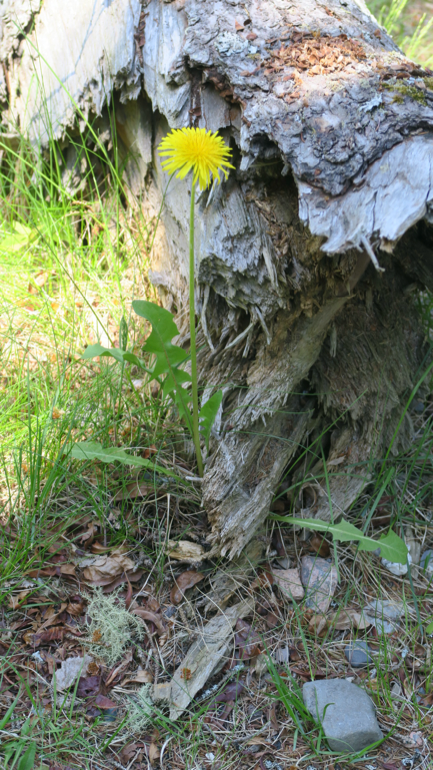
Dandelion (Taraxacum officinale F.H. Wiggers)
I cannot think of a place I’ve been on this planet that I haven’t run into dandelions. T. officinale is the most abundant species of Taraxacum in North America9 and it’s still a welcome sight. Probably the most I’ve seen anywhere is in Minnesota and Michigan where it seems to take over the lawns.
The leaves can be cooked like spinach or eaten raw like a salad. Then, of course, there’s dandelion wine.
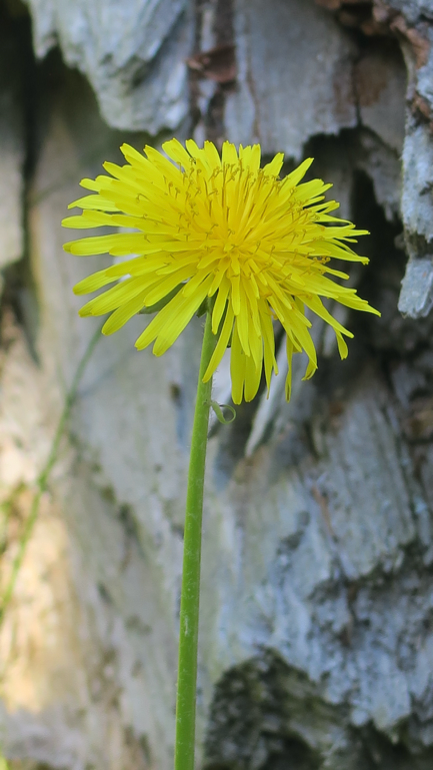
Dandelion (Taraxacum officinale F.H. Wiggers)
I really like how the bilobed stigma of the pistil sticks out from the ray flowers.

Dandelion (Taraxacum officinale F.H. Wiggers)
I still admit to the pleasure of blowing the seed pods of the stem.
Youngia japonica (Linnaeus) de Candolle
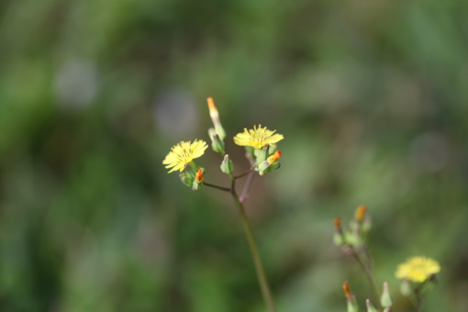 Asiatic Hawksbeard (Youngia japonica (Linnaeus) de Candolle)
Asiatic Hawksbeard (Youngia japonica (Linnaeus) de Candolle)
As you might guess from the common name, this is not native to the United States and has become somewhat of a weed, particularly in my lawn. I have to admit I don’t mind it too much. It has a nice flower and it produces a very small seed head much like dandelions.
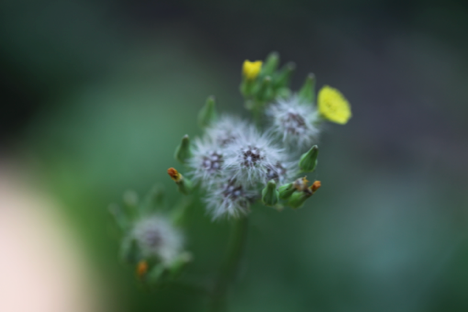 Asiatic Hawksbeard (Youngia japonica (Linnaeus) de Candolle)
Asiatic Hawksbeard (Youngia japonica (Linnaeus) de Candolle)
There’s a basal rosette of leaves at the bottom of the stem.
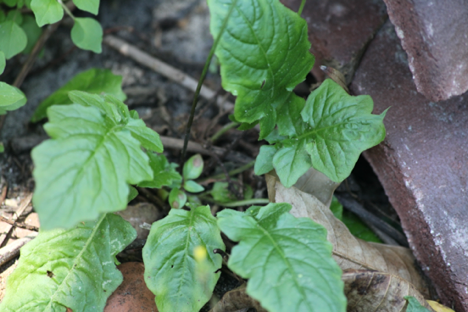 Asiatic Hawksbeard (Youngia japonica (Linnaeus) de Candolle)
Asiatic Hawksbeard (Youngia japonica (Linnaeus) de Candolle)
Other than my yard, I also found it at De Leon Springs State Park near De Leon Springs, Florida.
Sonchus arvensis L.
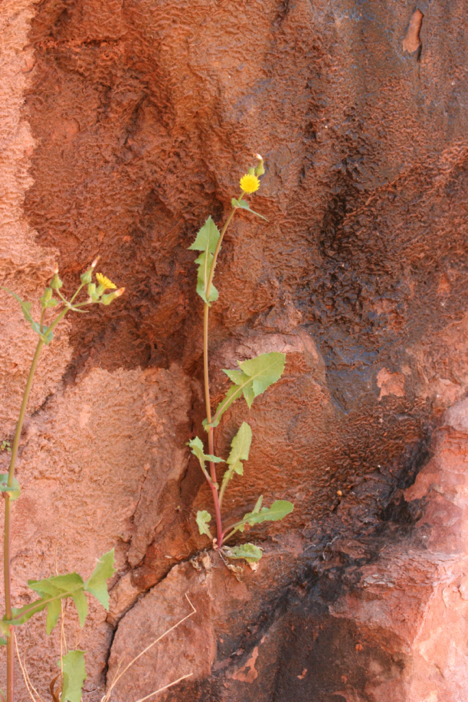 Sowthistle (Sonchus arvensis L.)
Sowthistle (Sonchus arvensis L.)
Look how the leaves clasp the stem of the plant. The technical description is auricular (ear-like projection). This plant has been declared a noxious weed in several states. It was introduced from Europe and has a wide distribution across the U.S. and Canada.10
 Sowthistle (Sonchus arvensis L.)
Sowthistle (Sonchus arvensis L.)
All the flowers in the head are ray flowers. A lot of people will confuse this with dandelions and it even produces a head of seed similar to dandelions.
This was photographed at Zion National Park.
Sonchus asper (L.) Hill

Sowthistle (Sonchus asper (L.) Hill)
At first glance, this looks similar to S. arvense but this is a much taller plant.
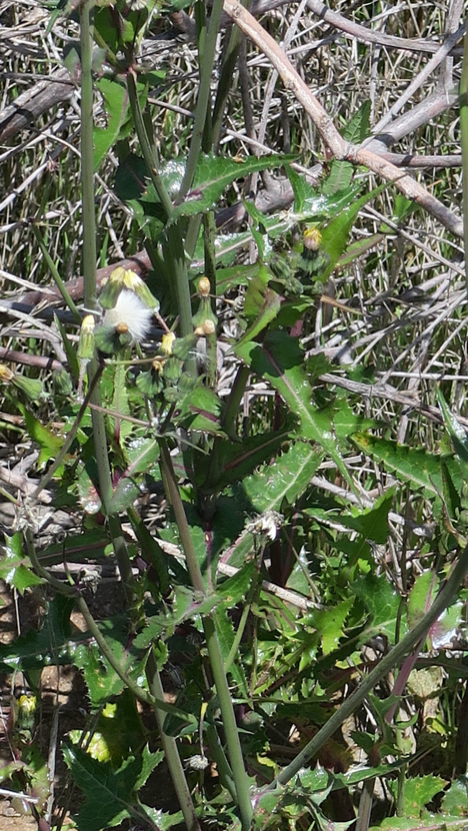 Sowthistle (Sonchus asper (L.) Hill)
Sowthistle (Sonchus asper (L.) Hill)
The leaves and stems are a little more robust and the leaves actually curve around the stem, more so than in S. arvensis.
Like S. arvensis, it is introduced and widely spread across the U.S. and Canada.11
This was growing along the Cavern Point Trail on Santa Cruz Island in Channel Islands National Park.
Hieracium gronovii L.
 Gronovius’ Hawkweed (Hieracium gronovii L.)
Gronovius’ Hawkweed (Hieracium gronovii L.)
I think you can begin to see how all these aster family members begin to seem alike. This plant has most of its leaves on the stem and typically doesn’t have a basal rosette of leaves.
 Gronovius’ Hawkweed (Hieracium gronovii L.)
Gronovius’ Hawkweed (Hieracium gronovii L.)
I was a little unsure about this identification but it’s the only species of Hieracium reported at Archbold Biological Station. I photographed it in April of 2016 along the nature trail.
Hieracium albiflorum Hooker

White-flowered Hawkweed (Hieracium albiflorum Hooker)
Most Hieracium are yellow flowered so this really drew my attention. The only way I new it was Hieracium were by the leaves and the head of all ray flowers.

White-flowered Hawkweed (Hieracium albiflorum Hooker)
You can see the leaves have tiny hairs along the edge of the leaves. There are also some among the heads of the unopened flowers. This was photographed along the trail to Avalanche Lake in Glacier National Park. As you can tell from the photos, I was having a little trouble with the lens fogging over and therefore with focus.
Hieracium venosum L.
 Rattlesnake Hawkweed (Hieracium venosum L.)
Rattlesnake Hawkweed (Hieracium venosum L.)
Two things stand out to me with this plant. First is the basal rosette of purplish tinged leaves and second, there are no leaves on the stem. The only reason I can come up with the common name is this is in mountainous area of North Carolina and it could be you find rattlesnakes in the area. Who knows?
 Rattlesnake Hawkweed (Hieracium venosum L.
Rattlesnake Hawkweed (Hieracium venosum L.
If you look carefully at an individual ray flower, you can count five lobes (notches at the apex) for each flower. That shows that ray flowers are simply highly modified disc flowers which also have five lobes.
 Rattlesnake Hawkweed (Hieracium venosum L.
Rattlesnake Hawkweed (Hieracium venosum L.
The other thing to note is the size of the hairs on the basal leaves. They are really obvious in this species.
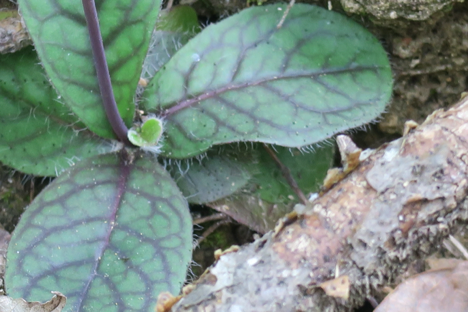 Rattlesnake Hawkweed (Hieracium venosum L.
Rattlesnake Hawkweed (Hieracium venosum L.
Hieracium triste Wildenow ex Sprengel
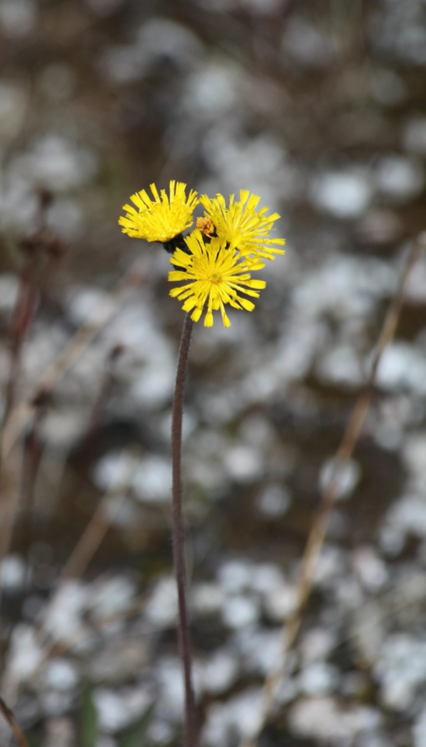
Hawkweed (Hieracium triste Wildenow ex Sprengel)
I goofed on the original identification of this plant. I originally identified it as H. froelichianum. There is no such plant in Flora of North America. Sometimes, I like a challenge. I thumbed through Hieracium in the Flora and found 11 species where I photographed this.12 I was able to finally narrow it down to H. triste using the distribution maps provided by the Flora.
I’ll put my original identification down to altitude sickness since I photographed this at around 9,000 feet.
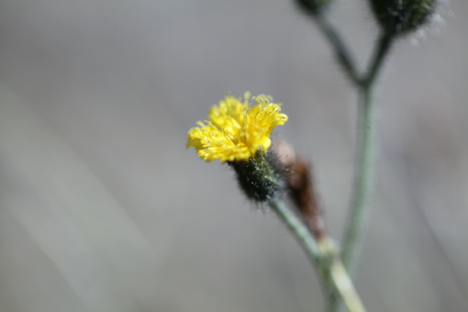 Hawksbeard (Hieracium triste Wildenow ex Sprengel)
Hawksbeard (Hieracium triste Wildenow ex Sprengel)
One of the features that allowed me to make the current identification was the really hairy involucre surrounding the ray flowers.
This was photographed on Black Forest Peak in the Bugaboos, British Columbia.
Tragopogon dubius Scopoli
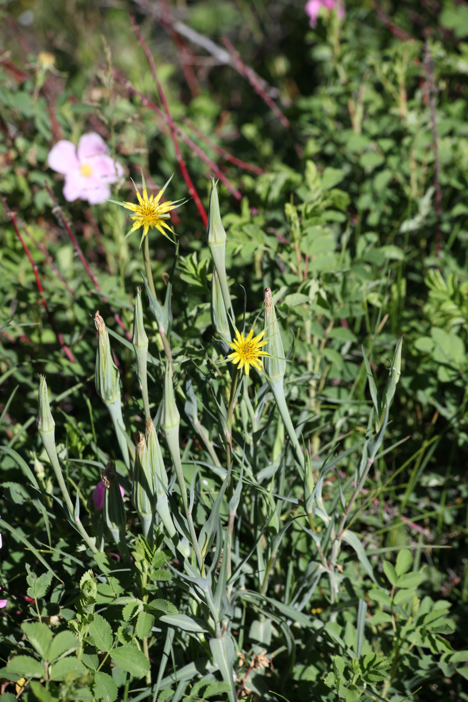 Goat’s Beard (Tragopogon dubius Scopoli)
Goat’s Beard (Tragopogon dubius Scopoli)
There are only six states that this plant has not been reported: Alaska, Mississippi, Alabama, Georgia, South Carolina and Florida.13 No wonder I was not familiar with it. I’ve never been to Alaska (here’s hoping) and although I’ve been in all the other states except Rhode Island and Hawaii, I only saw this for the first time on my first westward trip with Tauck. I first found it in the Upper Geyser Basin of Yellowstone and then on Signal Mountain in Grand Teton. Since then, I’ve run into it in Spillimacheen, British Columbia in the Bugaboos.
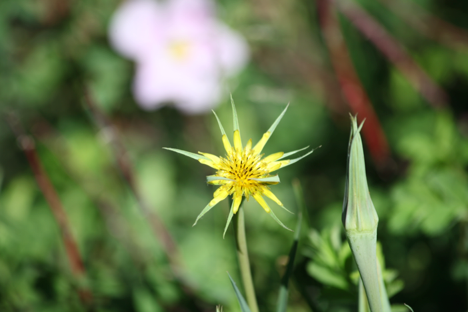 Goat’s Beard (Tragopogon dubius Scopoli)
Goat’s Beard (Tragopogon dubius Scopoli)
The immediate attraction, of course is the flower head. The involucre exceeds the petals by a considerable amount. The individual flowers of the head are all ray flowers.
 Goat’s Beard (Tragopogon dubius Scopoli)
Goat’s Beard (Tragopogon dubius Scopoli)
It also produces a very large “puff” of seeds, much larger than any dandelion has tried to produce. Each achene (fruit that contains a seed) has a long beak with tufts of hairs at the apex of the beak.
Malacothrix saxatilis (Nutt.) Torr. & A. Gray
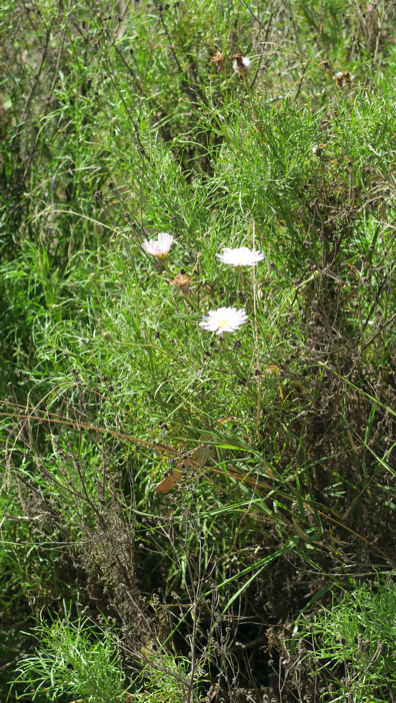
Cliff Desert Dandelion (Malacotrhix saxatilis (Nutt.) Torr. & A.Gray)
Members of this genus are distinctly western in distribution.14 My one and only experience with this genus came at Santa Cruz Island in Channel Islands National Park. Sadly, in September of 2019, Santa Cruz Island was the scene of a terrible fire on a diving boat off shore that killed 34 people - one crewman and 33 divers who were below decks at the time the fire broke out. As I mentioned before, the time I was there an earthquake occurred. I wonder if the island is jinxed.
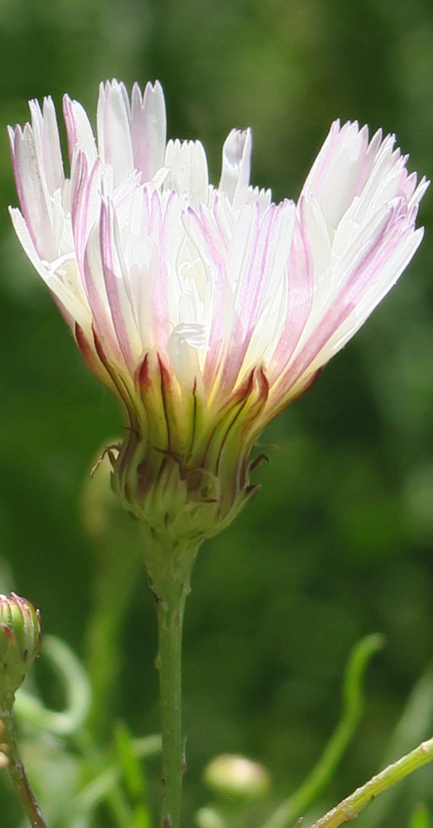
Cliff Desert Dandelion (Malacotrhix saxatilis (Nutt.) Torr. & A.Gray)
This species was like a shrub and was scattered over the island. I saw most of them on the trail to Smugglers Cove. The head is composed of ray flowers only.

Cliff Desert Dandelion (Malacotrhix saxatilis (Nutt.) Torr. & A.Gray)
It’s really hard to tell from the first photograph but the leaves are pinnately dissected and each dissection is almost needle-like. I had a hard time figuring the leaf structure at first glance.
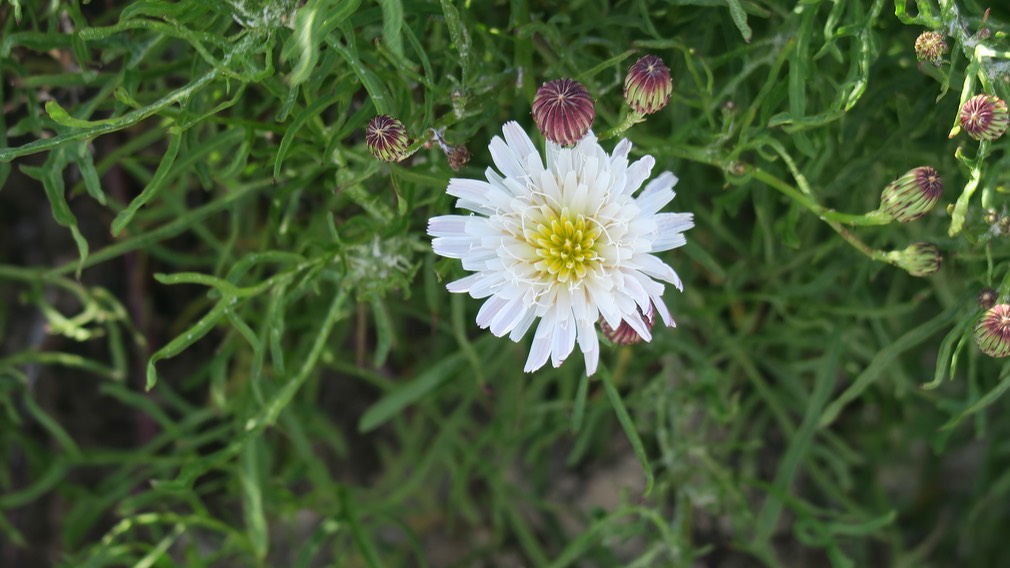
Cliff Desert Dandelion (Malacotrhix saxatilis (Nutt.) Torr. & A.Gray)
Agoseris glauca (Pursh) Rafinesque

Pale Agoseris (Agoseris glauca (Pursh) Rafinesque)
There are several genera that give me trouble in identification. It didn’t used to but since I’ve been so far removed from plant identification when I taught at Broward College, I have trouble with distinguishing among Agoseris, Crepis, and Krigia. Superficially, they all look the same to me. It’s only when I begin to work through identifications that it makes any sense to me.
One feature of Agoseris is there are usually no leaves on the stem. All the leaves are typically at the base in a rosette.
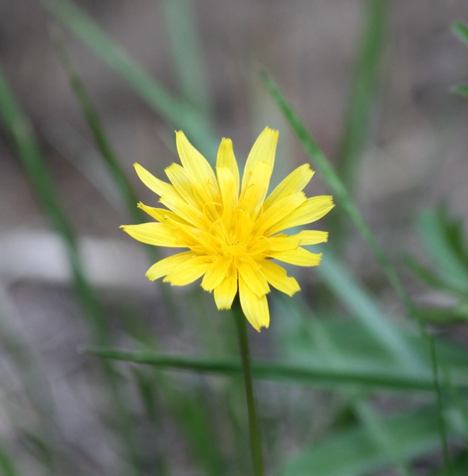
Pale Agoseris (Agoseris glauca (Pursh) Rafinesque)
Like Malacothrix, Agoseris is a western species15 and I didn’t really get exposed to it in graduate school. That could be one of the reasons for my confusion. This is another one of those ray flowers that it is easy to see the ray is made of five fused petals (note the ends of the rays).
I’ve photographed this in Haden Valley of Yellowstone, and the Castle Crest Nature Trail of Crater Lake.
Agoseris aurantiaca (Hooker) Greene
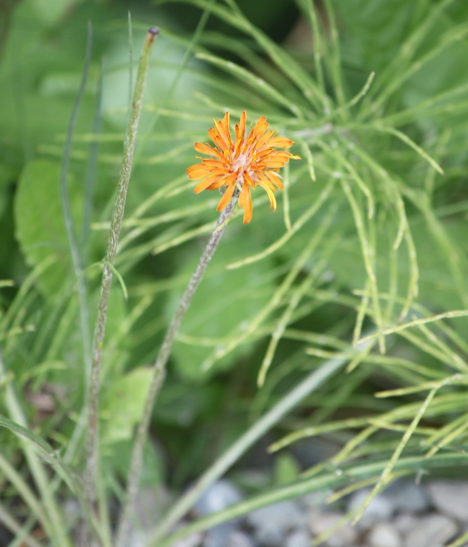 Orange Agoseris (Agoseris aurantiaca (Hooker) Greene)
Orange Agoseris (Agoseris aurantiaca (Hooker) Greene)
Well, this was a pretty easy one to identify. Most Agoseris are yellow in color. You can’t miss the orange against a green background. It’s almost international orange in color.
This was standing alone at Moraine Lake in Yoho National Park, Alberta.
Rafinesquia neomexicana A. Gray
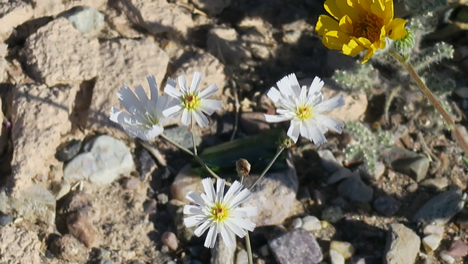 Desert Chicory (Rafinesquia neomexicana A. Gray)
Desert Chicory (Rafinesquia neomexicana A. Gray)
I assume this plant is named in honor of Constantine Samuel Rafinesque who is responsible for 6,700 binomial names of plants, many in the U.S. (Wikipedia)
Desert chicory is a good name for this since I found it along the roadside of Death Valley National Park. I can only assume you could make a coffee substitute with it but I would be a little hesitant since a lot of western flowers accumulate chemical compounds from the soils. The pot of coffee might finish you.
 Desert Chicory (Rafinesquia neomexicana A. Gray)
Desert Chicory (Rafinesquia neomexicana A. Gray)
I didn’t find too many white flowers in the desert. In the background you can see the more common yellow wildflowers. Also notice how distinct the stigma and style is of the pistil of each ray in the desert chicory.
Krigia virginica (L.) Willdenow

Dwarf Dandelion (Krigia virginica (L.) Willd.)
During my days at Tishomingo, I collected four species of Krigia: K. biflora, K. dandelion, K. oppositifolia, and K. virginica,16 so it was good to see an old friend at Manatee Springs State Park near Chiefland, Florida. This photograph may be a little misleading. The Krigia has a basal rosette of leaves but not the leaves in the foreground. That is the winter stage of the grass Panicum.
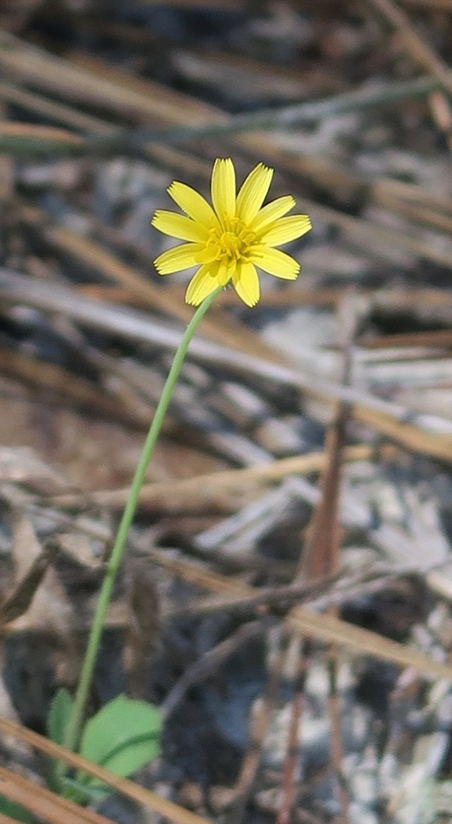
Dwarf Dandelion (Krigia virginica (L.) Willd.)
Again, the head is composed of all ray flowers. This was one of the few wildflowers in bloom in the Manatee Springs State Park. Most of what I photographed that day were not in the park but on the Nature Coast bike trail. For some reason, the wildflowers in the park were about two weeks behind. I assume because the bike trail got more sun.
Pyrrhopappus carolinianus (Walter) deCandolle
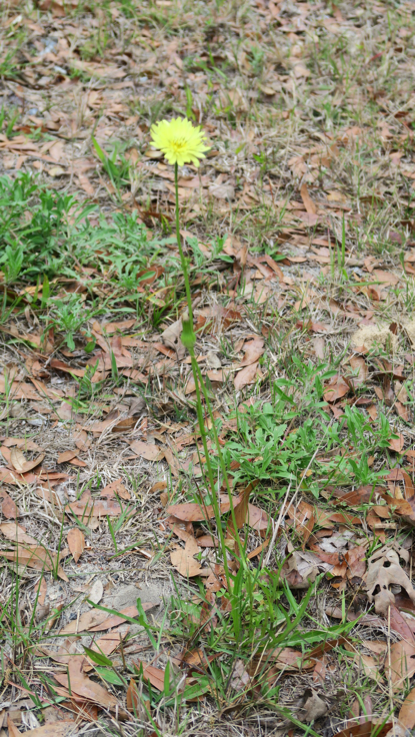
False Dandelion (Pyrrhopappus carolinianus (Walter) de Candolle)
I’m not sure if you can see the basal leaves in this photograph but they definitely look dandelion-like. It’s when you look at the head you begin to see the difference between it and Taraxacum officinale.
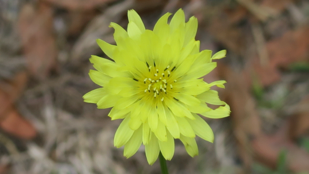

P. carolinianus on the top, T. officinale on the bottom
First and foremost, there are many more numerous ray flowers on the dandelion head. Also, the ray flowers on P. carolinianus are more delicate - almost paperlike.

False Dandelion (Pyrrhopappus carolinianus (Walter) de Candolle)
Regardless, it is a beautiful flower. This was photographed on the Nature Coast bike trail from Chiefland, Florida to Fanning Springs, Florida.
Antennaria dimorpha (Nuttall) Torrey & A. Gray

Low Pussytoes (Antennaria dimorpha (Nuttall) Torrey & A. Gray)
Members of the genus Antennaria are commonly called pussytoes. In a sense, they do resemble the furry toes of kitty cats. Some are probably representative of Papa Hemingway’s six toed cats with their cluster of heads of ray flowers.
In Tishomingo, I collected A. plantaginifolia and A. solitaria.17 Flora of North America states there are two major groups. One is mostly western U.S. and the other is North and South America, in general.18 That’s been my experience. I have photographed six western species and most of those were in one place: Black Canyon of the Gunnison National Park.
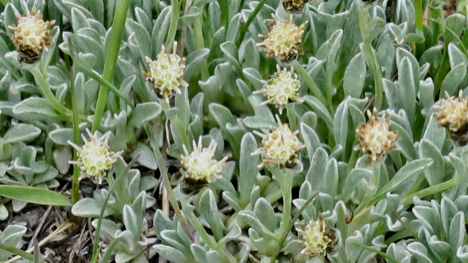
Low Pussytoes (Antennaria dimorpha (Nuttall) Torrey & A. Gray)
What’s interesting about this particular species is there is but a single head of flowers on the stem. If you look carefully, there are no ray flowers here but all disc flowers. What you see sticking above each disc is the stigma and style of the pistil. These were growing on the trail to Pulpit Rock Overlook.
Antennaria lantana (Hooker) Greene
 Wooly Pussytoes (Antennaria lantana (Hooker) Greene)
Wooly Pussytoes (Antennaria lantana (Hooker) Greene)
As you can see here, there are multiple heads on each stem on this species as opposed to the singular head on the previous species. There are some stem leaves present but they are much reduced in size. Most of the leaves are as a basal rosette.
The shape of the leaf is said to be obovate which means it is broader toward the apex than toward the middle.
I photographed these in a couple of places in the Bugaboos.
Antennaria neglecta Greene
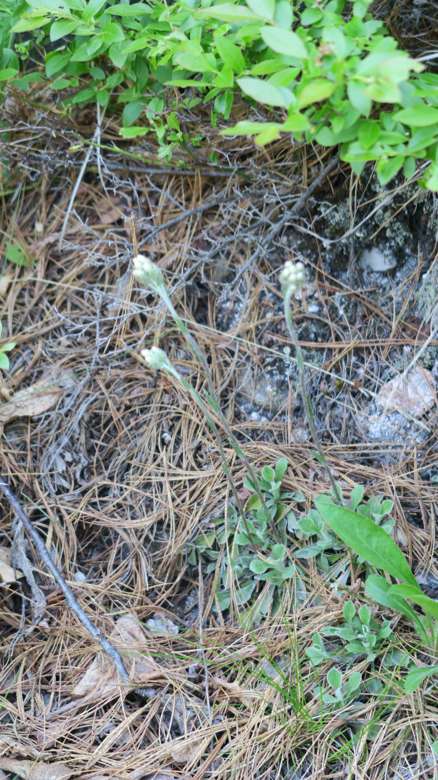
Field Pussytoes (Antennaria neglecta Greene)
All species of pussytoes are pretty innocuous unless you are looking for them. They tend to blend in to the background, particularly those with basal rosettes (most species). These do have very small leaves on the stem - more lance-like in shape.

Field Pussytoes (Antennaria neglecta Greene)
These are not fully opened as yet but it gives you a good idea of the stem leaves. Also note how hairy the stems and leaves are.

Field Pussytoes (Antennaria neglecta Greene)
The most distinctive thing about these are their leaves. The term is oblanceolate which means they start out thin at the base and the the apex swells to a large blade. More significant in this image is the point on the apex of the leaves.
This is one of the few eastern species I came across. I photographed it on the South Bubble Trail at Acadia National Park.
Antennaria parvifolia Nuttall
 Common Pussytoes (Antennaria parvifolia Nuttall)
Common Pussytoes (Antennaria parvifolia Nuttall)
Even though it is called “common” it is found mostly in the western U.S. and Canada.19 Notice how most of the leaves are in-rolled to form a “V” shape. I found these in two separate locations in Black Canyon of the Gunnison: Devil’s Overlook and Rimrock Trail
Antennaria microphylla Rydberg

Small-leaf Pussytoes (Antennaria microphylla Rydberg)
The leaves are, indeed, very small in comparison to other species. It’s almost like they form a green mat on the ground.
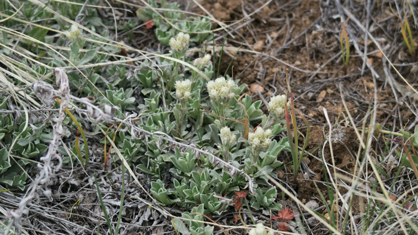
Small-leaf Pussytoes (Antennaria microphylla Rydberg)
There are multiple heads for each stem and the leaves are very hairy on both surfaces. I’ve photographed this species in two very different locations: Black Canyon of the Gunnison and Yellowstone.
Antennaria rosea Greene

Rosy Pussytoes (Antennaria rosea Greene)
You can see a little rose color on these before they open completely.

Rosy Pussytoes (Antennaria rosea Greene)
Others have no pink associated with them at all. It’s a confusing species with at least four subspecies listed in Flora of North America. In addition, it is considered the most widespread Antennaria in North America even though it is not found east of the Mississippi.20
I photographed these in June of 2015 at Crater Lake. This was the first of my three visits to the park.
Anaphalis margaritacea (L.) Bentham & Hooker f.
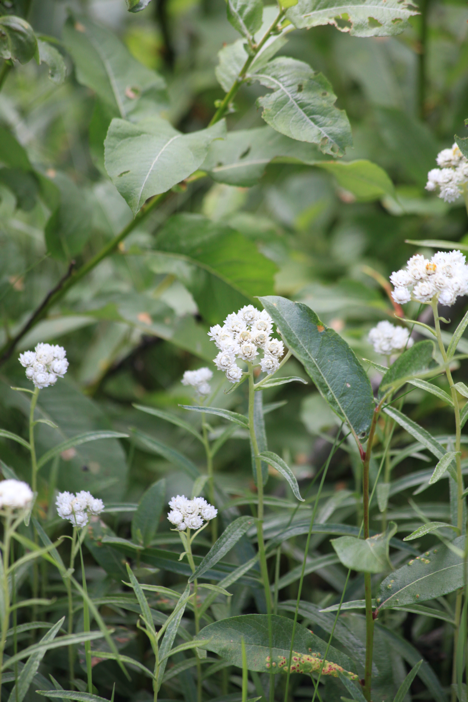 Pearly Everlasting (Anaphalis margaritacea (L.) Bentham & Hooker f.)
Pearly Everlasting (Anaphalis margaritacea (L.) Bentham & Hooker f.)
I first saw this plant in August of 2015 at Takakkaw Falls in Yoho National Park in British Columbia. Little did I know I would see it over and over again in numerous locations. It has escaped and become naturalized in the U.S. and Canada and there are only six states in the southeast where it has not been reported: Louisiana, Mississippi, Alabama, Georgia, Florida, and South Carolina.21
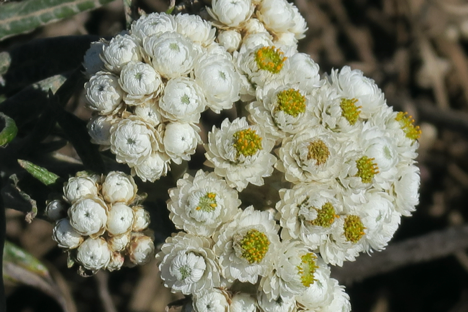 Pearly Everlasting (Anaphalis margaritacea (L.) Bentham & Hooker f.)
Pearly Everlasting (Anaphalis margaritacea (L.) Bentham & Hooker f.)
I assume the common name is due to finding these pretty much in spring, summer and fall and even remnants in winter. The flowers are disc in nature but have a paper-like quality to them. The head is unisexual with male flowers in the center and pistillate flowers on the periphery.22
One of my favorite photos is the cluster of heads with a thin coating of ice all over the plant showing they do last quite a while.
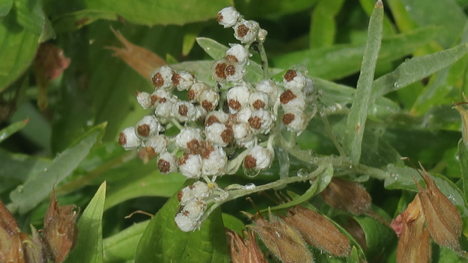 Pearly Everlasting (Anaphalis margaritacea (L.) Bentham & Hooker f.)
Pearly Everlasting (Anaphalis margaritacea (L.) Bentham & Hooker f.)
This particular photo was taken at Crater Lake in September of 2016. It snowed the night before.
Pterocaulon pyncnostchyum (Michx.) Elliott
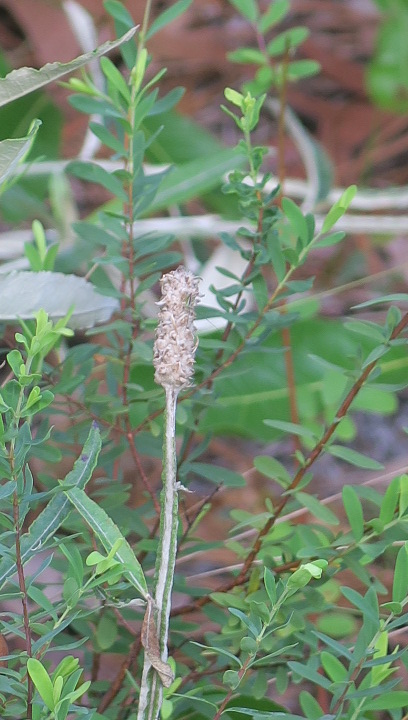
Blackroot (Pterocaulon pycnostachyum (Michx.) Elliott)
The most interesting thing about this plant to me is the winged stems. The flowers are disc flowers but they are so crowded on the head you really can’t make out much detail in the field.
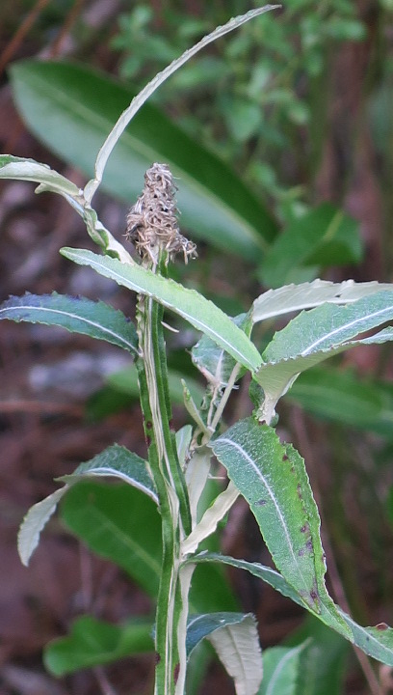
Blackroot (Pterocaulon pycnostachyum (Michx.) Elliott)
It was my first experience with this plant at Silver Springs State Park and I knew it might be difficult to identify. The winged stems are key along with the toothed leaves.
I assume it is called blackroot for a reason but I have not been able to find why. In both photos, the flowers are a little past their prime.
Pluchea odorata (L.) Cassini
 Camphorweed (Pluchea odorata (L.) Cassini)
Camphorweed (Pluchea odorata (L.) Cassini)
Back in the day, I collected P. camphorata at Tishomingo23 and when I crossed paths with this, I knew the genus. I was pleased to realize it was P. odorata, a close kin and one that Flora of North America suggests hybridizes with P. camphorata.24
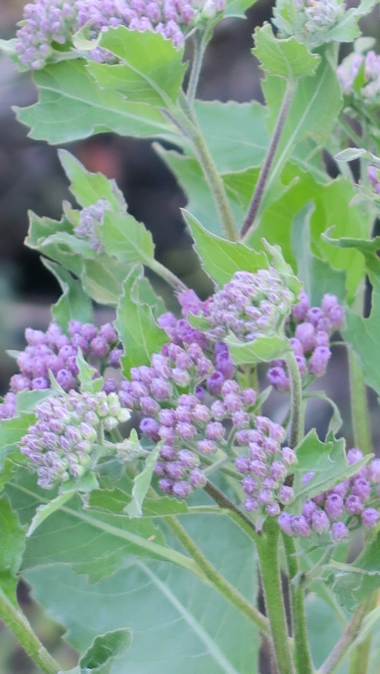
Camphorweed (Pluchea odorata (L.) Cassini)
I did not squeeze a leaf to see if there is a camphor smell but P. camphorata in Tishomingo did have an aroma. Camphor comes from Cinnamomum caphora, not this plant (Wikipedia). Still, I wonder if it could be used as a substitute.
One of the things we had in our medicine chest when I was young was a bottle of Campho-Phenique. We used it as an anti-itch medicine against mosquito bites and redbug bites. I still keep a bottle on my medicine shelf for that very purpose.
Achillea millefolium L.
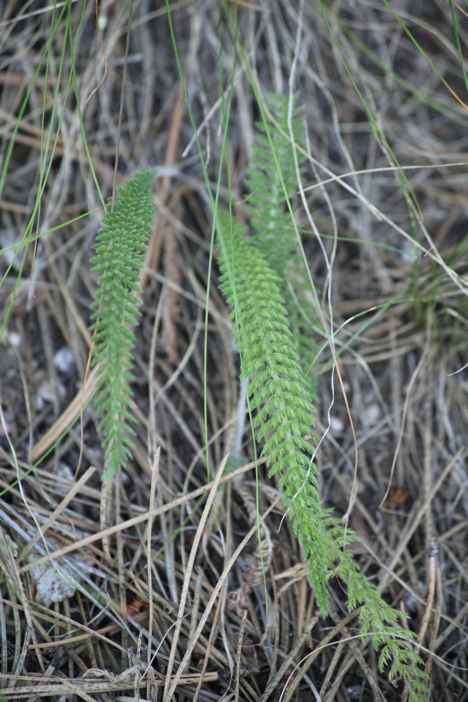 Yarrow (Achillea millefolium L.)
Yarrow (Achillea millefolium L.)
A lot of people are impressed when someone has a little knowledge of plants. I put that down to so few teachers in K-12 having any botany in their background. This is one plant you can impress with your instant identification. I know of no other plant that produces a leaf like this.
Throughout history, this little plant has had many uses (Wikipedia) but I just love the look of the plant. However, I have an ongoing war with the plant in that I never seem to get a decent photo of the flowers. The head of flowers are white and to me, white is one of the most difficult things to photograph in nature, particularly in sun.

Yarrow (Achillea millefolium L.)
The ray flowers are on the outer edge of the head and the disc flowers are in the center. A lot of times, the ray flowers are infertile but in this case, they generally are fertile.25
This has to be one of the most common roadside plants anywhere in North America - along with Queen Anne’s Lace.
Artemisia tridentata Nuttall
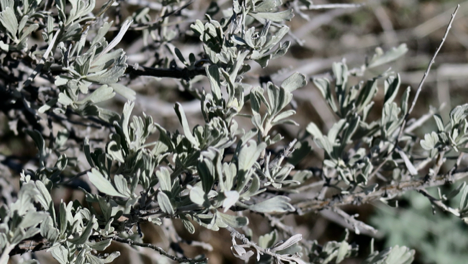
Big Sagebrush (Artemesia tridentata Nuttall)
There are 50 species of sagebrush in North America26 and I generally steer clear of trying to identify these plants but some are easier than others and then there are those that signs next to them.
I think you can see why this is called A. tridentata with the three “teeth” at the apex of each leaf.

Big Sagebrush (Artemesia tridentata Nuttall)
I’ve never seen it as a “big” plant but it certainly is abundant out west. There are ray and disc flowers in the head but I’ve never run across it in bloom.
There are four subspecies in the Flora and a lot of that is based on geographical distribution.27 I try to stay away from identifying down to subspecies, if possible.
One unusual place I found this was at Tree Molds Trail in Craters of the Moon National Monument. I thought the place worth a visit from the name. It’s an extinct (hopefully) volcanic field and a very interesting place to visit.
I had fun hiking various trails there but the one that was disappointing was Tree Molds Trail. It takes you off cross country and when you get there, you see two holes in the ground that represent where two tree trunks were surround by lava and then rotted away.
However, the scenery getting there was pretty nice.
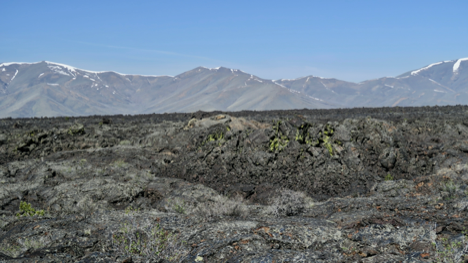
Artemisia frigida Willdenow
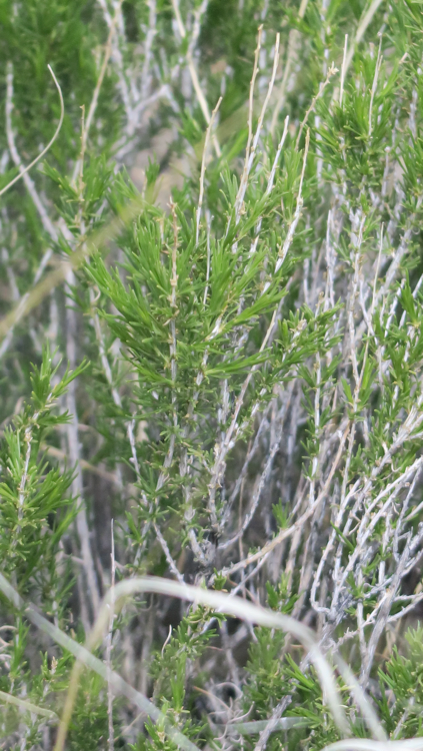
Fringed Sage (Artemisia frigida Willdenow)
The only reason I know what this is is because it was labeled on the nature trail at Great Sand Dunes National Park near the visitor center. I can see the “fringed” aspect however with the leaves looking like fringe.
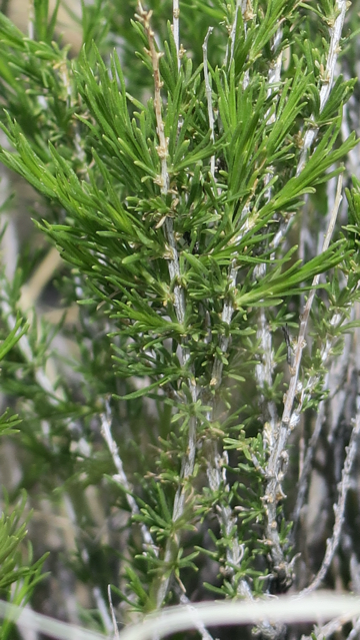
Fringed Sage (Artemisia frigida Willdenow)
Artemisia californica Lessing

Coastal Sagebrush (Artemisia californica Lessing)
This is another one of those “thank goodness they labeled the plant” identifications. From the common name, I think you can assume it is predominate along the west coast. It seems to be restricted in distribution to the state of California.28 Again, I salute the visitor center at Channel Islands National Park in Ventura, California for providing the identification.
Leucanthemum vulgare L.
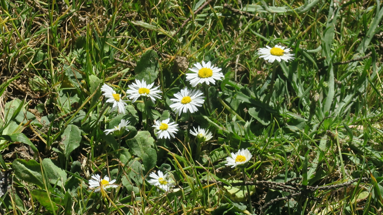
Ox-eye Daisy (Leucanthemum vulgare L.)
I’ve heard of ox-eye daisy ever since my graduate school days but never encountered it until my western trips, which, when you think about it, is unusual in that it is so widespread across North America - just not in Mississippi.29
It’s a beautiful, classical, daisy-looking flower that makes you want to pick the flower and start pulling petals and saying the love me, love me not routine.

Ox-eye Daisy (Leucanthemum vulgare L.)
Why the specific name of vulgare, is beyond me. It’s stunningly beautiful.
Bellis perennis L.
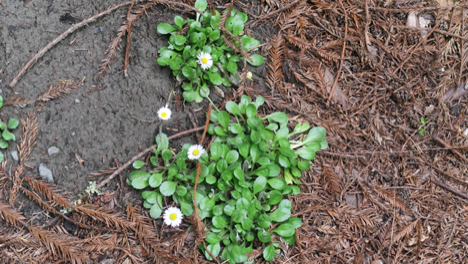 English Daisy (Bellis perennis L.)
English Daisy (Bellis perennis L.)
How appropriate to go from the ox-eye daisy to the English daisy. This, again was a first for me and a surprise along the Smith River bank at Jedediah Smith Redwoods State Park.
Jedediah Smith State Park is interconnected with Redwoods National Park. Although separate entities, the two are, for practical purposes, linked together.
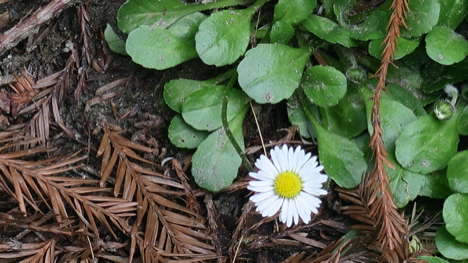 English Daisy (Bellis perennis L.)
English Daisy (Bellis perennis L.)
This is an attractive little daisy with a large number of ray flowers and a dense group of disc flowers. As you might guess from the common name, it’s an introduced species from Europe and the Mediterranean.30
The plant produces underground stems (rhizomes) and spreads in that manner.
Baccharis halimifolia L.
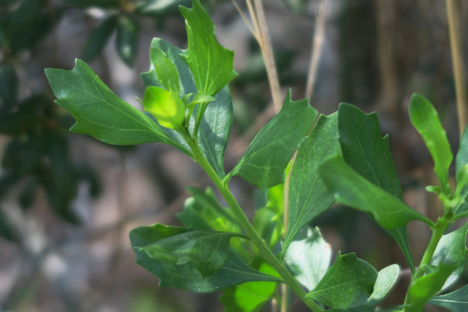
Sea-Myrtle (Baccharis halimifolia L.)
Ever since our collection trips to the Mississippi Gulf Coast during graduate school days, I’ve been familiar with the genus Baccharis although I’m surprised I’ve managed to photograph and identify three different species during my travels: B. halimifolia, B. pilularis, and B. salicina. There are 21 species in the Flora.31 The flowers in Baccharis are all discoid but I was unable to get this in bloom.
I think of these as mostly shrubs or shrub-like plants and I tend to think of them in moist soils. I’ve photographed this species twice and both have been in damp soil: Lake George State Forest and Archbold Biological Station.
Baccharis pilularis de Candolle
 Coyotebrush (Baccharis pilularis de Candolle)
Coyotebrush (Baccharis pilularis de Candolle)
This was not in particularly moist woods like those of the Mississippi Gulf Coast. It was in rather well drained soil on the trail to Glen Camp at Point Reyes National Seashore. The leaves are much thicker than the previous species (and smaller) but at least I was able to get a photo in bloom.
What you see sticking out of the disc flowers are the stigma (bilobed) and style. Therefore, this is a female shrub. Male flowers are on a separate plant.
Baccharis salicina Torr. & A. Gray
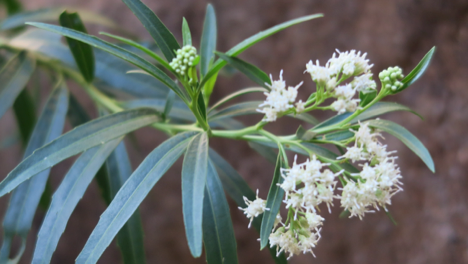 Willow Baccharis (Baccharis salicina Torr. & A.Gray)
Willow Baccharis (Baccharis salicina Torr. & A.Gray)
You can see from the leaves where the plant derives its common name. The only hint of non-willow like trait are the erose (notched or toothed) margins of the leaves.
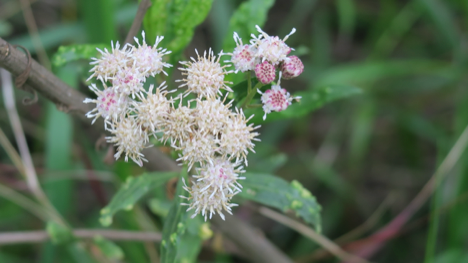 Willow Baccharis (Baccharis salicina Torr. & A.Gray)
Willow Baccharis (Baccharis salicina Torr. & A.Gray)
I photographed this species in two locations: Big Bend and Santa Cruz Island.
Ericameria nauseosa (Pallax ex Pursh) G.L.Nesom & G.I. Baird
 Rubber Rabbitbrush (Ericameria nauseosa (Pallax ex Pursh) G.L.Nesom & G.I. Baird)
Rubber Rabbitbrush (Ericameria nauseosa (Pallax ex Pursh) G.L.Nesom & G.I. Baird)
This is a western genus through and through32 and E. nauseosa is a complex species with 21 varieties33. From the common name, you may infer the sap of the plant is rubbery and the U.S. Forest Service states that “Rabbitbrush was first tested as a source of high quality rubber during World War II.”

Rubber Rabbitbrush (Ericameria nauseosa (Pallax ex Pursh) G.L.Nesom & G.I. Baird)
The first photo shows the plant in seed. This shows the plant in bloom with disc flowers. The U.S. Forest Service also states that when you crush the leaves, you either get a pineapple smell (to some people) or foul or rubbery smell to others, hence the specific name.
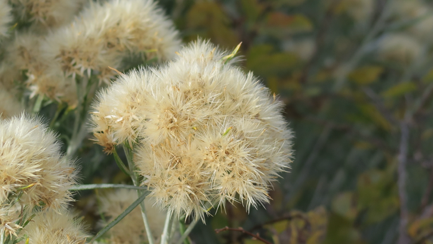
Rubber Rabbitbrush (Ericameria nauseosa (Pallax ex Pursh) G.L.Nesom & G.I. Baird)
Here you can see a close up of the plant in seed. The seeds contain a very hair pappus (modified calyx).
I photographed these at Mesa Verde National Park. Ever since minoring in anthropology at Ole Miss, I’ve always wished to see Mesa Verde. In particular, the Cliff Palace. Dr. Kohler was an expert on Meso-American culture (and quite a character) who taught me how to make arrowheads out of glass and how to appreciate the mysteries of Mesa Verde. To this date, no one has a complete explanation for the abandonment of the cliffs by the tribes associated with Mesa Verde.
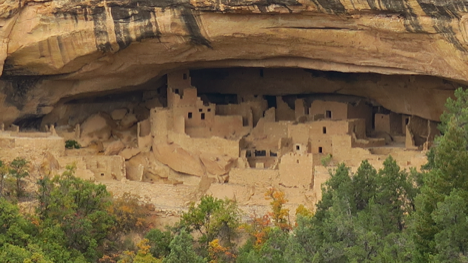
Cliff Palace from Mesa Top Loop Road, October 2016
At the time, Cliff Palace was closed to the public. I would like to go back during the holidays. I understand park personnel place lanterns in all the windows and doors at night.
Ericameria suffructicosa (Nuttall) G.L.Nesom
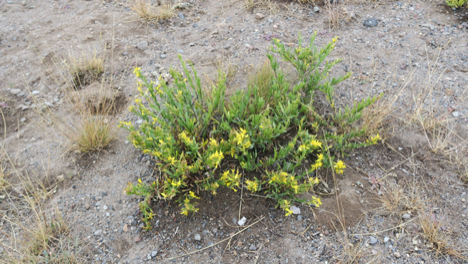 Singlehead Goldenbush (Ericameria suffruticosa (Nuttall) G.L. Nesom)
Singlehead Goldenbush (Ericameria suffruticosa (Nuttall) G.L. Nesom)
Unlike E. nauseosa, E. suffruticosa has both ray and disc flowers although you may find very few ray flowers or none at all on the bush.
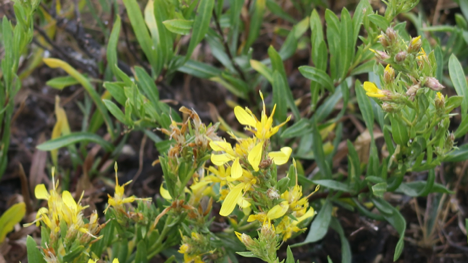 Singlehead Goldenbush (Ericameria suffruticosa (Nuttall) G.L. Nesom)
Singlehead Goldenbush (Ericameria suffruticosa (Nuttall) G.L. Nesom)
Although it is not quite a single disc or single ray flower, there are very few flowers in a head. This was growing along the Rim Road at Crater Lake.
I don’t know if the size of the plant has to do with the harsh environment on the Rim Road or if simply it is smaller than rubber rabbit brush.
Amphiachyris dracunculoides (de Candolle) Nuttall

False Annual Broomweed (Amphiachyris dracunculoides (de Candolle) Nuttall)
I was on my way to a campsite at Lost Maples State Natural Area near Vanderpool, Texas when I came across masses of this plant along the trail. At first, I couldn’t make anything of it, it was so intertwined and connected.
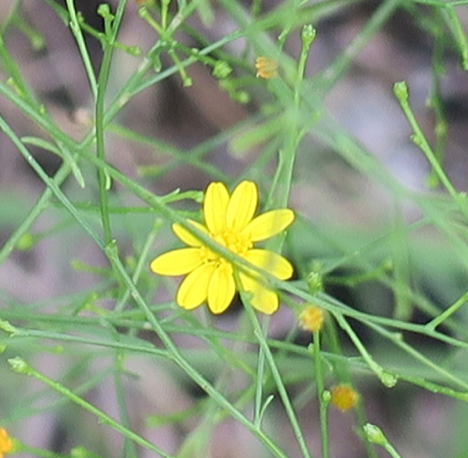
False Annual Broomweed (Amphiachyris dracunculoides (de Candolle) Nuttall)
The leaves were incredibly small and the stems incredibly thin. The flowers were the only showy thing about the plant and they were small enough you had to look twice to see if it was in bloom.
This was September 2016 so it was not unexpected to see a lot of aster family members in bloom - they tend to predominate in the fall - but it took a real close look to see it was indeed a composite.
There are only two species in Flora of North America: A. dracunculoides and A. amoena. Both have a terpene smell (again, think camphor) when you crush any of the leaves, stems or flowers34(no I did not).
It was later, after the trip, I was able to find the plant in Ajilvsgi’s excellent Wildflowers of Texas.35
Most of my identifications come after the trip. I sort my photos by destination and then pull any books on the region I may have. If I don’t have books of the region, I check the internet for plant checklists of the region and eventually, when I think I have an identification, I pull up photos of the species on the web. It works pretty well for me.
Gutierrezia sarothrae (Pursh) Britton & Rusby
 Broom Snakeweed (Gutierrezia sarothrae (Pursh) Britton & Rusby)
Broom Snakeweed (Gutierrezia sarothrae (Pursh) Britton & Rusby)
I was on the last leg of my 9.7 mile hike on the West Rim Trail at Grand Canyon National Park, South Rim when I turned a corner and found this alongside the trail. All I could make out was a yellow and green mass.
 Broom Snakeweed (Gutierrezia sarothrae (Pursh) Britton & Rusby)
Broom Snakeweed (Gutierrezia sarothrae (Pursh) Britton & Rusby)
As I got closer, I could make out ray flowers and disc flowers but couldn’t get a real feel for how they were organized.
 Broom Snakeweed (Gutierrezia sarothrae (Pursh) Britton & Rusby)
Broom Snakeweed (Gutierrezia sarothrae (Pursh) Britton & Rusby)
In essence, there are only a few ray and few disc flowers per head. At first, I thought I had another singlehead goldenbush (Ericameria suffructicosa) but the leaves were different.
This made my second trip to the south rim. It was this trip I photographed a fantastic sunrise with Lookout Studio in the background.

Seriocarpus tortifolius (Michx.) Nees
 Whitetop Aster (Seriocarpus tortifolius (Michx.) Nees)
Whitetop Aster (Seriocarpus tortifolius (Michx.) Nees)
It was August 2016 when I took this photo at Torreya State Park near Bristol, Florida so this aster was a little past its prime. The good news is I was able to get a photo of it in seed and in bloom.
Probably no other genus of plants has undergone such a revision as the genus Aster. In the 1974 printing of The New Britton and Brown Illustrated Flora of the Northeastern United States and Adjacent Canada (which I much depended on in grad school), the author estimates 250 species of Aster in North America and lists 67 species for northeastern U.S. and Canada.36
I collected 12 species of Aster in Tishomingo during my days at Ole Miss.37
Today, all but two species (A. alpinus and A. tataricus) have been moved to other genera.38 In reality, that probably makes a lot of sense. Aster gave me fits in identification because it seems a loose aggregation of plants with somewhat similar qualities.
Solidago multiradiata Aiton
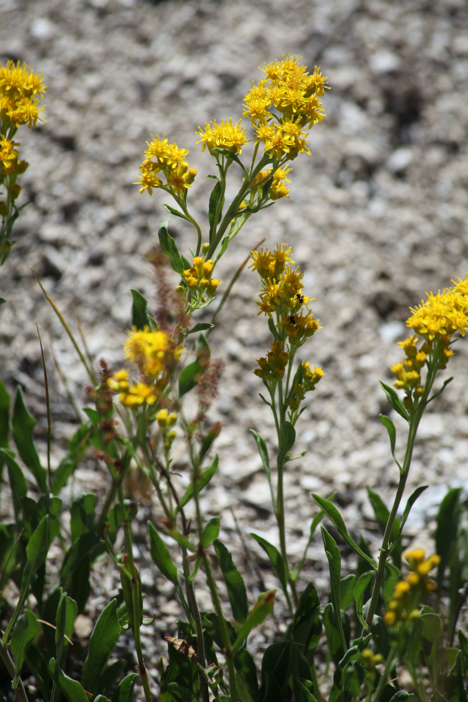 Northern Goldenrod (Solidago multiradiata Aiton)
Northern Goldenrod (Solidago multiradiata Aiton)
When I was a kid growing up, my grandmother on my mother’s side suffered from hay fever. She, like most people, assumed it was from goldenrods. She would have me pull up any goldenrod found anywhere near her house. Unfortunately for her, it was not goldenrod but ragweed (Ambrosia) that was the cause of her hay fever and it was in abundance in a ditch alongside her house.
Like the genus Aster, Solidago has undergone significant revision since I was in graduate school but nothing like that of Aster. Flora of North America currently lists 77 species.39 I was able to collect 11 species in Tishomingo.40
This seems to be one of the more common species in the western U.S. and Canada. I photographed it in Yellowstone, and several places in British Columbia.
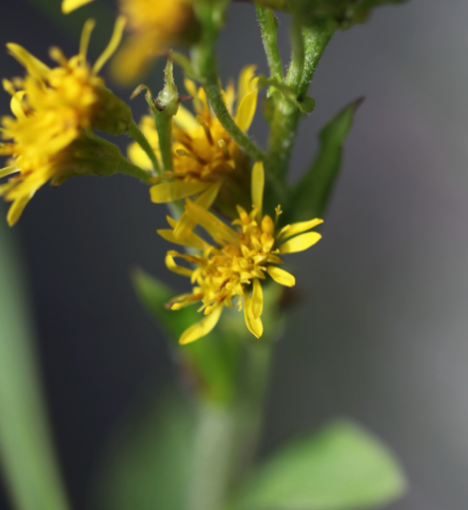 Northern Goldenrod (Solidago multiradiata Aiton)
Northern Goldenrod (Solidago multiradiata Aiton)
There are ray and disc flowers in each head and most of the leaves are basal. Stem leaves do occur when the plant is in bloom.41
Solidago curtisii Torrey & A. Gray
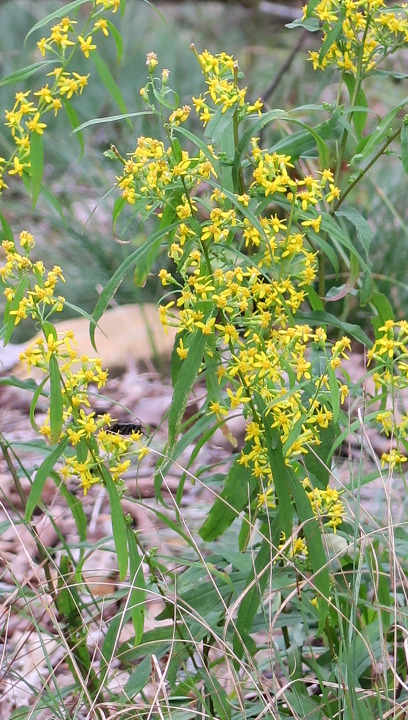
Mountain Decumbent Goldenrod (Solidago curtisii Torrey & A.Gray)
The term decumbent means the plant often falls over and the the upper portion of the plant begins to rise again. This was photographed in Cloudland Canyon State Park in northern Georgia.
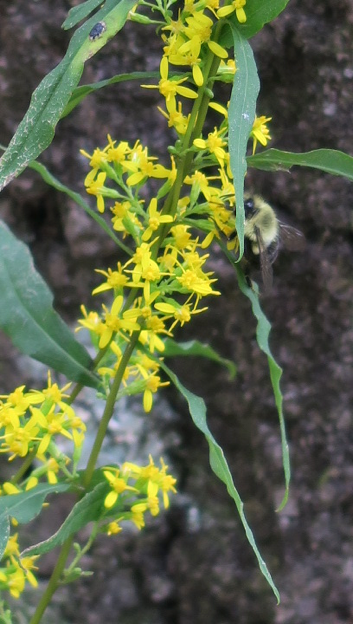
Mountain Decumbent Goldenrod (Solidago curtisii Torrey & A.Gray)
You can just make out a little pubescence on the leaves.
Solidago stricta Aiton
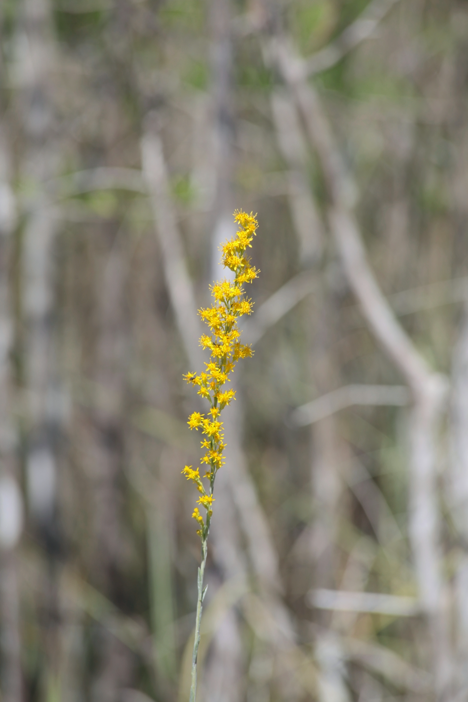
Wand Goldenrod (Solidago stricta Aiton)
It’s funny about plants. Sometimes, you are out photographing and you run across a single species. As you continue, you run into it again, and again, and again. That one species can dominate the genera in that area. Other times, you may run across three or four different species of the same genus in one place.
In the case of S. stricta, this was the only species of goldenrod in Kissimmee Prairie State Park.
What’s interesting about this species is the very needle-like leaves on the stem and the close adherence of the heads to the long axis of the stem.
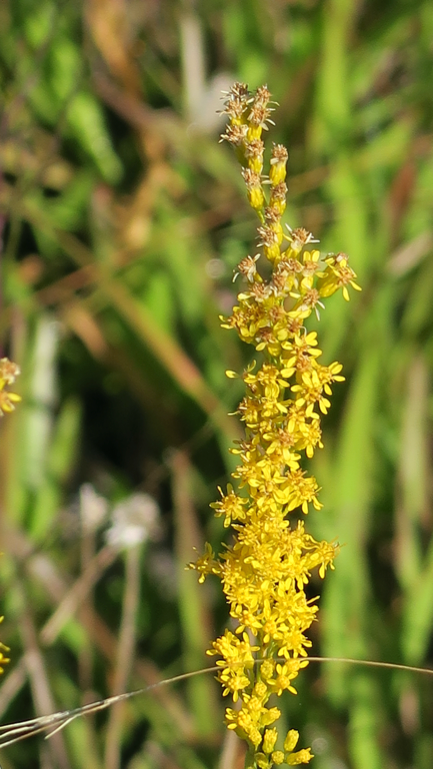
Wand Goldenrod (Solidago stricta Aiton)
You can see why it might deserve the common name of wand.
Stenotus acaulis (Nuttall) Nuttall
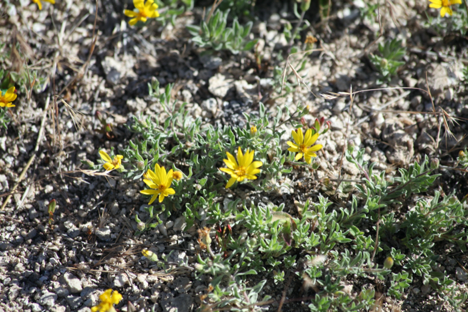 Stemless Goldenweed (Stenotus acaulis (Nuttall) Nuttall)
Stemless Goldenweed (Stenotus acaulis (Nuttall) Nuttall)
Well, virtually stemless, anyway (the term acaulis means without stem). The stems that support the head of flowers is really short. There are both ray and disc flowers present. This genus has undergone several revisions. At one time it as in the genus Chrysopsis and later it was placed in the genus Haplopappus.42 Nuttall seems to have had the last word.
As you can see, it’s in a pretty dry looking environment - also very hot due to thermal vents at the Upper Geyser Basin of Yellowstone.
Chrysothamnus greenei (A. Gray) Greene
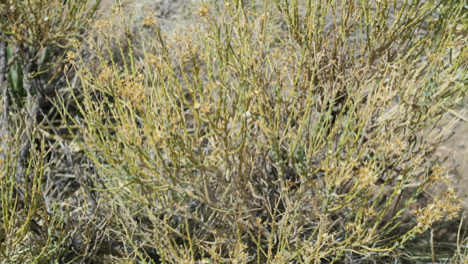 Rabbitbrush (Chrysothamnus greenei (A. Gray) Greene)
Rabbitbrush (Chrysothamnus greenei (A. Gray) Greene)
The identification of this is compliments of the naturalist at Great Sand Dunes National Park. Otherwise, I would not have been able to make heads or tails out of this. It has a naked sagebrush look to me.
 Rabbitbrush (Chrysothamnus greenei (A. Gray) Greene)
Rabbitbrush (Chrysothamnus greenei (A. Gray) Greene)
The greenei comes from the name of the botanist but it does indeed have green stems. There were no flowers on the plant when I took the photo but Flora has it with only disc flowers.43
If you remember, there was another genus of plants referred to as rabbitbrush: Ericameria. It seems to be a popular common name for several genera of plants.
Townsendia incana Nuttall
 Silvery Townsendia (Townsendia incana Nuttall)
Silvery Townsendia (Townsendia incana Nuttall)
I really like this flower. It makes bare minimum of leaves and puts a lot of energy into large flowers which really stand out in an arid environment. I had never encountered the genus before and since my western travels, I now have two species: this and T. exscapa.
I found T. incana on the roadside of Capitol Gorge Road at Capitol Reef National Park. I’m sure people thought me nuts for pulling off the road as soon as I could and walking back in the heat of the day for the photo. It wouldn’t be the first people thought me crazy and I’m sure it will not be the last.
Townsendia exscapa (Richardson) Porter
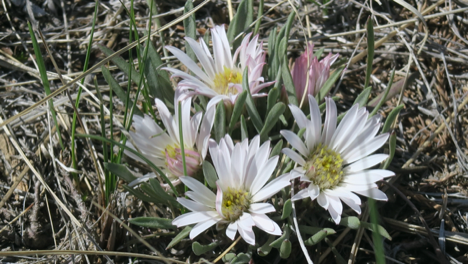 Stemless Townsendia (Townsendia exscapa (Richardson) Porter)
Stemless Townsendia (Townsendia exscapa (Richardson) Porter)
If anything, this is even more attractive than T. incana. I was hiking the Ridgeline Trail in Theodore Roosevelt National Park when I noticed this along side the trail. At first, when I glanced down, I thought it was a cactus in bloom. A closer examination revealed it was a composite. I like how there is a tinge of pink in the unopened flowers.
Chaetopappa effusa (A. Gray) Shinners
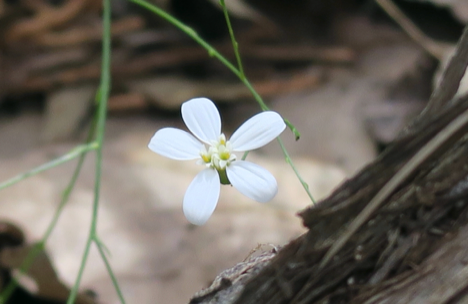 Spreading Leastdaisy (Chaetopappa effusa (A. Gray) Shinners)
Spreading Leastdaisy (Chaetopappa effusa (A. Gray) Shinners)
Flora of North America reports eight species of this genus in North America, all of which are found in Texas and with five of the eight restricted to Texas.44 C. effuse is one of those restricted to Texas. I’m not in 100% agreement with the description of the species provided by Flora but after reading the other seven descriptions, C. effusa is the best choice. On that, I guess you can say I’m 90% sure this is the correct species.
My real difference with the description is based on the number of ray and disc flowers. Flora reports 6-9 ray flowers and 4-7 disc flowers.45 As you can see, both fall below that number in this flower. However, the other descriptions don’t match too well either.
 Spreading Leastdaisy (Chaetopappa effusa (A. Gray) Shinners)
Spreading Leastdaisy (Chaetopappa effusa (A. Gray) Shinners)
What does match the description is the leaf structure and type. It’s pretty distinct.
In any case, I found this while hiking the East/West Trail at Lost Maples State Natural Area near Vanderpool, Texas. Those flowers really stood out amid the tangled mass of leaves.
Pityopsis graminifolia (Michx.) Nuttall
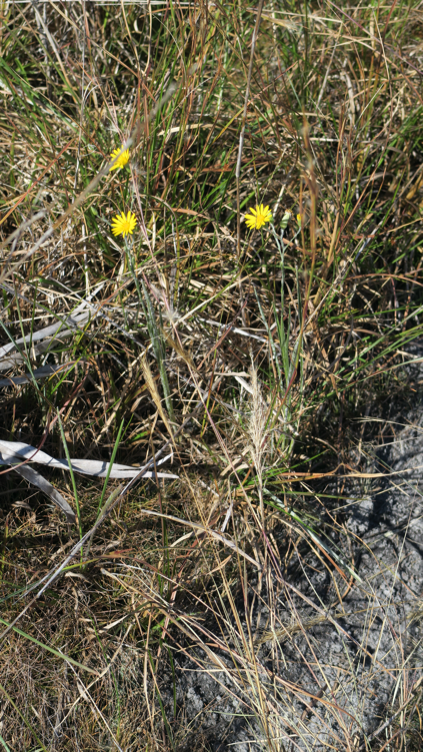
Golden Aster (Pityopsis graminifolia (Michx.) Nuttall)
The term graminifolia refers to the grass-like leaves along the stem. They really are about the length and width of a grass blade but unlike grasses which are two-ranked on a stem, these leaves are individual and alternately arranged on the stem.
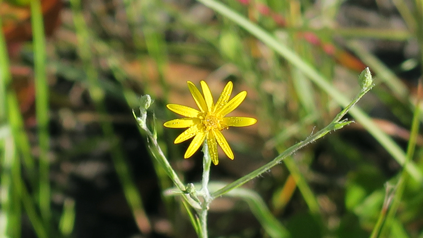
Golden Aster (Pityopsis graminifolia (Michx.) Nuttall)
The stem and leaves are covered in silvery hairs which adds to the grass-like appearance. I’ve photographed this in several locations: Cloudland Canyons State Park, Kissimmee Prairie Preserve State Park, and Myakka River State Park.
Leave it to me to overdo a hike. I was hiking the five mile West Rim Trail Loop at Cloudland Canyons State Park, enjoying the wildflowers (like this golden aster) and the scenery. I visited two waterfalls and was making my way back to my starting point at my cabin. Every cabin on the trail was marked except for guess which one? I walked past my cabin for another mile before I realized my mistake and had to cut across the trail and back down the park road to find the cabin again.
Heterotheca villosa (Pursh) Shinners
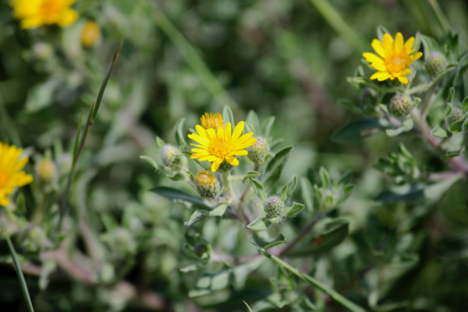
Hairy Goldaster (Heterotheca villosa (Pursh) Shinners)
There are 17 species of Heterotheca in the Flora46 and nine varieties of H. villosa and of those nine varieties, they vary significantly in leaf shape, size, pubescence and just about every other character you can think of.47 In other words, it’s a pain to identify, but I think I’m OK on this.
Heterotheca is mostly a western species. At least it is now. I collected two species in Tishomingo: H. mariana and H. nervosa.48 Those have been removed from the genus. H. nervosa is now Pityopsis graminifolia var. nervosa (I thought it looked familiar) and H. mariana is now Chrysopsis mariana.
I thought I was losing my mind with this genus because everything looked like it belonged to what I knew as Heterotheca and it wasn’t. Reclassification can be a real pain once you’ve been away from the field of study for any length of time.
I’ve photographed it in various locations and in each location, the plant looks a little different from the previous.
Erigeron concinnus (Hooker & Arnott) Torrey & A. Gray
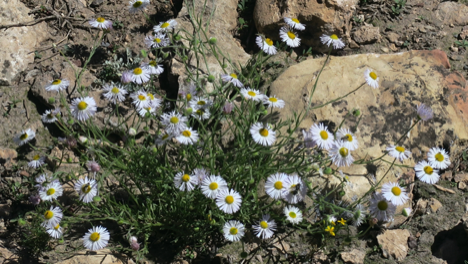
Tidy Fleabane (Erigeron concinnus (Hooker & Arnott) Torrey & A. Gray)
This genus is collectively referred to as the fleabanes. I’ve never tried it as a flea repellent but you can give it a try.
It’s a large genus with 173 species reported in North America.49 A lot of them look very similar to each other and you have to be rather careful in trying to identify them in the field or with photographs so my identifications are best guesses based on location and plant checklists of the area as well as matching images with different guides and the internet.
I like the common name of this one because it does grow quite tidily in a group or clump.

Tidy Fleabane (Erigeron concinnus (Hooker & Arnott) Torrey & A. Gray)
Both the stems and leaves may be densely hairy and even glandular. When I think of the genus, I often think of a large number of ray flowers with a fairly flat head of disc flowers. In this case, the disc flowers form more of a cone. I also find the petals can vary from white to pink to slightly blue in different species.
This particular species seems to be more western in distribution50 and I photographed it on the north rim of the Grand Canyon.
Erigeron foliosus Nuttall

Leafy Fleabane (Erigeron foliosus Nuttall)
This plant is restricted to the state of California.51 I photographed it at Point Reyes National Seashore in September of 2016. I found it on the trail to Chimney Rock at the historic lifeboat station near Point Reyes Light. The leaves are very distinct for fleabanes and they look leathery.

Leafy Fleabane (Erigeron foliosus Nuttall)
To be honest, I didn’t recognize it as a fleabane at first. It had more Aster characteristics to me, but as I pointed out previously, that genus has mostly been replaced. I also like the blue tint of the flowers on this one. The rays were rather long and overall, the flower heads were much larger than what I think of fleabanes.

Most of Chimney Rock was closed off to the public. Recent earthquakes in the area had weakened the cliffs and the park service was afraid people would fall into the sea.
Erigeron philadelphicus L.
 Philadelphia Fleabane (Erigeron philadelphicus L.)
Philadelphia Fleabane (Erigeron philadelphicus L.)
This has to be the most widely distributed fleabane in North America. It’s not reported in Alaska, Arizona nor Utah, but otherwise, it blankets the country.52 It was also the very first fleabane I ever collected and still the most familiar to me.
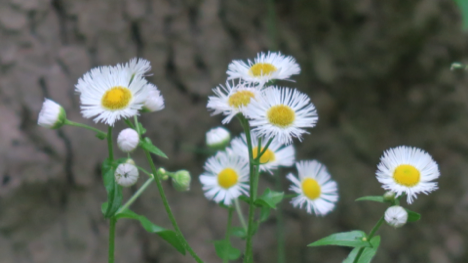 Philadelphia Fleabane (Erigeron philadelphicus L.)
Philadelphia Fleabane (Erigeron philadelphicus L.)
It’s this plant to which I compare all other fleabanes. What is so distinctive to me about this plant is the almost needle-like ray flowers. Sometimes the plant is quite hairy. If you are going to run into a fleabane, this is probably the one. Look for it along roadsides, fields, and disturbed areas.
Erigeron quercifolius L.
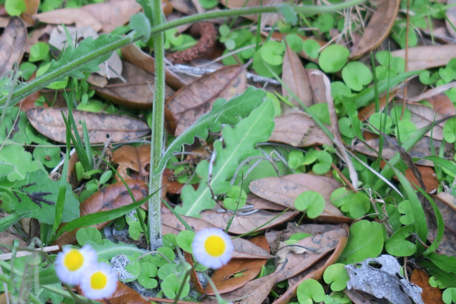
Oakleaf Fleabane (Erigeron quercifolius L.)
I suppose if you squint, the leaves do have a vague resemblance to member of oak genus.
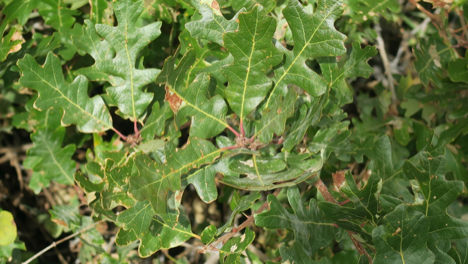 Gambel’s Oak (Quercus gambelii Nuttall)
Gambel’s Oak (Quercus gambelii Nuttall)
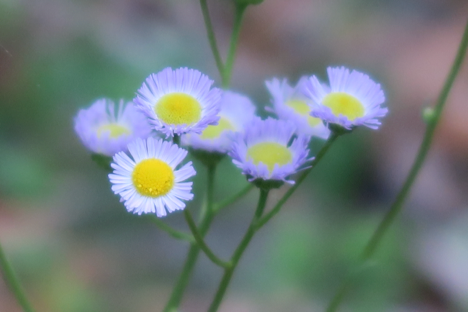 Oakleaf Fleabane (Erigeron quercifolius L.)
Oakleaf Fleabane (Erigeron quercifolius L.)
This is reported to be a plant of the coastal plain of the southeast. It’s reported in Florida, Georgia, South Carolina, North Carolina and Virginia.53
I photographed this particular one at Lake George State Forest in Florida. Florida, as a state, is mostly coastal plain.
Erigeron pulchellus Michaux
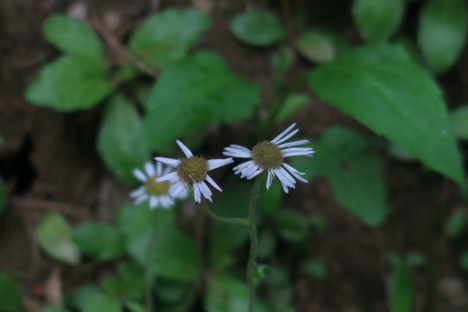
Hairy Fleabane (Erigeron pulchellus Michaux)
This is widely distributed in the eastern U.S. and Canada54 and also one of the more common ones you may encounter. Unfortunately, the day I photographed these, it was after a night of heavy rainfall, and like me, they looked a little drowned.

Hairy Fleabane (Erigeron pulchellus Michaux)
The leaves are mostly basal and the stems are quite hairy.

Hairy Fleabane (Erigeron pulchellus Michaux)
Even with the beating by the rain the night before, some of the seeds on the head were still in place. These were taken on the Deep Creek Trail in the Smokies.
Erigeron peregrinus (Banks ex Pursh) Greene

Wandering Fleabane (Erigeron peregrinus (Banks ex Pursh) Greene)
This is strictly a western Canadian species except for Washington state.55 I photographed it on the Black Forest trail in The Bugaboos in August of 2051. For some reason, I failed to take any photos of the leaves. I’ll chalk it up to disorientation due to altitude.

Black Forest Peak, The Bugaboos, British Columbia
Erigeron glacialis (Nuttall) A. Nelson
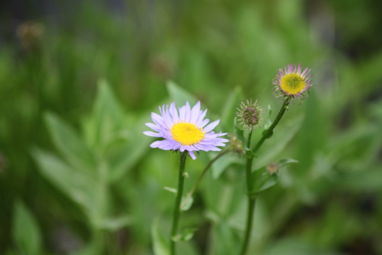
Subalpine Fleabane (Erigeron glacialis (Nuttall) A. Nelson)
I originally misidentified this as E. peregrinus until I was able to look in Flora of North America and find E. peregrinus is not found in Oregon.56 After a little reading and searching, I realized it is E. glacialis - I think. At least, it’s found in Oregon where I photographed this.
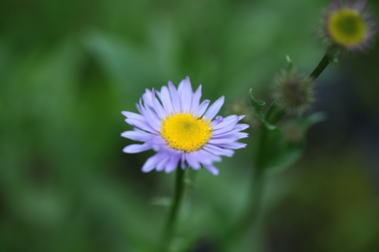
Subalpine Fleabane (Erigeron glacialis (Nuttall) A. Nelson)
This was all around the Castle Crest Wildflower Trail at Crater Lake.
Erigeron glabellus Nuttall
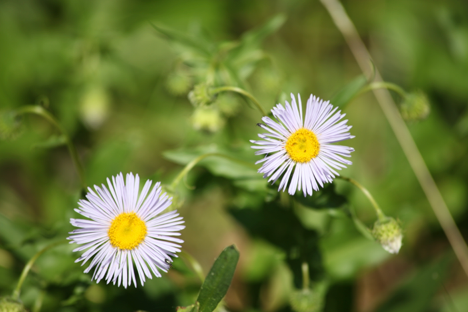 Smooth Fleabane (Erigeron glabellus Nuttall)
Smooth Fleabane (Erigeron glabellus Nuttall)
I photographed this in two places out west: Grand Teton and Lake Louise, Alberta. The Alberta plants were a little bedraggled. It had rained the night before. This photo is from Signal Mountain, Grand Teton and it was a beautiful sunny day, so the flower was happy.
The rays of the head of flowers reminds me of Philadelphia fleabane.
Erigeron glaucus Ker Gawler
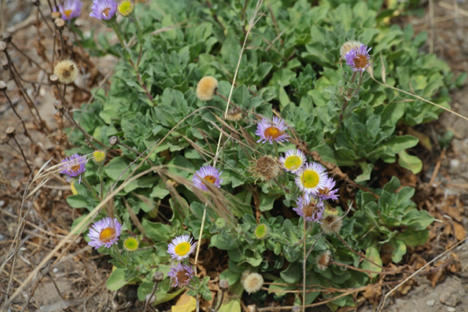 Seaside Daisy (Erigeron glaucus Ker Gawler)
Seaside Daisy (Erigeron glaucus Ker Gawler)
I had never seen a growth form like this on Erigeron, but it was California.
 Seaside Daisy (Erigeron glaucus Ker Gawler)
Seaside Daisy (Erigeron glaucus Ker Gawler)
The seaside part of the name certainly applies since I photographed it on the Lands End Trail in San Francisco. On a different trip, I photographed it again on Twin Peaks in San Francisco.
Erigeron annuus (L.) Persoon

Daisy Fleabane (Erigeron annuus (L.) Persoon)
This is another common species in the eastern U.S. and another one I had previously collected at Tishomingo.57 This was photographed along the Deep Creek Trail in the Smokies in 2016. It’s a prolific bloomer with numerous heads per plant. The needle-like rays remind me also of E. philadelphicus.
Erigeron sionis Cronquist
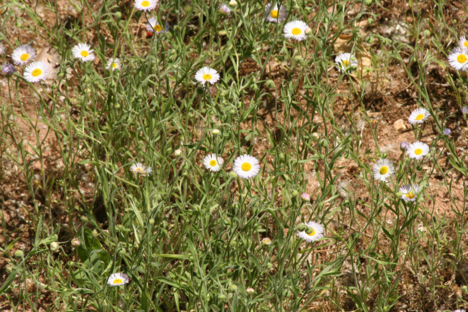
Zion Fleabane (Erigeron sionis Cronquist)
Flora of North America lists this as of conservation concern.58 The plant is native to only southern Utah and it is found within Zion National Park from which it derives its name. This was growing along the roadside of the park.
Eurybia integrifolia (Nuttall) G.L. Nesom
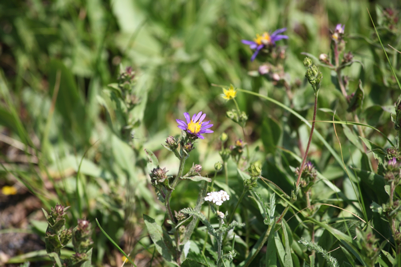
Thickstem Aster (Eurybia integrifolia (Nuttall) G.L. Nesom)
At one time, this was identified as Aster integrifolius but G.L. Nesom made major revisions to the genus Aster and place this in the genus Eurybia. It is, indeed, thick stemmed. Otherwise, there’s not much to this but it could be due to the harsh environmental conditions. The photo was taken at an overlook of the Upper Falls of the Yellowstone.

Thickstem Aster (Eurybia integrifolia (Nuttall) G.L. Nesom)
This shows the bloom a little better.
Eurybia chlorolepis (E.S. Burgess) G.L. Nesom
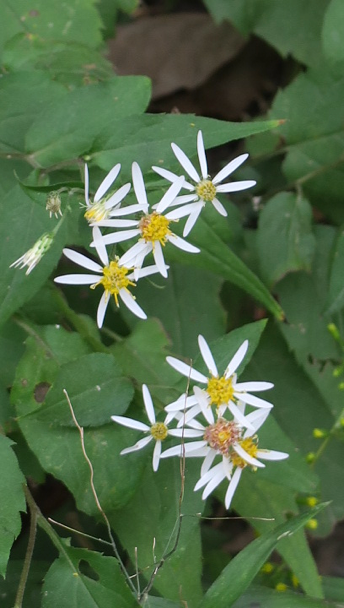
Mountain Wood Aster (Eurybia chlorolepis (E.S. Burgess) G.L. Nesom)
This was a Cloudland Canyon find along the West Rim Trail of the park. The leaves were quite large and yet the flowers a little small for the size of the leaves of the plant.
Dieteria canescens (Pursh) Nuttall
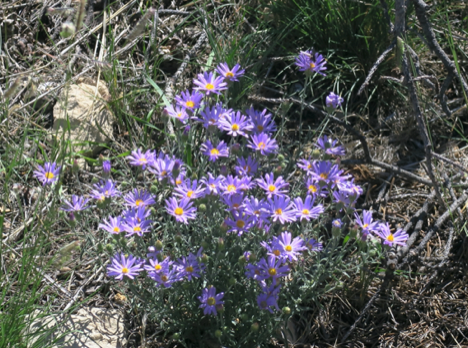 Hoary Aster (Dieteria canescens (Pursh) Nuttall)
Hoary Aster (Dieteria canescens (Pursh) Nuttall)
This was originally considered one of the many species of Aster. It was then placed in the genus Machaeranthera, and now is has landed in the genus Dieteria with 10 varieties listed in Flora of North America.59 Regardless, it’s a pretty flower.
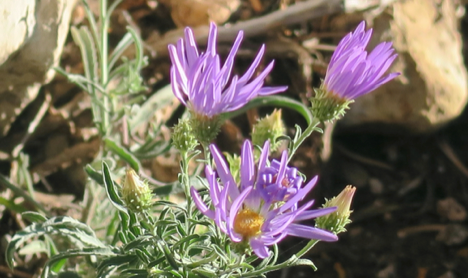 Hoary Aster (Dieteria canescens (Pursh) Nuttall)
Hoary Aster (Dieteria canescens (Pursh) Nuttall)
The involucre surrounding the head of ray and disc flowers is rather robust and the leaves are linear. I found this in several locations along the north rim of the Grand Canyon.
Notice how coarse and rough the bracts of the involucre are (just beneath the ray flowers). The leaves are also toothed as well as in-folded. The infolding is probably to retard water loss during the hot summer months.
Grindelia squarrosa (Pursh) Dunal
 Curly-top Gumweed (Grindelia squarrosa (Pursh) Dunal)
Curly-top Gumweed (Grindelia squarrosa (Pursh) Dunal)
It looks as though this bloom is not fully open but in reality, sometimes it has large ray flowers and sometimes it doesn’t. What you are seeing here are only the disc flowers. The common name perhaps gives you an idea it tends to be rather glandular along the stems, leaves, and involucres providing a sticky residue.
 Curly-top Gumweed (Grindelia squarrosa (Pursh) Dunal)
Curly-top Gumweed (Grindelia squarrosa (Pursh) Dunal)
The involucre tips recurve to give it a hooked appearance. My exposure to this plant was on the north rim of the Grand Canyon. Where it grew, it grew abundantly.
Except for a couple of species, Grindelia is mostly western in distribution.60
Grindelia hirsutula Hooker & Arnott
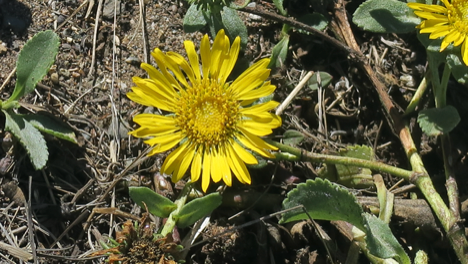 Pacific Gumplant(Grindelia hirsutula Hooker & Arnott)
Pacific Gumplant(Grindelia hirsutula Hooker & Arnott)
My next exposure to Grindelia (at least it was familiar to me now) was at the lighthouse at Point Reyes National Seashore. This was growing along the “road” to the lighthouse from the parking lot.
 Pacific Gumplant(Grindelia hirsutula Hooker & Arnott)
Pacific Gumplant(Grindelia hirsutula Hooker & Arnott)
As I wrote early, I have a real reticence to photograph and try to identify members of the aster family but when I saw that this plant crawled along the ground and then saw the recurved involucres, I figured how hard could it be to identify? As it turned out, not very hard.
When I visited the lighthouse in September of 2016, it was in need of repair.

Point Reyes Lighthouse - Point Reyes National Seashore
The good news is that it is undergoing an extensive renovation. It was due to reopen in the early summer of 2019 but that has been pushed back until December 31, 2019 (National Park Service). They beat their deadline. It reopened to the public in November of 2019.
Symphyotrichum patens (Aiton) G.L. Neson

Late Purple Aster (Symphyotrichum patens (Aiton) G.L. Neson)
You are about to get a run of G.L. Neson as the authority for the naming of a plant. When I was collecting and identifying back in 1974-1977, this genus had one questionable species, but in 1994, Nesom re-established the genus and placed within the genus many species that were once in the genus Aster (Wikipedia).
As I mentioned before, I had previously met Arthur Cronquist, the then expert on the Asteraceae, when in graduate school. It seems Nesom, who did his graduate work at UNC Chapel Hill - perhaps the best school for taxonomy in the U.S. - has now become the expert in the family (Wikipedia). The torch has been passed.
I haven’t read any of his papers for his justification for re-establishing the gneus Symphyotrichum, but they all still look like Aster to me.

Late Purple Aster (Symphyotrichum patens (Aiton) G.L. Neson)
This is an eastern species and as the common name indicates, it a late bloomer in the fall of the year. There are three varieties, all eastern in distribution.61
These particular photos were made at Cloudland Canyons State Park in northern Georgia.
Symphyotrichum adnatum (Nuttall) G.L. Nesom
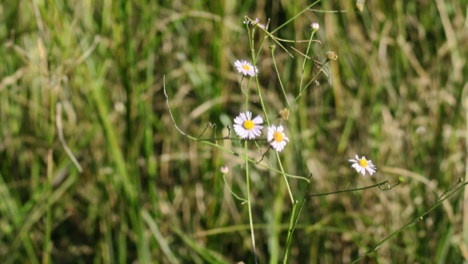 Scaleleaf Aster (Symphyotrichum adnatum (Nuttall) G.L. Nesom)
Scaleleaf Aster (Symphyotrichum adnatum (Nuttall) G.L. Nesom)
A lot of the asters are late bloomers and this one was photographed in October of 2017 at Kissimmee Prairie Preserve State Park in Florida. The scales are small enough they don’t show on the photograph at all.
This is a very delicate aster and it was growing mostly in the ditches alongside the road into the park.
Symphyotrichum ericoides (L.) G. L. Nesom
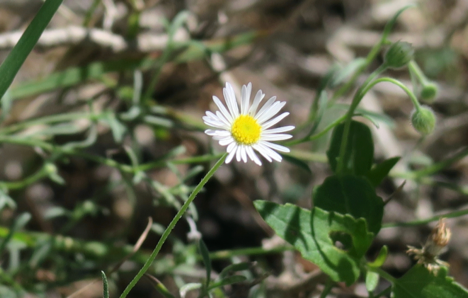 White Heath Aster (Symphyotrichum ericoides (L.) G.L. Nesom)
White Heath Aster (Symphyotrichum ericoides (L.) G.L. Nesom)
This was along the East/West Trail of Lost Maples State Natural Area near Vanderpool, Texas. I photographed it in September of 2016.
 White Heath Aster (Symphyotrichum ericoides (L.) G.L. Nesom)
White Heath Aster (Symphyotrichum ericoides (L.) G.L. Nesom)
I probably would not have bothered except the leaf structure was unique enough to give me pause. I figured I could identify it based on the leaves and the pubescence on the stem and leaves - and it’s location.
As it happens, location was not a big help in the identification. It is widely distributed across the U.S. and Canada.62
Symphyotrichum cordifolium (L.) G.L. Nesom
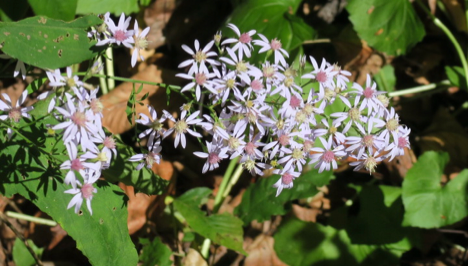 Heart-leafed Aster (Symphyotrichum cordifolium (L.) G.L. Nesom)
Heart-leafed Aster (Symphyotrichum cordifolium (L.) G.L. Nesom)
I would probably describe the leaves as clasping arrow-head shaped but I’ll go with heart-leafed since it sounds nicer. These were roadside on the road from Cherokee, N.C. to Gatlinburg, Tennessee across Newfound Gap.
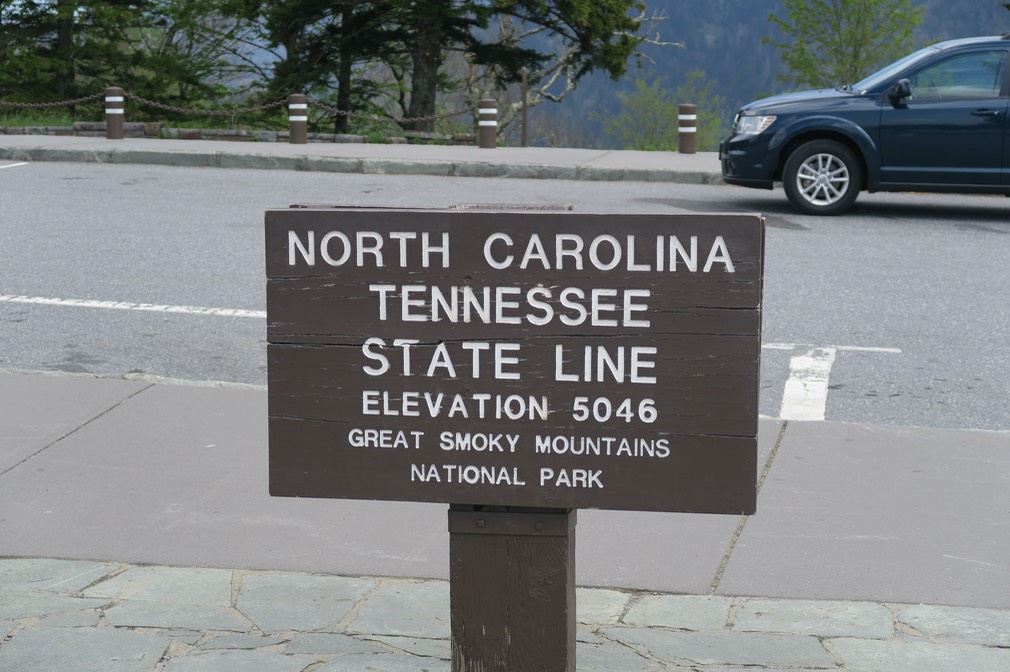
Newfound Gap, elevation 5,046 feet above sea level
Newfound Gap, of course, was a low point, relatively speaking, that allowed a path to go through the Smokies.
It’s also part of the Appalachian Trail which begins in north Georgia at Springer Mountain and goes to Katahdin, Maine. The trail is 2,200 miles in length. When you reach Newfound Gap, you only have 1,972 miles to go.

Three hikers about to head out on the AT. Note their calves.
Symphyotrichum retroflexum (Linley ex de Candolle) G.L. Nesom
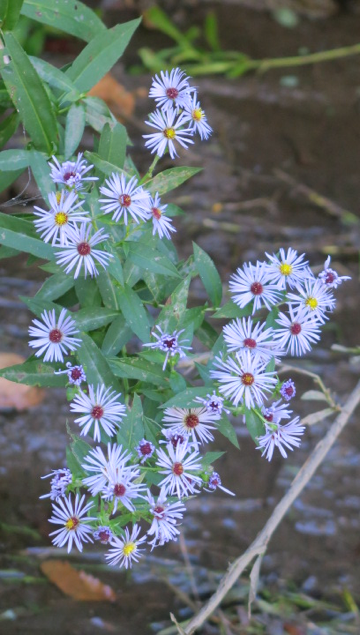
Rigid Whitetop Aster (Symphyotrichum retroflexum (Lindley ex de Candolle) G.L. Nesom)
In spite of the common name, it does come in blue. Again, this was a roadside bloomer in the Smokies.
Symphyotrichum elliottii (Torrey & A. Gray) G.L. Nesom
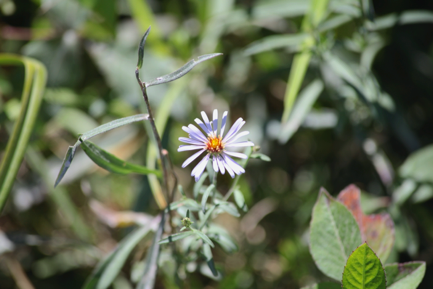
Elliott’s Aster (Symphyotrichum elliottii (Torrey & A. Gray) G.L. Nesom)
This was among the alligators in the Big Cypress Preserve in Florida. I had to use a telephoto to get the shot since the gator was a wee bit close.
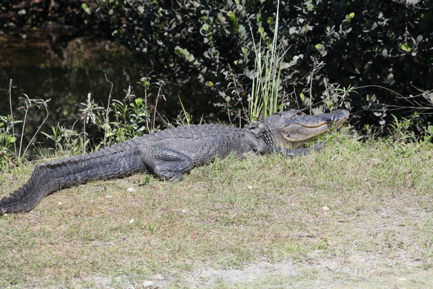
Symphyotrichum foliaceum (Lindley ex de Candolle) G.L. Nesom
 Leafybract Aster (Symphyotrichum foliaceum (Lindley ex de Candolle) G.L. Nesom)
Leafybract Aster (Symphyotrichum foliaceum (Lindley ex de Candolle) G.L. Nesom)
This was a stunner, particularly where it was found - British Columbia and Alberta in, for them, summer but for me early spring.
I first saw it growing along the shore of Lake Louise, then Eva Lake in The Bugaboos. We had just started the hike when we got a grizzly warning and were hurriedly evacuated by helicopter.
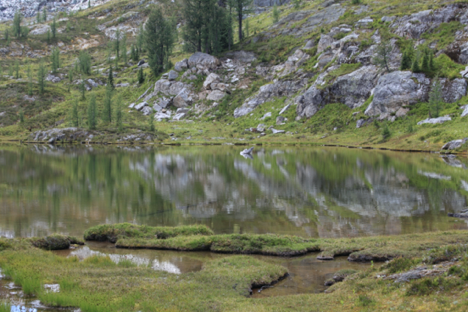
Eva Lake, Prior to the Grizzly Evacuation
The rays of the head of flowers have some of the most intense purple I’ve seen in a plant.
Senecio integerrinus Nuttall
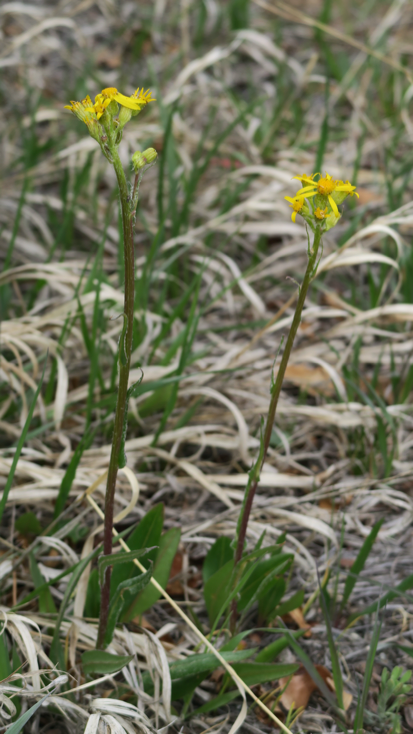
Western Groundsel (Senecio integerrimus Nuttall)
I was first introduced to the genus Senecio with my work at Tishomingo State Park. There was one species that bloomed early in the spring and it was always a treat to find for three springs at the park.
Therefore, I was excited when I went out west and found Senecio out there. However, there came a period of doubt on my identifications. Plants that I would have guaranteed you were the genus Senecio were listed in the genus Packera.
I later learned that Senecio had undergone a major revision and many species I knew as Senecio were now placed in the genus Packera. I guess you really do never stop learning.
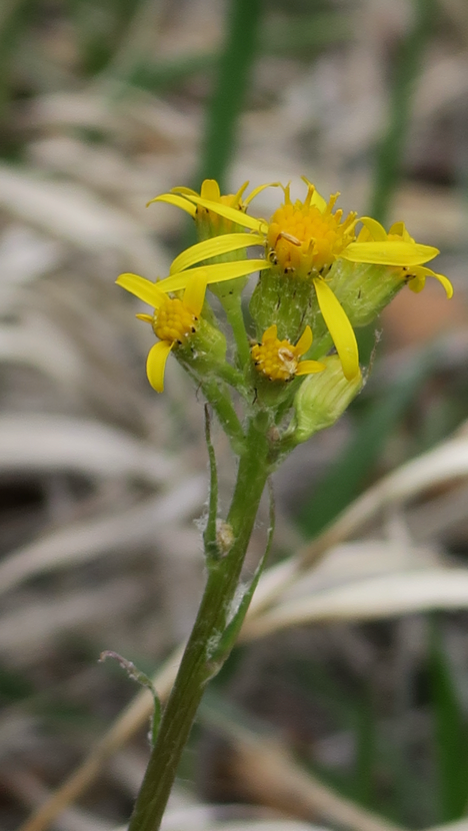 Western Groundsel (Senecio integerrimus Nuttall)
Western Groundsel (Senecio integerrimus Nuttall)
There’s not much I don’t like about this genus. Many members of the genus have a basal rosette of leaves and the leaves are often well differentiated between species. The stem leaves can be quite different from the basal leaves and the flowers were easy to dissect and discern characteristics. What’s not to love?
I’ve photographed this in two locations: Yellowstone and Black Canyon of the Gunnison.
Senecio triangularis Hooker
 Arrowleaf Ragwort (Senecio triangularis Hooker)
Arrowleaf Ragwort (Senecio triangularis Hooker)
The leaves are very distinctive in this species. The head of flowers simply looks like Senecio.
 Arrowleaf Ragwort (Senecio triangularis Hooker)
Arrowleaf Ragwort (Senecio triangularis Hooker)
Again, I photographed this plant in two different locations: Crater Lake and The Bugaboos, British Columbia.
There are two common names associated with Senecio: groundsel and ragwort. Groundsel possible comes from Middle English which refers to swallow (Dictionary.com) which is associated with poultices. Ragwort, I can only suppose. “wort” means plant and these can get a little ragged after a hard rain.
Senecio serra Hooker

Tall Groundsel (Senecio serra Hooker)
This has to be one of the most unusual Senecio I’ve come across in my studies and my trips. I’ve never seen an array of flowers like this. Usually, with Senecio, the heads of flowers are rather sparse.
I don’t know where they got the “tall” idea. These were all pretty short in size but it could be due to habitat.
Packera anonyma (Alph Wood) W. A. Weber & Á Löve

Small’s Packera (Packera anonyma (Alph Wood) W. A. Weber & Á Löve)
This has several synonyms under the genus Senecio and I suspect I have collected it under the older names. It seems very familiar to me as a Senecio.
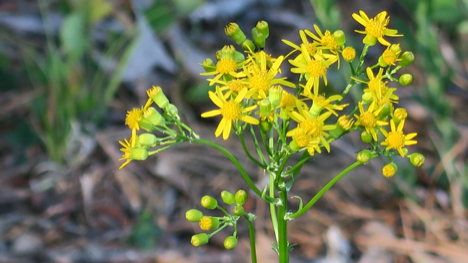 Small’s Packera (Packera anonyma (Alph Wood) W. A. Weber & Á Löve)
Small’s Packera (Packera anonyma (Alph Wood) W. A. Weber & Á Löve)
I photographed this around the campsite at High Falls State Park near Jackson, Georgia.
Packera aurea (L.) Á Löve & D. Löve
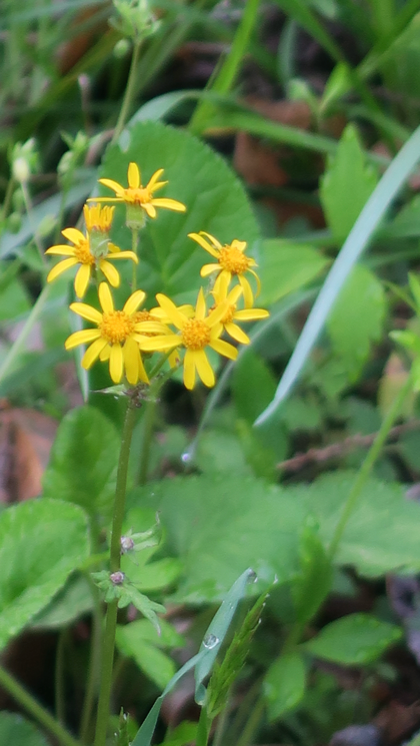
Golden Ragwort (Packera aurea (L.) Á Löve & D. Löve)
This, at one time, was Senecio aureus and was one of those I collected at Tishomingo.63 It is still one of my favorites. This is definitely an eastern species64 and easily recognized by its leaves.
I always look for this in wooded areas with moist soil.
Photographs were taken on the Wolfden Loop of the Pine Mountain Trail near Warm Springs, Georgia and the Smokemont Loop Trail in the Great Smoky Mountains National Park.
Packera glabella (Poiret) C. Jeffrey
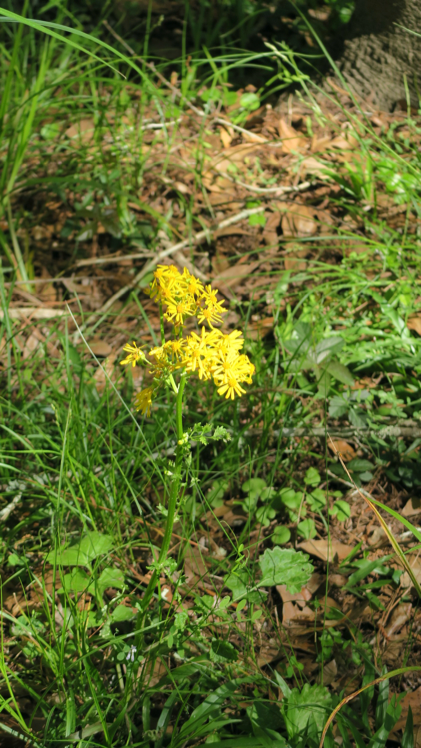
Butterweed (Packera glabella (Poiret) C. Jeffrey)
Butterweed is another common name for Packera/Senecio species. I think it has to do with the color of the flowers. I came across this one along the roadside of Nature Coast bike trail near Manatee Springs, Florida.

Butterweed (Packera glabella (Poiret) C. Jeffrey)
This is a pretty tall plant. I think I remember it reaching 1 1/2-2 feet in height. The stems are interesting and it looks as though there are lines running down the length of the stems.
Packera multilobata (Torrey & A. Gray) W. A. Weber & Á Löve
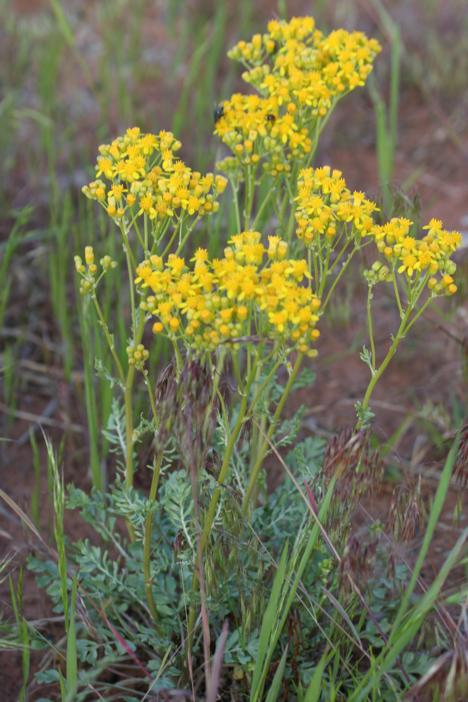
Uinta Groundsel (Packera multilobata (Torrey & A. Gray) W. A. Weber & Á Löve)
My first encounter with this was at Dead Horse Point State Park in Utah. I later ran into it again at Zion and then in 2018 at Capitol Reef. It’s concentrated in eight states of the southwest: California, Arizona, New Mexico, Utah, Nevada, Colorado, and Idaho.
What stands out to me with this plant are the really deeply pinnately divided leaves.
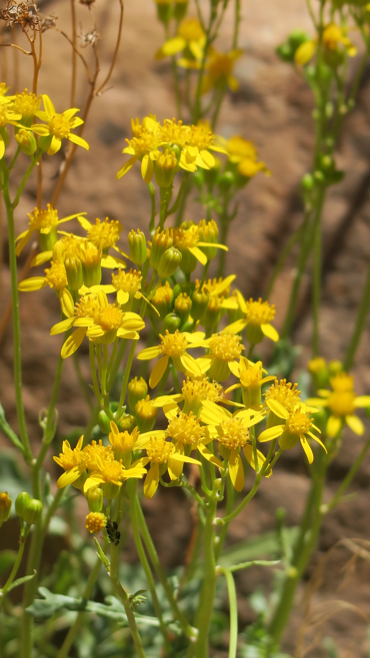
Uinta Groundsel (Packera multilobata (Torrey & A. Gray) W. A. Weber & Á Löve)
I have no idea as to how to pronounce Uinta but it is a common name in the desert southwest. The U.S. Forest Service says it is from the Ute word which means pine tree or pine forest.
Packera obovata (Muhlenberg ex Willdenow) W. A. Weber & Á Löve
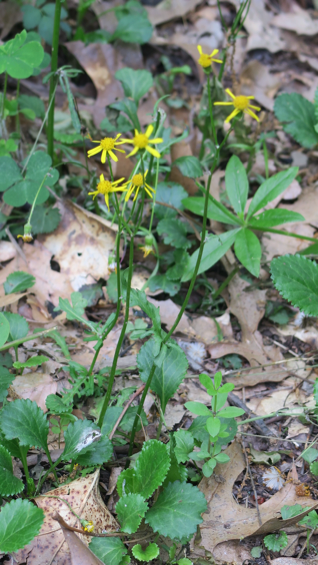
Round-leaf Groundsel (Packera obovata (Muhlenberg ex Willdenow) W. A. Weber & Á Löve)
The basal leaves are round and are distinctly different from the stem leaves of the plant. This was in wet woods near Brandywine Falls at Cuyahoga Valley National Park.
Packera pauciflora (Pursh) Á Löve & D. Löve
 Rayless Alpine Groundsel (Packera pauciflora (Pursh) Á Löve & D. Löve)
Rayless Alpine Groundsel (Packera pauciflora (Pursh) Á Löve & D. Löve)
I really had no idea as to the genus when I first stumbled across this. I probably had a touch of altitude sickness at the time and for a while, I couldn’t discern the leaves of the plant. Later, I found them but then when I examined the head of flowers, I was even more confused. 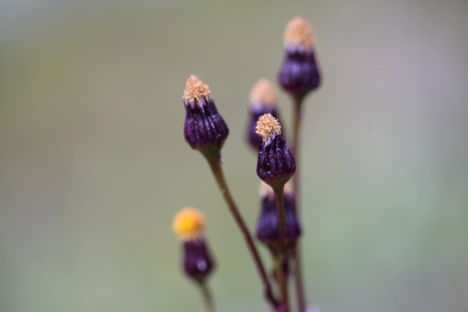 Rayless Alpine Groundsel (Packera pauciflora (Pursh) Á Löve & D. Löve)
Rayless Alpine Groundsel (Packera pauciflora (Pursh) Á Löve & D. Löve)
That’s a very deep purple for any flower. I assume the flowers were not open.
 Rayless Alpine Groundsel (Packera pauciflora (Pursh) Á Löve & D. Löve)
Rayless Alpine Groundsel (Packera pauciflora (Pursh) Á Löve & D. Löve)
Here the flowers are fully open. The story is these have no rays. They are all disc flowers. I didn’t know that at the time and it took me quite a while to pin down a name on these.
 Rayless Alpine Groundsel (Packera pauciflora (Pursh) Á Löve & D. Löve)
Rayless Alpine Groundsel (Packera pauciflora (Pursh) Á Löve & D. Löve)
I photographed these at Dead Elk Lake (very descriptive) in The Bugaboos, British Columbia.
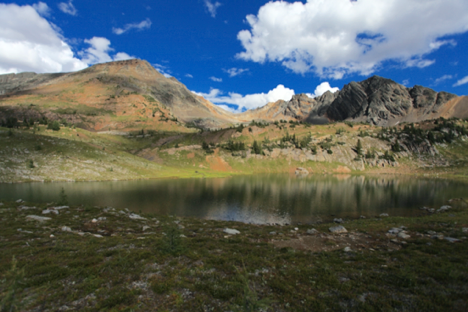
It seems a shame to name such a pretty lake, Dead Elk Lake.
Packera tridenticulata (Rydberg) W. A. Weber & Á Löve
 Three-toothed Groundsel (Packera tridenticulata (Rydberg) W. A. Weber & Á Löve)
Three-toothed Groundsel (Packera tridenticulata (Rydberg) W. A. Weber & Á Löve)
I thought I would show you why it is called three-toothed groundsel. If you look at the tips of the leaves, there are three small lobes.
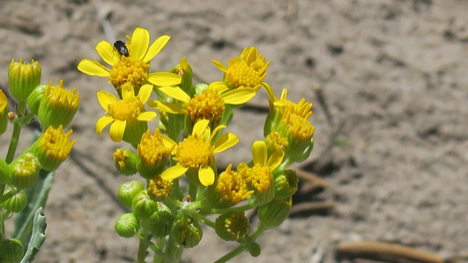 Three-toothed Groundsel (Packera tridenticulata (Rydberg) W. A. Weber & Á Löve)
Three-toothed Groundsel (Packera tridenticulata (Rydberg) W. A. Weber & Á Löve)
Again, these are more typical of Packera/Senecio flowers with a few rays and more than a few disc flowers.
This was on the Medano Pass Primitive Road of Great Sand Dunes National Park.
If you drive the Medano Pass Primitive Road, make sure (1) you have four-wheel drive (2) a portable air pump to re-inflate your tires and (3) plenty of water in case you get stranded.
Emilia sonchifolia (L.) de Candolle
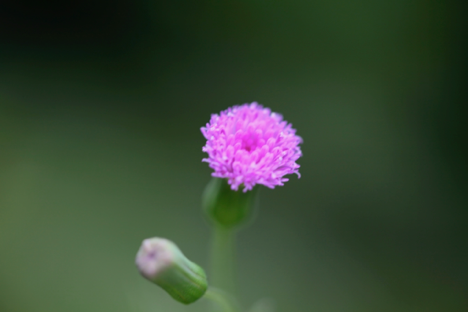 Lavender Tasselflower (Emilia sonchifolia (L.) de Candolle)
Lavender Tasselflower (Emilia sonchifolia (L.) de Candolle)
The first time I saw this was in my yard. It took me a while to identify it since Flora of North America65 reports it as a pan-tropical weed from Asia. I like the color of the disc flowers - there are no ray flowers.
Key to identification of this species is the leaf.
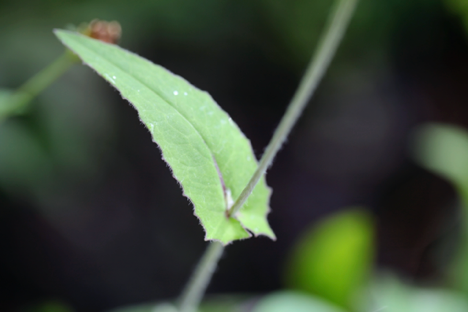 Lavender Tasselflower (Emilia sonchifolia (L.) de Candolle)
Lavender Tasselflower (Emilia sonchifolia (L.) de Candolle)
The leaf almost looks perfoliate but it is actually termed “clasping” the stem. You can see where the base of the leaf is open around the stem.
 Lavender Tasselflower (Emilia sonchifolia (L.) de Candolle)
Lavender Tasselflower (Emilia sonchifolia (L.) de Candolle)
The achenes have a fine pappus attached to the top of the achene and you can see the similarity to dandelions.
Emilia fosbergii Nicolson

Red Tassleflower (Emilia fosbergii Nicolson)
When my dog Rocky was alive, he always wanted to see new sights and travel new paths. He would vary his walks around the neighborhood, one day heading east, another day south, another day.... One of his favorite walks was by the Boys and Girls Club in my neighborhood. At the intersection of the street I saw this spot of red color. I had already photographed E. sonchifolia and at first I thought this was the same. However, the leaf structure is significantly different.
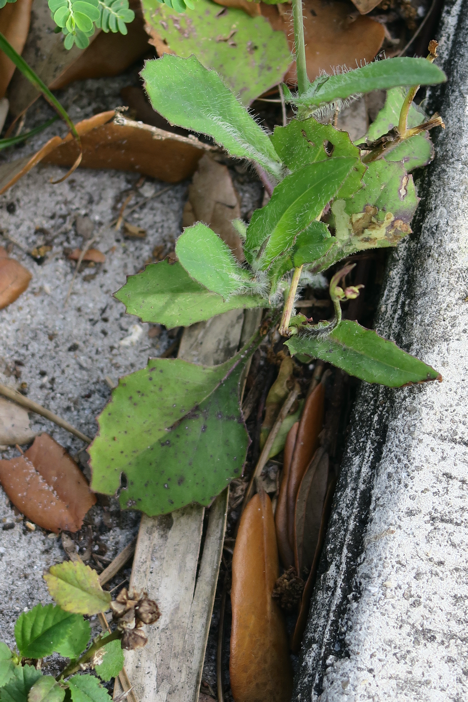
Red Tassleflower (Emilia fosbergii Nicolson)
Every time we walked past the place, I kept tabs on the plant. Every so often, the landowner would mow but this kept coming back after each mow. It’s a hardy little weed. It is also introduced from Asia like E. sonchifolia.66
Arnoglossum floridanum (A. Gray) H. Robinson
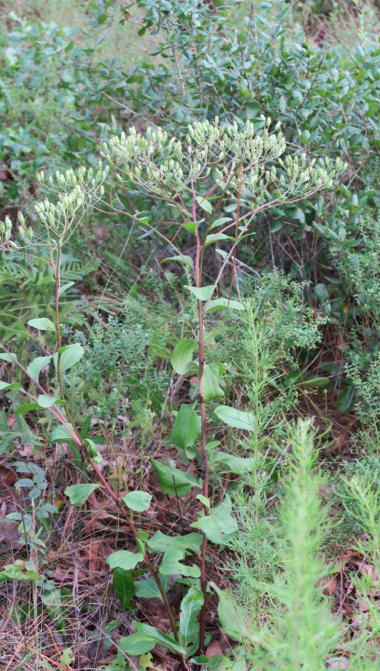
Florida Indian Plantain (Arnoglossum floridanum (A. Gray) H. Robinson)
There are eight species of Arnoglossum in the Flora and two are exclusive to Florida: A. floridanum and A. album which is restricted to two counties in Florida.67
 Florida Indian Plantain (Arnoglossum floridanum (A. Gray) H. Robinson)
Florida Indian Plantain (Arnoglossum floridanum (A. Gray) H. Robinson)
From the first photo, you can see stem leaves but there is also a basal rosette at the base of the stem. The basal rosette of leaves definitely looks like some species of plantain.
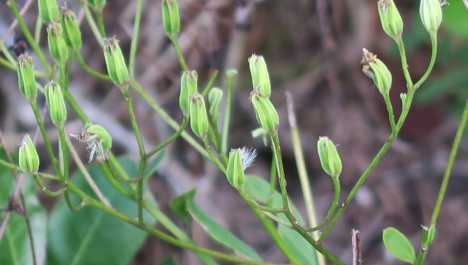 Florida Indian Plantain (Arnoglossum floridanum (A. Gray) H. Robinson)
Florida Indian Plantain (Arnoglossum floridanum (A. Gray) H. Robinson)
This had already bloomed (disc flowers only) and had already dispersed most of its seed. This was quite abundant along the Sink Hole Trail at Silver Springs State Park. You can see the papas attached to achenes.
Tetradymia canescens de Candolle
 Horsebrush(Tetradymia canescens de Candolle)
Horsebrush(Tetradymia canescens de Candolle)
This is a western genus with 10 species in North America.68 They are all shrubs.
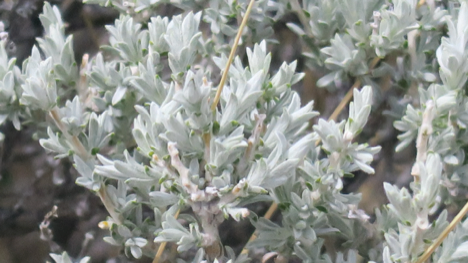 Horsebrush(Tetradymia canescens de Candolle)
Horsebrush(Tetradymia canescens de Candolle)
The leaves have a pubescence on the leaves giving a silver color.
I much appreciate the NPS labeling the plant on their nature trail at Great Sand Dunes National Park.
Tetradymia axillaris A. Nelson
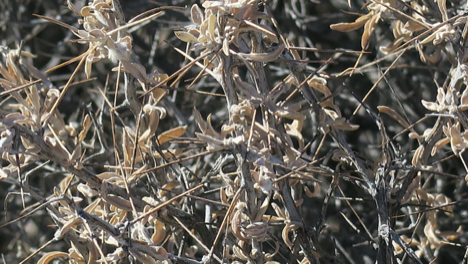 Cotton Thorn (Tetradymia axillaris A. Nelson)
Cotton Thorn (Tetradymia axillaris A. Nelson)
This plant is very anti-social. Those are some of the longest thorns I’ve seen on a plant. This was on a trail near Jumbo Rocks campground at Joshua Tree National Park.
Petasites frigidus(L.) Fries
 Coltsfoot (Petasites frigidus (L.) Fries)
Coltsfoot (Petasites frigidus (L.) Fries)
I have no idea why this is called coltsfoot. You can’t spend too much time in the west before you start hearing about this plant from some naturalist. For a while, I was never able to catch it in bloom.
There are heads of flowers that are all staminate and other heads that are all pistillate. There is only one species in North America but there are four varieties.69
 Coltsfoot (Petasites frigidus (L.) Fries)
Coltsfoot (Petasites frigidus (L.) Fries)
I finally found some that were just about to bloom.
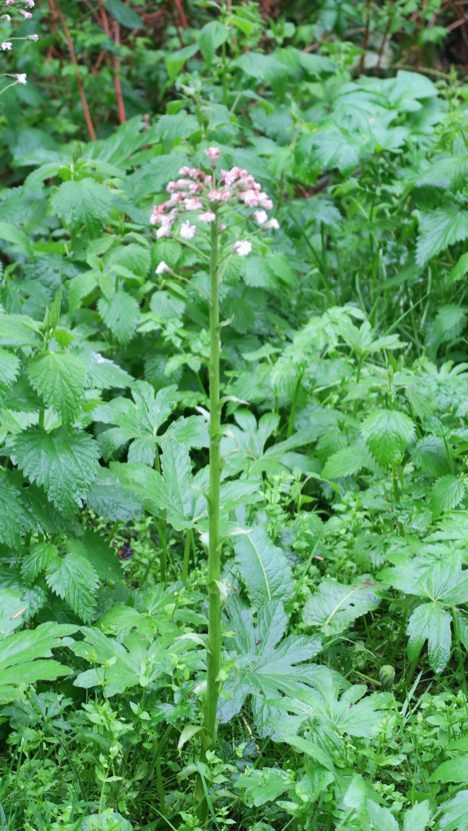 Coltsfoot (Petasites frigidus (L.) Fries)
Coltsfoot (Petasites frigidus (L.) Fries)
And finally - success!
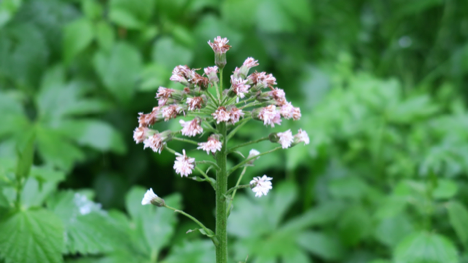 Coltsfoot (Petasites frigidus (L.) Fries)
Coltsfoot (Petasites frigidus (L.) Fries)
To be honest, I can’t determine if these are ray or disc flowers from the photo and I didn’t make any notation when I took the image. I also have no idea if this is staminate or pistillate in nature.
Melampodium leucanthum Torrey & A. Gray
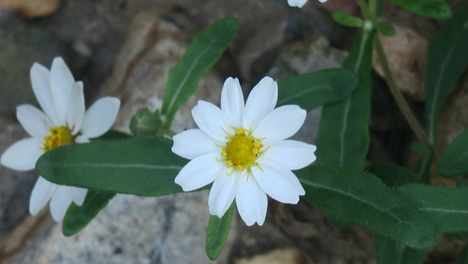 Blackfoot Daisy (Melampodium leucanthum Torrey & A. Gray)
Blackfoot Daisy (Melampodium leucanthum Torrey & A. Gray)
This was photographed along The Windows Trail at Big Bend in September of 2016. It was a startling white.
 Blackfoot Daisy (Melampodium leucanthum Torrey & A. Gray)
Blackfoot Daisy (Melampodium leucanthum Torrey & A. Gray)
Other than the bloom, what attracted me was the decussate arrangement of the leaves to maximize sun absorption.
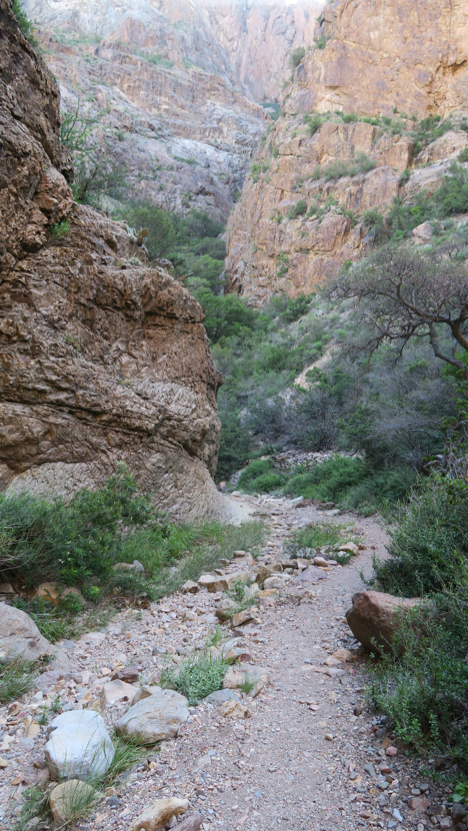 The Windows Trail - Big Bend National Park
The Windows Trail - Big Bend National Park
Rudbeckia hirta L.
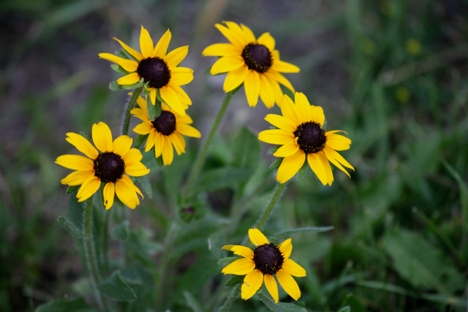 Black-eyed Susan (Rudbeckia hirta L.)
Black-eyed Susan (Rudbeckia hirta L.)
I was surprised to see 23 species of Rubeckia listed in Flora of North America,70 especially since I’ve only collected three.71 This old friend is the most widespread species in North America.72
It was common along the roadsides of Mississippi and was probably one of the first composites I learned to identify. I’ve pretty much seen it everywhere in my travels and often don’t photograph it but this cluster was particularly attractive to me.
Ratibida columnifera (Nuttall) Wooton & Standley
 Prairie Coneflower (Ratibida columnifera (Nuttall) Wooten & Stanley)
Prairie Coneflower (Ratibida columnifera (Nuttall) Wooten & Stanley)
There are four species of Ratibida in North America and R. columnifera is the most wide spread.73
What I find fascinating about this particular flower is the variations you can find in form and color. The first photo was at Devil’s Tower.
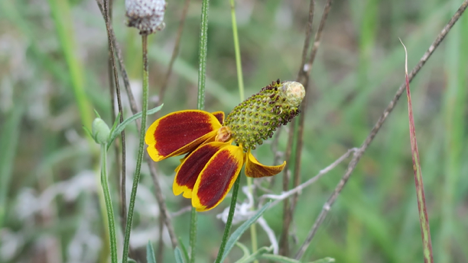 Prairie Coneflower (Ratibida columnifera (Nuttall) Wooten & Stanley)
Prairie Coneflower (Ratibida columnifera (Nuttall) Wooten & Stanley)
This photo was taken at Lost Maples State Natural Area in Texas. Regardless, cone flowers are noted for the cone-like receptacles that project above the involucre.
I’ve seen a lot of places that sell wildflower seeds with coneflowers as one of the seeds in the packet, so I guess it’s a popular sell. I can see why.
 Prairie Coneflower (Ratibida columnifera (Nuttall) Wooten & Stanley)
Prairie Coneflower (Ratibida columnifera (Nuttall) Wooten & Stanley)
I think I prefer the dark maroon colored ray flowers. Also note the very small disc flowers atop the cone.
Zinnia acerosa (de Candolle) A. Gray
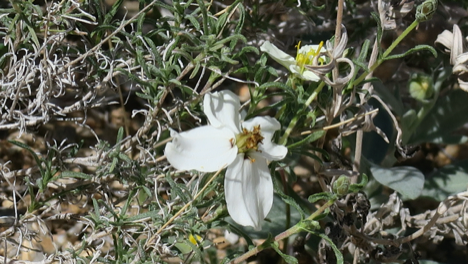 Desert Zinnia (Zinnia acerosa (de Candolle) A. Gray)
Desert Zinnia (Zinnia acerosa (de Candolle) A. Gray)
One of the houses our family lived in Morton, Mississippi was a home owned and rented out by Mr. Lawler. Dad worked for the Mississippi Highway Department and we moved all over the state - sometimes three times in one year. We stayed at the gray Lawler House for a few years and as a consequence, Dad planted flowers in front of the large picture window at the front of the house.
He worked the seasons in that flower bed. In spring, he planted nasturtiums. In summer and fall, we had zinnias. I first learned to plant seed and impatiently wait for them to sprout. He then taught me the importance of separating those seedlings too close together.
Zinnas, as a consequence, have a lock on my memory bank. I was therefore pleasantly surprised to find there were wild zinnas. This was photographed at Saguaro National Park, Ricon Mountain District outside of Tucson.
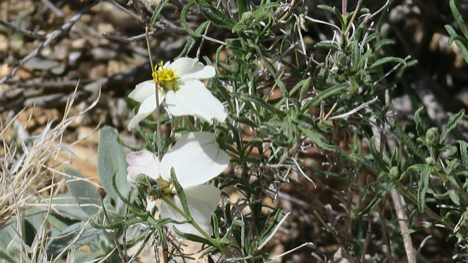 Desert Zinnia (Zinnia acerosa (de Candolle) A. Gray)
Desert Zinnia (Zinnia acerosa (de Candolle) A. Gray)
Unlike domesticated zinnas, these have very small leaves for water retention and there is a conservation in the number of ray flowers. In reality, this doesn’t look anything like the domesticated form.
There are five species in North America and four of those are western. Z. peurviana is most likely western but has been naturalized in the southeastern U.S. Z. violacea is not native but widely distributed throughout the southeastern U.S.74
Back to gardening. On the side of the house which was situated on a sloping hill, Dad allowed me to plant a vegetable garden. I assume he was humoring me since a sloping hill of clay is not real good gardening terrain. Be that as it may, I planted butter beans (known outside the south as lima beans). They grew. He eventually had to “stick” the beans to allow the runners of the beans to have a place to go. For some reason, the beans were prolific producers.
Dad had planted a garden at the base of the hill with much better soil and sunlight but my beans out performed his (or so he said). He kept saying the 5 or 6 beans I planted out produced his two rows. In reality, I don’t think we got but one “mess” of beans off my vines, but he was trying to encourage me.
Berlandiera subacaulis (Nuttall) Nuttall
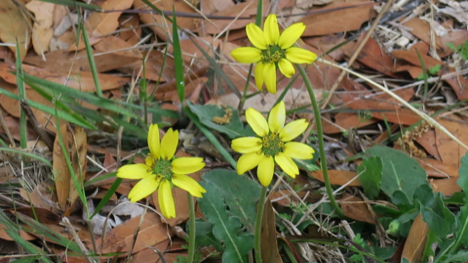 Florida Greeneyes (Berlandiera subacualis (Nuttall) Nuttall)
Florida Greeneyes (Berlandiera subacualis (Nuttall) Nuttall)
I had just begun my bike trip from Fanning Springs State Park on my way to Trenton, Florida via the Nature Coast Trail when I saw this growing along the bikeway. I immediately stopped and got a photograph.
What attracted my attention was the green center (disc flowers) of this composite with the yellow rays. Normally, you don’t see green in disc flowers. What is occurring in this photograph is the unopened disc flowers are green. Those that have opened are the normal yellow.
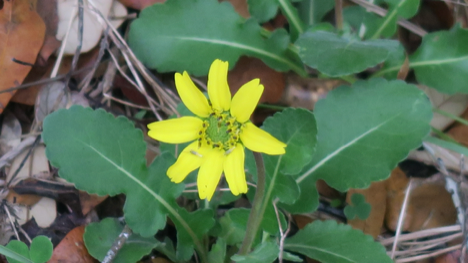 Florida Greeneyes (Berlandiera subacualis (Nuttall) Nuttall)
Florida Greeneyes (Berlandiera subacualis (Nuttall) Nuttall)
The common name is very appropriate. It’s only reported in the state of Florida.75
Echinacea angustifolia de Candolle
 Purple Coneflower (Echinacea angustifolia de Candolle)
Purple Coneflower (Echinacea angustifolia de Candolle)
Echinacea was one of those genera I was supposed to find during my Tishomingo days. Try as I might, I never found it within the confines of the park. After graduation, I ended up for a short time in Montana and then returned to be a park manager at Golden Memorial State Park outside of Walnut Grove, Mississippi.
As managers, we often traveled to a different park so the managers could get a feel for the variety of parks in the state. One such visit was to Tombigbee State Park outside of Tupelo, Mississippi. Guess what I found growing all over the park? It wasn’t this species but it was Echinacea. Coincidentally, the common name of the one in Mississippi was also purple coneflower.
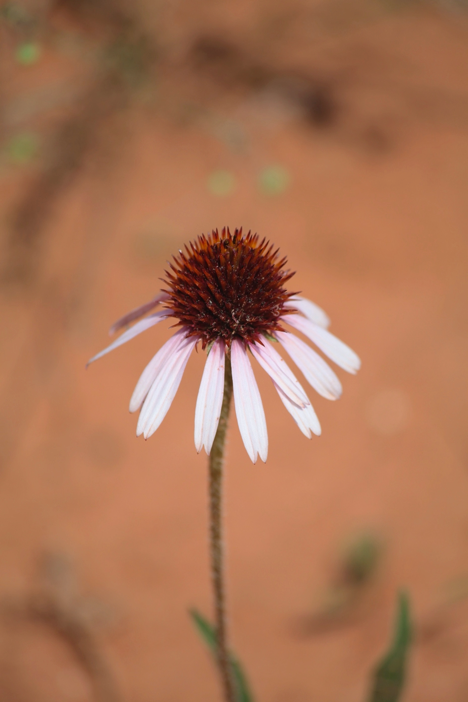 Purple Coneflower (Echinacea angustifolia de Candolle)
Purple Coneflower (Echinacea angustifolia de Candolle)
This particular species is midwestern in distribution.76 I first photographed it at Mount Rushmore in July of 2013 and then later the same month and year at Devil’s Tower, Wyoming.
Balsamorhiza sagittata (Pursh) Nuttall
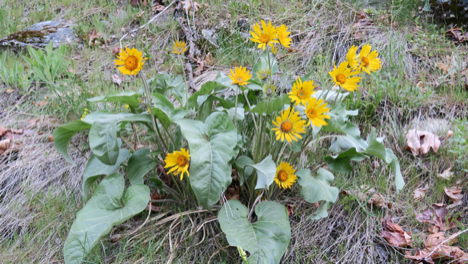 Arrow-leaved Balsamroot (Balsamorhiza sagittata (Pursh) Nuttall)
Arrow-leaved Balsamroot (Balsamorhiza sagittata (Pursh) Nuttall)
I’ve written about my reluctance of photographing and identifying members of the aster family. I had no such compunction with this species. It’s big, it’s showy, and it has very distinctive characteristics. I figured I could identify it fairly easily. I was correct.
The genus Balsamorhiza is a western species with 12 species in North America but this is the only one with a single head of flowers with arrowhead-shaped leaves.77 It’s also a pretty good indicator of spring.
 Arrow-leaved Balsamroot (Balsamorhiza sagittata (Pursh) Nuttall)
Arrow-leaved Balsamroot (Balsamorhiza sagittata (Pursh) Nuttall)
You can also see it from a distance. On one trip, I was traveling up Lake Chelan to Stehekin, Washington aboard the Lady Express. There are three ways into Stehekin: walk, fly into their small airport, or by boat. From the boat, I kept noticing these yellow patches on the sides of the mountains that surround the lake.
I only had a small backpacking camera with me and the zoom feature wasn’t enough for me to zero in but I vowed to find out what they were once ashore.

Lake Chelan on the Way to Stehekin, Washington
Two days later I was hiking the Lakeshore Trail at Stehekin and found my yellow flowers seen from the Lady Express.
The roots and seeds are considered edible (Wikipedia).
Verbesina virginica L.
 White Crownbeard (Verbesina virginica L.)
White Crownbeard (Verbesina virginica L.)
I knew I had seen this plant before. It looked just too familiar. I kept racking my brain about it. It took a while but it finally came to me. I had collected it at Tishomingo78 and, believe it or not, I remembered the genus. I have no idea how I did that. It’s been 42 years ago that I did my graduate work in plants but every so often, a name comes back to me.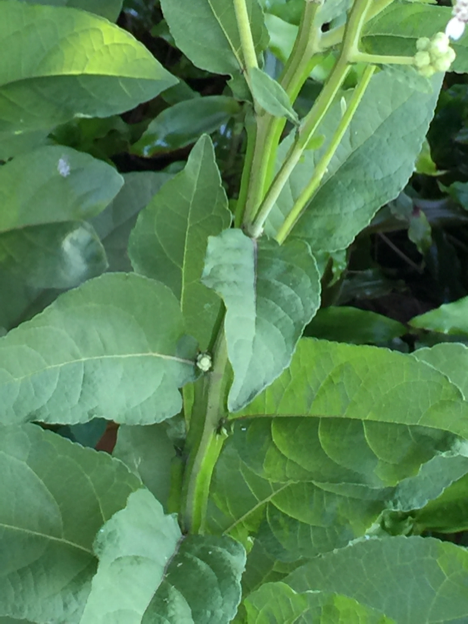
White Crownbeard (Verbesina virginica L.)
Notice the stem of the plant is winged (leaf-like ridges along the stem).
 White Crownbeard (Verbesina virginica L.)
White Crownbeard (Verbesina virginica L.)
The flowers are very delicate looking and almost a pure white. There are not many ray flowers and also just a few disc flowers per head.
I first found it in my neighborhood which was really strange. My area is not a typical habitat for the plant. Where I found it, a neighbor typically placed bulk trash for pickup by the city. I suspect the neighbor had it either in some wildflower seeds or it was found in some mulch he purchased.
I have since photographed it in Lost Maples State Natural Area near Vanderpool, Texas and at Myakka River State Park near Sarasota, Florida.
Those ray flowers are a very pure white!
Enceliopsis nudicaulis (A. Gray) A. Nelson
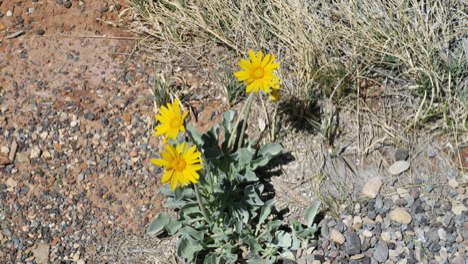 Naked Stem Sunrays (Enceliopsis nudicaulis (A.Gray) A. Nelson)
Naked Stem Sunrays (Enceliopsis nudicaulis (A.Gray) A. Nelson)
I found this little beauty on Chimney Rock Trail at Capitol Reef National Park.
Years ago, when I went to work as a botanist/plant ecologist for the Bureau of Land Management (BLM) in Miles City, Montana (a short-lived job) I had to come up with some method of determining the density of plants. To be honest, I had never done that type of analysis and so I started to read up on the subject (they hired me in the winter so I had a lot of reading time).
One method very popular is the line transect method. I couldn’t quite understand how that would work particularly since you would stretch a line over some area and identify and count the plants that touched the line. I kept defaulting to my experience in the southeastern U.S. where you would end up with three or four plants touching the same point on a line due to the massive quantity of vegetation in the south.
It finally dawned on me the line transect method was devised for the western U.S. You might through out a line for a transect and it maybe would have one or two plants that hit the line. Plants are much fewer and farther between in the west.
It was especially brought home with the BLM when they leased land for cattle grazing. It might take 10 acres of land to feed one cow out west because of the sparseness of the vegetation.
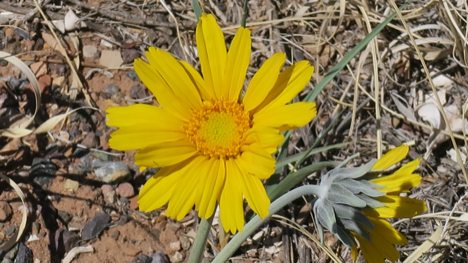 Naked Stem Sunrays (Enceliopsis nudicaulis (A.Gray) A. Nelson)
Naked Stem Sunrays (Enceliopsis nudicaulis (A.Gray) A. Nelson)
The “naked” part comes from no leaves on the stem. Also note the abundance of very short hairs on the stem and the involucre, giving a “frosty” appearance.
Phoebanthus grandiflorus (Torrey & A. Gray) S.F. Blake
 Florida False Sunflower(Phoebanthus grandiflorus (Torrey & A. Gray) S.F. Blake)
Florida False Sunflower(Phoebanthus grandiflorus (Torrey & A. Gray) S.F. Blake)
There are two species of this plant in North America: P. grandiflorus and P. tenuifolius. The difference is basically in the width of the leaves. P. grandiflorus leaves are 3-7 mm wide and P. tenuifolius are 0.5-2 mm wide. P. grandiflorus is found only in Florida whereas P. tenuifolius is found in Florida and Alabama.79
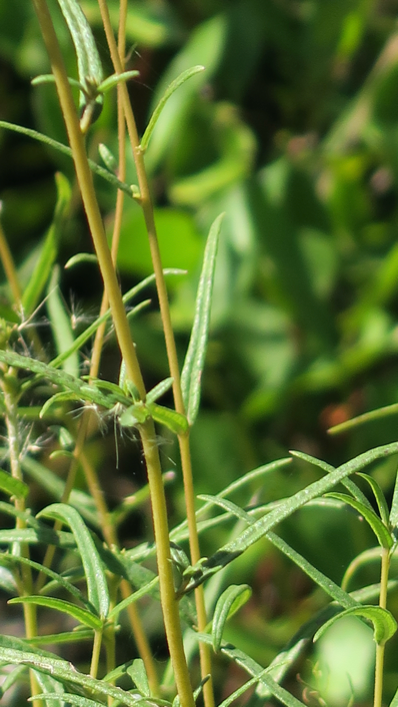
Florida False Sunflower(Phoebanthus grandiflorus (Torrey & A. Gray) S.F. Blake)
My guess is these are at least 5mm in width. These photos were taken at Myakka River State Park near Sarasota, Florida.
Encelia farinosa A. Gray ex Torrey
 Brittlebush (Encelia farinosa A. Gray ex Torrey)
Brittlebush (Encelia farinosa A. Gray ex Torrey)
There are eight species in North America and they are all found in the southwestern U.S.80
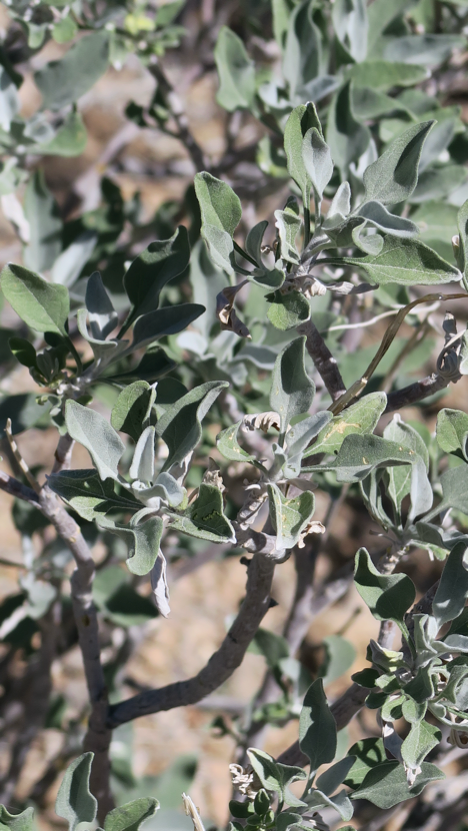 Brittlebush (Encelia farinosa A. Gray ex Torrey)
Brittlebush (Encelia farinosa A. Gray ex Torrey)
Unfortunately, I didn’t capture this in bloom. It has large heads of yellow ray and disc flowers. The California Native Plant Society and Flora of North America81 both report fragrant leaves but don’t provide any information as to the aroma.
This was photographed at the Desert Discovery Nature Trail (which had it labeled) at Saguaro National Park, Tuscon Mountain District.
Encelia californica Nuttall
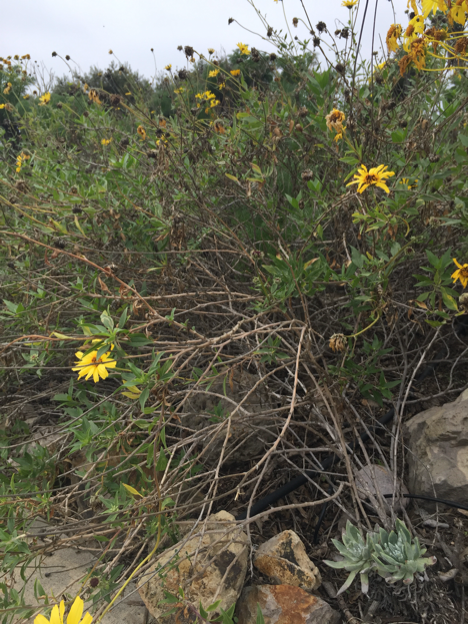
Bush Sunflower (Encelia californica Nuttall)
If you ever visit the Channel Islands National Park, I highly recommend you stop in at the visitor center in Ventura, California. I also highly recommend you first make your reservations for the boat to the islands six months in advance.
While at the visitor center, be sure to walk through their wildflower garden. They label most plants and I learned what to look for in the Channel Islands based on the vegetation they had in the garden.
This particular plant is quite large and spreading. It’s unusual to see sunflower type flowers on a shrub. The plant is found in coastal scrub of California.82
Geraea canescens Torrey & A. Gray
 Desert Sunflower (Geraea canescens Torrey & A. Gray)
Desert Sunflower (Geraea canescens Torrey & A. Gray)
This is reported in four states: Arizona, California, Utah and Nevada.83 I photographed it in Death Valley along the roadside. It certainly fits with the common name.
 Desert Sunflower (Geraea canescens Torrey & A. Gray)
Desert Sunflower (Geraea canescens Torrey & A. Gray)
Perhaps, as interesting as the flower are the leaves with the very dense pubescence covering both sides and the stems. As I look at this photo, I now realize I missed another wildflower (white composite) just to the left of the main stem. Sometimes I get so focused on one thing and don’t get the big picture.
Melanthera nivea (L.) Small
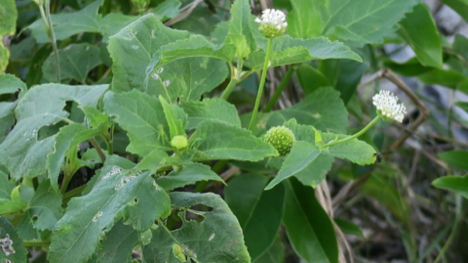
Snow Squarestem (Melanthera nivea (L.) Small)
Well, the white flowers represent snow and the stems are definitely square, so the common name is appropriate. There are three species in the Flora: M. nivea (seven states including Florida) M. angustifolia (Florida only) and M. parvifolia (Florida only).84
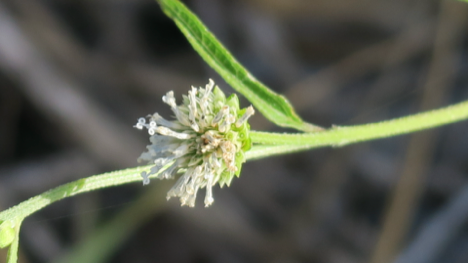
Snow Squarestem (Melanthera nivea (L.) Small)
There typically are no ray flowers and, as you see, this is composed of all disc flowers. I like how the stigmas of the pistil curl backwards on themselves.
I’ve found this in two locations in Florida: Secret Garden Nature Center in Fort Lauderdale and Bahia Honda State Park. Normally, if I were to go based on location alone, this would be M. parvifolia. It’s only found in the Florida Keys, particularly in Big Pine Key where you find Bahia Honda.
However, the description for M. parvifolia states the heads of flowers are born singly at the tips of stems. The description for M. nivea states the heads of flowers are born in the axils of modified leaves.85 The image shows the latter case. Such can be the distinction between two species.
Sphagneticola trilobata (L.) Pruski
 Wedelia (Sphagneticola trilobata (L.) Pruski)
Wedelia (Sphagneticola trilobata (L.) Pruski)
Confusingly, there is a genus of plants Wedelia. The common name for this plant is Wedelia and it is in the genus Sphagneticola.
This was the first flower I probably learned when I came to Florida because it was everywhere in yards and roadsides. It’s only reported in the state of Florida and its suggested it is a subtropical or tropical New World plant that has escaped.86
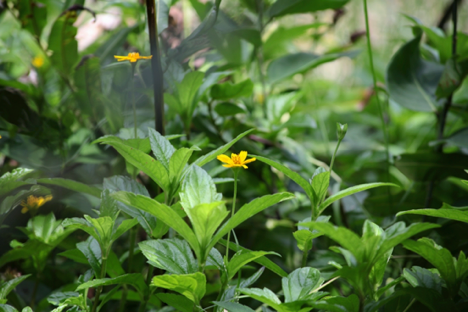
Wedelia (Sphagneticola trilobata (L.) Pruski)
I think a lot of people began to use it as a ground cover. It works well for that but can get out of control. The trilobata comes from the three lobes on some but not all of the leaves.
Eclipta prostrata (L.) L.
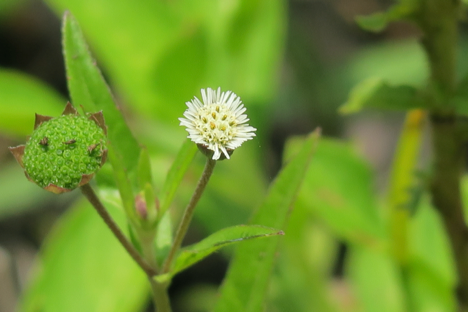
False Daisy (Eclipta prosrtata (L.) L.)
I collected this in Tishomingo back when it went by Eclipta alba.87 Believe it or not, there are ray flowers on this head. They are simply very short and very small. The disc flowers are obvious in the center.

False Daisy (Eclipta prostrata (L.) L.)
The leaves and stems are described as scabrellous.88 In essence, the hairs on the stems and leaves life flat for the most part and appear as tiny scales.
This was photographed at Archbold Biological Station near Venus, Florida. However, it is widespread throughout the eastern U.S. and southwestern U.S.89
Borrichia arborescens (L.) de Candolle
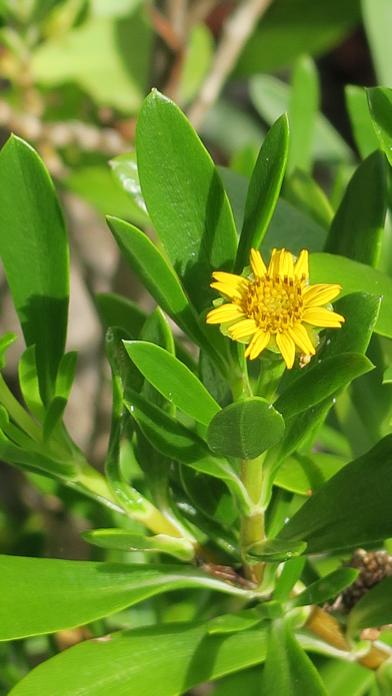
Sea Oxeye Daisy (Borrichia arborescens (L.) de Candolle)
This was forming mats at Bahia Honda State Park at Big Pine Key. The leaves and stems are very fleshy.

Sea Oxeye Daisy (Borrichia arborescens (L.) de Candolle)
In this photo, you can see salt crystals on the leaves. The plant was growing on the Atlantic side of the park. It is found only in the Florida Keys.90
Borrichia frutescens (L.) de Candolle
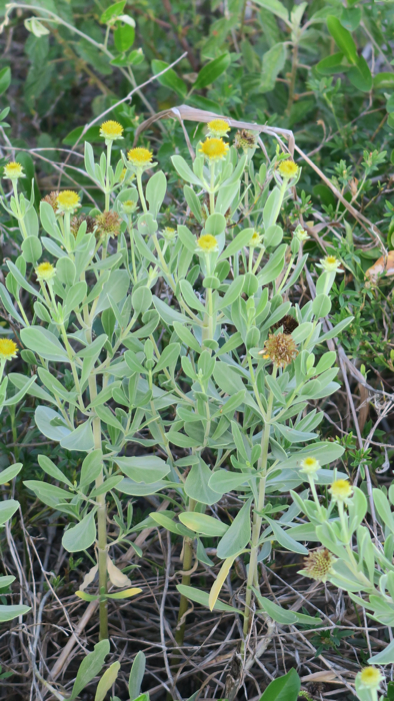
Sea Oxeye Daisy (Borrichia frutescens (L.) de Candolle)
These, on the other hand, were growing upright, not in mats, and were smaller in size.
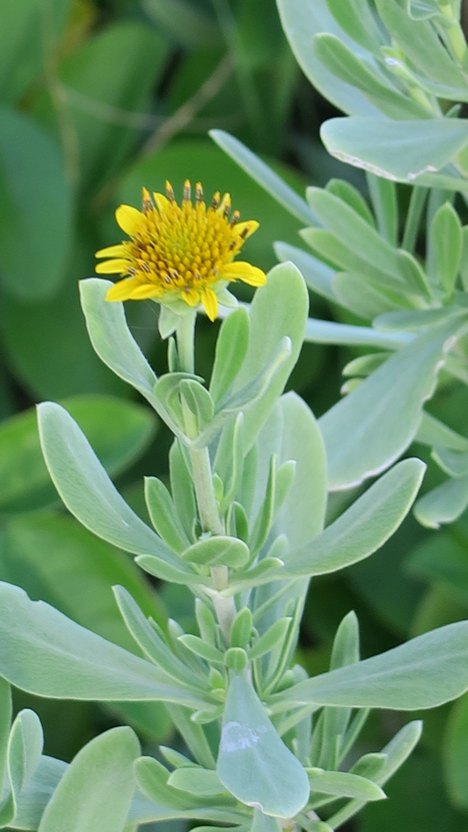
Sea Oxeye Daisy (Borrichia frutescens (L.) de Candolle)
Although both (B. arborescens and B. frutescens) were growing in the same general location, there was a distinct difference in the colors of the foliage. Flora suggests this grows more in salt marsh or brackish water.91 I remember it growing along a path towards the ocean in the same area as B. arborescens that could have been described as brackish when tides over flowed the area.
Calyptocarpus vialis Lessing
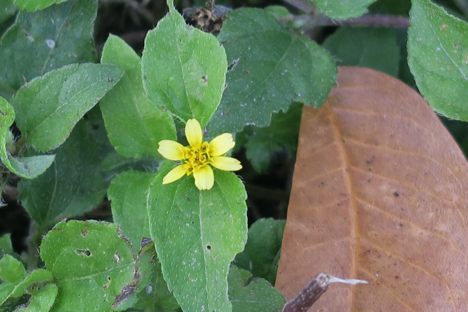 Horsemint (Calyptocarpus vialis Lessing)
Horsemint (Calyptocarpus vialis Lessing)
You really have to be observant to see this plant. It grows like a ground cover here in Florida but more individually elsewhere in the U.S. The flowers are very tiny with just a few ray and disc flowers.
There is only one species in Flora of North America and that is restricted to five states: Florida, Alabama, Mississippi, Louisiana and Texas.92
I was used to seeing it in Florida along my walks with Rocky. I was very surprised when I found in growing in my campsite at Lost Maples State Natural Area in Texas.
Helianthus annuus L.
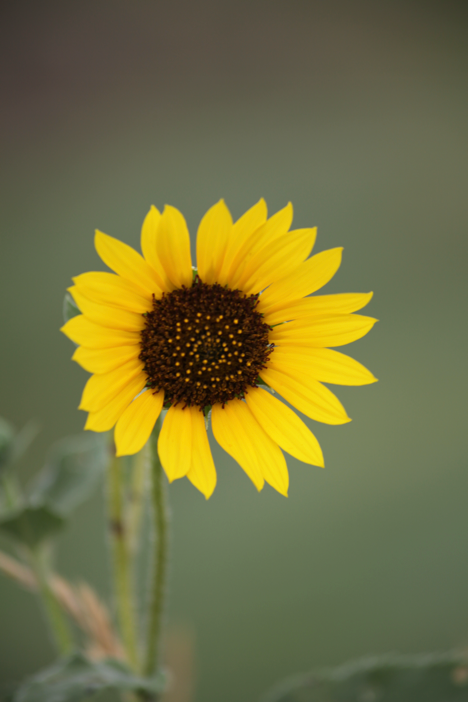 Common Sunflower (Helianthus annuus L.)
Common Sunflower (Helianthus annuus L.)
There’s absolutely nothing common about sunflowers. They always give a thrill when you see them and it’s even more fun to watch them track the sun over a day’s time.
There are 52 species of Helianthus in the Flora93 and during my Tishomingo days, I collected four of those.94 None have the impact of H. annuus. It’s found in all 48 contiguous states and most of Canada.95
Viguiera stenoloba S.F. Blake
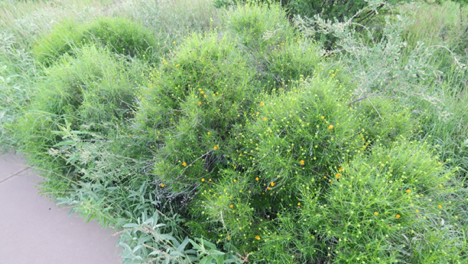 Skeletonleaf Goldeneye (Viguiera stenoloba S.F. Blake)
Skeletonleaf Goldeneye (Viguiera stenoloba S.F. Blake)
This was growing outside the lodge at Big Bend National Park. It was shrub size but the flowers were relatively small in comparison to the size of the shrub.
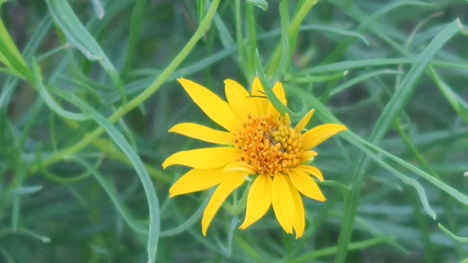 Skeletonleaf Goldeneye (Viguiera stenoloba S.F. Blake)
Skeletonleaf Goldeneye (Viguiera stenoloba S.F. Blake)
I assume the common name refers to the very narrow, filament-like leaves on the plant.
Tetragonotheca helianthoides L.
 Pineland Ginseng, Squarehead (Tetragonotheca helianthoides L.)
Pineland Ginseng, Squarehead (Tetragonotheca helianthoides L.)
I’m not sure where the “ginseng” part comes in but the “pineland” and “squarehead” is dead on the money. This is a really unusual head for a composite, at least to me.
There are four species reported in Flora of North America and three of those are exclusive to Texas. T. helianthoides is found in the southeastern U.S. but not Texas.96
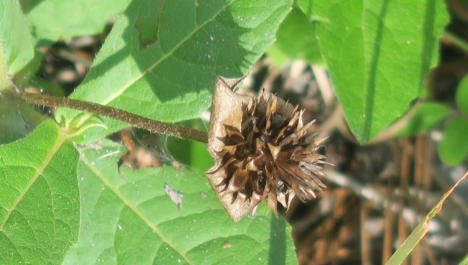 Pineland Ginseng, Squarehead (Tetragonotheca helianthoides L.)
Pineland Ginseng, Squarehead (Tetragonotheca helianthoides L.)
It is the involucral bractss that give the name “squarehead.” I photographed this along the Sand Hill Trail at Silver Springs State Park, Florida.
Coreopsis gigantea (Kellogg) H.M. Hall

Giant Coreopsis (Coreopsis gigantea (Kellogg) H.M. Hall)
I’ve been fond of the genus Coreopsis since my Tishomingo days. For some reason, the genus stands out to me and I can recognize it unlike many members of the aster family. I have no idea why but it sticks with me.
This was a big surprise. I’ve seen members of the aster family in shrub size before but this was jaw dropping.
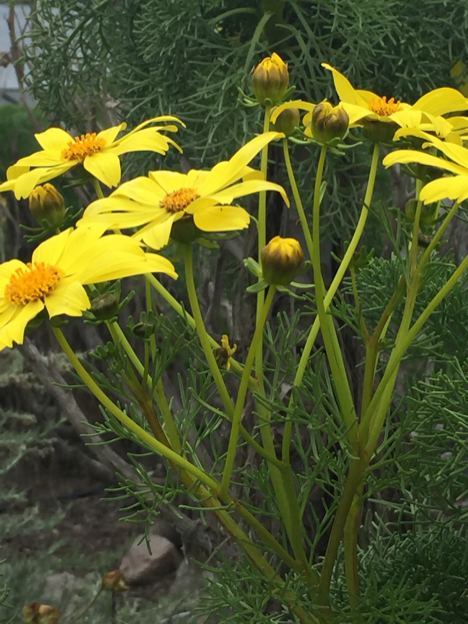
Giant Coreopsis (Coreopsis gigantea (Kellogg) H.M. Hall)
This is restricted to California and Baja California.97 The leaves are lobed and the lobes are referred to as filiform (or threadlike).
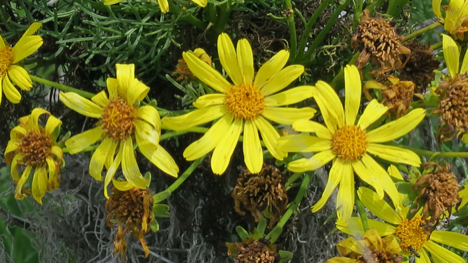
Giant Coreopsis (Coreopsis gigantea (Kellogg) H.M. Hall)
I will have to admit I did not recognize it as a Coreopsis. The flowers don’t have the usual features that seem to key me into the genus. This was photographed on Santa Cruz Island in the Channel Islands National Park. There were quite a few scattered all over the island.
Coreopsis gladiata Walter
 Tickseed (Coreopsis gladiata Walter)
Tickseed (Coreopsis gladiata Walter)
This flower I immediately identified to the genus Coreopsis. It ticks all the boxes in my mind for the plant.
 Tickseed (Coreopsis gladiata Walter)
Tickseed (Coreopsis gladiata Walter)
The one unusual feature to me was the orange “ring” around the disc flowers.
From my reading of Flora of North America, I think there is still some controversy over the genus. The 28 species listed are divided into eight sections.98
For example, for C. gladiata, the Flora states “As here circumscribed, Coreopsis gladiata includes plants that others (without agreement among themselves) have treated as distinct species and/or varieties:....” (My emphasis.)99
This was growing in the prairie of Kissimmee Prairie Preserve State Park.
Bidens pilosa L.
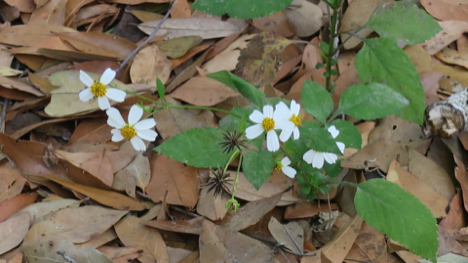 Spanish Needles (Bidens pilosa L.)
Spanish Needles (Bidens pilosa L.)
When I moved to Florida in 1985 to take up a teaching position at (then) Broward Community College, this was called Bidens alba. Somewhere in the in between years, it was changed to B. pilosa.
This is pretty much considered a weed in south Florida but I try to encourage it whenever I can in my yard.
 Spanish Needles (Bidens pilosa L.)
Spanish Needles (Bidens pilosa L.)
There aren’t that many ray or disc flowers but what few are present really do show off the plant.
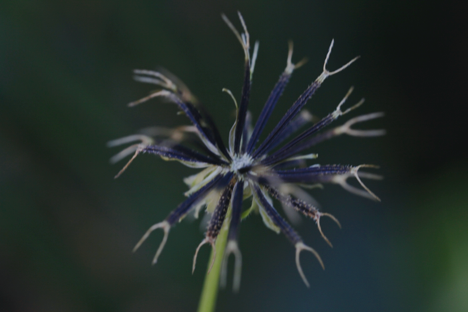 Spanish Needles (Bidens pilosa L.)
Spanish Needles (Bidens pilosa L.)
When fruit develops, the achenes have two large retrorsely (pointing backwards) barbed awns. There are 25 species of Bidens listed in Flora of North America.100
Flaveria linearis Lagasca
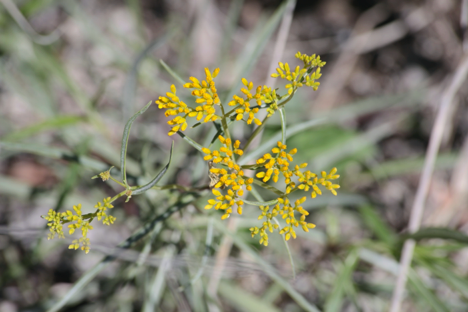 Coastal Plain Yellowtops (Flaveria linearis Lagasca)
Coastal Plain Yellowtops (Flaveria linearis Lagasca)
This typically has only disc flowers and only a few of those per head. The linearis comes from the linear-shaped leaves of the plant.
One interesting feature of the genus is that different species exhibit different forms of photosynthesis.101 There are three basic forms of photosynthesis: the Calvin Cycle or C3 pathway, the C-4 pathway and finally Crassulacean Acid Metabolism (CAM Photosynthesis). You could add a fourth version as a C3-C4 intermediate pathway. Flaveria liners apparently does the C3-C4 intermediate pathway (Plant Phyiology, 1998)
This was photographed on the loop road of Old Tamiami Trail, Big Cypress Preserve.
Layia glandulosa (Hooker) Hooker & Arnott
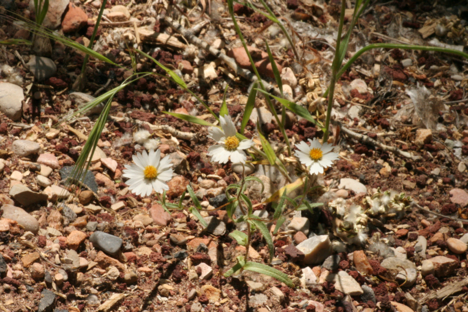 White Layia (Layia glandulosa (Hooker) Hooker & Arnott)
White Layia (Layia glandulosa (Hooker) Hooker & Arnott)
There are 14 species of Layia listed in Flora of North America and all but L. glandulosa are restricted to the state of California.102
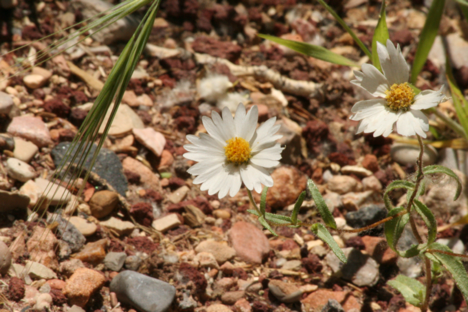 White Layia (Layia glandulosa (Hooker) Hooker & Arnott)
White Layia (Layia glandulosa (Hooker) Hooker & Arnott)
You can just make out the glandular hairs on the leaves and stems and Flora reports some are spice scented, whatever that means.103
This was photographed along the roadside of Zion National Park.
Lasthenia californica De Candolle ex Lindley
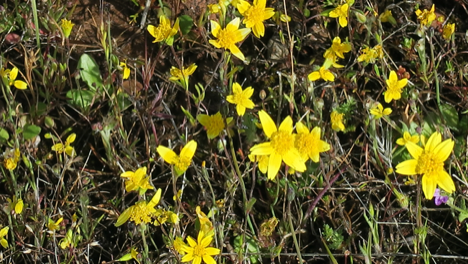 Goldfields (Lasthenia californica De Candolle ex Lindley)
Goldfields (Lasthenia californica De Candolle ex Lindley)
These were a delight as I hiked in Pinnacles National Park. I was a little surprised at the abundance and a little taken aback by how few ray flowers there were. Based on the scarcity of ray flowers and their leaf structure, I took a chance I might find their identify in a local wildflower guide.
 Goldfields (Lasthenia californica De Candolle ex Lindley)
Goldfields (Lasthenia californica De Candolle ex Lindley)
What really stood out to me were the hairy leaves. It’s not unusual for leaves to be hairy in plants but what is unusual is for there to be such large, single hairs scattered over the surface of the leaves.
I later found another field of these towards the entrance of Lassen Volcanic National Park.
Eriophyllum staechadifolium Lagasca
 Lizard Tail, Wooly Sunflower (Eriopohyllum staechadifolium Lagasca)
Lizard Tail, Wooly Sunflower (Eriopohyllum staechadifolium Lagasca)
I don’t see lizard tails at all. I can see wooly sunflowers.
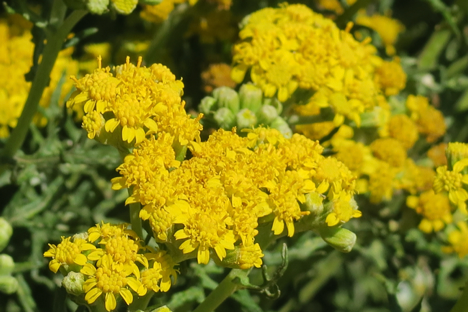 Lizard Tail, Wooly Sunflower (Eriopohyllum staechadifolium Lagasca)
Lizard Tail, Wooly Sunflower (Eriopohyllum staechadifolium Lagasca)
I’ve photographed these on two different locations but consistent with the environment - seacoasts. First, I saw them at Twin Peaks in San Francisco and later I saw them again on Santa Cruz Island in Channel Islands National Park.
The plant is definitely shrubby.
 Lizard Tail, Wooly Sunflower (Eriopohyllum staechadifolium Lagasca)
Lizard Tail, Wooly Sunflower (Eriopohyllum staechadifolium Lagasca)
I suppose if you use your imagination, you could see a lizard tail or two in the leaves.
Arnica mollis Hooker
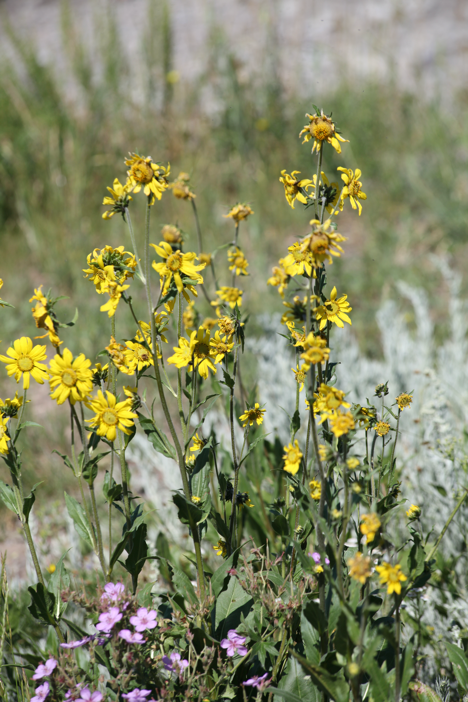
Hairy Arnica (Arnica mollis Hooker)
Arnica, except for A. acaulis this is a western species (26 total in the Flora)104 and I never came across it in my graduate work. There’s always some trepidation when you come across a new species much less a new genus but then there’s always the puzzle-solving attitude with the plant that gets you started.
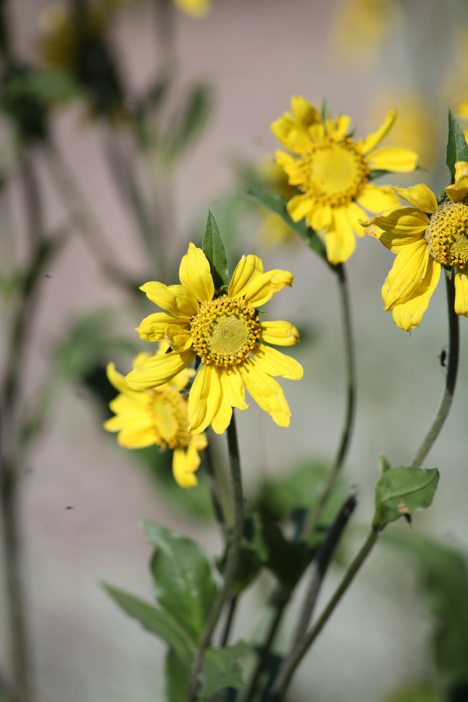
Hairy Arnica (Arnica mollis Hooker)
The amount of hairs on leaves and stems always varies. The older the plant, the more likely some of the hairs have worn off. In the first photograph, you can see some grayish hairs on the younger stems. In the second photograph, they are less visible.
This was photographed on Signal Mountain, Grand Teton National Park.
Arnica ovata Greene
 Sticky Arnica (Arnica ovata Greene)
Sticky Arnica (Arnica ovata Greene)
This starts out with a basal rosette of leaves but during flowering, they often wilt away.105 The petioles of the stem leaves often have small wings to either side and as you might guess from the common name, there are glandular hairs on the plant.
Flora of North America reports the habitat as “moist meadows and conifer forests...montane to subalpine....”106 That fits with where I found it - Eva Lake - The Bugaboos, British Columbia at an elevation of 7,020 feet above sea level.
Amauriopsis dissecta (A. Gray) Rydberg
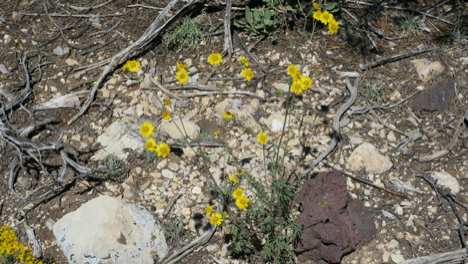 Ragleaf Bahia (Amauriopsis dissecta (A. Gray) Rydberg)
Ragleaf Bahia (Amauriopsis dissecta (A. Gray) Rydberg)
This is a first time genus and species for me. It was a neat little composite found on the north rim of the Grand Canyon.
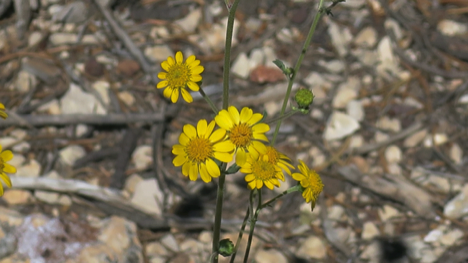 Ragleaf Bahia (Amauriopsis dissecta (A. Gray) Rydberg)
Ragleaf Bahia (Amauriopsis dissecta (A. Gray) Rydberg)
I must have felt the ray flowers were distinct enough for me to make the identification, along with the dissected leaves at the base of the plant.
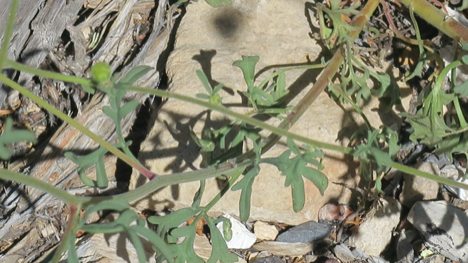 Ragleaf Bahia (Amauriopsis dissecta (A. Gray) Rydberg)
Ragleaf Bahia (Amauriopsis dissecta (A. Gray) Rydberg)
There is a genus Bahia in the aster family but this is not it. I’m not sure what separates the two.
Chaenactis douglasii (Hooker) Hooker & Arnott var. douglasii
 Alpine Dustymaiden (Chaenactis douglasii (Hooker) Hooker & Arnott var. douglasii)
Alpine Dustymaiden (Chaenactis douglasii (Hooker) Hooker & Arnott var. douglasii)
Seventeen species of Chaenactis are found in the western U.S.107 Based on the stem leaves, Flora of North America says this is C. douglasii var. douglasii.108 There typically are no ray flowers in this genus.
This was photographed in the Upper Geyser Basin of Yellowstone National Park.
Chaenactis stevioides Hooker & Arnott
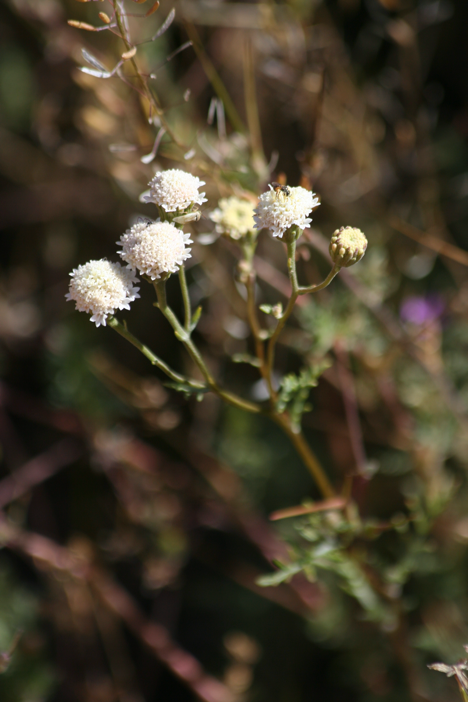 Esteve’s Pincushion (Chaenactis stevioides Hooker & Arnott)
Esteve’s Pincushion (Chaenactis stevioides Hooker & Arnott)
This photo was taken at Pipe Springs National Monument. The only reason we stopped here was a Tauck Tour midpoint on our way from Canyonlands National Park to Grand Canyon North Rim. It was a means to stretch our legs. Pipe Springs was important simply because of the presence of water in a very arid environment. As you might guess, I was more interested in photographing plants.
 Esteve’s Pincushion (Chaenactis stevioides Hooker & Arnott)
Esteve’s Pincushion (Chaenactis stevioides Hooker & Arnott)
This photo was taken along the roadside of Death Valley National Park. I find the spiderlings interesting among the disc flowers. Either that or they are very large mites.
Helenium vernale Walter
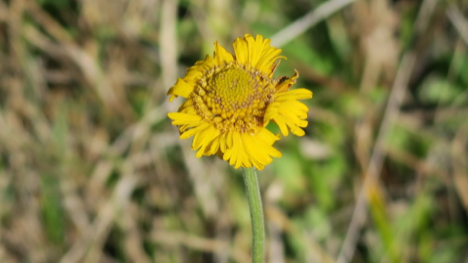 Spring Sneezeweed (Helenium vernale Walter)
Spring Sneezeweed (Helenium vernale Walter)
It was spring (March 2017) when I photographed this so the identification must be correct! Helenium is another one of those genera I find relatively easy to identify. This particular plant was growing along the Nature Coast Trail between Chiefland and Fanning Springs, Florida.
Tetraneuris acaulis (Pursh) Greene
 Stemless Hymenoxys (Tetraneuris acaulis (Pursh) Greene)
Stemless Hymenoxys (Tetraneuris acaulis (Pursh) Greene)
This is probably the worse common name for any plant. First, it is no longer in the genus Hymenoxys. Second, it’s not stemless, as you can see. What they mean is there are no leaves on the stems. All the leaves are basal.
There are four varieties in the Flora 109 and if you compare the first photo to the second photo, you can see a great deal of variation.
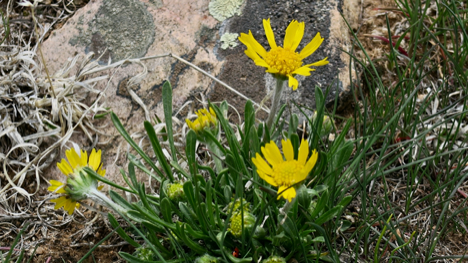 Stemless Hymenoxys (Tetraneuris acaulis (Pursh) Greene)
Stemless Hymenoxys (Tetraneuris acaulis (Pursh) Greene)
The first photo was taken at Le Fevre Overlook at Kaibab National Forest near the north rim of the Grand Canyon. The second photo was taken at Pulpit Rock Overlook at Black Canyon of the Gunnison National Park.
Le Fevre Overlook is at 6,700 feet elevation and it overlooks part of the Grand Canyon.
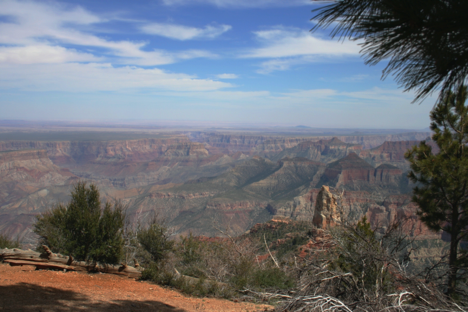
Le Fevre Overlook - Kaibab National Forest
Psilostrophe tagetina (Nuttall) Greene
 Wooly Paperflower (Psilostrophe tagetina (Nuttall) Greene)
Wooly Paperflower (Psilostrophe tagetina (Nuttall) Greene)
I didn’t see much wooly but the paperflower description is accurate. The ray flowers do indeed have a paper-like thinness to them.
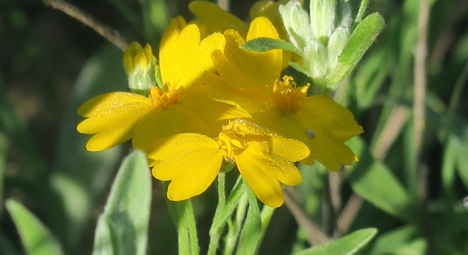 Wooly Paperflower (Psilostrophe tagetina (Nuttall) Greene)
Wooly Paperflower (Psilostrophe tagetina (Nuttall) Greene)
The leaves have short hairs on them, so I guess you can say they also have a wooly appearance but I’ve seen more pronounced versions of wooly on other plants than I saw in this plant. The ray flowers also look askew on the head.
This is a western species (Lady Bird Johnson Wildflower Center). I photographed it along The Windows Trail at Big Bend National Park and later along the roadside of Capitol Reef National Park.
Eupatorium album L. var. album
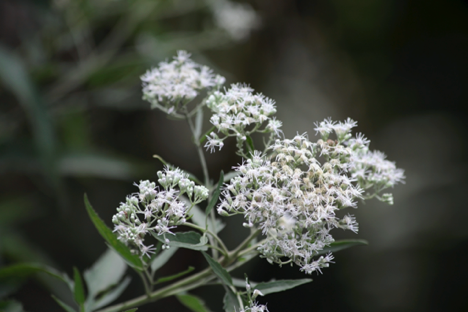 White Thoroughwort (Eupatorium album L. var. album )
White Thoroughwort (Eupatorium album L. var. album )
I’ve collected and identified 10 species of Eupatorium in Tishomingo State Park.110 Of those 10, only five remain in the genus. The other five have been farmed out to other genera in the Flora.111
There are three varieties of this particular species in the Flora but only one variety is found in Florida.112
Thoroughwort is a common name often associated with the genus Eupatorium as well as boneset and snakeroot. I think I remember reading years ago that the term boneset was used because it was supposed if you drank a tea made from it, it would speed bone setting. I wouldn’t bet on that.
This was photographed at Secret Woods Nature Center in Fort Lauderdale.
Conoclinum dissectum A. Gray
 Palmleaf Mistflower (Conoclinum dissectum A. Gray)
Palmleaf Mistflower (Conoclinum dissectum A. Gray)
This, at one time, was in the genus Eupatorium. It was also previously classified as E. greggii. I’m sure there are good reasons from the classification change, however, it has taken me a while to adjust to the genus Conoclinum.
 Palmleaf Mistflower (Conoclinum dissectum A. Gray)
Palmleaf Mistflower (Conoclinum dissectum A. Gray)
As you can see from the image, the term dissectum is probably more descriptive than naming the plant after Gregg. However, I’m not so sure the leaf looks palm-like. Palmleaf Mistflower (Conoclinum dissectum A. Gray)
Palmleaf Mistflower (Conoclinum dissectum A. Gray)
The flowers are extremely delicate looking and I think you can get the idea of mist-like. All the flowers are disc flowers - no ray flowers need apply.
This was at the head of the trail leading to The Windows at Big Bend National Park.
Conoclinum coelestinum (L.) de Candolle
 Purple Mistflower (Conoclinum coelestinum (L.) de Candolle)
Purple Mistflower (Conoclinum coelestinum (L.) de Candolle)
This is an old friend from Tishomingo. At the time, it was Eupatorium coelestinum. This is widespread in the eastern U.S.113 whereas C. disssectum is a western species.114
I found this when my friend Pat took me out to the loop road on Old Tamiami Trail in Big Cypress Preserve.
Brickellia californica (Torrey & A. Gray) A. Gray
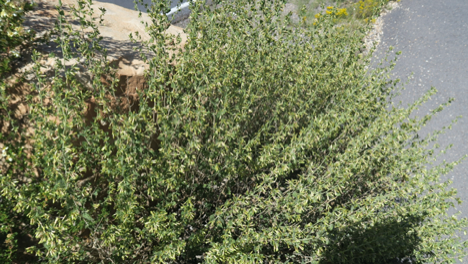 Brickelbush (Brickellia californica (Torrey & A. Gray) A. Gray)
Brickelbush (Brickellia californica (Torrey & A. Gray) A. Gray)
This certainly is a bush. I had not been exposed to the genus before and I had no idea as to what it was.
 Brickelbush (Brickellia californica (Torrey & A. Gray) A. Gray)
Brickelbush (Brickellia californica (Torrey & A. Gray) A. Gray)
The only thing I could tell was it was a member of the aster family. After so many searches for Grand Canyon plants, I settled on this.
Contrary to its specific name, its found in other western states.115
If I remember correctly, it was growing in front of the lodge on the north rim of the Grand Canyon.
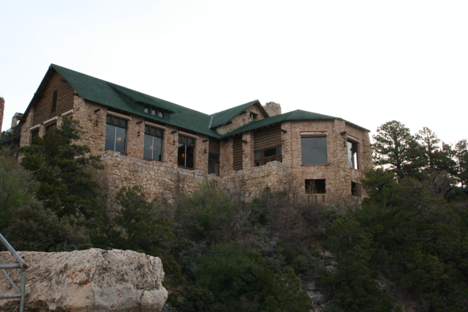 Grand Canyon, North Rim Lodge
Grand Canyon, North Rim Lodge
Inside the lodge is a statue of Brighty, a burro who operated in the canyon from 1892 to 1922. They say if you rub it, it’s good luck.
Liatris tenuifolia Nuttall

Blazing Star (Liatris tenuifolia Nuttall)
Liatris is one of my favorite composite flowers. The common name is very apt as it blazes a trail through the prairies and uplands where you can find different species.
 Blazing Star (Liatris tenuifolia Nuttall)
Blazing Star (Liatris tenuifolia Nuttall)
There are 37 species listed in Flora of North America and strangely, they are found from the midwest to the east, but not in the far west.116 It’s like the plant never figured out how to cross the Rockies.
This particular species was photographed on the prairie of Kissimmee Prairie Preserve State Park in Florida. It was abundant to the point of being a major part of the vegetation in the area.
Carphephorus corymbosus (Nuttall) Torrey & A. Gray
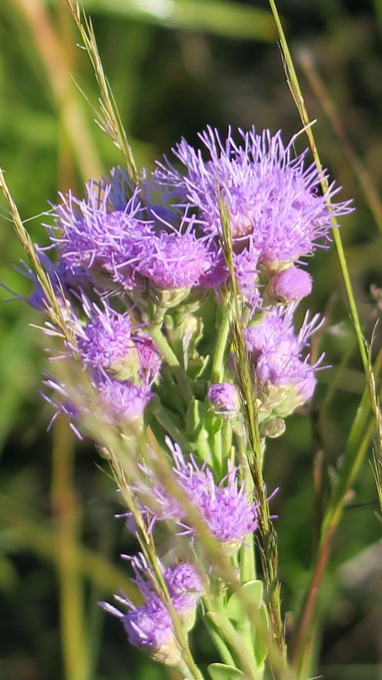
Florida Paintbrush (Carphephorus corymbosus (Nuttall) Torrey & A. Gray)
At first, I thought this another species of blazing star but the leaf structure wasn’t right and there was something off about it. Fortunately, I found a park brochure that had it listed.
It turns out I wasn’t too far out of line with my original assessment. It was once known as Liatris corymbosum.117
This was growing along with Liatris tenuifolia but not nearly so abundantly.
Those very long structures sticking out from the ray flowers are the stigmas of the pistil. By protruding so far out from the flower, there’s a greater chance of pollination by insects.
Garberia heterophylla (W. Bartram) Merrill & F. Harper
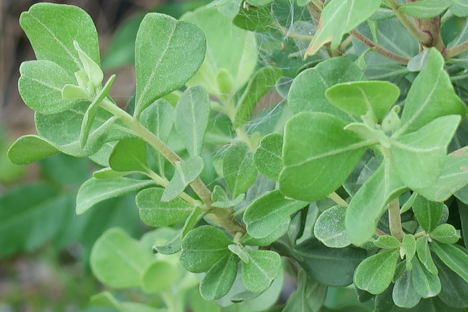 Garberia (Garberia heterophylla (W. Bartram) Merrill & F. Harper)
Garberia (Garberia heterophylla (W. Bartram) Merrill & F. Harper)
I’ve seen this in bloom, back when I used to take students to this location - just not when I took the photo. However, the only way I remembered it was due to signage along the nature trail at Archbold Biological Station. It is closely related to Liatris and Carphephorus since it is placed next to those two in classification schemes.
Mikania scandens (L.) Willdenow
 Climbing Hempvine (Mikania scandens (L.) Willdenow)
Climbing Hempvine (Mikania scandens (L.) Willdenow)
There are not many composite vines but this is a good one. I remember the first time I ever saw this in Mississippi and was stunned it was a member of the aster family.
There are three species listed in the Flora: M. scandens (eastern U.S.) M. cordifolia (southeast U.S.) and M. batatifolia (Florida).118
I’ve photographed it in two locations in Florida: Shark Valley in Everglades National Park and Kissimmee Prairie Preserve State Park.
Ageratina altissima (L.) R.M. King & H. Robinson
 White Snakeroot (Ageratina altissima (L.) R.M. King & H. Robinson)
White Snakeroot (Ageratina altissima (L.) R.M. King & H. Robinson)
Another changed genus. It was Ageratum.119 By whatever name, it’s a very attractive plant.
 White Snakeroot (Ageratina altissima (L.) R.M. King & H. Robinson)
White Snakeroot (Ageratina altissima (L.) R.M. King & H. Robinson)
This was photographed along the west rim trail of Cloudland Canyon State Park in Georgia. Until you realize you are looking a ray flowers, it doesn’t look like a composite. The ray flowers are unusual to me in that they almost look like a regular dicot flower.
Generally speaking, ray flowers have petals united for most of their length - unlike these where you can see the individual petals for most of their length.
Ageratina aromatica (L.) Spach
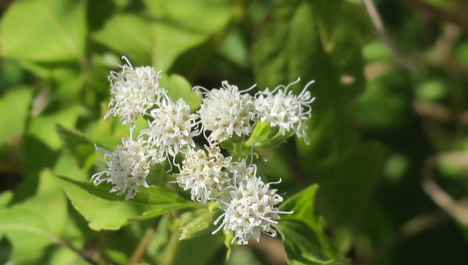
Small White Snakeroot (Ageratina aromatica (L.) Spach)
This was growing alongside the “trail” to the observation tower on Clingmans Dome in the Smokies.

The trail is really a paved walkway but it is very steep. A lot of people start up but not everyone gets to the end. Since I was in the Smokies, I didn’t crush any leaves to smell the aroma.
Ageratina occidentalis (Hooker) R.M. King and H. Robinson
 Ageratina, Boneset (Ageratina occidentalis (Hooker) R.M. King and H. Robinson)
Ageratina, Boneset (Ageratina occidentalis (Hooker) R.M. King and H. Robinson)
I kept seeing this along the roadside of the rim road at Crater Lake. There wasn’t a lot of areas to pull off but I did find an overlook and as I parked, this was next to the jeep.
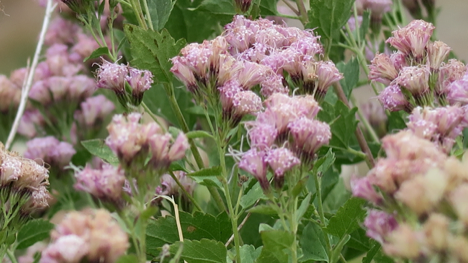 Ageratina, Boneset (Ageratina occidentalis (Hooker) R.M. King and H. Robinson)
Ageratina, Boneset (Ageratina occidentalis (Hooker) R.M. King and H. Robinson)
There are several plants that come to mind when I see the close up. It has a look of Liatris about it as well as Eupatorium. In 101 Wildflowers of Crater Lake National Park120 it is listed as Eupatorium occidentale.
I suspect the way I identified it was to surf the web for plant checklists of Crater Lake and narrowed it down by picture surfing those I thought it could be.
Species/Location
Adenocaulon bicolor
Muir Woods National Monument
Carduus pycnocephalus
Twin Peaks, San Francisco, California
Cirsium vulgare
Avalanche Lake Trail, Glacier National Park
Cirsium arvense
Mount Rushmore National Monument
Lake Louise, Yoho National Park, Alberta
Cirsium horridulum
Loop Road, Tamiami Trail, Big Cypress Preserve
Lake George State Forest, De Leon Springs, Florida
Cirsium nuttallii
River Trail, Silver Springs State Park, Silver Springs, Florida
Cirsium neomexicanum
Roadside, Zion National Park
Cirsium occidenale
Lands End Trail, San Francisco, California
Cirsium arizonicum var. bipinnatum
Rim Trail, Grand Canyon National Park, North Rim
Cirsium scariosum
Upper Geyser Basin, Yellowstone National Park
Centaurea stoebe L. subsp. micranthos
Spillimacheen, British Columbia
Elephantopus tomentosus
Torreya State Park, Bristol, Florida
Cichorium intybus
Sand Hill Trail, Silver Springs State Park, Silver Springs, Florida
Crepis atribarba
Rim Rock Trail, Black Canyon of the Gunnison National Park
Taraxacum officinale
Canal de Bourgogne, near Dijon, France
Twin Peaks, San Francisco, California
Coal Vein Nature Trail, Theodore Roosevelt National Park, South Unit
Wonderland Trail, Ship Harbor, Acadia National Park
Youngia japonica
Chez Fred, Fort Lauderdale, Florida
De Leon Springs State Park, De Leon Springs, Florida
Sonchus arvensis
Roadside, Zion National Park
Soncus asper
Santa Cruz Island, Channel Islands National Park
Hieracium gronovii
Archbold Biological Station, Venus, Florida
Hieracium albiflorum
Avalanche Lake Trail, Glacier National Park
Turkey Ridge Trail, South Mountains State Park, North Carolina
Hieracium triste
Black Forest Peak, The Bugaboos, British Columbia
Tragopogon dubius
Upper Geyser Basin, Yellowstone National Park
Signal Mountain, Grand Teton National Park
Spillimacheen, British Columbia
Malacotrhix saxatilis
Trail to Smugglers Cove, Santa Cruz Island, Channel Islands National Park
Agoseris glauca
Hayden Valley, Yellowstone National Park
Castle Crest Wildflower Trail, Crater Lake National Park
Agoseris aurantiaca
Moraine Lake, Yoho National Park, Alberta
Rafinesquia neomexicana
Roadside, Death Valley National Park
Krigia virginica
Manatee Springs State Park, Chiefland, Florida
Pyrrhopappus carolinianus
Nature Coast Trail, near Chiefland, Florida
Antennaria dimorpha
Pulpit Rock Overlook, Black Canyon of the Gunnison National Park
Antennaria lantana
Eva Lake, The Bugaboos, British Columbia
Silver Basin near Frenchman Mountain, The Bugaboos, British Columbia
Antennaria neglecta
South Bubble Trail, Acadia National Park
Antennaria parvifolia
Devil’s Overlook, Black Canyon of the Gunnison National Park
Rimrock Trail, Black Canyon of the Gunnison National Park
Antennaria microphylla
Upper Geyser Basin, Yellowstone National Park
Devil’s Overlook, Black Canyon of the Gunnison National Park
Antennaria rosea
Upper Geyser Basin, Yellowstone National Park
Rim Road, Crater Lake National Park
Anaphalis margaritacea
Takakkaw Falls, Yoho National Park, British Columbia
Emerald Lake, Yoho National Park, British Columbia
Twin Peaks, San Francisco, California
Point Reyes Light, Point Reyes National Seashore
Castle Crest Wildflower Trail, Crater Lake National Park
Pterocaulon pyncnostchyum
Sinkhole Trail, Silver Springs State Park, Silver Springs, Florida
Pluchea odorata
Roadside, Myakka River State Park, Sarasota, Florida
Achillea millefolium
Upper Geyser Basin, Yellowstone National Park
West Thumb Lake, Yellowstone National Park
Upper Falls of the Yellowstone, Yellowstone National Park
Roadside, Custer State Park, South Dakota
Upper Geyser Basin, Yellowstone National Park
Bugaboo Lodge, The Bugaboos, British Columbia
Point Reyes Light, Point Reyes National Seashore
Artemisia tridentata
Signal Mountain, Grand Teton National Park
Tree Molds Trail, Craters of the Moon National Monument
Artemisia frigida
Nature Trail, Great Sand Dunes National Park
Artemisia californica
Visitor Center, Channel Islands National Seashore, Ventura, California
Leucanthemum vulgare
Bridal Veil Falls near Spearfish, South Dakota
Lake Louise, Yoho National Park, Alberta
Bugaboo Lodge, The Bugaboos, British Columbia
Point Reyes Light, Point Reyes National Seashore
Roadside, Glacier National Park
Wilson Creek Valley Overlook, Blue Ridge Parkway, Asheville, North Carolina
Bellis perennis
Riverbank of Smith River, Jedediah Smith Redwoods State Park, Crescent City, California
Baccharis halimifolia
Lake George State Forest, De Leon Springs, Florida
Archbold Biological Station, Venus, Florida
Baccharis pilularis
Glen Camp Trail, Point Reyes National Seashore
Baccharis salicina
The Windows Trail, Big Bend National Park
Santa Cruz Island, Channel Islands National Park
Ericameria nauseosa
Mesa Verde National Park
Ericameria suffructicosa
Rim Road, Crater Lake National Park
Amphiachyris dracunculoides
East/West Trail, Lost Maples State Natural Area, Vanderpool, Texas
Gutierrezia sarothrae
Rim Trail, Grand Canyon National Park, South Rim
Seriocarpus tortifolius
Torreya State Park, Bristol, Florida
Solidago multiradiata
Upper Geyser Basin, Yellowstone National Park
Lake Louise, Yoho National Park, Alberta
Takakkaw Falls, Yoho National Park, British Columbia
Black Forest Peak, The Bugaboos, British Columbia
Rocky Point Ridge and Powder Pig Trail, The Bugaboos, British Columbia
Solidago stricta
Roadside, Kissimmee Prairie State Park, Okeechobee, Florida
Stenotus acaulis
Upper Geyser Basin, Yellowstone National Park
Chrysothamnus greenei
Nature Trail, Great Sand Dunes National Park
Townsendia incana
Roadside Capitol Gorge Road, Capitol Reef National Park
Townsendia exscapa
Ridgeline Trail, Theodore Roosevelt National Park, South Unit
Chaetopappa effusa
East/West Trail, Lost Maples State Natural Area, Vanderpool, Texas
Pityopsis graminifolia
West Loop Trail, Cloudland Canyons State Park, Rising Fawn, Georgia
Myakka River State Park, Sarasota, Florida
Kissimmee Prairie State Park, Okeechobee, Florida
Heterotheca villosa
Zion Canyon along North Fork of Virgin River, Zion National Park
Devil’s Tower National Monument
Grand Canyon National Park, North Rim
Mesa Verde National Park
Erigeron concinnus
Grand Canyon National Park, North Rim
Erigeron foliosus
Chimney Rock Trail, Point Reyes National Seashore
Erigeron philadelphicus
Deep Creek Trail, Great Smoky Mountains National Park
Brandywine Falls, Cuyahoga Valley National Park
Virginia Kendall State Park, Cleveland, Ohio
Lewis Springs Falls Trail, Shenandoah National Park
Smokemont Loop Trail, Great Smoky Mountains National Park
Erigeron quercifolius
Lake George State Forest, De Leon Springs, Florida
Erigeron puchellus
Deep Creek Trail, Great Smoky Mountains National Park
Erigeron peregrinus
Black Forest Trail, The Bugaboos, British Columbia
Erigeron glacialis
Castle crest Wildflower Trail, Crater Lake National Park
Erigeron glabellus
Signal Mountain, Grand Teton National Park
Lake Louise, Yoho National Park, Alberta
Erigeron glaucus
Lands End Trail, San Francisco, California
Twin Peaks, San Francisco, California
Erigeron annuus
Deep Creek Trail, Great Smoky Mountains National Park
Erigeron sionis
Roadside, Zion National Park
Eurybia integrifolia
Upper Falls of the Yellowstone, Yellowstone National Park
Eurybia chlorolepis
West Rim Trail, Cloudland Canyons State Park, Georgia
Dieteria canescens
Grand Canyon National Park, North Rim
Grindelia squarrosa
Grand Canyon National Park, North Rim
Grindelia hirsutula
Point Reyes Light, Point Reyes National Seashore
Symphyotrichum patens
West Rim Trail, Cloudland Canyons State Park, Georgia
Symphyotrichum adnatum
Kissimmee Prairie Preserve State Park, Okeechobee, Florida
Symphyotrichum ericoides
East/West Trail, Lost Maples State Natural Area, Vanderpool, Texas
Symphiotrichum cordifolium
Roadside, Great Smoky Mountains National Park
Symphyotrichum retroflexum
Roadside, Great Smoky Mountains National Park
Symphyotrichum elliottii
Loop Road, Old Tamiami Trail, Great Cypress Preserve, Florida
Symphyotrichum foliaceum
Lake Louise, Yoho National Park, Alberta
Eva Lake, The Bugaboos, British Columbia
Senecio integerrinus
Upper Geyser Basin, Yellowstone National Park
Cross Fissures, Black Canyon of the Gunnison National Park
Senecio triangularis
Castle Crest Wildflower Trail, Crater Lake National Park
Eva Lake, The Bugaboos, British Columbia
Senecio serra
Upper Falls of the Yellowstone, Yellowstone National Park
Packera anonyma
High Falls State Park, Jackson, Georgia
Packera aurea
F.D. Roosevelt State Park, Warm Springs, Georgia
Smokemont Loop Trail, Great Smoky Mountains National Park
Packera glabella
Nature Coast Trail near Manatee Springs State Park, Chiefland, Florida
Packera multilobata
Dead Horse Point State Park, Moab, Utah
Roadside, Zion National Park
Capitol Gorge Road, Capitol Reef National Park
Packera obovata
Brandywine Falls, Cuyahoga Valley National Park
Packera pauciflora
Dead Elk Lake, The Bugaboos, British Columbia
Rocky Point Ridge and Powder Pig Trail, The Bugaboos, British Columbia
Packera tridenticulata
Medano Pass Primitive Road, Great Sand Dunes National Park
Emilia sonchifolia
Chez Fred, Fort Lauderdale, Florida
Emilia fosbergii
Near Riverland Boys and Girls Club, Fort Lauderdale, Florida
Arnoglossum floridanum
Sink Hole Trail, Silver Springs State Park, Silver Springs, Florida
Tetradymia canescens
Nature Trail, Great Sand Dunes National Park
Tetradymia axillaris
Nature Trail, Great Sand Dunes National Park
Petasites frigidus
Silver Basin near Frenchman Mountain, The Bugaboos, British Columbia
Del Norte Coast Redwoods State Park, Crescent City, California
Agnes Gorge Trail, North Cascades National Park
Lakeshore Trail, North Cascades National Park
Melampodium leucanthum
The Windows Trail, Big Bend National Park
Rudbeckia hirta
Custer State Park, Custer, South Dakota
Kissimmee Prairie Preserve State Park, Okeechobee, Florida
Ratibida columnifera
Devil’s Tower National Monument
Mount Rushmore National Monument
Badlands National Park
Lost Maples State Natural Area, Vanderpool, Texas
Zinnia acerosa
Saguaro National Park, Rincon Mountain District
Berlandiera subacaulis
Nature Coast Trail, Fanning Springs, Florida
Echinacea angustifolia
Mount Rushmore National Monument
Devil’s Tower National Monument
Balsamorhiza sagittata
Upper Geyser Basin, Yellowstone National Park
Signal Mountain, Grand Teton National Park
Jenny Lake, Grand Teton National Park
Signal Hill Petroglyphs, Saguaro National Park, Tucson Mountain District
Lakeshore Trail, Stehekin, Washington
Baker Creek Road, Great Basin National Park
Pulpit Rock Overlook, Black Canyon of the Gunnison National Park
Painted Wall, Black Canyon of the Gunnison National Park
Verbesina virginica
2451 SW 16th Court, Fort Lauderdale, Florida
Lost Maples State Natural Area, Vanderpool, Texas
Myakka River State Park, Sarasota, Florida
Enceliopsis nudicaulis
Chimney Rock Trail, Capitol Reef National Park
Phoebanthus grandiflorus
Myakka River State Park, Sarasota, Florida
Encelia farinosa
Desert Discovery Nature Trail, Saguaro National Park, Tucson Mountain District
Encelia californica
Visitor Center, Channel Islands National Park, Ventura, California
Geraea canescens
Roadside, Death Valley National Park
Melanthera nivea
Secret Garden Nature Center, Fort Lauderdale, Florida
Bahia Honda State Park, Big Pine Key, Florida
Sphagneticola trilobata
Secret Garden Nature Center, Fort Lauderdale, Florida
Eclipta prostrata
Archbold Biological Station, Venus, Florida
Borrichia arborescens
Bahia Honda State Park, Big Pine Key, Florida
Calyptocarpus vialis
Boys and Girls Club, Riverland Road Area, Fort Lauderdale, Florida
Lost Maples State Natural Area, Vanderpool, Texas
Helianthus annuus
Badlands National Park
Viguiera stenoloba
Lodge, Big Bend National Park
Tetragonotheca helianthoides
Sand Hill Trail, Silver Springs State Park, Silver Springs, Florida
Coreopsis gigantea
Smugglers Cove Trail, Santa Cruz Island, Channel Islands National Park
Coreopsis gladiata
Kissimmee Prairie Preserve State Park, Okeechobee, Florida
Bidens pilosa
Nature Coast Trail, Chiefland, Florida
Secret Woods Nature Center, Fort Lauderdale, Florida
Chez Fred, Fort Lauderdale, Florida
Flaveria linearis
Loop Road, Old Tamiami Trail, Big Cypress Preserve, Florida
Layia glandulosa
Roadside, Zion National Park
Lasthenia californica
The Balcones Trail, Pinnacles National Park
Roadside, Shingletown, California
Eriophyllum staechadifolium
Twin Peaks, San Francisco, California
Santa Cruz Island, Channel Islands National Park
Arnica mollis
Signal Mountain, Grand Teton National Park
Crater Lake National Park
Arnica ovata
Eva Lake, The Bugaboos, British Columbia
Amauriopsis dissecta
Grand Canyon National Park, North Rim
Chaenactis douglasii
Upper Geyser Basin, Yellowstone National Park
Chaenactis steviodes
Pipe Springs National Monument, Colorado City, Arizona
Roadside, Death Valley National Park
Helenium vernale
Nature Coast Trail, Chiefland, Florida
Tetraneuris acaulis
Le Fevre Overlook, Kaibab National Forest
Pulpit Rock Overlook, Black Canyon of the Gunnison National Park
Psilostrophe tagetina
The Windows Trail, Big Bend National Park
Capitol Gorge Road, Capitol Reef National Park
Eupatorium album
Secret Woods Nature Center, Fort Lauderdale, Florida
Conoclinum dissectum
The Windows Trail, Big Bend National Park
Conoclinum coelestinum
Loop Road, Old Tamiami Trail, Big Cypress Preserve
Brickellia californica
Grand Canyon Lodge, North Rim, Grand Canyon National Park
Liatris tenuifolia
Kissimmee Prairie Preserve State Park, Okeechobee, Florida
Carphephorus corymbosus
Kissimmee Prairie Preserve State Park, Okeechobee, Florida
Garberia heterophylla
Archbold Biological Station, Venus, Florida
Mikania scandens
Shark Valley, Everglades National Park
Kissimmee Prairie Preserve State Park, Okeechobee, Florida
Ageratina altissima
Cloudland Canyon State Park, Rising Fawn, Georgia
Ageratina aromatica
Trail to Observation Tower, Clingmans Dome, Great Smoky Mountains National Park
Ageratina occidentalis
East Rim Road, Crater Lake National Park
Chapter 3
Anthophyta - the monocotyledons
In volume I, I wrote about the ferns and fern allies (spore producing plants) and the gymnosperms (naked seed plants). After those, I started the flowering plants (covered seeds - fruits) and immediately launched into the dicotyledonous plants - those that (1) typically produce two seed leaves (2) typically have tap roots (3) typically have net venation of leaves (4) flower parts (sepals, petals, stamens, pistils) in 3’s or multiples of 3 (5) and typically have vascular bundles (xylem and phloem) in rings.
This is exactly opposite of what I was taught in graduate school. We were taught monocots were more primitive. Characteristics of monocots are they (1) typically produce one seed leaf (2) typically have fibrous or diffuse root systems (3) typically have venation of leaves in parallel (4) flower parts in 2‘s, 4‘s and 5‘s or multiples of those and (5) typically have scattered vascular bundles.
The evolutionary concept was that the more flower parts, the more advanced evolutionarily since evolution seems to follow the road to greater complexity. That concept has been much revised over the years. The evolutionary development of plants now follows that dicots evolved first and then as they lost parts to have fewer sepals, petals, stamens and pistils, that was a more advanced set of traits.
The idea is that evolution can also result in the loss of complexity to make things simpler.
For that reason, Flora of North America places dicots in the early volumes and places monocots after the dicots.
In the families and genera and species that follow, look for the monocotyledonous traits.
Chapter 4
Alismataceae
I became acquainted with this family when I took “Aquatic Plants” with Dr. Pullen as a graduate student at Ole Miss. Our definition of aquatic was pretty broad and we included anything that got its feet wet during some time of the year. Part of that was due to the weather - spring comes late some years.
There are four genera and 34 species listed in Flora of North America. I’ve not photographed many species of aquatic plants at all and only one genus in this family: Sagittaria.
Sagittaria graminea Michaux
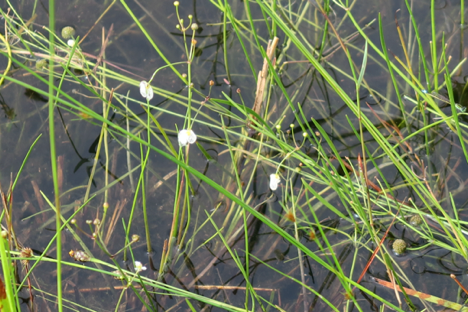 Grassy Arrowhead (Sagittaria graminea Michaux)
Grassy Arrowhead (Sagittaria graminea Michaux)
The common name is a little oxymoronic. The common name for this genus is arrowhead because most of the species of this genus have arrowhead shaped leaves. This is one of the exceptions.
In Boy Scouts we learned that arrowhead was sometimes called duck potato because there are underwater tubers (potatoes) associated with the rhizomes (underground stems) of these aquatic plants. The “potatoes” were edible if cooked. At least that’s what we were told. I can now admit to all my Boy Scout cohorts who I taught nature merit badge to I never have even found a duck potato nor eaten one.
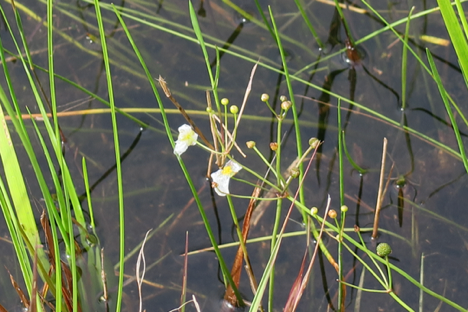 Grassy Arrowhead (Sagittaria graminea Michaux)
Grassy Arrowhead (Sagittaria graminea Michaux)
The flowers are typically in a raceme and the female flowers are found lower on the raceme and the male flowers are found on the upper part of the raceme and often open later than the female flowers.
In plants with unisexual flowers, the trick is to have pollen from another plant pollinate the pistils of your plant. If male and female flowers opened at the same time, you could end up self-pollinating - which might be fun - but doesn’t do anything to increase genetic diversity. One answer is to have the male flowers open on your plant after you female flowers have opened and hope another plant nearby has already opened its male flowers to pollinate you.
There are typically three sepals, three petals and numerous stamens in the male flowers.
I photographed this in a seasonal pond at David Allen Broussard Catfish Creek Preserve State Park near Winterhaven, Florida in the heat of August.
Sagittaria lancifolia Linnaeus

Arrowhead (Sagittaria lancifolia Linneaus)
Again, a misnomer on the common name.... The leaves are obviously lance-shaped. The flowers are all female on this raceme.
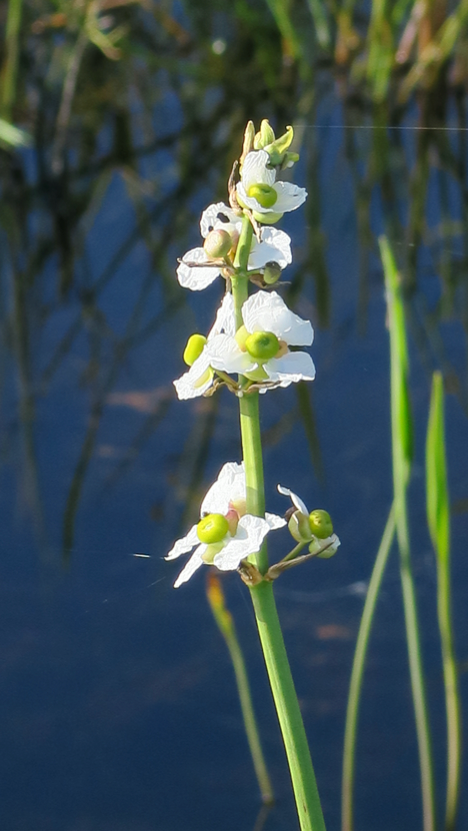 Arrowhead (Sagittaria lancifolia Linneaus subspecies media (Micheli) Bogin)
Arrowhead (Sagittaria lancifolia Linneaus subspecies media (Micheli) Bogin)
I’ve included a subspecies here because it was listed in a park brochure and I assume confirmed by a botanist before putting it in the brochure.
Species/Location
Sagittaria graminea
Allen David Broussard Catfish Creek Preserve State Park, Winterhaven, Florida
Sagittaria lancifolia
Loop Road, Old Tamiami Trail, Big Cypress Preserve
Kissimmee Prairie Preserve State Park, Okeechobee, Florida
Chapter 5
Arecaceae
When you think of Florida, you think of palms swaying in the breeze. There are all kinds of numbers batted around about the number of palms species in Florida. Flora of North America lists 26 species of palms in Florida (either native, introduced or cultivated). Of those 26, twelve are listed as native to Florida.121
Genera Palmarum states there are 200 genera of palms122 and Simple Wikipedia states there are 2600 species worldwide.
Here is the breakdown from Flora of North America.
SpeciesFlorid Common Name Florida Status
Thrinax morrisi Brittle Thatch Palm Native
Thrinax radiata Florida Thatch Palm Native
Coccothrinax argentata Florida Silver Palm Native
Rhapidophyllum hystrix Needle Palm Native
Acoelorraphe wrightii Paurotis Palm Native
Serenoa repens Saw Palmetto Native
Sabal etonia Scrub Palmetto Native
Sabal miamiensis Miami Palmetto Native
Sabal minor Dwarf Palmetto Native
Sabal palmetto Cabbage Palm Native
Pseudophoenix sargentii Cherry Palm Native
Roystonea regia Cuban Royal Palm Native
Livistonia chinensis Chinese Fan Palm Naturalized
Livistonia rotundifolia Footstool Palm Introduced
Washingtonia robusta Mexican Fan Palm Introduced
Phoenix canariensis Canary Island Date Palm Cultivated
Phoenix reclinata Senegal Date Palm Introduced
Chamaedora seifrizii Bamboo Palm Introduced
Caryota urens Fishtail Palm Introduced
Dypsis lutescens Areca Palm Cultivated
Ptychosperm elegans Solitaire Palm Introduced
Ptychosperm macarthurii MacArthur Palm Introduced
Cocos nucifera Coconut Palm Introduced
Syagrus romanzoffiana Queen Palm Introduced
Elaeis guineensis African Oil Palm Introduced
Acrocomia totai Maurtius Palm Introduced
The leaves of palms are called fronds. That tends to be confusing because that’s the term associated with ferns and fern allies but we’re stuck with it.
Palm fronds typically fall into two types: palmate and pinnate. There are variations of these and then there are those fronds that don’t obey either of those patterns.
In my travels, I’ve photographed five genera and six species.
Thrinax radiata Loddiges ex Schultes

Florida Thatch Palm (Thrinax radiata Loddiges ex Schultes)
This is the palm Seminoles used to make chickees. As you can see, Bahia Honda State Park was very nice and provided me the identification of this specimen. I’ve seen it before on hammocks in the Everglades but this was an opportunity to see it up close.
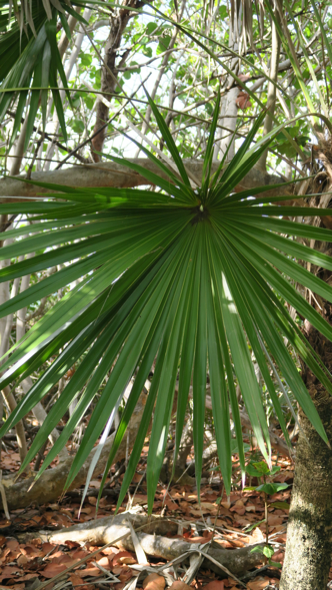
Florida Thatch Palm (Thrinax radiata Loddiges ex Schultes)
This pretty much falls into the category of a palmate frond.
Coccothrinax argentata (Jacquin) L.H. Bailey

Silver Palm (Coccothrinax argentata (Jacquin) L.H. Bailey)
Another gimme by the Bahia Honda State Park staff, this palm really does have a little silver tent to it. I admit it does look a great deal like Thrinax radiata.

Silver Palm (Coccothrinax argentata (Jacquin) L.H. Bailey)
Both this and Thrinax have adapted to the very calcareous soils of the Florida Keys and the Everglades, the result of ancient coral reefs which once were submerged in the areas.
A word about Liberty Hyde Bailey. He was a famous botanist/horticulturist and lived from 1858 until 1954 (Wikipedia). According to Wikipedia, “Bailey is credited with ...starting agricultural extension services, the 4-H movement, the nature study movement, parcel post and rural electrification. This is not the same Bailey of Bailey Arboretum fame (Wikipedia) in Lattingtown, New York.
Rhapidophyllum histrix (Pursh) H. Wendland & Drude
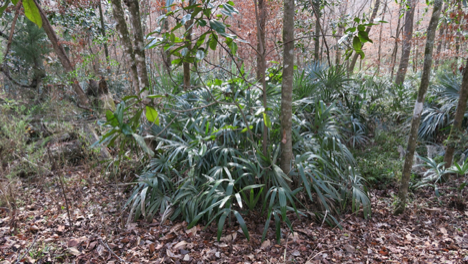 Needle Palm (Rhapidophyllum histrix (Pursh) H. Wendland & Drude)
Needle Palm (Rhapidophyllum histrix (Pursh) H. Wendland & Drude)
I don’t have a close up of this palm but there are needle-like spines along the petioles of the fronds. According to the tour guide, these were used as sewing needles by Native Americans and early settlers to Florida.
The was located just outside the exit to Florida Caverns at Florida Caverns State Park.

Exit from Florida Caverns
Much of the area at the time of my visit was just coming out from a flood. A few years later, Hurricane Michael swamped the park and flooded the caverns and it only reopened to the public in 2019.
Serenoa repens (W. Bartram) Small
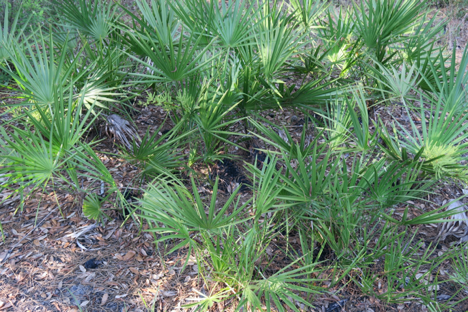
Saw Palmetto (Serenoa repens (W. Bartram) Small)
Welcome to the prostate drug plant and hair growth plant. Serenoa forms trunks that can branch and may also hug the ground. People often confuse it with Sabal minor but only Serenoa has the procumbent, branched trunks. There is a chemical compound in the berries which helps reduce prostate swelling.
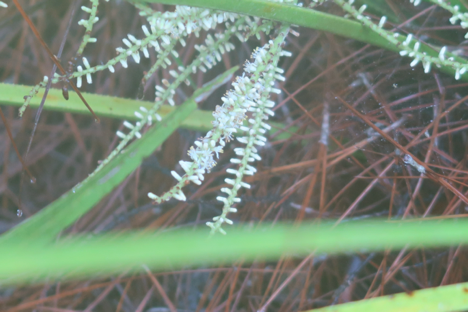
Saw Palmetto (Serenoa repens (W. Bartram) Small)
When this plant blooms, bees go crazy. I personally think the blooms actually smell like honey. Either that or the number of bees on the plant impart a honey aroma to the air. Or, it could be there is a bee tree nearby.
This was common in Mississippi where I grew up.
Sabal minor (Jacquin) Persoon
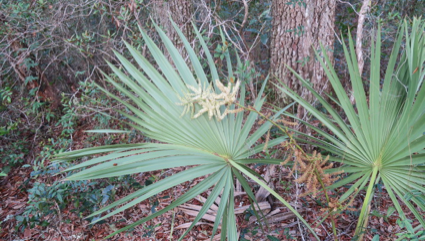
Dwarf Palmetto (Sabal minor (Jacquin) Persoon)
There are five species of Sabal in Florida: S. minor, S. etonia, S. mexicana, S. palmetto, and S. miamiensis.123 S. minor was commonly found along with Serenoa repens in low, swampy areas of Mississippi.
This is also one of the palms that is harvested for “heart of palms” often used in salads. Unfortunately, when harvested, the palm dies.

Dwarf Palmetto (Sabal minor (Jacquin) Persoon)
It is a prolific bloomer and bees love the pollen.
Sabal palmetto (Walter) Loddiges ex Schutes & Schutes f.
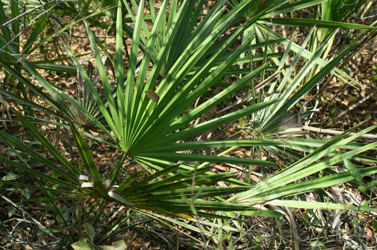
Cabbage Palm (Sabal palmetto Walter) Loddiges ex Schutes & Schutes f.)
This is also referred to as Sabal Palmetto and it’s the state tree of both Florida and South Carolina. I caught this one in a very early stage.

Cabbage Palm (Sabal palmetto Walter) Loddiges ex Schutes & Schutes f.)
Like Sabal minor and Serenoa repens, bees love the pollen of this plant.
Hyophorbe lagenicaulis (L.H. Bailey) H.E. Moore
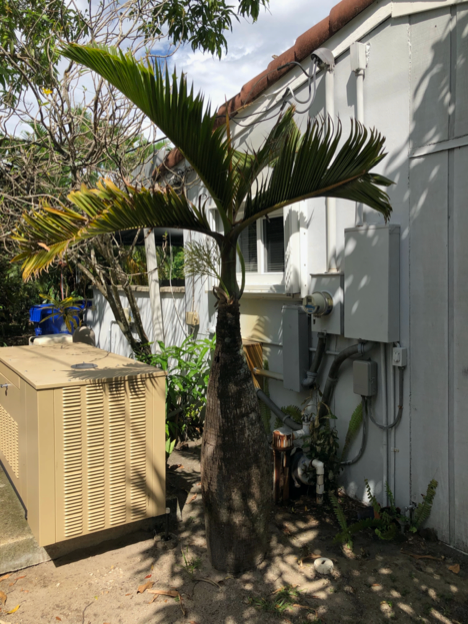 Bottle Palm (Hyophorbe lagenicaulis (L.H. Bailey) H.E. Moore)
Bottle Palm (Hyophorbe lagenicaulis (L.H. Bailey) H.E. Moore)
My good friend Tom at one time had a palm nursery and he supplied me with three bottle palms. Over the last 25 years, they’ve grown considerably (and one has died). The palm is a native of Round Island, Mauritius (Wikipedia) and they are a popular palm in south Florida. They really need to be in an open area, otherwise, like mine, they tend to lean away from any object that provides too much shade.
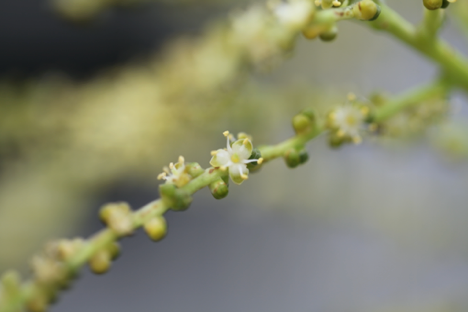 Bottle Palm (Hyophorbe lagenicaulis (L.H. Bailey) H.E. Moore)
Bottle Palm (Hyophorbe lagenicaulis (L.H. Bailey) H.E. Moore)
The palm produces a panicle of flowers but each flower is exceptionally small. This was taken with a macro lens to even get a decent view of it.
Species/Location
Thrinax radiata
Bahia Honda State Park, Big Pine Key, Florida
Coccothrinax argentata
Bahia Honda State Park, Big Pine Key, Florida
Rhapidophyllum histrix
Florida Caverns State Park, Marianna, Florida
Serenoa repens
Lake George State Forest, De Leon Springs, Florida
Archbold Biological Station, Venus, Florida
Sabal minor
Silver Springs State Park, Silver Springs, Florida
Sabal palmetto
Secret Woods Nature Center, Fort Lauderdale, Florida
Archbold Biological Station, Venus, Florida
Silver Springs State Park, Silver Springs, Florida
Hyophorbe lagenicaulis
Chez Fred, Fort Lauderdale, Florida
Chapter 6
Araceae
This is the arum family which, in my opinion, has one of the most unusual flowers in the plant kingdom. There is a central core of tissue (the spadix) and often female flowers are found on the lower portion and male flowers on the upper portion. Surrounding the spadix is a covering called the spathe. The most common example people know is skunk cabbage or jack-in-the-pulpit.
There are eight genera and 10 species listed in Flora of North America124 and I have photographed three genera and four of those species.
Symplocarpus foetidus (L.) Salisbury ex W.P.C. Barton
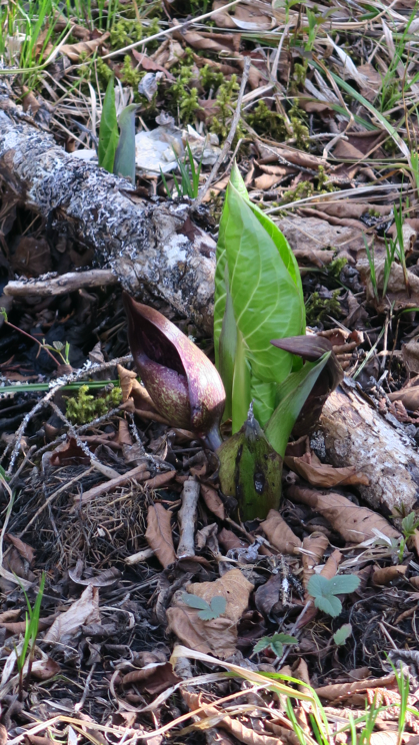
Skunk-cabbage (Symplocarpus foetidus (L.) Salisbury ex W.P.C. Barton)
There’s a reason it’s called skunk-cabbage. It produces a fetid odor which attract flies for pollination. This is one of the first flowers of spring and I remember being astounded to learn it can melt its way through snow. The plant produces enough heat to melt the snow around it.
I read about skunk-cabbage in Boy Scouts and always wanted to see it in nature. It was only in 2018 that I found this species at Isle Royale National Park. It was all over the place in boggy ground leading to the cabin I had been assigned.
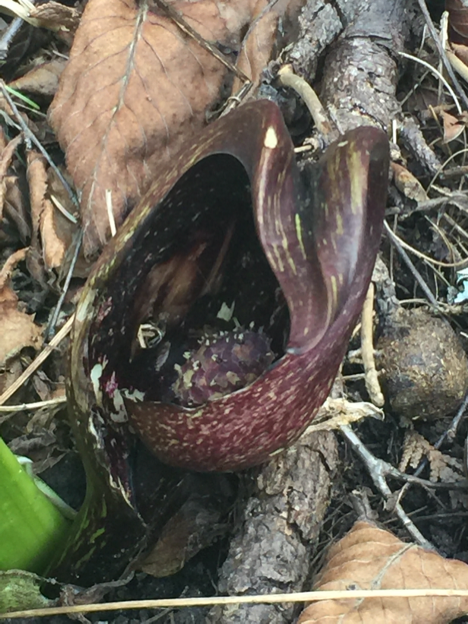 Skunk-cabbage (Symplocarpus foetidus (L.) Salisbury ex W.P.C. Barton)
Skunk-cabbage (Symplocarpus foetidus (L.) Salisbury ex W.P.C. Barton)
The large purple and white structure is the spathe. Inside it is an oval structure, the spadix. Those white structures are the flowers attached directly to the spadix.
Lysichiton americanus Hultén & H. St. John
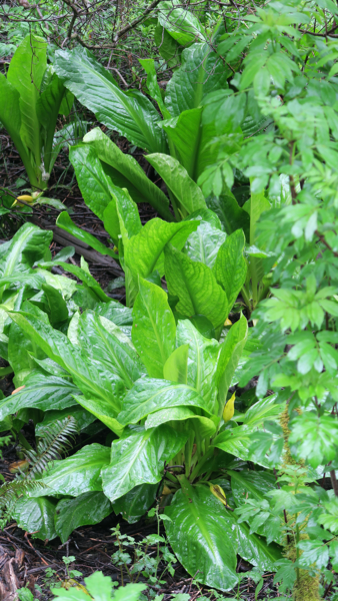
Skunk-cabbage (Lysichiton americanus Hultén & H. St. John)
This is a totally different genus and species of skunk-cabbage. The difference is in the color of the spathes and how exposed to the environment the spadix is.
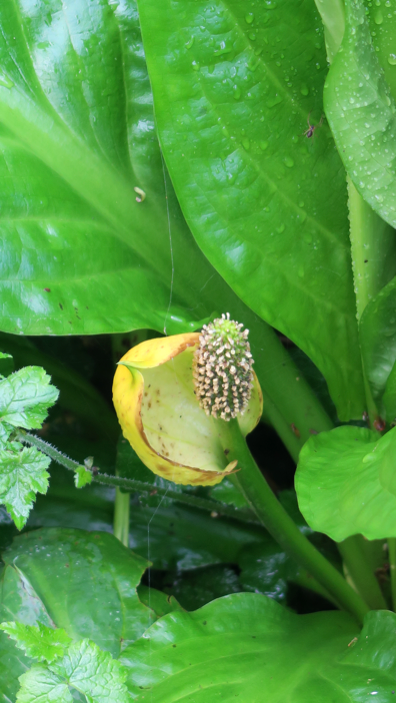
Skunk-cabbage (Lysichiton americanus Hultén & H. St. John)
You can see the yellow spathe and how it doesn’t completely enclose the spadix when in bloom. This also tends to be a leafier species.

Skunk-cabbage (Lysichiton americanus Hultén & H. St. John)
The reason I was fascinated by this plant in Boy Scouts is somewhere, either the Boy Scout Handbook or the magazine Boy’s Life, it described it as edible. I wanted to try it out. Both genera I found were in national parks so I didn’t get a chance to eat any.
Arisaema triphyllum (Linnaeus) Schott
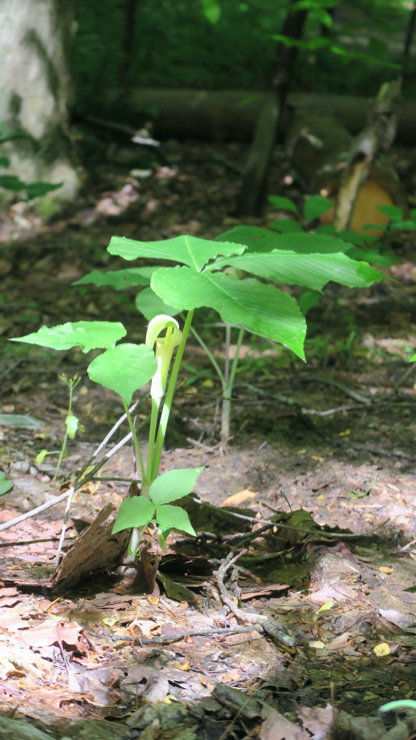
Jack-in-the-Pulpit (Arisaema triphyllum (Linnaeus) Schott)
I have a confession on this. It was one of the first plants Mr. Polk, my scoutmaster, taught our troop. It’s suggested that if you cook the corm (short, vertical underground stem) at the base of the stem, it is an edible plant. However, raw is another matter. It contains crystals of calcium oxylate which will cause an intense burning sensation which lasts for quite a while.
To be honest, its actually worse than the hottest pepper I’ve had. I used to trick Boy Scouts at summer camp into tasting the corm. It was a dirty trick and I apologize to all those who suffered the effects.

Jack-in-the-Pulpit (Arisaema triphyllum (Linnaeus) Schott)
Jack is the spadix and the spathe is the pulpit. I think it is an absolutely beautiful plant.
Arisaema dracontium (Linnaeus) Schott
 Greendragon (Arisaema dracontiium (Linnaeus) Schott)
Greendragon (Arisaema dracontiium (Linnaeus) Schott)
A close relative with similar characteristics is greendragon. This is a little more difficult to find in the woods. It’s not as abundant, in my experience. This was on the nature trail at De Leon Springs State Park near De Leon Springs, Florida.

Old Methuselah - Cypress Tree Estimated to Be Over 500 Years Old at De Leon Springs State Park
Greendragon was alongside the trail that lead to a cypress swamp and Old Methuselah.
Species/Location
Symplocarpus foetidus
Windigo, Isle Royale National Park
Lysichiton americanus
Klamath Beach Road, Del Norte Coast Redwoods State Park, Crescent City, California
Trail of Shadows, Mount Rainier National Park
Arisaema triphyllum
Julian Price Memorial Park, Blue Ridge Parkway, North Carolina
The Virginia Kendall State Park, Cleveland, Ohio
South Mountains State Park, Connelly Springs, North Carolina
Arisaema dracontiium
De Leon Springs State Park, De Leon Springs, Florida
Chapter 7
Commelinaceae
This family includes what are known as spiderworts and dayflowers. Flower parts are in threes and their leaves are grass-like and parallel veined. There are six genera and 51 species in Flora of North America125 and I’ve photographed two genera and five species.
The two genera I photographed are Tradescantia and Commelina for which the family is named. It took me a while when I started out in botany to understand the differences and as I look back on those days I must have been pretty dense in not being able to readily distinguish between the two species.
Tradescantia is interesting for a lot of reasons but one use we had in teaching was to demonstrate cyclosis in plants by putting the hairs attached to the stamens of the plant under the microscope. Cyclosis is the streaming of protoplasm within the cell and is still little understood today. It’s an interesting phenomenon and students got an “ah!” moment out of it. You can see a YouTube video of it here.
Another interesting use of Tradescantia came from the environmental movement and opposition to nuclear energy. Nuclear reactors had a problem with leaking radiation. To prove the reactor site was leaking, environmentalists would plant Tradescantia around the fences of the facilities. Tradescantia stamen hairs change color when exposed to very small amounts of radiation. Environmentalists would periodically check the plants around the facility and then if they discovered a color change, would blow the whistle on the plant with the Department of Energy.
Much, much later, Rick Perry discovered atomic energy.
Tradescantia subaspera Ker Gawler
 Spiderwort (Tradescantia subaspera Ker Gawler)
Spiderwort (Tradescantia subaspera Ker Gawler)
I’m not sure why they are called spiderworts. I’ve never found spiders on the plant and there’s nothing that looks like a spider or a web on the plant.
There are 30 species of Tradescantia in North America.126 Some of the distinctions that separate the species are picky but I tend to base my identifications on the geographical location and also any local plant checklists.
 Spiderwort (Tradescantia subaspera Ker Gawler)
Spiderwort (Tradescantia subaspera Ker Gawler)
There are three petals and three sepals and six stamens. If you look carefully, you can see the hairs (trichomes) on the stamens.
 Spiderwort (Tradescantia subaspera Ker Gawler)
Spiderwort (Tradescantia subaspera Ker Gawler)
Once exposed to radiation, the hairs turn pink in color (New York Times). Apparently, they are very sensitive to low levels of radiations.
This photo was taken at F.D. Roosevelt State Park near Warm Springs, Georgia.
Tradescantia ohioensis Rafinesque
 Spiderwort (Tradescantia ohiensis Rafinesque)
Spiderwort (Tradescantia ohiensis Rafinesque)
Yes, I know the flowers look the same but trust me, they are not the same species. This particular photo was taken along the Nature Coast Trail near Fanning Springs, Florida.
The major distinctions are the differences in the leaves which I didn’t photograph on this one and that this flower has little or no pedicel which attaches it to the plant.
Tradescantia brevifolia (Torrey) Rose
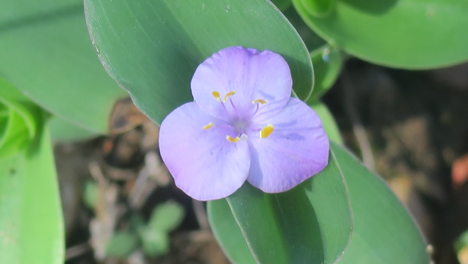 Trans-Pecos Spiderwort (Tradescantia brevifolia (Torrey) Rose)
Trans-Pecos Spiderwort (Tradescantia brevifolia (Torrey) Rose)
This harkened me back to my graduate school days because when I first saw this, I thought Commelina not Tradescantia. After looking at it for a minute, I realized it was a spiderwort and not a dayflower.
It was a pretty little thing and about the only one in the area of The Windows Trail at Big Bend National Park. This is restricted to Texas and Mexico.127
Commelina diffusa Burman
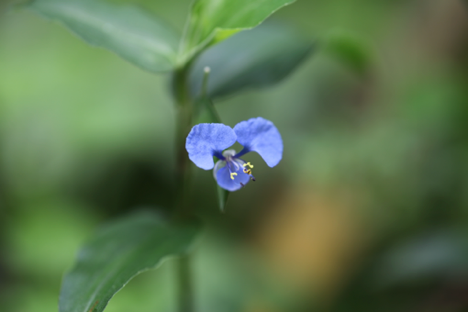 Dayflower (Commelina diffusa Burman)
Dayflower (Commelina diffusa Burman)
One of the first features I look for is the “stalk” to the petals of the flower. Also, note the stamens. There are six but only the yellow ones are fertile. The petals of the flower are attached with a narrow “waist.”
This grows as a weed in my lawn in Fort Lauderdale.
There are nine species of dayflower in North America.128
Commelina erecta Linnaeus
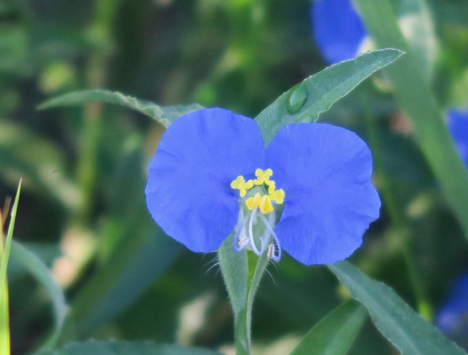
Erect Dayflower (Commelina erecta Linnaeus)
The dayflower in my yard (C. diffusa) is quite small. This was a rather large plant I photographed first in Big Bend National Park and then later at Silver Springs State Park in Florida.
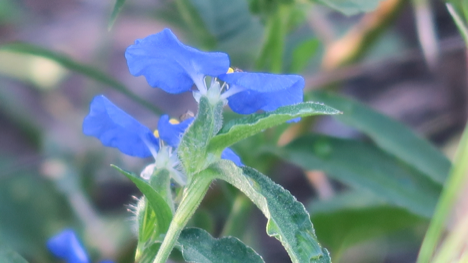
Erect Dayflower (Commelina erecta Linnaeus)
The one thing that sticks out with this flower and the one above is there are three petals, two of which are blue. The third petal is white and almost a remnant petal.129
Species/Location
Tradescantia subaspera
F.D. Roosevelt State Park, Warm Springs, Georgia
Deep Creek Trail, Great Smoky Mountains National Park
Crabtree Falls, Blue Ridge Parkway, Barnardsville, North Carolina
Tradescantia ohioensis
Lake George State Forest, De Leon Springs, Florida
Nature Coast Trail near Fanning Springs, Florida
Tradescantia brevifolia
The Windows Trail, Big Bend National Park
Commelina diffusa
Chez Fred, Fort Lauderdale, Florida
Commelina erecta
The Windows Trail, Big Bend National Park
Silver Springs State Park, Silver Springs, Florida
Chapter 8
Eriocaulaceae

Shoe-button (Syngonanthus flavidulus (Michaux) Ruhland)
This family is commonly referred to as the pipeworts. They don’t look like pipes but they do look a little like old ladies’ hat pins. Yes, I know what they are and what they were used for. My Aunt Deliah used to use them to keep her outrageous hats on during church services.
The leaves are mostly a basal rosette with no stem leaves. Most of the flowers are located at the top of the stem in tight clusters.
I’ve photographed a lot of members of this family over the years and finally quit because identification - for me at least - is impossible without the aid of dissection of the material under a scope.
The one I included was based on a plant checklist for Lake George State Forest, so I feel pretty confident in the identification.
There are three genera and 16 species in North America.130
Syngonanthus flavidulus (Michaux) Ruhland)
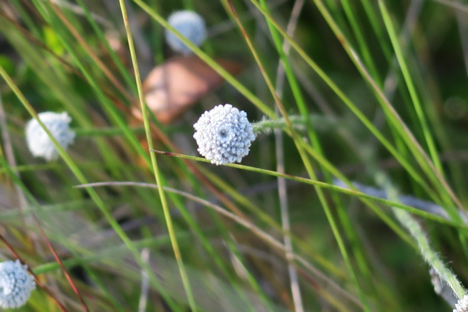
Shoe-button (Syngonanthus flavidulus (Michaux) Ruhland)
I collected a good many of these during the “Aquatic Plants” course back in graduate school. These plants like water or low lying areas frequently inundated with water. Bogs are a good place to look for them.
Species/Location
Syngonanthus flavidulus
Lake George State Forest, De Leon Springs, Florida
Syngonanthus flavidulus
Lake George State Forest, De Leon Springs, Florida
Chapter 9
Juncaceae
There are only two genera in the rush family and by far the largest is the genus Juncus for which the family is named.131 Ninety-five species of Juncus are listed in Flora of North America.132 During my graduate school days, I collected 14 species of Juncus in Tishomingo133 and I quite enjoyed “keying” out the species. The genus has always been one of my favorites.
However, to do justice to the species of Juncus, you need to dissect the flowers in order to identify except for a few obvious species so I’ve never bothered to photograph any.
The other genus in the family is Luzula. Again, my first experience with the genus was in Tishomingo State Park where I collected three species: L. acuminata, L. bulbosa, and L. multiflora.134
I really like the genus. It suggests relationships with Juncus when you see it but then also looks almost lily-like in characteristics. I’ve photographed one species I was able to identify without dissection.
Luzula hitchcockii Hämet-Ahti
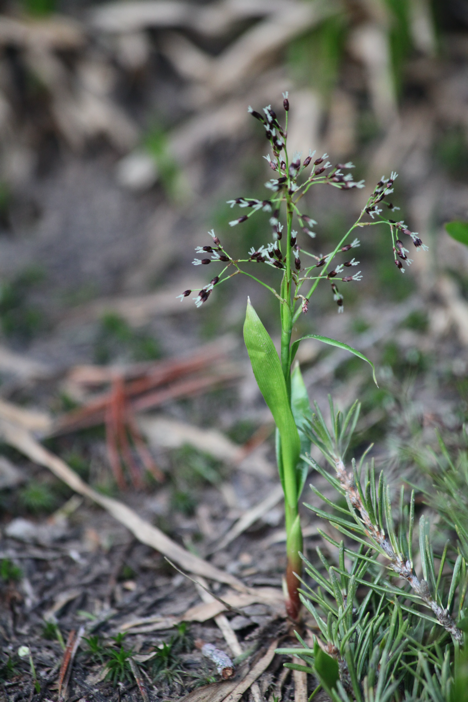 Hitchcock’s Woodrush (Luzula hitchcockii Hämet-Ahti)
Hitchcock’s Woodrush (Luzula hitchcockii Hämet-Ahti)
Generally speaking, woodrushes have a much wider blade than rushes. I also love the way the flowers look when it blooms. It’s really a stunner when you come across this plant.
This was photographed near the Sinnott Memorial Overlook at Crater Lake. The overlook is really a museum and overlook and is officially known as the Nicolas J. Sinnott Memorial Observation Station and Museum. It sits 900 feet above the lake.
Every time I’ve been to Crater Lake (three as of last count), the museum has been closed and there has been no access to the overlook. Perhaps one day....
 Nicolas J. Sinnott memorial Observation Station and Museum - It Looks Ready to Fall Off the Cliff!
Nicolas J. Sinnott memorial Observation Station and Museum - It Looks Ready to Fall Off the Cliff!
Species/Location
Luzula hitchcockii
Sinnott Memorial Overlook, Crater Lake National Park
Chapter 10
Bromeliaceae
Pineapples anyone? There are four genera and 19 species of bromeliads in North America and 13 of those species are in the genus Tillandsia.135 For those of you who are southerners, you are intimately familiar with one species commonly called Spanish moss (which, of course, is not a moss but a flowering plant).
Pineapples are not listed in the flora because they are a cultivated crop throughout the tropics and subtropics. Pineapples belong to the genus Ananas and the species comosus.136
Tillandsia usneoides (Linnaeus) Linneaus
 Spanish Moss (Tillandsia usneoides (Linneaus) Linnaeus)
Spanish Moss (Tillandsia usneoides (Linneaus) Linnaeus)
There must be 1001 uses of Spanish moss in Boy Scout camp. We used it as the hair of “the swamp monster,” as a beard for the “old Scoutmaster,” as bedding on camping trips, etc. etc. The one drawback was if you harvested directly from the tree and placed it on your head or face, you got an invasion of red bugs. They seem to have a wonderful relationship with Spanish moss.
One of your initiations into summer came seems to be to be tricked into putting the stuff all over your body and having a red bug outbreak. Kids can be cruel. Not that I would do that.
Technically, Spanish moss is an epiphyte (a plant living on another plant). It is not parasitic and does not harm the tree. At certain times of the year (summer) you can find tiny blooms among the strands.
When I was stationed at the communications station in New Orleans, I became acquainted with a cousin by the name of Peyton Hurst (from my Dad’s side of the family). Peyton was a big name in scouting in New Orleans. We were walking towards a jamboree encampment outside of New Orleans and he pointed out Spanish moss. Wanting to impress him, I gave him the scientific name and explained it grows on oaks mostly but never on pine trees. He then pointed to a pine draped in Spanish moss and said “what about that pine?” I stuttered a lot after that.
You’ll find Spanish moss throughout most of the southeastern U.S.
Tillandsia setacea Swartz
 Southern Needleleaf (Tillandsia setacea Swartz)
Southern Needleleaf (Tillandsia setacea Swartz)
This is mostly a Florida species with it creeping just a little into Georgia.137
I’ve even had this growing in my yard before and the leaves are indeed needle-like. I noticed it blooming in both the spring and fall.
Species/Location
Tillandsia usneoides
Secret Woods Nature Center, Fort Lauderdale, Florida
Tillandsia setacea
Myakka River State Park, Sarasota, Florida
Chapter 11
Cyperaceae
This is the sedge family of plants with 27 genera and 843 species.138 I generally don’t photograph sedges because it takes a great deal of effort to identify them. You have to do very careful dissection of the flowers with a dissection scope and pay attention to specific characteristics.
My major professor, Dr. Pullen, hated, absolutely hated the genus Carex. He would go to great links to avoid the genus when he took us on field trips. During my Tishomingo days, I tortured him with 11 species of Carex from the park.139
Whereas he hated the genus, I actually didn’t mind identifying the species. The keys made sense to me - but not to him. I suspect he probably confirmed some of my species simply to keep from having to key them out himself - or at least agreed with my identification enough not to fight it.
Since I never travel with a dissection scope and a key to the genera and species of the family, I have only photographed one very obvious genus: Rhynchospora.
Rhynchospora colorata (Linnaeus) H. Pfeiffer
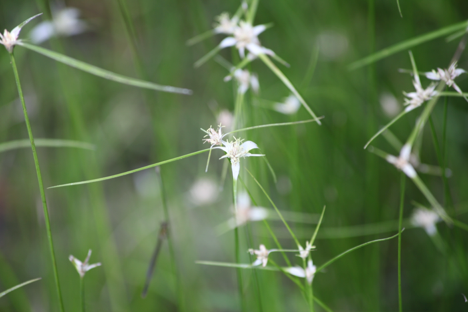 White Topped Sedge (Rhynchospora colorata (Linnaeus) H. Pfeiffer)
White Topped Sedge (Rhynchospora colorata (Linnaeus) H. Pfeiffer)
I think you can see why I decided to go out on a limb and identify this. No other sedge looks like this.
The famous botanist John Kunkel Small placed this in the genus Dichromena and listed three species.140 Small was a notorious splitter. He thought everything constituted a different species or different genus. He fell out of favor for years and I remember Dr. Pullen dismissing him. However, once I caught him surreptitiously consulting Small’s Manual of Southeastern Flora for identification. He red-faced explained that on some identifications, you needed to go to Small.
Small has been rehabilitated in the botanical world. Seems he was right after all. There are a lot more species than previously though based on new DNA analysis.
The three species of Small have all now been reclassified as the genus Rhynchospora and all three have white bracts beneath the inflorescences. The main difference in all three species is the width of the bracts.141
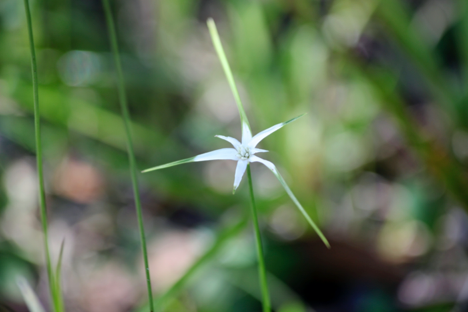 White Topped Sedge (Rhynchospora colorata (Linnaeus) H. Pfeiffer)
White Topped Sedge (Rhynchospora colorata (Linnaeus) H. Pfeiffer)
In the case of R. colorata, the bracts are less than 5mm at the base.142 This photo is a little misleading in that it was taken with a zoom lens. The first photo is probably more indicative of the width of the bracts.
Species/Location
Rhynchospora colorata
Shark Valley, Everglades National Park
Lake George State Forest, De Leon Springs, Florida
Chapter 12
Poaceae
It took a while, but I finally reached the grasses - the fourth largest group of plants on earth based on the number of species.143 It took Flora of North America two very large volumes to cover the 236 genera and 1373 species of which 136 genera and 892 are native to North America. The other 78 genera and 290 species are established but nonnative.144
My exposure to grasses began in graduate school with Dr. Pullen’s courses: “Summer Flora of Mississippi” and “Aquatic Plants.” We always had the option of collecting and identifying grasses but none of us felt confident enough to do so unless it was a grass we already knew the name.
That all ceased when I enrolled for “Agrostology” - the study of grasses. Interestingly, I was the only student in the class. Back then, there was less emphasis on cost-benefit analysis and Dr. Pullen could get away with a class with one student in it. I’m sure he told them I could not graduate without the course.
In any event, he would actually lecture to me as if it were a full class for about 15-20 minutes and then I would get down to keying out grasses. He would bring specimens from the herbarium, I would clip off a bit of the flowers, dissect them, identify them, and he would confirm them if correct. If not, it was a short “nope”.
The three major references available for this class (I was too poor to afford the costs) were The New Britton and Brown Illustrated Flora of the Northeastern United States and Adjacent Canada, volume 1, Manual of the vascular Flora of the Carolinas, and most importantly, the two volume paper back set of Hitchcock’s Manual of the Grasses of the United States. These all used dichotomous keys to lead you to the species description.
What sticks in my mind the most was my final exam. It consisted entirely of identification by sight of 100 grasses. There were no keys, no aids, just my feeble mind. If I remember correctly, I scored in the 80 percentile. I was crushed. I had made nothing but A’s in graduate school. Dr. Pullen could see my despair. He politely let me know I did far better than he had anticipated and that I received an A in the course. Whew! I think that was the toughest exam I’ve ever had in college.
By the way, Hitchcock’s work was so complete in 1950 that all Flora of North America had to do was simply revise and update his work for their two volume set.
In any case, grasses are different. One of the biggest problems I had as a graduate student was to distinguish between grasses and sedges. Try as I might, it confused me. Dr. Pullen kept hammering into me grasses have 2-ranked leaves and sedges have leaves that are 3-ranked. That made no sense to me for the longest. I finally figured that out.
Note in the photo there are two large leaves attached to the stem of the grass. If you looked down at this grass from the top of the grass you would see leaves on two sides of the stem. This is what is meant by 2-ranked.
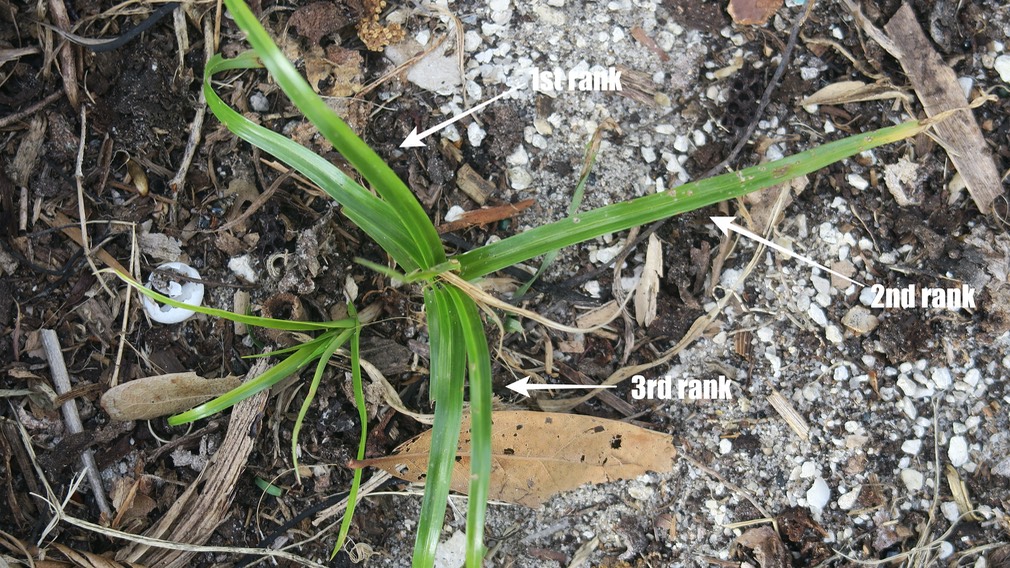
This is a sedge. Notice the leaves, as you look down on it, are in a triangular arrangement on the stem - or 3-ranked.
The leaves of a grass are attached sessiley to the stem. There is no petiole to the leaf. The blade attaches directly to the stem.
Often grasses have a structure at the base of the leaf where the leaf attaches to the stem called a ligule. Not all grasses have ligules but if they do, it can be a membranous structure, hairs, or even prongs and is diagnostic.
This particular ligule is a membranous ligule.
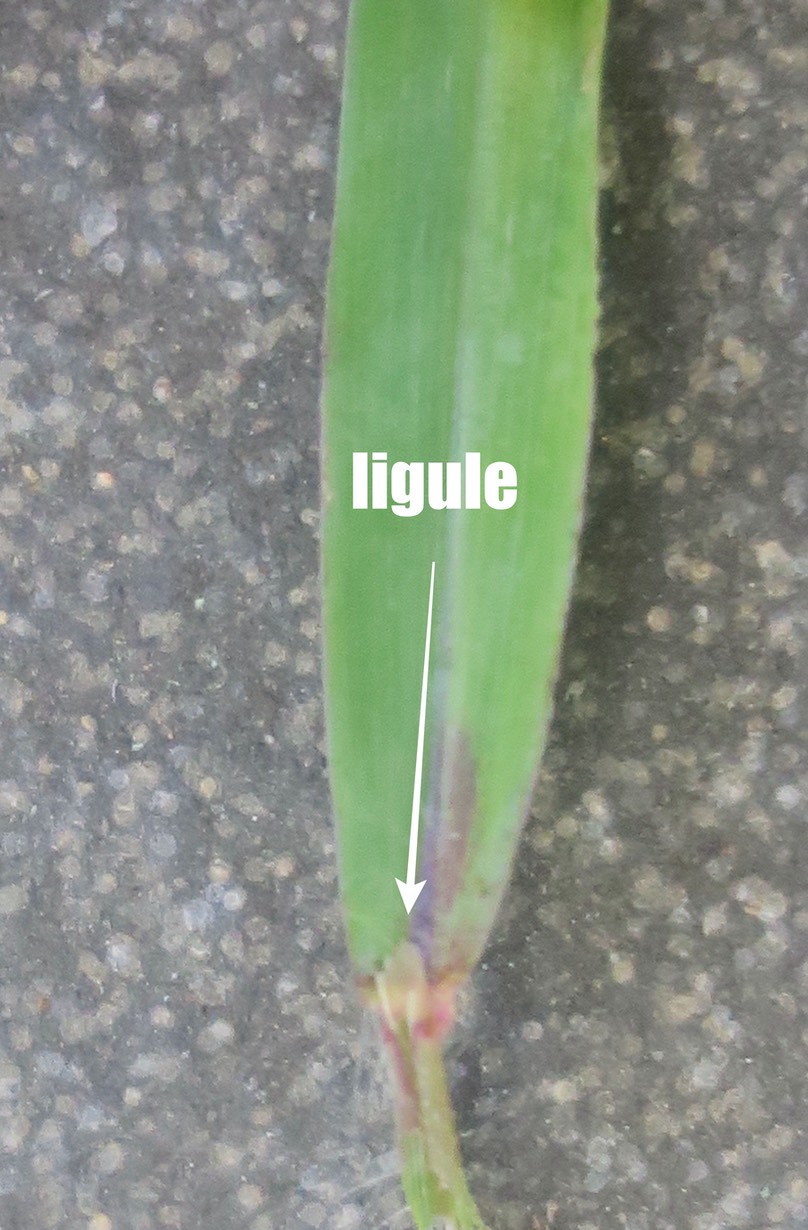
Grasses produce flowers but they are not called flowers, they are called florets. They have lost a lot of their floral structure over the years of evolution. There are only three stamens and no sepals or petals. There may be remnants of petals at the base of the ovary of the floret called lodicules but not all grasses even have that.
Instead, each floret is subtended (how do you like that technical term) by a lemma and palea. The lemma is similar to a bract-like structure at the base of the ovary and is generally a little larger than the palea. The palea is also bract-like.

Typically, a group of florets are arranged together to form a spikelet. Spikelets, at their base, are often subtended (that word again) by another pair of bract-like structures called glumes.

Spikelets are aggregated together to form a spike of the grass.

Then, when you think you have grasses figured out, they throw a curve at you. There are all types of variations of the grass “flower” and florets. Many grasses (as in the previous photo, produce awns or projections of various types from the floret. However, they are a fascinating group of plants and of course include some of the most important plants of the planet: wheat, rice, barley, sorghum, and corn (maize) sugar cane, and bamboos. I figured they had to be important when they created a course strictly for grasses (agrostology).
Achnantherum hymenoides Roem. & Shult.

Indian Rice Grass (Achnatherum hymenoides (Roem. & Schult.)
I know, it’s a terrible photo and the only reason I know the genus and species is it was labeled on the nature trail. However, it does show you that a lot of western grasses grow in tufts.
At one time, it was placed in the genus Oryzopsis because of its similarity to Oryza, the genus for rice.
Bromus tectorum L.

Cheatgrass (Bromus tectorum Linnaeus)
Most of the people I met out west hated this grass. It outcompetes native species. Even though it is edible for forage animals, when it produces mature awns, it no longer is.
 Cheatgrass (Bromus tectorum Linnaeus)
Cheatgrass (Bromus tectorum Linnaeus)
It is an attractive grass and that’s probably the reason it was brought into the U.S. in the first place. Like kudzu, it likes it here. It is of European origin.145
I photographed this for the first time at Dead Horse Point State Park in Utah and then at Catalina State Park near Tucson.
Hordeum jubatum L.

Foxtail Barley (Hordeum jubatum L.)
This is a native species of meadows, prairies, river banks, and roadsides.146
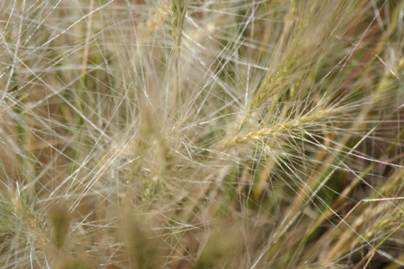
Foxtail Barley (Hordeum jubatum L.)
What sets this grass apart from many others are the extremely long awns from the florets. I photographed this in two locations: Pipe Springs National Monument and Devil’s Tower National Monument.
Hordeum murinum subsp. glaucum (Steudel) Tzvelev
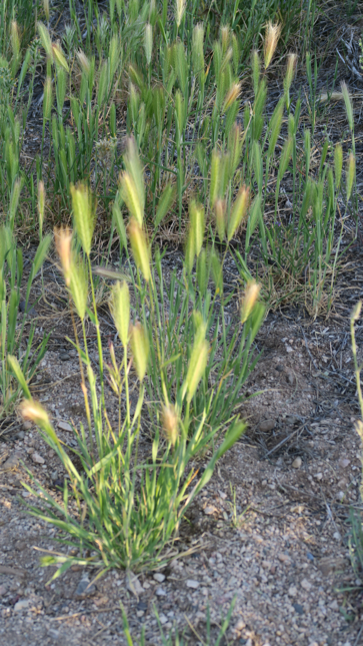
False Barley (Hordeum murinum subsp. glaucum (Steudel) Tzvelev)
This is another nonnative species and yet, also attractive. It seems to be out competing other natives in the western U.S.147
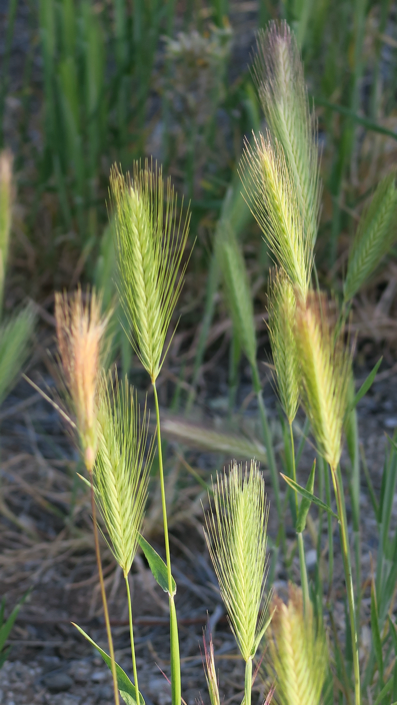
False Barley (Hordeum murinum subsp. glaucum (Steudel) Tzvelev)
Again, it has extremely long awns attached to the florets. This was photographed at Catalina State Park near Tucson, Arizona.
Agropyron cristatum (L.) Gaertn.
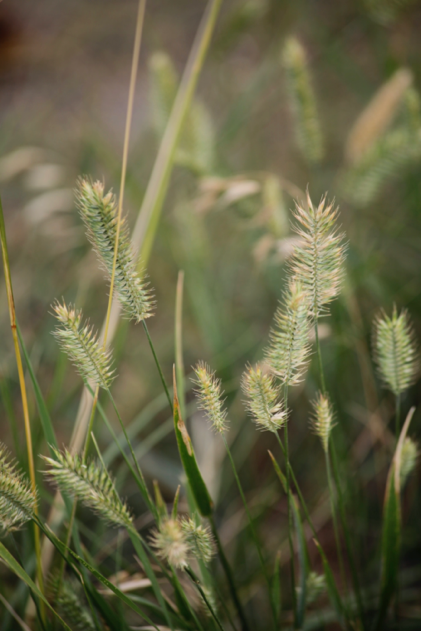
Crested Wheatgrass (Agropyron cristatum (L.) Gaertn.)
Another nonnative, it often inhibits native species with its aggressive growth.148 I had read about this and seen pictures in graduate school but never seen it in the wild. It, like B. tectorum is an attractive grass. It was photographed at Badlands National Park.
Briza maxima Linnaeus
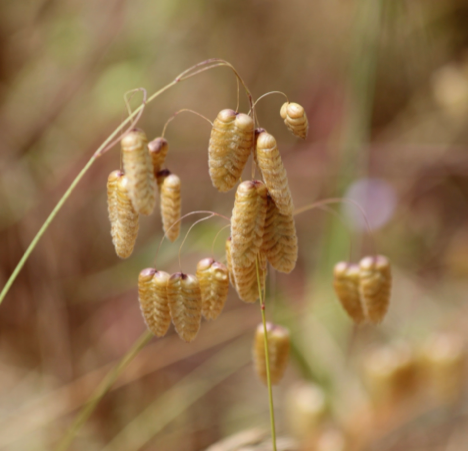 Quaking Grass (Briza maxmima Linnaeus)
Quaking Grass (Briza maxmima Linnaeus)
This was imported as an ornamental and has escaped.149 I remember seeing drawings of this grass during graduate school and wanting desperately to find it. I finally ran across it at Point Reyes National Seashore.
The dried glumes rattle in the wind.
Lagurus ovatus Linnaeus
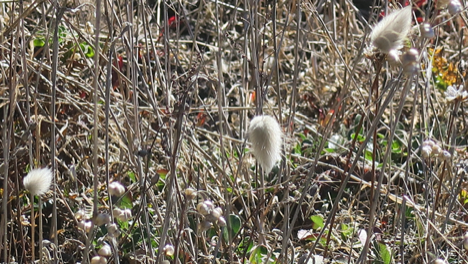 Haretail Grass (Lagurus ovatus Linnaeus)
Haretail Grass (Lagurus ovatus Linnaeus)
This is about as distinctive as you can get. I saw this as I was walking down the path to Point Reyes Lighthouse at Point Reyes National Seashore. I’d never even seen pictures or photos of this before but I knew it was a grass and was unique enough for me to identify it. There’s no confusing this one.
Bouteloua gracilis (Kunth) Lag. ex Griffiths
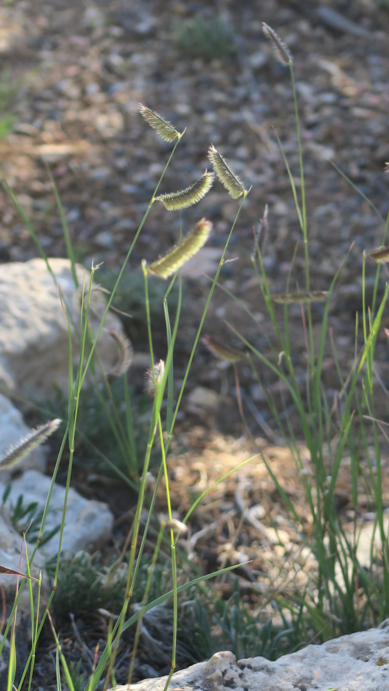
Gamma Grass (Bouteloua gracilis (Kunth) Lag. ex Griffiths)
I think you can see a pattern here. I’m photographing grasses previously identified for me by the park service or photographing those so unusual I have a good chance of identification.
This is a native grass150 I remember seeing photos of during graduate school but never even seeing a herbarium specimen. Since those days, I’ve run into it in two locations: Grand Canyon National Park and Great Sand Dunes National Park.
Previously, it was in the genus Chondrosum.
Dichanthelium commutatum (Schult.) Gould
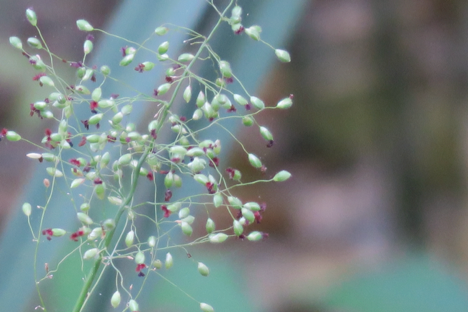
Panic Grass (Dichanthelium commutatum (Schult.) Gould)
I knew and collected this in Tishomingo when it was known as Panicum commutatum. This is very much an eastern species of grass and native.
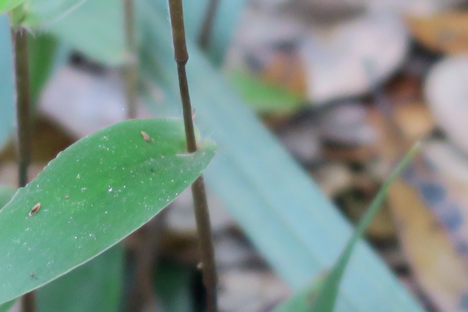
Panic Grass (Dichanthelium commutatum (Schult.) Gould)
Panic is a good description of this genus. When I was in graduate school, there were 211 species of Panicum listed in The New Britton and Brown Illustrated Flora of the Northeastern United States and Adjacent Canada.151 Flora of North America has reduced that to 34.152
Dr. Pullen really liked the genus. I hated it. It was very difficult to figure out the different species - at least for me. There are 72 species of Dichanthelium listed in the Flora.153
Andropogon glomeratus (Walter) Britton

Broom Sedge (Andropogon glomeratus (Walter) Britton)
There are fourteen species of Andropogon listed in Flora of North America and the distribution is mostly in the southeastern U.S.154
I didn’t know the genus of this plant until graduate school but almost every body in the south knows broom sage/sedge. My grandmother on my Dad’s side used to make brooms from broom sedge (again, not a true sedge but a grass). They were not like the brooms you see today. Instead, the long culms of the plant were tied together in a cylinder with only the ends free. They made a pretty good broom but you ended up doing twice the amount of sweeping with modern brooms.
I can still see my grandmother sweeping out her house with a broom made from broom sedge. It was a lost cause - two boys, a girl and four grandkids plus her husband bringing in dirt all day.
Species/Location
Achnantherum hymenoides
Nature Trail, Great Sand Dunes National Park
Bromus tectorum
Dead Horse Point State Park, Moab, Utah
Catalina State Park, Tucson, Arizona
Hordeum jubatum
Pipe Springs National Monument, Valentine, Arizona
Devil’s Tower National Monument
Hordeum murinum subsp glaucum
Catalina State Park, Tucson, Arizona
Agropyron cristatum
Badlands National Park
Brizia maxima
Lands End Coast Trail, San Francisco, California
Lagurus ovatus
Point Reyes Lighthouse, Point Reyes National Seashore
Bouteloua gracilis
Grand Canyon National Park, South Rim
Nature Trail, Great Sand Dunes National Park
Dichanthelium commutatum
Lake George State Forest, De Leon Springs, Florida
Andropogon glomeratus
Kissimmee Prairie Preserve State Park, Okeechobee, Florida
Chapter 13
Pontederiaceae
This is commonly referred to as the pickerel-weed family of plants. All are aquatic, at least at some time during the year, and some have become pests in waterways. There are four genera and 11 species in the Flora but two of those genera and three species were introduced into North America.155 Those introduced are Monochoria vaginalis, Eichhornia crassipes, and E. azura.156
Eichhornia crassipes (Martius) Solms
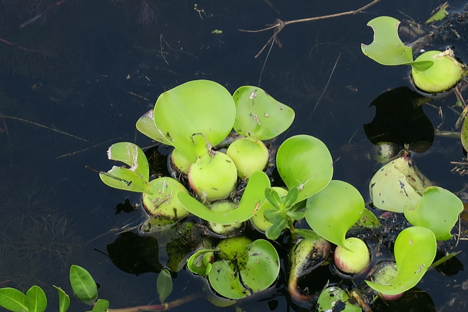 Water-hyacinth (Eichhornia crassipes (Martius) Solms)
Water-hyacinth (Eichhornia crassipes (Martius) Solms)
I don’t have a photo of this in bloom which is a shame. It produces a beautiful spike of blue flowers. This plant is immediately familiar by the inflated petioles of the leaves which keep it afloat in quiet bodies of water.
Flora of North America writes “This is probably the most aggressive aquatic weed ever known in the tropics and has been documented to cause extensive physiological changes in the aquatic environment.” Additionally, it states “Plants were probably first introduced into the U.S. at the Louisiana exposition in 1884 and the species is now known in all states where freezing temperatures are minimal. Research results from the 1970s suggest that the species may have an economic importance by removing toxic substances from water.”157
The plant has become such a pest in Florida canals and waterways that machines have been designed to remove the weed. The University of Florida Institute of Food and Agricultural Sciences (IFAS) provides an interesting history and current state of those machines.
This was growing in an overflow pond at Reed Bingham State Park near Adel, Georgia.
Pontederia cordata Linnaeus
Pickerelweed (Pontederia cordata Linnaeus)
This is our native version of the water-hyacinth and far less a problem. Whereas water-hyacinth floats and can fill a canal, this plant grows along the margins of lakes and canals and ditches and roots in the mud.
Pickerelweed (Pontederia cordata Linnaeus)
The flowers are extremely attractive and they open and hopefully get pollinated in one day. The petals then fall off. The genus gives the family its name.
Species/Location
Eichhornia crassipes
Reed Bingham State Park, Adel, Georgia
Pontederia cordata
Kissimmee Prairie State Park, Okeechobee, Florida
Chapter 14
Liliaceae
Most people know this family - at least by name - but probably don’t realize how many genera and species are found within it. As of 2002, Flora of North America reports 70 genera and 479 species in the family.158
In Tishomingo, I collected 19 species in the park159 and I have since photographed 39 species during my travels and every time I run into a member of the family, I get excited.
I think my first cognition of this family was in the spring in Mississippi where wild onions grew in yards. They were one of the first signs of spring - a bit of green amid the still dead grass. I probably wouldn’t have any experience then but for the fact if you rough-housed on the lawn, you often crushed these and you immediately received a gust of onion smell to your nose. Later, I learned in Boy Scouts they were indeed edible.
A word of caution. Even though wild onions and wild garlic, members of the lily family are edible, there are other members that are poisonous, as you will see by some of the common names.
Aletris lutea Small
 Yellow Colic-root (Aletris lutea Small)
Yellow Colic-root (Aletris lutea Small)
My first experience with this genus was in Mississippi during graduate school days with one of Dr. Pullen’s courses and it was Aletris farinosa. Finding this was a nice surprise. The plant actually looks deformed until you look closer at the flowers on the stem.
The leaves form a basal rosette and any stem leaves appear as scale-like. I was with my friend Pat in the Big Cypress Preserve on this find.
There are five species in the Flora but only two species have yellow flowers: A. lutea and A. aurea. The difference is in the size of the flowers. A. lutea flowers are more than 2.5 times as long as wide and the apex of the petals spread outward.160
Veratrum viride Aiton

False Hellebore (Veratrum viride Aiton var. escscholzianum)
OK, I admit it. I was taken with the leaves of this. Apparently, I’m not alone. Clyde Butcher, famous photographer, has taken some beautiful black and whites of the same plant.
The leaves fascinated me but I had to wait to find out what they were. There were no blooms on this specimen although it looked like it was about a week away from producing blooms.
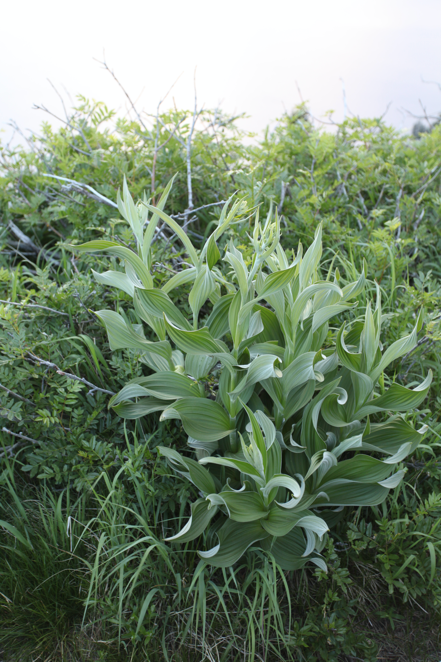
False Hellebore (Veratrum viride Aiton var. eschscholzianum)
I think you can see it’s a pretty large, tall plant.
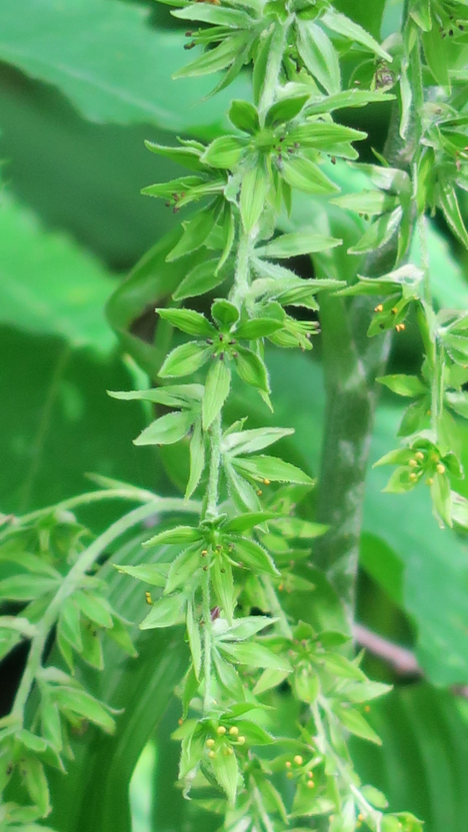
False Hellebore (Veratrum viride Aiton var. viride)
It’s also one of the few plants I know that produces green flowers!
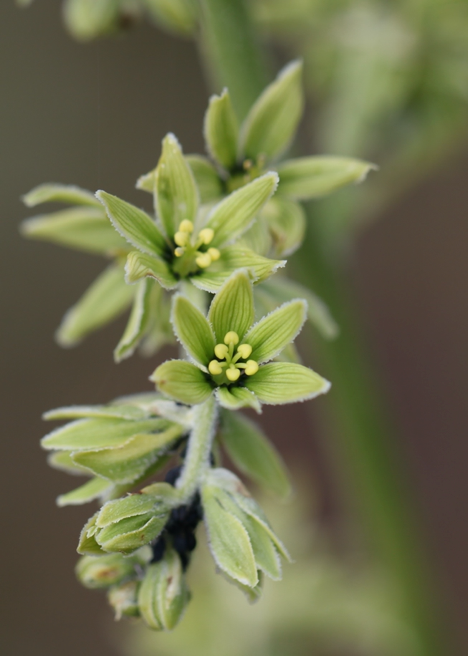
False Hellebore (Veratrum viride Aiton var. eschscholzianum)
I find it interesting the flowers have cilia around the edges of the sepals and petals. By the way, there are only three green petals and three green sepals - giving the appearance of six. When the sepals and petals resemble each other, they are called tepals.
There are two varieties separated during glaciation. One is on the west coast of the U.S. and Canada and the other is on the east coast. The east coast species is V. viride var. viride. The west coast species is V. viride var. eschscholzianum.161
The easiest way to see the difference in the varieties is to compare the two blooms.
By the way, if you want to know what “true” hellebore looks like click here.
Zigadenus venenosus S. Watson

Meadow Death Camas (Zigadenus venenosus S. Watson)
From the common name, I think you can assume this is a poisonous species. I’ve read about it from time to time in Boy Scouts but had never seen it until I found it along the Lakeshore Trail near Stehekin, Washington.
 Meadow Death Camas (Zigadenus venenosus S. Watson)
Meadow Death Camas (Zigadenus venenosus S. Watson)
I next ran into it at Cross Fissures at Black Canyon of the Gunnison National Park. It was fairly common in both locations. The tepals are interesting because when fully open, they look as though they have little white points.
There are some authorities that place this in the genus Toxiscordion.
Zigadenus fremontii (Torrey) Torrey ex S. Watson
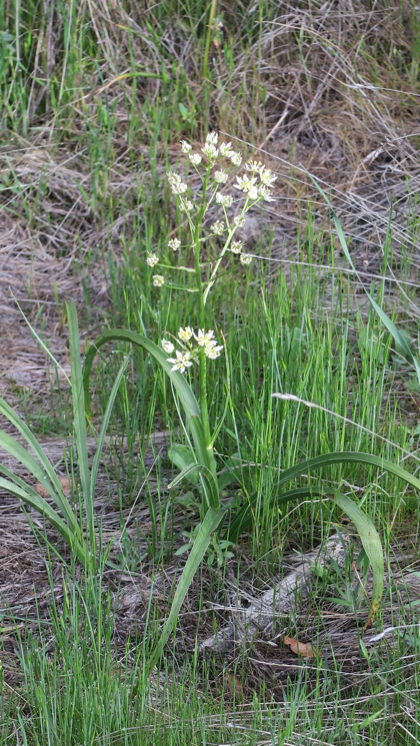
Star Lily (Zigaenus fremontii (Torrey) Torrey ex S. Watson)
Although not called “death camas” all members of the genus are probably poisonous. I think I like the blooms of this one a little better.
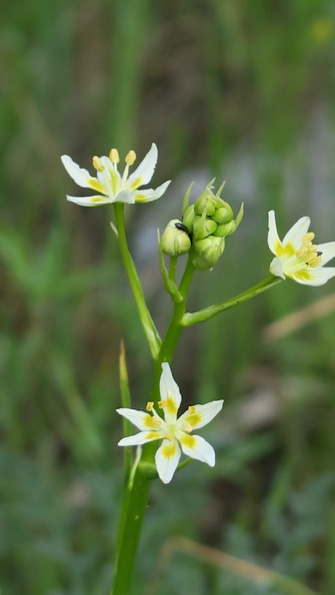
Star Lily (Zigaenus fremontii (Torrey) Torrey ex S. Watson)
I like how the tepals have a yellow patch at the base. It makes the flower stand out a little more. This was photographed on The Balcones Trail at Pinnacles National Park.
Amianthium muscitoxicum (Walter) A. Gray
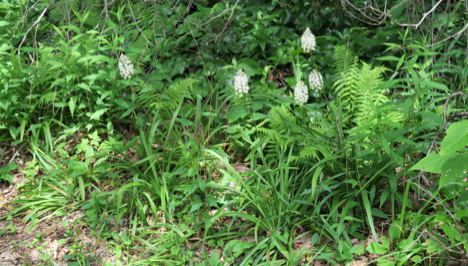
Fly Poison (Amianthium muscitoxicum (Walter) A. Gray)
Fly poison is an apt name for this plant. Flora of North America reports two toxins associated with the leaves and roots: jervine and amianthine. Apparently the common name comes from mixing extracts of the plant with honey or molasses to form a fly poison.162
I had seen this in books before but never in the wild so you can imagine my excitement when found it growing roadside of the Blue Ridge Parkway in June of 2017. I later found it growing in Shenandoah National Park in June of 2018.

Fly Poison (Amianthium muscitoxicum (Walter) A. Gray)
The blooms are particularly attractive with the white flowers with tepals turning green as they age. The Latin for the common housefly is Musca domestica. I assume toxicum is self explanatory, so literally, the specific name is fly poison.
Trillium catesbaei Elliott
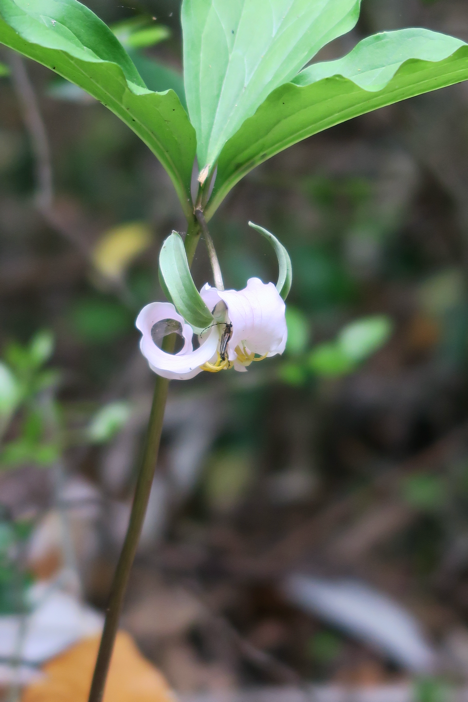 Catesby’s Trillium (Trillium catesbaei Elliott)
Catesby’s Trillium (Trillium catesbaei Elliott)
I confess to a fondness for the lily family and an especial fondness for the genus Trillium. I found T. cuneatum and T. sessile at Tishomingo State Park back in the 70‘s163 and kept thinking I would find more than two species in the park. I never did but I never quite trying to find a third or fourth species.
The holy grail for me was Catesby’s trillium - only seen by me in books. Mark Catesby was an English naturalist (1683-1749) who collected extensively in the Carolinas, Florida and the Bahamas (Wikipedia). He has particular stature in Florida with its unique vegetation that blends temperate and subtropical climates.
Anyway, I was hiking the Wolfden Loop Trail, part of the Pine Mountain Trail at F. D. Roosevelt State Park near Warm Springs, Georgia when I caught a glimpse of something out of the corner of my eye.
I have to admit I went a little crazy. When I photograph, I do try to retain a little decorum but I threw that to the wind and in order to get a photograph of the bloom, I had to lie prone - in the mud - to get a good photo. It was worth it. However, I’m sure several hikers I met on the trail that day wondered about the mud pattern on the front of my clothes.
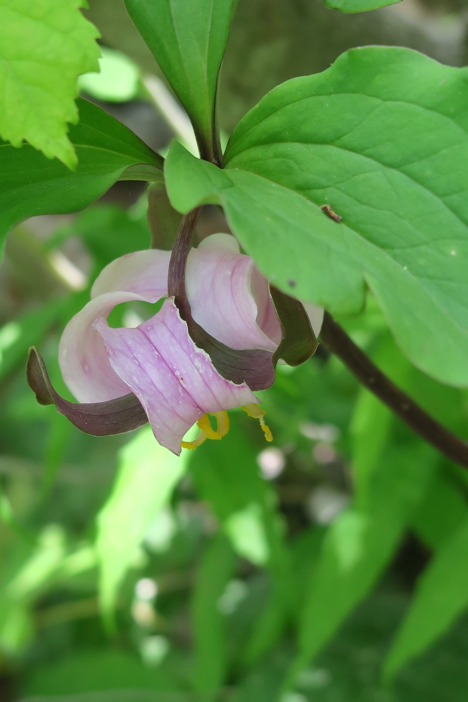 Catesby’s Trillium (Trillium catesbaei Elliott)
Catesby’s Trillium (Trillium catesbaei Elliott)
There are 38 species of Trillium in the Flora164 and I have to say this is one of the prettiest. Others species are similar in form and color of the petals but this is the only one with yellow stamens.
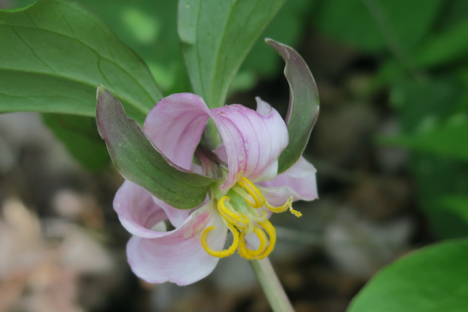 Catesby’s Trillium (Trillium catesbaei Elliott)
Catesby’s Trillium (Trillium catesbaei Elliott)
Trillium erectum Linnaeus var. album (Michaux) Pursh
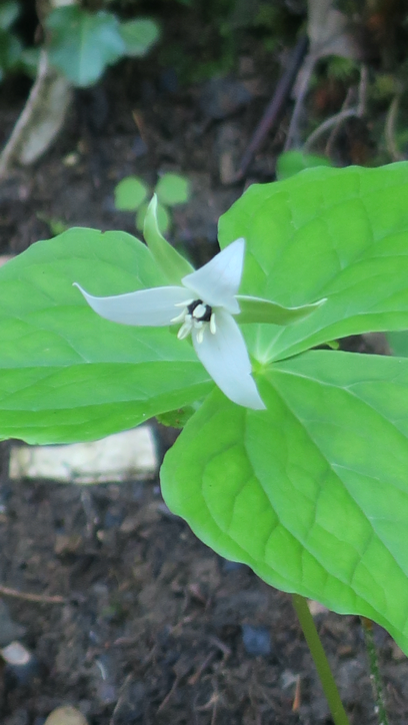
White Erect Trillium (Trillium erectum var. album (Michaux) Pursh)
I like it when common names state the obvious. My encounter with this one came on the Smokemont Loop Trail in the Smokies in April of 2019. It was another first for me.
The Flora reports the flower has a fetid odor they describe as a “wet dog.”165
Trillium grandiflorum (Michaux) Salisbury
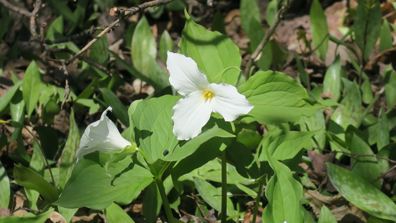
Large-flower Trillium (Trillium grandiflorum (Michaux) Salisbury)
I was driving from Voyageurs National Park in Minnesota to Hancock, Michigan to catch a seaplane to Isle Royale National Park when I kept noticing this white bloom along the side of the road. Finally, I couldn’t stand it and pulled off the road and walked back a ways to find these in bloom.
I knew it was a species I had not seen before.
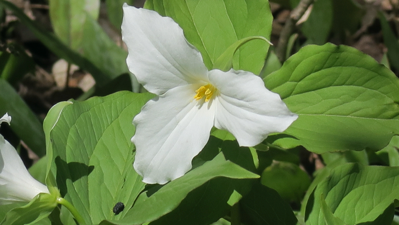
Large-flower Trillium (Trillium grandiflorum (Michaux) Salisbury)
It was a good thing I stopped because I did not find it in bloom on Isle Royale.
Trillium ovatum Pursh
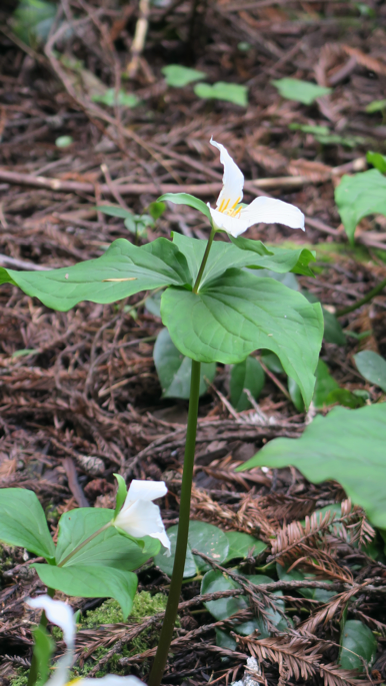
White Trillium, Western Trillium (Trillium ovatum Pursh)
I tend to think of Trillium as a rather robust plant but this one was very delicate looking and much smaller than others I have seen. It was outside my cabin at Jedediah Smith Redwoods State Park in northern California.
When I got to the cabin it was late in the afternoon and I noticed there were some pink flowered ones mixed in with the white. I wondered if it was a separate species but the flowers looked identical other than the color.
The white flower gradually turns pink as the day grows long.
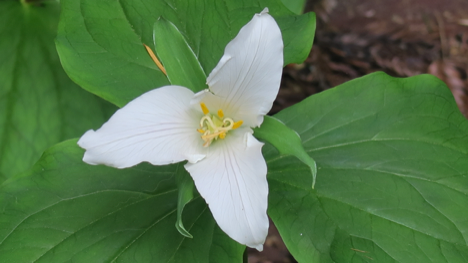 White Trillium, Western Trillium (Trillium ovatum Pursh)
White Trillium, Western Trillium (Trillium ovatum Pursh)
You can just see a tinge of pink beginning in this flower.
Trillium rivale S. Watson
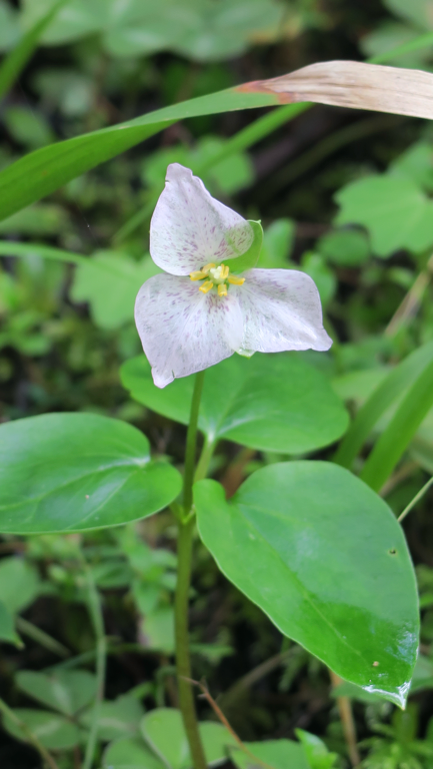
Siskiyou Wakerobbin (Trillium rivale S. Watson)
If I ever update these three volumes, I may end up putting this back where I originally had it in the family Melanthiaceae and in the genus Pseudotrilliium. It certainly does look like a Trillium but not really when you look closer. The three leaves are distinctly different than most trilliums.
The Flora of North America restricts the distribution to the Siskiyou and Klamath Mountains of southwest Oregon and northern California.166
I found it scattered in and around Redwoods National Park and Jedediah Smith Redwoods State Park.
Calochortus gunnisonii S. Watson
 Gunnison’s Mariposa Lily (Calochortus gunnisonii S. Watson)
Gunnison’s Mariposa Lily (Calochortus gunnisonii S. Watson)
The genus Calochortus is sometimes collectively known as sego lily with 56 species listed in Flora of North America, all western species.167
I was first alerted to this genus on my trip with friends to the canyonlands of Utah and Arizona when I came across it in a local wildflower guide. I really wanted to find this type of lily. Two years later, while on another trip with the same friends, I took a day and traveled to Devil’s Tower in Wyoming.
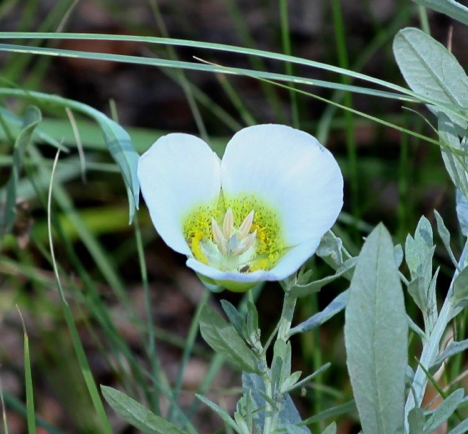
Gunnison’s Mariposa Lily (Calochortus gunnisonii S. Watson)
I was thrilled to find it on my hike around the Tower. Unfortunately, it was a little ways off the trail and I had to make do with a telephoto lens for my shots. I try my best not to get off trails and since Devil’s Tower is sacred ground for the Lakota, Arapahoe, Cheyenne, Shoshone, Crow and Kiowa (Wikipedia) I felt it would be a desecration to walk over and take the photo.
That probably sounds silly but when you are in the presence of Devil’s Tower, those things don’t seem silly at all.
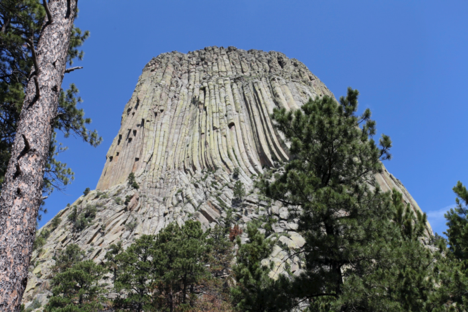 I took as many photos as I could from a distance. It’s a beautiful lily and the way I look at things, that only leaves me 55 more species to go!
I took as many photos as I could from a distance. It’s a beautiful lily and the way I look at things, that only leaves me 55 more species to go!
Prosartes hookeri Torrey
 Hooker’s Fairybells (Prosartes hookeri Torrey)
Hooker’s Fairybells (Prosartes hookeri Torrey)
I never came across this plant during my graduate school days and I find it all the more remarkable that out of five species in North America, I’ve now have photographed four of them!168
They remind me so much of the genus Uvularia (bellworts) and when I first saw them, thought that was what I found. A little research revealed a new genus for me even though these are found in both the western and eastern parts of North America.169
 Hooker’s Fairybells (Prosartes hookeri Torrey)
Hooker’s Fairybells (Prosartes hookeri Torrey)
I kept seeing this along the Lakeshore Trail at Stehekin, Washington on my North Cascades National Park adventure.
 Hooker’s Fairybells (Prosartes hookeri Torrey)
Hooker’s Fairybells (Prosartes hookeri Torrey)
The tepals are all white and deeply divided down to the base of the flower. You can also see the parallel venation of the leaves typical of monocots.
Prosartes lanuginosa (Michaux) D. Don
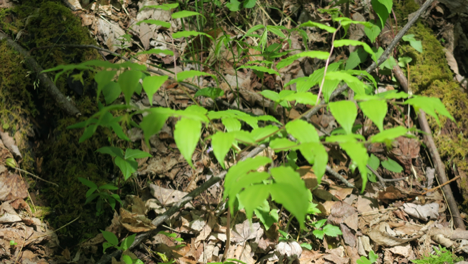 Yellow Mandarin (Prosartes lanuginosa (Michaus) D. Don)
Yellow Mandarin (Prosartes lanuginosa (Michaus) D. Don)
Since I had previously seen P. hookeri, I at least knew the genus when I saw this in the Smokies.
 Yellow Mandarin (Prosartes lanuginosa (Michaus) D. Don)
Yellow Mandarin (Prosartes lanuginosa (Michaus) D. Don)
Most of the ones I saw were not quite in bloom but I managed to find at least one. This is the one species that is closest to Mississippi170 but not yet reported. Perhaps one day someone will find it does grow in the state
Prosartes smithii (Hooker) Utech

Smith’s Fairybells (Prosartes smithii (Hooker) Utech)
This really stood out to me because of the red stems. This plant is restricted to along the sea coast of northern California, Oregon, Washington, and British Columbia.171
 Smith’s Fairybells (Prosartes smithii (Hooker) Utech)
Smith’s Fairybells (Prosartes smithii (Hooker) Utech)
I found it in two locations in California: Klamath Beach Road in Del Norte Coast Redwoods State Park, Crescent City, California and Yurok Loop Trail in Redwoods National Park.
Apparently, one of the characteristics of fairybells is how deeply cleft the tepals are all the way down to the receptacle of the flower.
Prosartes trachycarpa S. Watson
 Rough-fruited Fairybell (Prosartes trachycarpa S. Watson)
Rough-fruited Fairybell (Prosartes trachycarpa S. Watson)
Well, since it is not in fruit, I’ll have to take the word of the person who named it rough-fruited. This was growing along the Oak Flat Trail at Black Canyon of the Gunnison in Colorado.
Streptopus amplexifolius (Linnaeus) de Candolle
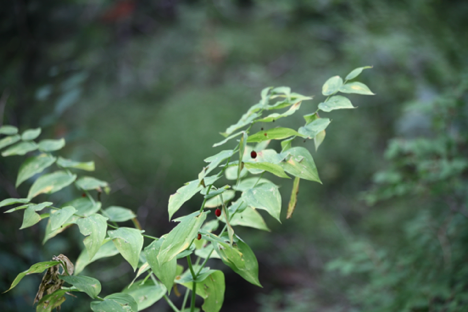 Clasping-leaved Twisted Stalk (Streptopus amplexifolius (Linnaeus) de Candolle)
Clasping-leaved Twisted Stalk (Streptopus amplexifolius (Linnaeus) de Candolle)
I had heard of twisted stalk ever since graduate school days but had never found it in the wild. I found this growing along the lakeshore of Emerald Lake in British Columbia.
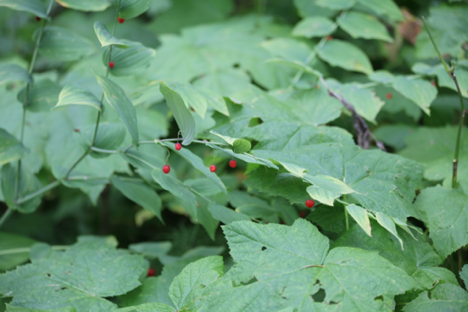 Clasping-leaved Twisted Stalk (Streptopus amplexifolius (Linnaeus) de Candolle)
Clasping-leaved Twisted Stalk (Streptopus amplexifolius (Linnaeus) de Candolle)
I think you can see how the leaves literally clasp the stem, almost perfoliate.
Uvularia sessilifolia Linnaeus
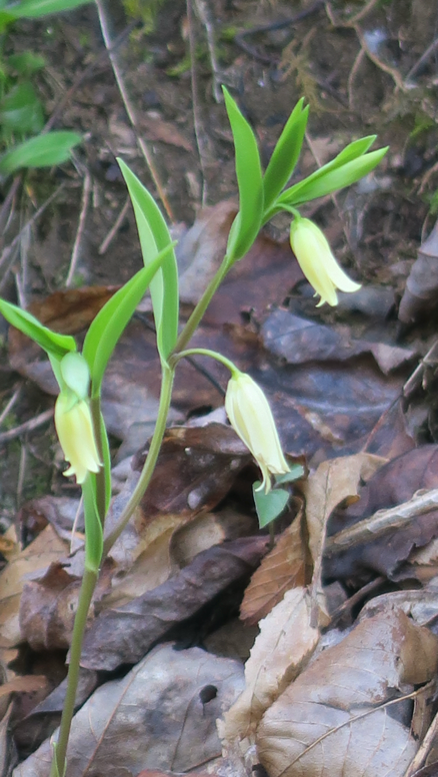
Sessile-leaf Bellwort (Uvularia sessilifolia Linnaeus)
Uvularia is an old friend. I collected U. grandiflora, U. perfoliata, and U. sessilifolia in Tishomingo State Park in the 70’s.172
I photographed this in two locations: Voyageurs National Park and Great Smoky Mountains National Park.
Medeola virginiana Linnaeus
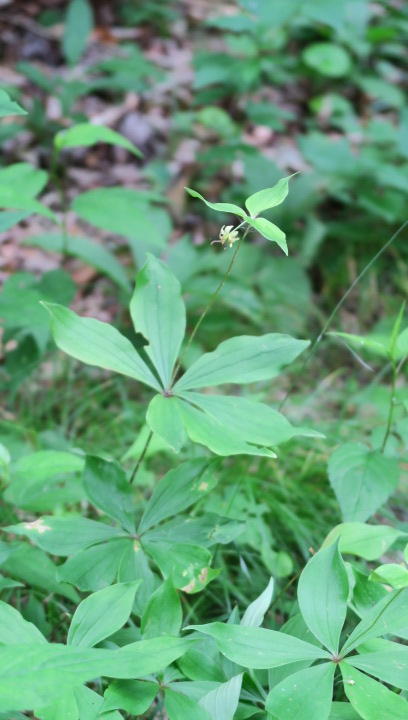
Indian Cucumber (Medeola virginiana Linnaeus)
I first found this while on a hike at Deep Creek Trail in the Smokies in May 2016. It was not in bloom at the time but I knew the plant, even with just foliage. It’s hard not to recognize that bottom set of six whorled leaves.
In June of 2017, I was hiking to Crabtree Falls when I found the plant in bloom. The bloom is small but the effect is special.

Indian Cucumber (Medeola virginiana Linnaeus)
The flowers hang down from the leaves when in bloom. That meant I had to get under the plant and photograph upward. Needless to say, the trail was wet and I hiked the rest of the way out with a nice wet patch from torso to legs.

Indian Cucumber (Medeola virginiana Linnaeus)
The purple objects are recurved stigmas of the pistil. The tepals are yellowish and you can plainly see the six stamens. The photograph turned out well enough I didn’t mind getting wet.
Clintonia umbellata (Michaux) Morong
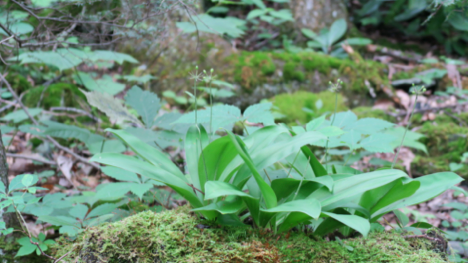 Clinton’s Lily (Clintonia umbellata (Michaux) Morong)
Clinton’s Lily (Clintonia umbellata (Michaux) Morong)
I have yet to photograph any species of Clintonia in bloom. Hope springs eternal. Fortunately, the leaf structure (basal rosettes) is so distinctive you can identify it without any flowers or fruit.
 Clinton’s Lily (Clintonia umbellata (Michaux) Morong)
Clinton’s Lily (Clintonia umbellata (Michaux) Morong)
The flowers and fruit are in a simple umbel. You can also see a stem leaf on one spike and how different that leaf is from the basal leaves. Also, note the pubescence on the stems.
The flower honors De Witt Clinton (1769-1828) governor of New York state for several terms.173
I have photographed one other species of Clintonia but the photograph is so badly out of focus and underexposed I did not include it. It was taken in the dim sunlight of Muir Woods National Monument. It is Andrew’s Clintonia, C. andrewsiana Torrey.
Maybe one day I’ll get a photo of one in bloom. Until then, you can see one in bloom at the North Carolina Native Plant Society webpage.
Erythronium grandiflorum Pursh
 Glacier Lily (Erythronium grandiflorum Pursh)
Glacier Lily (Erythronium grandiflorum Pursh)
My first exposure to glacier lilies was in The Bugaboos in August of 2015. Every one had already bloomed and there was nothing left but seed pods.
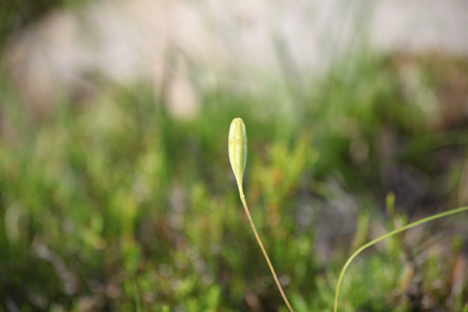 Glacier Lily (Erythronium grandiflorum Pursh)
Glacier Lily (Erythronium grandiflorum Pursh)
I had pretty much given up hope of seeing them in bloom when I set out on a cross country trip in 2018. I ran into some planted specimens of E. grandiflorum in front of the lodge at Mount Rainier National Park. I thought at least I got to see them in bloom.
As I continued my trip, I ended up in North Cascades National Park near Stehekin, Washington when I ran into masses of them. They did not disappoint!
There are 23 species in North America and considering the common name, you would assume most are western species. That’s true but there are some eastern species as well.174
 Glacier Lily (Erythronium grandiflorum Pursh)
Glacier Lily (Erythronium grandiflorum Pursh)
Erythronium americanum Ker Gawler
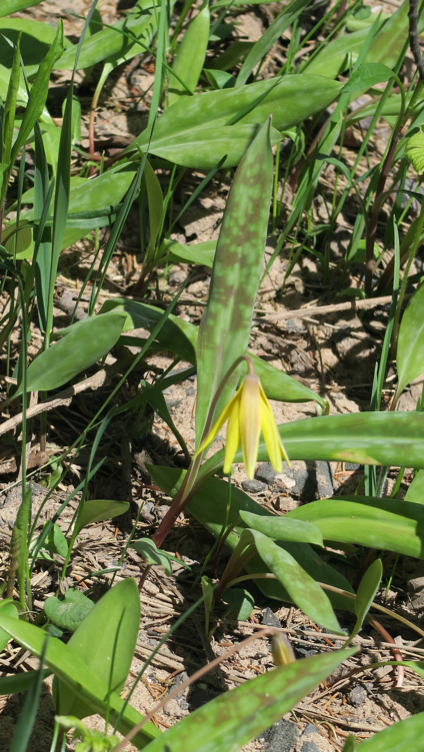
American Trout-lily (Erythronium americanum Ker Gawler)
I previously described how Trillium grandiflorium caught my attention as I was driving to Hanncock, Michigan to catch a seaplane to Isle Royale National Park. I’ve learned over the years, once you stop, take a breath, look around and see what else is around you. That’s when I spotted this little lily. It was easy to overlook.
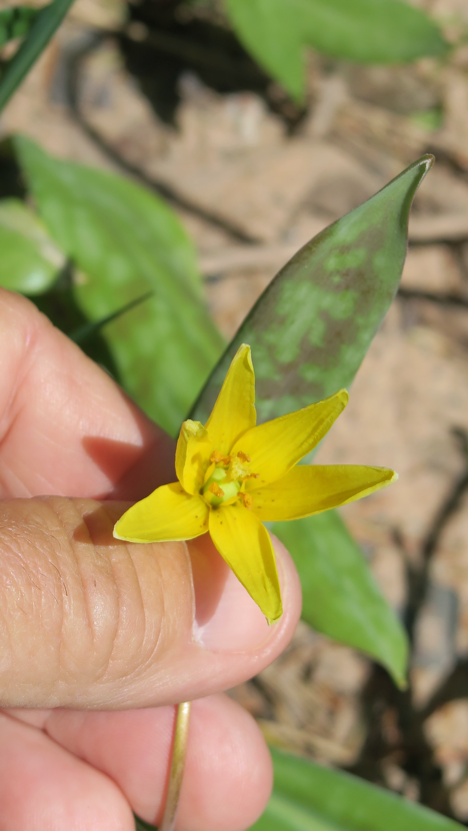 American Trout-lily (Erythronium americanum Ker Gawler)
American Trout-lily (Erythronium americanum Ker Gawler)
Every flower hangs down and that frustrates any botanist. I then grabbed a stem and carefully bent it to where I could see the inside of the flower. You have to be careful. I’ve done this before and had the stem break off in my hand.
The leaves are mottled with somewhat purplish spots.
Fritillaria affinis (Schultes & Schultes f.) Sealy
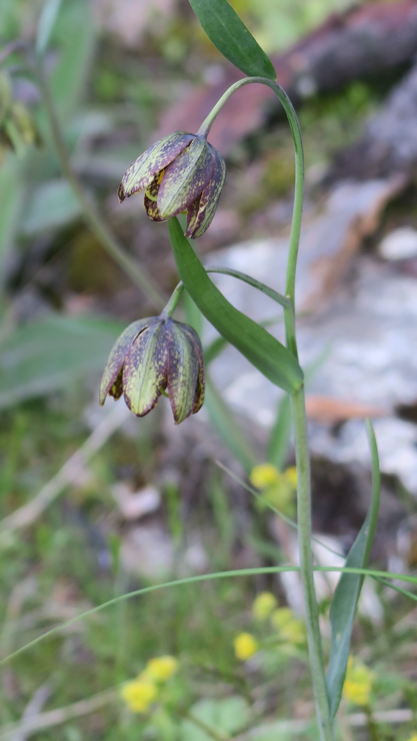
Checkerlily (Fritillaria affinis (Schultes & Schultes f.) Sealy)
It’s a great feeling to check off a species you’ve heard about, read about, and searched for. This was an ecstatic feeling when I came across this on the Lake Shore Trail at Stehekin, Washington. It was easy to miss. The green and purple blended in with the background of the trail.

Checkerlily (Fritillaria affinis (Schultes & Schultes f.) Sealy)
After finding it on the trail I finished my hike and turned around to head back to my “cabin”. It was then I discovered how prevalent it was along the trail and how many specimens I missed on my outward bound hike.
Hypoxis hirsuta (Linnaeus) Coville
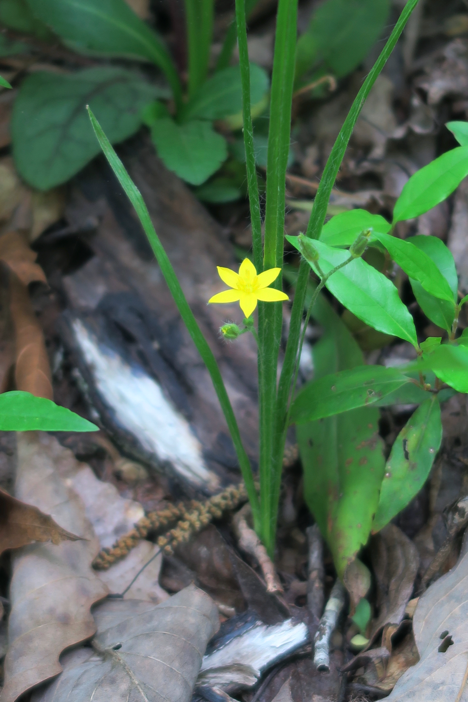 Yellow Star Grass (Hypoxis hirsuta (Linnaeus) Coville)
Yellow Star Grass (Hypoxis hirsuta (Linnaeus) Coville)
The first time I saw this it was not in bloom and I did think it was a grass. I learned during my time at Tishomingo that when I saw something pop up but not blooming to come back by and check it later. That’s what happened with this. I was pleasantly surprised to see this with six yellow tepals.
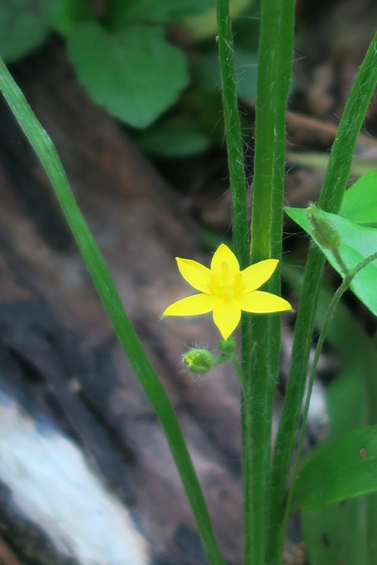
Yellow Star Grass (Hypoxis hirsuta (Linnaeus) Coville)
If you follow the leaves to the base of the plant, you’ll find a bulb with roots at the base. I’ve photographed this at F.D. Roosevelt State Park in Georgia, Deep Creek Trail and Smokemont Loop in the Smokies.
Hypoxis wrightii (Baker) Brackett
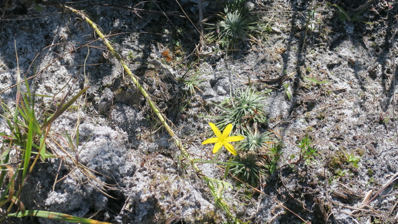
Bristleseed Yellow Star Grass (Hypoxis wrightii (Baker) Brackett)
I’m not sure you can tell by the soil in which this is growing but it’s prairie that gets temporarily flooded. That seems to be the habitat - that and pinelands.175 Since there were pine trees present, it seems to have met all the critera for habitat.
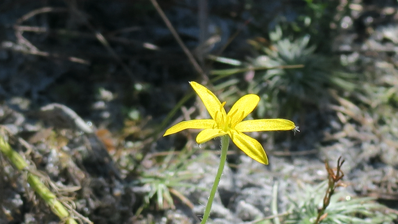
Bristleseed Yellow Star Grass (Hypoxis wrightii (Baker) Brackett)
When I first saw this, I knew it seemed to be a different species than H. hirsuta because of the narrowness of the tepals. If you compare the two species, you’ll see that H. hirsuta has broader petals.
Maianthemum canadense Desfontaines
Here’s a first! There are five species of Maianthemum in the Flora176 and I have photos of all five!

Canada Mayflower (Maianthemum candense Desfontaines)
To be honest, my familiarity with the genus stems from a plant called false Solomon’s seal and when I knew false Solomon’s seal, it was not in this genus. Canada mayflower was a new experience for me and despite its common name, I found it on the Smokemont Loop Trail in the Smokies in April of 2019. That means, technically, this was the fifth of five species I photographed.
Maianthemum dilatatum (Alph. Wood) A. Nelson & J.F. Macbride

False Lily-of-the-valley (Maianthemum dilatatum (Alph. Wood) A. Nelson & J.F. Macbride)
It took me a while to find this in bloom on the Yurok Loop Trail near Klamath, California. The trail was spectacular! It followed the coast for ocean views for a ways and then headed back inland in what seemed to be a coastal rainforest. It was also here I ran into a sign warning of tsunamis.

Yurok Loop Trail Near Klamath, California
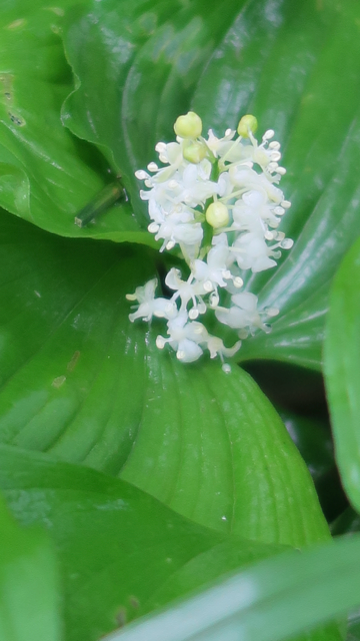
False Lily-of-the-valley (Maianthemum dilatatum (Alph. Wood) A. Nelson & J.F. Macbride)
The blooms are exceptionally tiny to begin with and there were a couple of times I thought it was only about to bloom that when I looked closer, it was in bloom. In my opinion, it’s the leaves that are the attractive part of the plant.

False Lily-of-the-valley (Maianthemum dilatatum (Alph. Wood) A. Nelson & J.F. Macbride)
Maianthemum racemosum (Linnaeus) Link
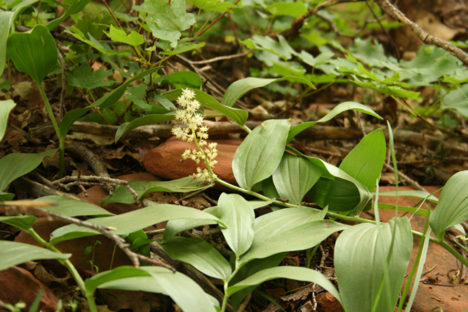
False Solomon’s Seal (Maianthemum racemosum (Linnaeus) Link subsp. amplexicaule)
This plant was my first experience with the genus albeit under a different genus at the time. I’ve gotten to where I can recognize it pretty easily. There are two subspecies in North America: M. racemosum subsp. amplexicaule and M. racemosum subsp. racemosum. Amplexicaule is a western species and racemosum is an eastern species. I’ve found it in both areas. Strangely, the middle of North America does not have any reporting of this.177
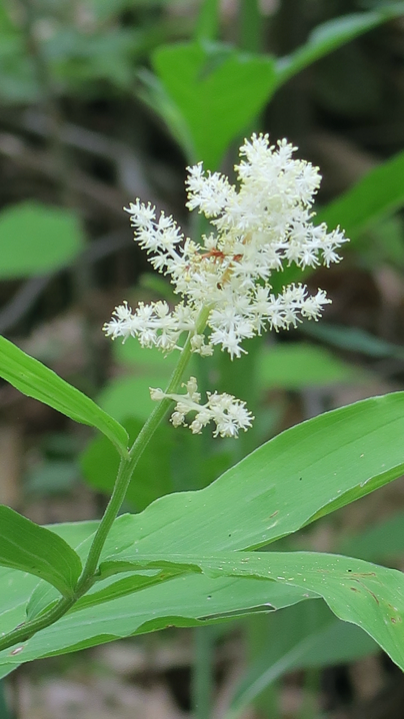
False Solomon’s Seal (Maianthemum racemosum (Linnaeus) Link subsp. racemosum)
The specific epithet racemosum comes from the name of the inflorescence.
Maianthemum stellatum (Linnaeus) Link
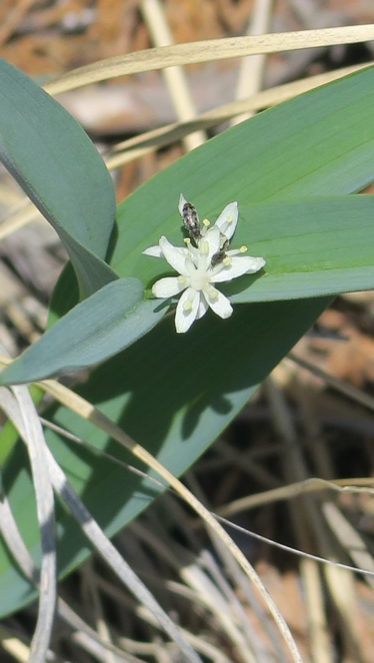
False Solomon’s Seal (Maianthemum stellatum (Linnaeus) Link)
This is very common in northern North America and pretty much absent in the southeastern U.S.178
I found this at Theodore Roosevelt National Park.
Maianthemum trifolium (Linnaeus) Sloboda
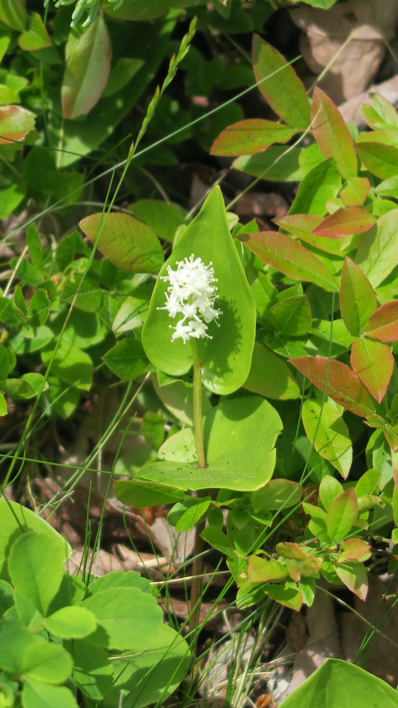
Three-leaved Solomon’s Seal (Maianthemum trifolium (Linnaeus) Sloboda)
This to me was the most unusual and attractive of the five species of Maianthemum. I found this at the Thunder Hole tourist top at Acadia National Park.

Three-leaved Solomon’s Seal (Maianthemum trifolium (Linnaeus) Sloboda)
Flora of North America reports this as an aquatic plant179 but where I found it was moist but not terribly wet soil, so I suspect it can also be considered as emerging from the water.
It’s the leaves that fascinate me. I never saw but two but the bottom leaf is perfoliate and the top leave is clasping or at least heart-shaped.
Polygonatum biflorum (Walter) Elliott

Smooth Solomon’s Seal (Polygonum biflorum (Walter) Elliott)
Another old friend of Tishomingo days! I remember this as one of the earlier flowers to bloom in the spring in the park. There are three species in the Flora of North America: P. biflorum, P. pubescens, and P. latifolium.180
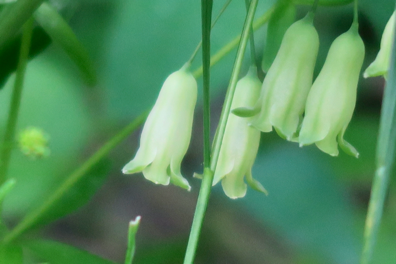
Smooth Solomon’s Seal (Polygonum biflorum (Walter) Elliott)
I think you can see where it gets the name biflorum. I usually find this in moist, shady woods and I’ve run across it numerous places: the Smokies, Cuyahoga Valley, and the Shenandoah.
Leucocrinum montanum Nuttall ex A. Gray

Star Lily (Leucocrinum montanum Nuttall ex A. Gray)
As I write this, I’m amazed at how many of these plants I can remember the exact moment and place I photographed the plant - and my memory isn’t really that good. This was on the “Desert Southwest Tour” by Tauck and we were at Bryce Canyon National Park. We had checked in the previous evening and were scheduled for another “Dawn Patrol” at Sunrise Point. It was cold.
I think everyone had pretty much gotten their photos of the hoodoos at dawn and we began to drift back to our lodging and get ready for breakfast. As I started back on the trail, the sun hit just right that I caught a glimpse of this out of the corner of my eye. I knew it was a special find but I had to wait until I was able to find it in a local wildflower guide.
There is the single species in the genus and it is restricted to a few southwestern states.181
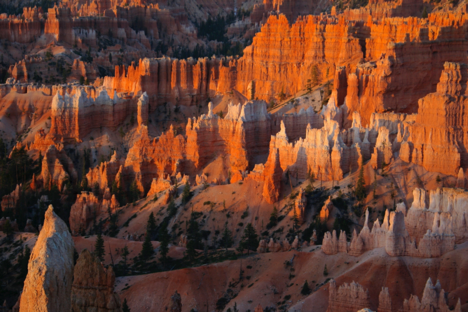 Hoodoos at Dawn
Hoodoos at Dawn
Allium schoenoprasum Linnaeus

Wild Chives (Allium schoenoprasum Linnaeus)
This is the little plant that got me back into plants. I was on a Xanterra sponsored trip with Michel and Nancy and we were staying at Old Faithful Lodge in Yellowstone. Our tour guide, Nick, was showing us around the upper geyser basin when I saw this. I snapped the photo without too much fanfare and when I had a chance to review the photos on my camera that night, I figured (1) it was a decent photograph and (2) I could probably identify the flower with some field guide. After that, I was hooked.
Allium is a large genus in the Flora of North America with 96 species listed.182 Most are simply referred to as wild onions, but like onions, there are so many varieties: chives, scallions, leeks, garlic, etc.
 Upper Geyser Basin - Yellowstone National Park
Upper Geyser Basin - Yellowstone National Park
Nick walked us all around the Upper Geyser Basin that day. It wasn’t too strenuous even though you are at significant elevation. It was all on boardwalks. On occasions, she would have to yell at some tourist to get back on the boardwalk. The ground off the board walks is very crusty and if you step on it, it damages the micro-ecosystem beneath the crust.
Allium textile A. Nelson & J.F. Macbride

Textile Onion (Allium textile A. Nelson & J.F. Macbride)
This was a funny little fellow sparsely growing along my hiking trails at Theodore Roosevelt National Park yet frequent enough to call attention to itself.
I assume the “textile” portion of the name comes from the paper-like sheaths surrounding the flowering head.

Textile Onion (Allium textile A. Nelson & J.F. Macbride)
Wherever I hiked in Theodore Roosevelt National Park, I never found one fully open.
Allium brevistylum S. Watson
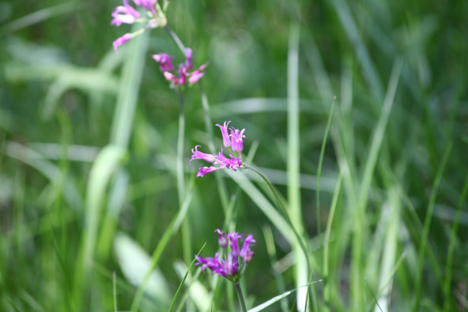 Shortstyle Onion (Allium brevistylum S. Watson)
Shortstyle Onion (Allium brevistylum S. Watson)
This is another species in both the Upper Geyser Basin and Lower Falls of the Yellowstone in Yellowstone National Park. I think A. schoenoprasum (wild chives) is more attractive, but this has its own beauty.
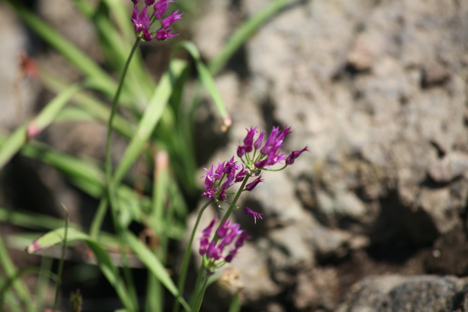 Shortstyle Onion (Allium brevistylum S. Watson)
Shortstyle Onion (Allium brevistylum S. Watson)
Flora of North America reports this is restricted to the Rocky Mountains of North America.183
The term “shortstyle” refers to the style of the pistil which is equal in length to the stamens.184 Sometimes, in other species, the style is longer than the stamens. This helps prevent self pollination if the style is longer.

Lower Falls of the Yellowstone - Yellowstone National Park
I’ve seen photos of the lower falls before and they all looked like oil paintings. When I saw the real thing, it still looked like an oil painting.
Allium triquetrum Linnaeus
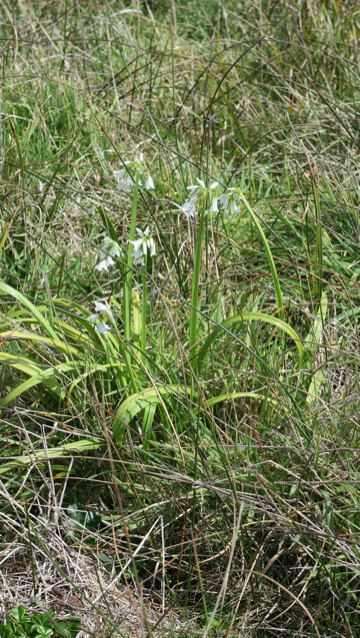 \
\
Three-cornered Garlic (Allium triquetrum Linnaeus)
This is a robust plant. It was a little over a foot in height. This is an escapee from gardens and it is considered a potential noxious weed.185
Nevertheless, I think it has a beautiful flower.
 Three-cornered Garlic (Allium triquetrum Linnaeus)
Three-cornered Garlic (Allium triquetrum Linnaeus)
The triquetrum comes from the three-angled stem of the plant.
I photographed this first at Elk Meadow in Redwoods National Park but it had been raining and the humidity was high and my lens fogged over. I later found another stand at Point St. George near Crescent City, California.
By the way, Elk Meadow is appropriately named.
My lens was quite fogged from the rain and humidity.
Nothoscordium bivalve (Linnaeus) Britton

False Garlic (Nothoscordum bivalve (Linnaeus) Britton)
This was previously known as Allium bivalve and I’ve known the plant since my days in Boy Scouts. When you dig up the bulb, or break a stem, it really does smell like garlic. The Lady Bird Johnson Wildflower Center cautions against eating the bulb. It’s toxic to some animals and the question with humans is still in doubt. Interestingly, we were told it was edible in Boy Scouts.
The leaves are very similar to Allium. I photographed this in two locations: Lake Mineral Wells State Park and Enchanted Rock State Natural Area, both in Texas.
Crinum americanum Linnaeus
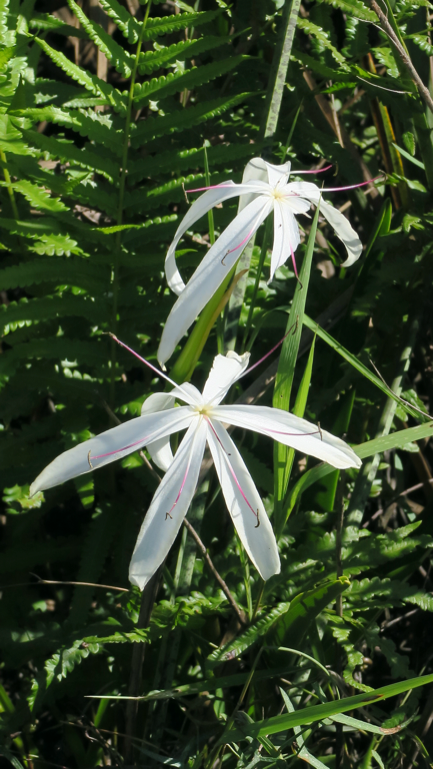
String Lily (Crinum americanum Linnaeus)
On one of my first trips with students to the Keys Marine Lab at Long Key, Florida, I kept noticing this large white flower blooming in the Everglades. I was on a schedule so I couldn’t stop. Every year, the same thing - white flowers and busy schedule. It looked like some type of lily but I couldn’t be sure until I got closer.
In 2017, I decided to take all the back roads across the Everglades to Myakka River State Park. The path took me through Immokalee and the Seminole Reservation. The roads taken were I-75 to Florida 29 to Immokalee and then Florida 89 to Myakka River State Park. Along the roadside of FL29 approaching Immokalee I began to see large white flowers. I stopped. I finally had my photos and my identification.
Flora of North America lists four species of Crinum. Two of these, C. zeylanicum and C. bulbispermum have either purple, pink or red tepals. Two others, C. americanum and C. asiaticum have white flowers. C. americanum is supposed to have sessile flowers “or nearly so” and C. asiatium has “Flowers distinctly pedicillate.”186
When I “Google” C. asiatium and C. americanum, images for both show pedicillate flowers. The only other thing I have to go on is the number of flowers per umble. Flora says C. americanum has 2-7 flowers per umbel and C. asiaticum has 20-100 flowers per umbel.187
On that basis, I decided this is C. americanum.
Hymenocallis latifolia (Miller) M. Roemer
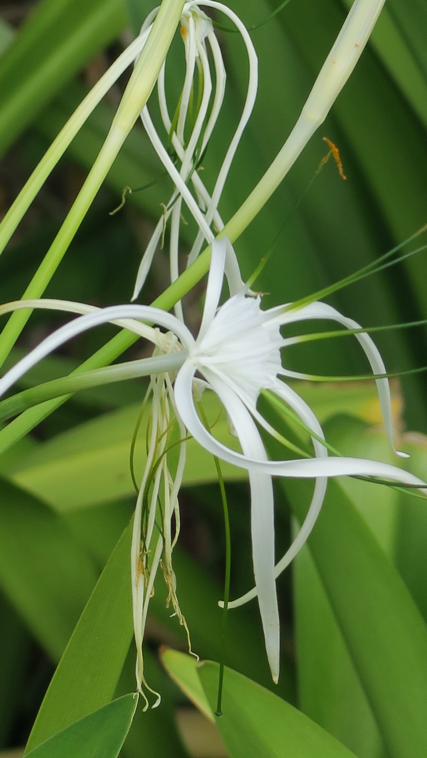
Beach Spider Lily (Hymenocalis latifolia (Miller) M. Roemer)
Bahia Honda State Park does an excellent job of labeling their plants for the tourists. I owe my identification to the botanist who worked with the park on this. There are 15 species of Hymenocalis in the Flora of North America188 and I would be out of luck with just a photo for identification. However, when I read the description in the Flora, it matches.
Zephyranthes atamasca (Linnaeus) Herbert
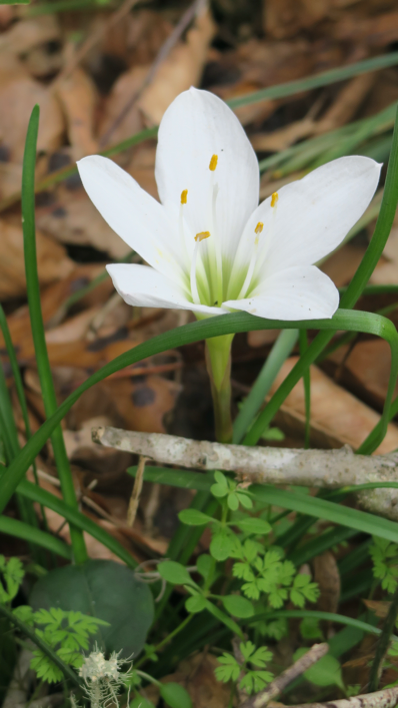
Atamasco Lily (Zephyranthes atamasca (Linnaeus) Herbert)
I was touring the panhandle of Floria for a couple of state parks. I had been to Falling Waters State Park near Chipley, Florida and decided to take a short trip to Florida Caverns State Park near Marianna, Florida.
I decided to do the cave tour (worth it) and was killing time before the tour started and decided to walk their trail behind the caverns. It was a little early for anything to be out but this is a very early bloomer.
Generally, it’s a white flower but it can have tinges of pink to it.
Hyacinthoides hispanica (Miller) Rothmaler
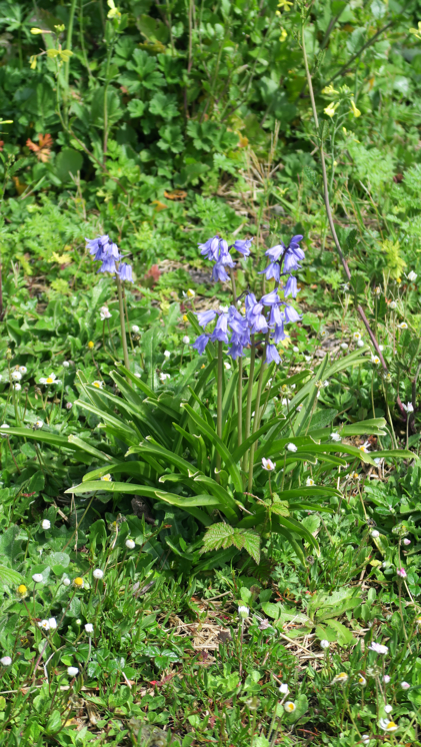
Spanish Bluebells (Hyacinthoides hispanica (Miller) Rothmaler)
This is an escapee from gardens189 but an attractive escapee none-the-less.
I first saw these at Elk Meadow but wasn’t able to focus in on them because of the fogging of my lens. Later, I found them at Point St. George near Crescent City, California and by that time, my lens had defogged.
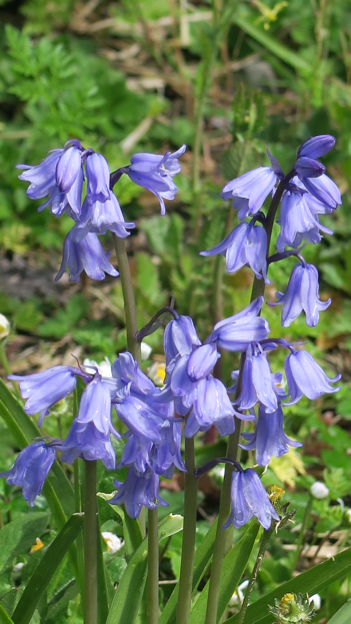
Spanish Bluebells (Hyacinthoides hispanica (Miller) Rothmaler)
My best memories of hyacinths is grape hyacinth, Muscari botryoides (previously Hyacinthus botryoides). These grew in the yards of houses which lined University Avenue at Oxford, Mississippi. The aroma of the flowers were intoxicating and I’ve always had a thing for hyacinths ever since.
One house along University Avenue, in particular, had these in their yard along with a koi pond. As I walked by that house (numerous times in the spring) you could smell the hyacinths as you walked past.
Ornithogalum umbellatum Linnaeus
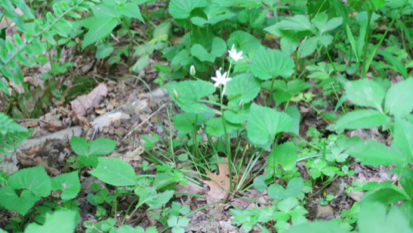 Star-of-Bethlehem (Ornithogalum umbellatum Linnaeus)
Star-of-Bethlehem (Ornithogalum umbellatum Linnaeus)
The genus is primarily a South African and Mediterranean one which has become introduced into North America.190 It’s also poisonous. In particular, O. umbellatum is reported by Flora of North America to contain convallotoxin and convalloside, two glycosides similar to digitalis. The bulbs and flowers have the largest concentrations.191

Star-of-Bethlehem (Ornithogalum umbellatum Linnaeus)
The flowers are quite delicate and close on cloudy days or at night.192
Dichelostemma capitatum (Bentham) Alph. Wood
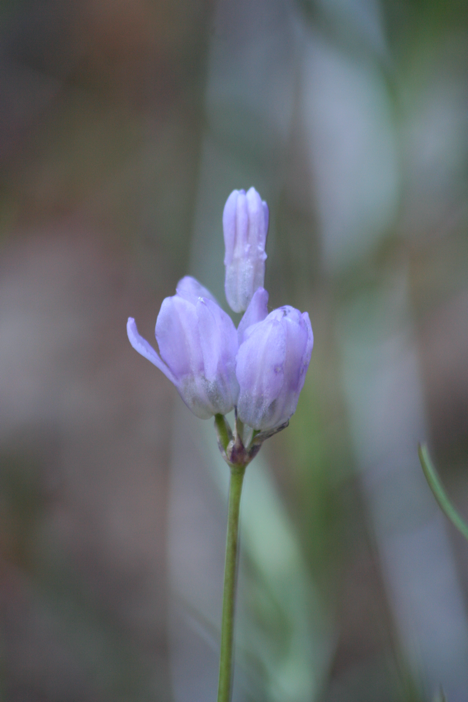 Bluedicks (Dichelostemma capitatum (Bentham) Alph. Wood)
Bluedicks (Dichelostemma capitatum (Bentham) Alph. Wood)
No, I don’t know why they are called bluedicks and apparently no one else does. The Lady Bird Johnson Wildflower Center has an “Ask Mr. Smarty Plants” page and they think it may have something to do with the gold rush miners and their dirty minds.

Bluedicks (Dichelostemma capitatum (Bentham) Alph. Wood)
The flowers are certainly attractive. I found them a lot in my western travels.
Species/Location
Aletris lutea
Loop Road, Old Tamiami Trail, Big Cypress Preserve
Veratrum viride var. eschscholzianum
Crater Lake National Park
Dead Elk Lake, The Bugaboos, British Columbia
Silver Basin near Frenchman Mountain, The Bugaboos, British Columbia
Veratrum viride var. viride
Linn Cove Viaduct, Blue Ridge Parkway, Banner Elk, North Carolina
Lewis Spring Falls Trail, Shenandoah National Park
Zigadeneus venenosus
Lakeshore Trail, Stehenkin, Washington
Cross Fissures, Black Canyon of the Gunnison
Zigadeneus fremontii
The Balcones Trail, Pinnacles National Park
Amianthium muscitoxicum
Roadside, Blue Ridge Parkway, North Carolina
Lewis Spring Falls Trail, Shenandoah National Park
Trillium catesbaei
Wolfden Loop Trail, F.D. Roosevelt State Park, Warm Springs, Georgia
Trillium erectum var. album
Smokemont Loop Trail, Great Smoky Mountains National Park
Trillium grandiflorum
Roadside Michigan Highway 26, Toivola, Michigan
Trillium ovatum
Jedediah Smith Redwoods State Park, Crescent City, California
Trillium rivale
Jedediah Smith Redwoods State Park, Crescent City, California
Calochortus gunnisonii
Devil’s Tower National Monument
Prosartes hookeri
Lakeshore Trail, Stehekin, Washington
Prosartes lanuginosa
Smokemont Loop Trail, Great Smoky Mountains National Park
Prosartes smithii
Del Norte Coast Redwoods State Park, Crescent City, California
Prosartes trachycarpa
Oak Flat Trail, Black Canyon of the Gunnison National Park
Streptopus amplexifolius
Emerald Lake, Yoho National Park, British Columbia
Uvularia sessilifolia
Beaver Pond Overlook, Voyageurs National Park
Smokemont Loop Trail, Great Smoky Mountains National Park
Medeola virginiana
Deep Creek Trail, Great Smoky Mountains National Park
Crabtree Falls Trail, Blue Ridge Parkway, North Carolina
Clintonia andrewsiana
Muir Woods National Monument
Clintonia umbellata
Crabtree Falls, Blue Ridge Parkway, Barnardsville, North Carolina
Smokemont Loop Trail, Great Smoky Mountains National Park
Erythronium grandiflorum
Silver Basin near Frenchman Mountain, The Bugaboos, British Columbia
Mount Rainier National Park
Agnes Gorge Trail, North Cascades National Park
Erythronium americanum
Roadside of MI 26, Toivola, Michigan
Fritillaria affinis
Lakeshore Trail, Stehekin, Washington
Hypoxis hirsuta
Wolfden Loop Trail, F.D. Roosevelt State Park, Warm Springs, Georgia
Deep Creek Trail, Great Smoky Mountains National Park
Smokemont Loop Trail, Great Smoky Mountains National Park
Hypoxis wrightii
Myakka Hiking Trail, Myakka River State Park, Sarasota, Florida
Maianthemum canadense
Smokemont Loop Trail, Great Smoky Mountains National Park
Maianthemum dilatatum
Yurok Loop Trail, Klamath, California
Maianthemum racemosum subsp. amplexicaule
North Kaibab Trail, Grand Canyon National Park, North Rim
Plaikni Falls Trail, Crater Lake National Park
Maianthemum racemosum subsp. racemosum
Deep Creek Trail, Great Smoky Mountains National Park
Brandywine Falls, Cuyahoga Valley National Park
Smokemont Loop Trail, Great Smoky Mountains National Park
Maianthemum stellatum
Boicourt Trail, Theodore Roosevelt National Park, South Unit
Ridgeline Trail, Ridgeline Trail, South Unit
Caprock Coulee Trail, Theodore Roosevelt National Park, North Unit
Maianthemum trifolium
Thunder Hole, Acadia National Park
Polygonatum biflorum
Deep Creek Trail, Great Smoky Mountains National Park
Brandywine Falls, Cuyahoga Valley National Park
Lewis Spring Falls Trail, Shenandoah National Park
Smokemont Loop Trail, Great Smoky Mountains National Park
Allium schoenoprasum
Upper Geyser Basin, Yellowstone National Park
Allium textile
Ridgeline Trail, Theodore Roosevelt National Park, South Unit
Caprock Coulee Trail, Theodore Roosevelt National Park, North Unit
Allium brevistylum
Upper Geyser Basin, Yellowstone National Park
Lower Falls of the Yellowstone, Yellowstone National Park
Allium triquetrum
Elk Meadow, Redwoods National Park
Point St. George, Crescent City, California
Nothoscordum bivalve
Lake Mineral Wells State Park, Mineral Wells, Texas
Enchanted Rock State Natural Area, Fredericksburg, Texas
Crinum americanum
Roadside of FL29 near Immokalee, Florida
Hymenocalis latifolia
Bahia Honda State Park, Big Pine Key, Florida
Zephyranthes atamasca
Florida Caverns State Park, Marianna, Florida
Hyacinthoides hispanica
Elk Meadow, Redwoods National Park
Point St. George, Crescent City, California
Dichelostemma capitatum
Along Zion Canyon Scenic Drive near Temple of Sinawava, Zion National Park
The Balcones Trail, Pinnacles National Park
Chapter 15
Iridaceae
The iris family is represented by 16 genera and 92 species in Flora of North America.193 I’ve managed to photograph three genera and six species. Two of those genera I think very special: Sisyrinchium and Iris.
Sisyrinchium angustifolium Miller
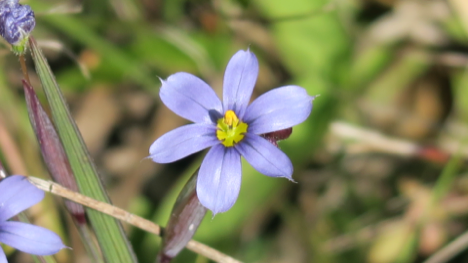
Blue-eyed Grass (Sisyrinchium angustifolium Miller)
This is a very common species in the eastern U.S.194 and probably the one I most come across. The leaves are very much grass-like but are mostly basal with a few stem leaves. The flower is quite striking and quite obvious even though the plant is grass-like.
Sisyrinchium montanum Greene
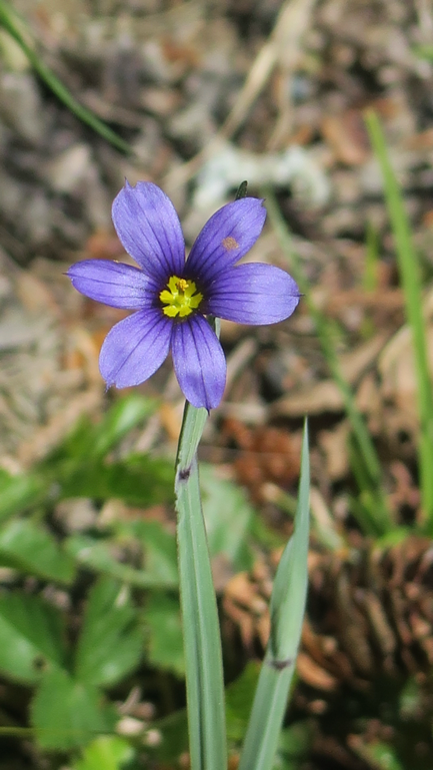
Common Blue-eyed Grass (Sisyrinchium montanum Greene)
This is amazingly like S. angustifolium and Flora of North America points out the similarities and how they are often confused.195 In my case, I based it on where I photographed the plant - in the northern U.S. where the range is reputed to be.196
I photographed this species in two places: Theodore Roosevelt National Park and Acadia National Park.
Sisyrinchium idahoense E.P. Bicknell
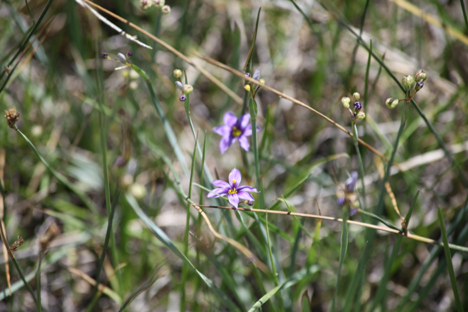
Idaho Blue-eyed Grass (Sisyrinchium idahoense E.P. Bicknell)
This was growing in the Upper Geyser Basin of Yellowstone National Park - not the best environment for plants or animals considering the hot springs beneath the fragile soil.
I’m always amazed at how many people insist on leaving the walkways and venturing out on the delicate crust of the basin. I’m even more amazed at the number of people they have who walk up to Old Faithful and look down into the hole. Fortunately, those are caught on camera and are often arrested and banned from the park.
Iris cristata Solander ex Aiton
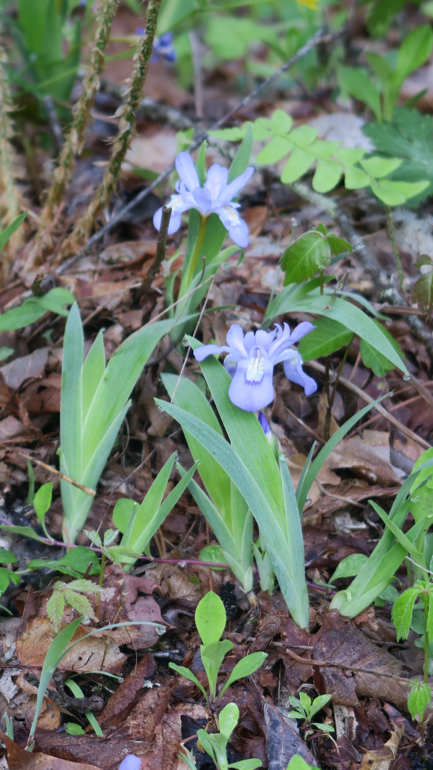
Dwarf Crested Iris (Iris cristata Solander ex Aiton)
My first memory of this plant was a hiking trip with fellow graduate students to the Ouachita Mountains of Arkansas. We were really frustrated with the hike because whoever had laid out the trail had us walk up one mountain and down another and up another instead of climbing one, following the ridge, and then descending. We kept muttering how we were going to go find the person responsible and commit murder.
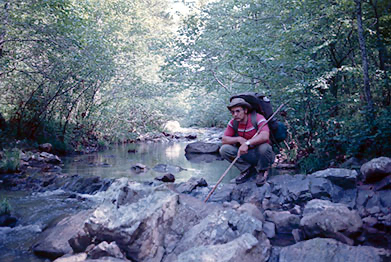
My Hiking Buddy Charlie at Cedar Creek in the Ouachitas
Anyway, on one of the down trips, we crossed over a small stream and we found three or four of these in bloom.
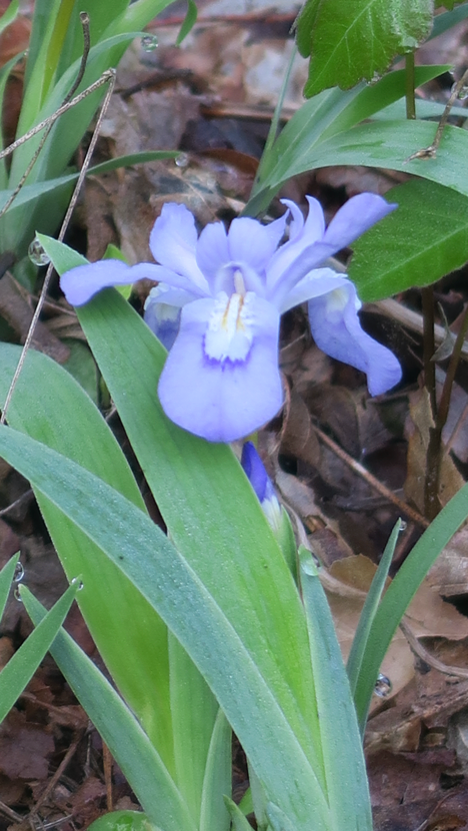 Dwarf Crested Iris (Iris cristata Solander ex Aiton)
Dwarf Crested Iris (Iris cristata Solander ex Aiton)
The common name comes from the raised portion on the midline of the petal. Normally, when I find these, I only find one or two, sometimes three in a group. My last hiking experience blew me away when I found hold beds of the stuff growing along a moist hillside.
 Dwarf Crested Iris (Iris cristata Solander ex Aiton) on Clear Creek Trail, South Mountains State Park in North Carolina.
Dwarf Crested Iris (Iris cristata Solander ex Aiton) on Clear Creek Trail, South Mountains State Park in North Carolina.
There are 34 species of Iris listed in Flora of North America!197
Iris verna Linnaeus
 Spring Dwarf Iris (Iris verna Linnaeus)
Spring Dwarf Iris (Iris verna Linnaeus)
I was in Asheville, North Carolina visiting an old friend Reed, his wife, his mother-in-law and their two twins when he suggested a hike in the Dupont State Forest outside Asheville. He knew I liked waterfalls and we hiked to Triple Falls and High Falls. Leaving Triple Falls and heading to High Falls, I saw this sticking its head up. It was early April in 2016.

Triple Falls (There’s One Below These Two) - Dupont State Forest, Asheville, North Carolina
I had only seen I. cristata and I immediately knew this was not I. cristata. I later found it in a wildflower guide and identified it as I. verna. It’s an appropriate specific epithet n’est-ce pas?
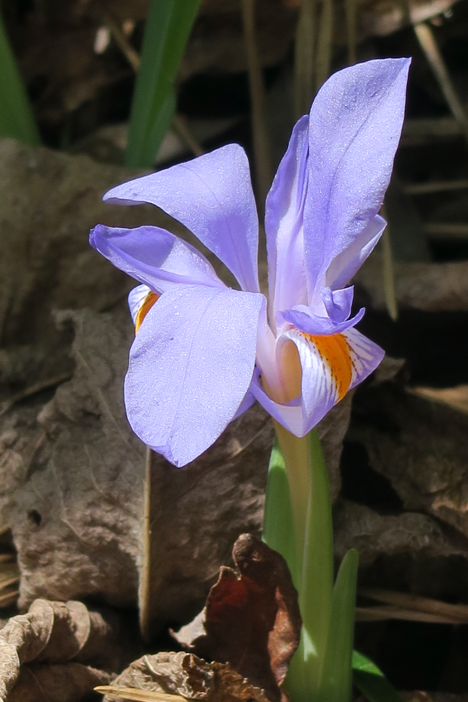 Spring Dwarf Iris (Iris verna Linnaeus)
Spring Dwarf Iris (Iris verna Linnaeus)
If you look at the petals, they have an orange stripe down the midline but there is no crest.
Crocosima x crocosimiiflora (Lemoine) N.E. Brown
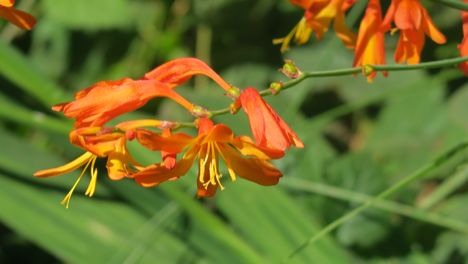 Monbretia (Crocosima x crocosimiiflora (Lemoine) N.E. Brown)
Monbretia (Crocosima x crocosimiiflora (Lemoine) N.E. Brown)
I was hiking a trail to Glen Camp in Point Reyes National Seashore when this jumped out at me. I had no idea as to what it was but I figured it was not native. That later proved to be true. It’s native to sub-Saharan Africa and Madagascar.198
For some reason, one of the local wildflower guides had it and I was able to identify it. You have to admit - it is a stunner.
Species/Location
Sisyrinchium angustifolium
F.D. Roosevelt State Park, Warm Springs, Georgia
David Allen Broussard Catfish Creek Preserve State Park, Haines City, Florida
Manatee Springs State Park, Chiefland, Florida
Deep Creek Trail, Great Smoky Mountains National Park
Sisyrinchium montanum
Caprock Coulee Trail, Theodore Roosevelt National Park, North Unit
Ship Harbor, Acadia National Park
Sisyrinchium idahoense
Upper Geyser Basin, Yellowstone National Park
Iris cristata
Deep Creek Trail, Great Smoky Mountains National Park
Smokemont Loop Trail, Great Smoky Mountains National Park
Clear Creek Trail, South Mountains State Park, Connelly Springs, North Carolina
Iris verna
Dupont State Forest, Asheville, North Carolina
Crocosima x crocosmiifolia
Glen Camp Trail, Point Reyes National Seashore
Chapter 16
Agavaceae
Can you say tequila? It comes from the blue agave (Agave azul) of Mexico (Wikipedia). This family of plants is often referred to as century plants because it takes a very long time for them to mature enough to produce a bloom (not really a century).
There are nine genera and 84 species listed in the Flora199 and the two genera most people are familiar with are Agave and Yucca.
I’ve been around Yucca for most of my life. As a kid in third grade, we lived in a house about two blocks from school. In the side yard was a huge growth of yucca or Spanish bayonet. We made use of the bayonet part of the plant. We would cut off a leaf and sword fight with them. Those points on the ends of the leaf were wicked. I got my share of puncture wounds from them. You could also make a slashing blow with them and they were sharp enough to cut. The mass of yucca was so large we actually had a “hideout” inside the cluster.
In Boy Scouts, we were taught that you could harvest the dried flower stalk of the yucca and use it with a small hand bow to make fire by friction. Only later when I was in college when I went to a scout-craft training session did I actually get the opportunity to try it and you really can start a fire by friction using yucca without too much effort.
We were also taught that yucca flowers could be added to any cooking batter to extend the batter. Also, if you break the point of the leaf of just right, you can pull a fiber still attached to the point and use it as sewing thread and needle.
Yucca brevifolia Engelmann in S. Watson
 Joshua Tree (Yucca brevifolia Engelmann in S. Watson)
Joshua Tree (Yucca brevifolia Engelmann in S. Watson)
There are 28 species of Yucca listed in Flora of North America200 and probably none is more famous than the Joshua tree. Wikipedia reports they are fast growers for the first 10 years and then only about 3.8 cm per year after that. They may have a life expectancy of hundreds of years and some have reportedly lived a thousand years.
These are plants of the Mojave (Mohave) desert and one of the largest concentrations is in Joshua Tree National Park.
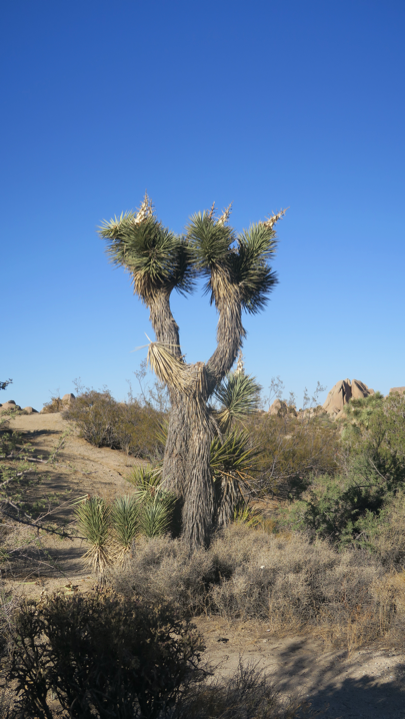
Joshua Tree (Yucca brevifolia Engelmann in S. Watson)
Where I camped in Joshua Tree (Jumbo Rocks campground) they were not terribly abundant.
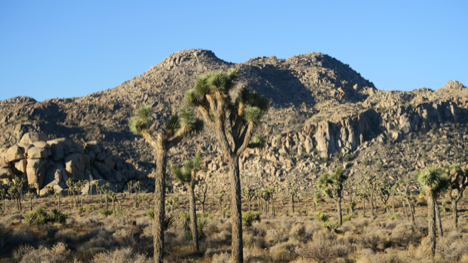 Joshua Tree (Yucca brevifolia Engelmann in S. Watson)
Joshua Tree (Yucca brevifolia Engelmann in S. Watson)
However, as I drove out of the park, they were all over the place.
Sadly, the last government shutdown which affected national parks, rangers reported campers got so rowdy they pushed over several Joshua trees in the park.
Yucca schidigera Roezl ex Ortgies
 Mojave Yucca (Yucca schidigera Roezl ex Ortgies)
Mojave Yucca (Yucca schidigera Roezl ex Ortgies)
With 27 species, the delineation among species can be difficult to make and the only reason I know this species was the interpretive sign next to it. This was along the Skull Rock Trail next to Jumbo Rocks campground at Joshua Tree.
A word about the spelling of Mojave. You’ll also see it spelled Mohave. The Mojave Desert Heritage & Cultural Association states consistency is the key but either is acceptable. However, the county in Arizona is spelled Mohave. The MDHCA refers to the Mojave Road Guide which says “everything on the California side of the Colorado River” is Mojave, otherwise it is Mohave.
Yucca harrimaniae Trelease

Harriman’s Yucca (Yucca harrimaniae Trelease)
To me, this is a beautiful plant. The purple tepals may have a purple tinge to them and the flowers hang down when open. This was photographed during another Tauck “Dawn Patrol,” this time at The Windows at Arches National Park.
Yucca glauca Nuttall

Great Plains Yucca (Yucca glauca Nuttall)
Flora of North America reports this as the most extensively distributed yucca in North America.201 I first encountered this at Devil’s Tower National Monument in July of 2013 and then later at Great Sand Dunes National Park in May of 2018.

Great Plains Yucca (Yucca glauca Nuttall)
The seed pods on these are much larger than the species I was used to in Mississippi and Florida.
Agave utahensis Engelmann in S. Watson
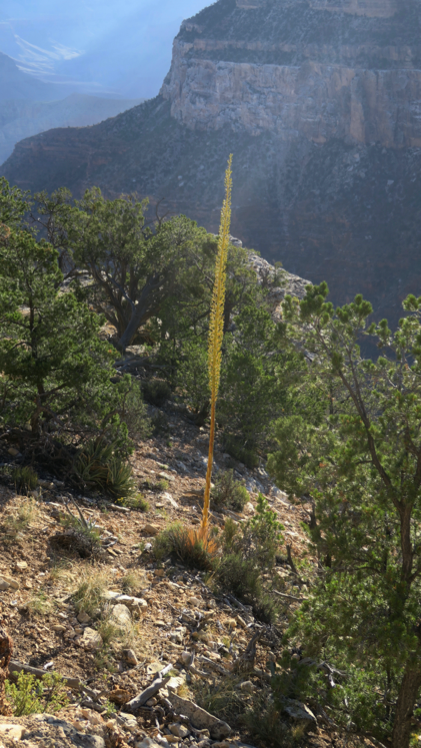
Century Plant, Utah Agave (Agave utahensis Engelmann in S. Watson)
My only encounter with these has been at the Grand Canyon, South Rim. They are impressive plants. Flora lists 27 species of Agave in North America202 and to make life difficult, there are two subspecies of A. utahensis and for one subspecies, A. utahensis subsp. utahensis, there are three varieties.203
I think you can agree it looks great against the background of the canyon.
 Century Plant, Utah Agave (Agave utahensis Engelmann in S. Watson)
Century Plant, Utah Agave (Agave utahensis Engelmann in S. Watson)
This is a very large plant. The problem is getting the entire plant in the frame. Close ups are not a problem. There are an unreal number of capsules on the stalk.
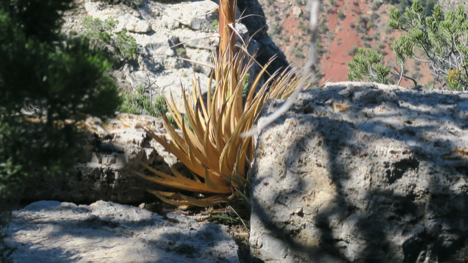 Century Plant, Utah Agave (Agave utahensis Engelmann in S. Watson)
Century Plant, Utah Agave (Agave utahensis Engelmann in S. Watson)
For such a large plant, the basal rosette of leaves is quite small. However, they are succulent and probably store a large amount of water.
Species/Location
Yucca brevifolia
Joshua Tree National Park
Yucca schidigera
Jumbo Rocks Trail, Joshua Tree National Park
Yucca harrimaniae
The Windows, Arches National Park
Yucca glauca
Devil’s Tower National Monument
Nature Trail, Great Sand Dunes National Park
Agave utahensis
South Rim Trail, Grand Canyon National Park
Chapter 17
Smilacaceae
This is the catbrier family of plants with a single genus, Smilax, in the family and 20 species.204 During my Tishomingo days, I collected five species of this genus: S. bona-nox, S. glauca, S. herbacea, S. rotundifolia and S. smallii.205
It’s not a particularly difficult genus to identify down to species, but I just never think about photographing it when I see it.
As far as I know, the tender young shoots of all Smilax are edible and make a great “wild” salad. However, it’s called catbrier for a reason since many species have prickles that can remind you of the common name.
Smilax laurifolia Linnaeus
 Catbrier (Smilax laurifolia Linnaeus)
Catbrier (Smilax laurifolia Linnaeus)
The one species I decided to photograph also happened to have flowers. It’s so seldom I find them in bloom I decided to make the most of it. There are six tepals as with most plants closely related to the lily family.
The term laurifolia comes from the shape of the leaves which apparently reminded Linnaeus of laurel leaves.
 Catbrier (Smilax laurifolia Linnaeus)
Catbrier (Smilax laurifolia Linnaeus)
This was photographed at Archbold Biological Station near Venus, Florida in April of 2016.
Species/Location
Smilax laurifolia
Archbold Biological Station, Venus, Florida
Chapter 18
Dioscoreaceae
Yam or sweet potato? Sweet potatoes belong to the genus Ipomoea in the family Convolvulaceae. Yams belong to the genus Dioscrea in the family Dioscoreaceae. To most grocery shoppers, there is no real difference. However, if you were to place a real yam (Dioscorea) next to a real sweet potato (Ipomoea) the yam’s “skin” would look a little like tree bark and brownish. The sweet potato would have a reddish “skin”.
The most widely distributed species is Dioscorea villosa which is found in most of the eastern U.S.206 Of the six species, only D. floridana and D. polystachya are found in a state other than Florida.207
Dioscorea villosa Linnaeus
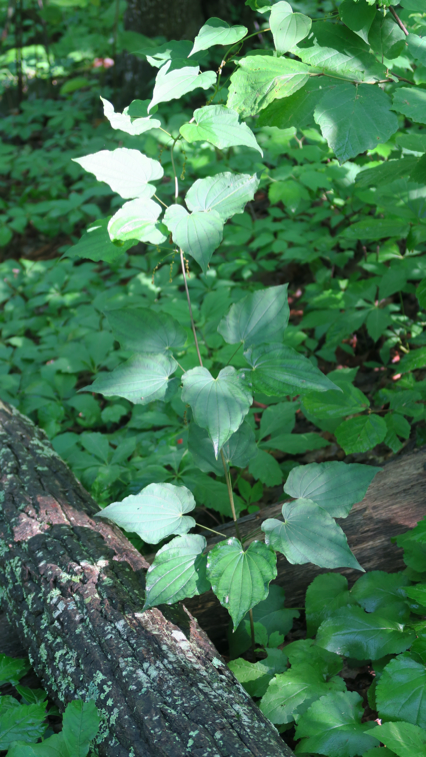
Wild Yam (Dioscorea villosa Linnaeus)
What stands out to me in this plant is the whorl of heart-shaped leaves on the climbing stem but only on the lower part of the stem. As you go up the stem, the leaves can be either opposite or alternate.
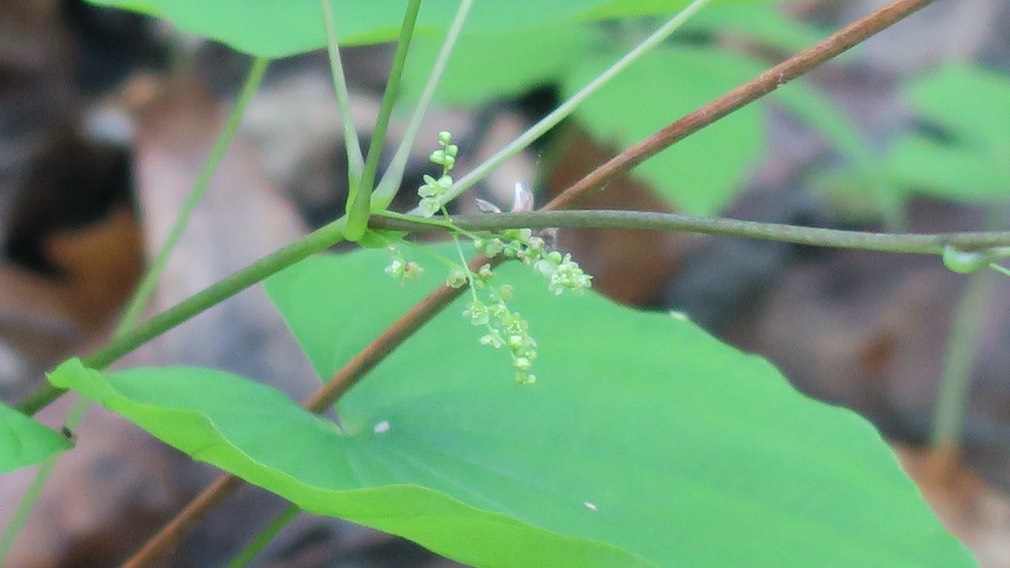
Wild Yam (Dioscorea villosa Linnaeus)
The flowers are very small and inconspicuous and you really have to hunt for them in the axils of the leaves to see them. They are almost translucent or even slightly green in color. And yes, you can eat the root of wild yams but I hope you don’t. Let them be and thrive in their natural environment.
Species/Location
Dioscorea villosa
Lewis Spring Falls Trail, Shenandoah National Park
Chapter 19
Orchidaceae
Of approximately 250,000 species of flowering plants (angiosperms) it is estimated that anywhere from 22,000 to 35,000 species are orchids.208 There are more orchid species than any other flowering plant on earth (the most abundant flowering plants are grasses - but not in number of species).
In Flora of North America, there are 70 genera and 208 species and they are most abundant in tropical regions.209 That makes Florida (and the southeast) prime territory for orchids.
I collected eight different species in Tishomingo in the 70‘s210 and have now photographed nine.
Volume 26 is the last volume of the Flora of North America that deals with flowering plants. Volumes 27 and 28 deal with the mosses (Bryophytes) and volume 29 will be a cumulative index. Since volume 26 is the last of the flowering plants, that means botanists think orchids are the most evolved of all plant species.
Cypripedium acaule Aiton

Pink Lady’s Slipper (Cypripedium acaule Aiton)
I can’t tell you how long I’ve searched for this genus of orchid. All through graduate school and ever since, I’ve tried to find one in the wild. It finally happened on the Wonderland Trail at Acadia National Park in May of 2018. What a thrill to check this off my species list!
This was a very dry, rocky habitat and I was not anticipating finding any orchids. I generally think of moist woods for orchids and at first, I thought I was seeing a bit of trash along the trailside. Only when I looked closer did my heart leap into my mouth.
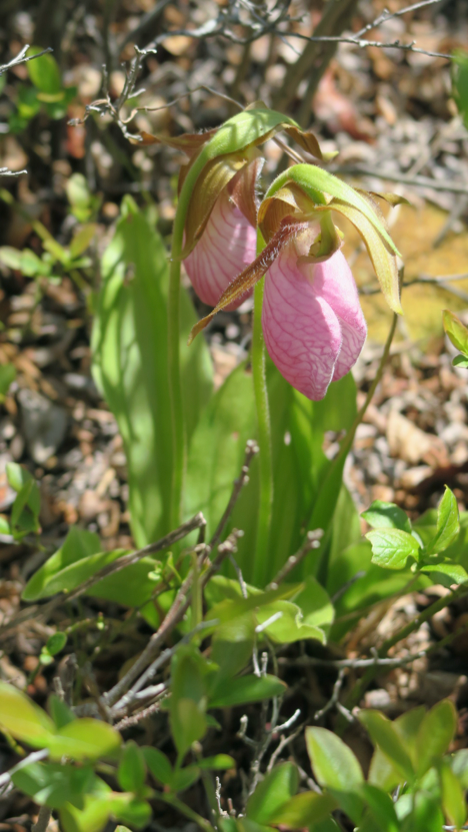
Pink Lady’s Slipper (Cypripedium acaule Aiton)

Pink Lady’s Slipper (Cypripedium acaule Aiton)
This is the rear of the orchid and you can see one green sepal and two brownish lateral ones. There are 12 species of Cypripedium in the Flora.211
Spiranthes romanzoffiana Chamisso
 Lady’s Tresses (Spiranthes romanzoffiana Chamisso)
Lady’s Tresses (Spiranthes romanzoffiana Chamisso)
I’ve probably seen more species of Spiranthes than any other orchid species and I still get a thrill when I stumble across them. This particular one was in the Upper Geyser Basin of Yellowstone when I photographed it in July of 2013.
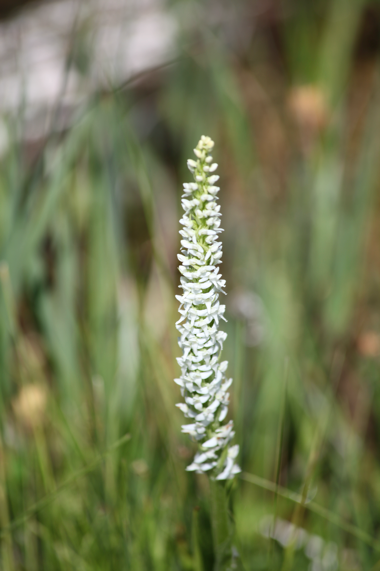
Lady’s Tresses (Spiranthes romanzoffiana Chamisso)
I had a difficult time getting a focal point. This was a very large Spiranthes, probably the largest I’ve run across.
Galearis spectabilis (Linnaeus) Rafinesque
 Showy Orchis (Galearis spectabilis (Linnaeus) Rafinesque)
Showy Orchis (Galearis spectabilis (Linnaeus) Rafinesque)
My last trip to the Smokeys was one of my best plant trips ever. Another orchid species that had eluded me showed up on this trip. I’ve seen this orchid numerous times on hikes but never in bloom. This was taken in April of 2019 and not only did I find one in bloom, I found about 30 of them all along the trail!
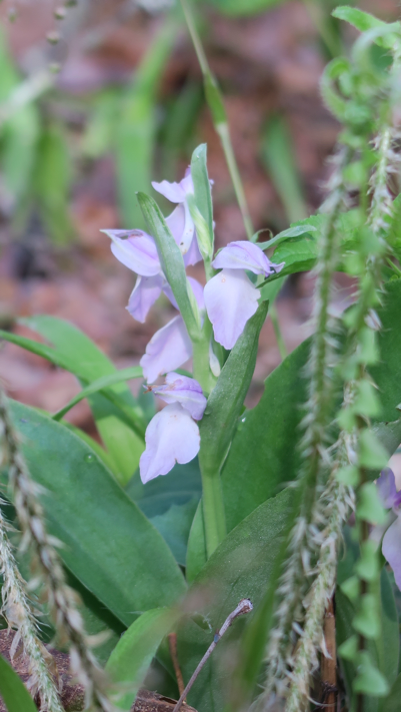
Showy Orchis (Galearis spectabilis (Linnaeus) Rafinesque)
It’s a very small orchid and one that is easily overlooked, even in bloom. I’m not so sure I would have named it “showy.”
Platanthera dilatata (Pursh) Lindley ex L.C. Beck
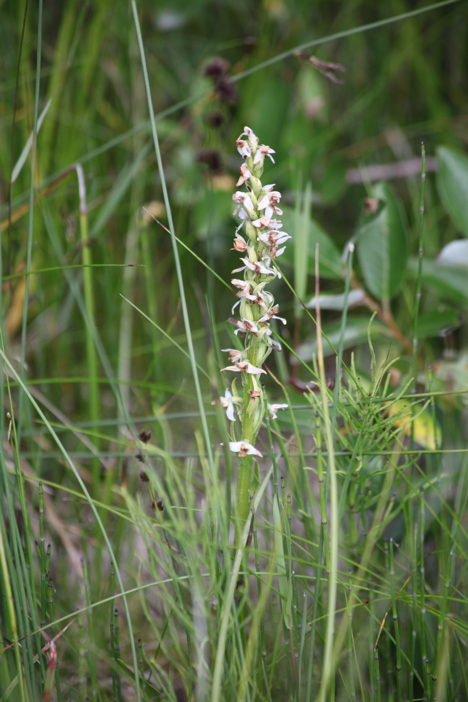 White Bog Orchid (Platanthera dilatata (Pursh) Lindley ex L.C. Beck)
White Bog Orchid (Platanthera dilatata (Pursh) Lindley ex L.C. Beck)
There are 32 species of Platanthera in the Flora and I had never encountered the species before until I began my cross country trips. There are species in the southeastern U.S. but I just never came across them.212
Bog is an appropriate description. Every time I knelt down for a photo, I came up with wet knees.
This was common along the lakeshore of Lake Louise in Alberta.
Platanthera stricta Lindley
 Slender Bog Orchid (Platanthera stricta Lindley)
Slender Bog Orchid (Platanthera stricta Lindley)
I can see why they called this “slender.” P. dilatata is certainly more robust and there are a lot more flowers on its stem. This is a more delicate version of the genus.
I found this growing on the Castle Crest Wildflower Trail at Crater Lake in June of 2015.
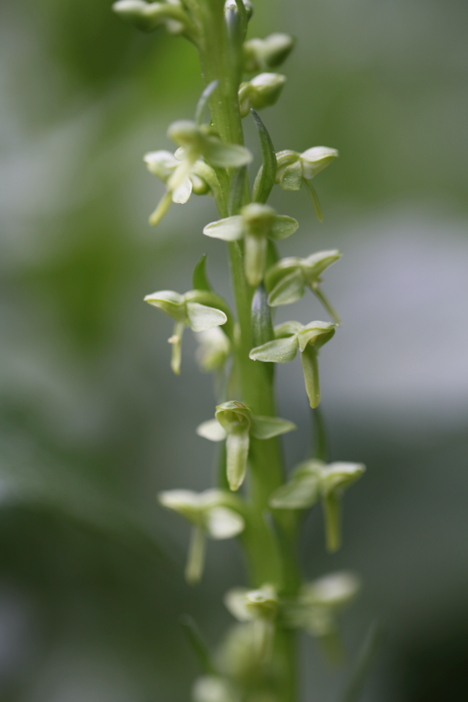 Slender Bog Orchid (Platanthera stricta Lindley)
Slender Bog Orchid (Platanthera stricta Lindley)
The flowers were so small, I had a hard time getting any of them in focus. However, you can see a little of the orchid shape in the individual flowers.
Platanthera psycodes (Linnaeus) Lindley
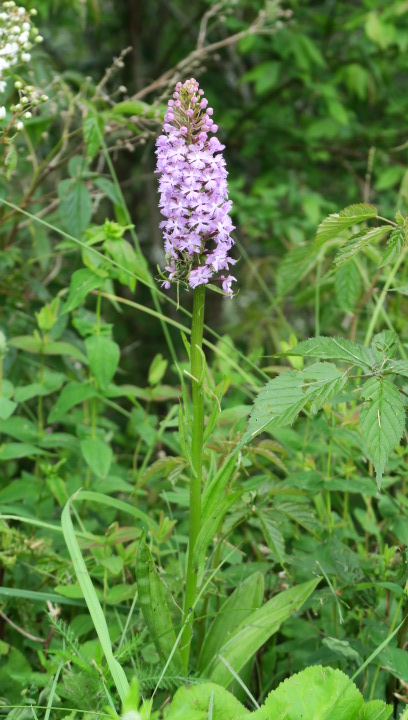
Small Purple-fringed Orchid (Platanthera pyscodes (Linnaeus) Lindley)
To be honest, there’s nothing small about this orchid. It’s about as subtle as a baseball bat (and about the same height). I kept seeing this purple thing out of the corner of my eye as I was driving to the top of Mount Mitchell.
On the way back down, I decided I had to stop and get a photograph - no easy task with cars right behind you. I found a safe spot and was able to get a couple of quick photos.
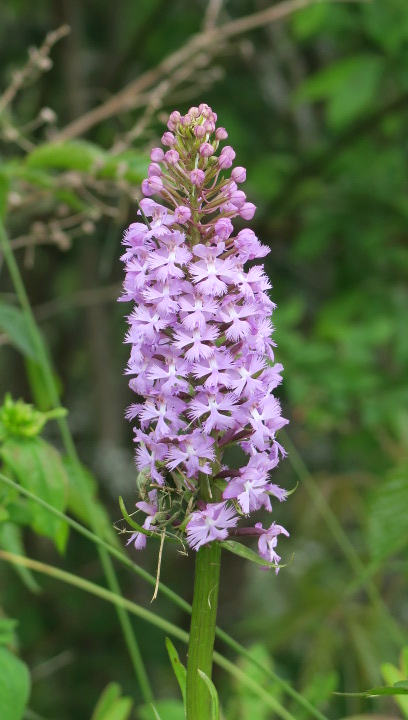
Small Purple-fringed Orchid (Platanthera pyscodes (Linnaeus) Lindley)
You can see why it’s called “fringed” orchid. The petals of the orchid are deeply divided.
Habenaria odontopetala Reichenbach f.
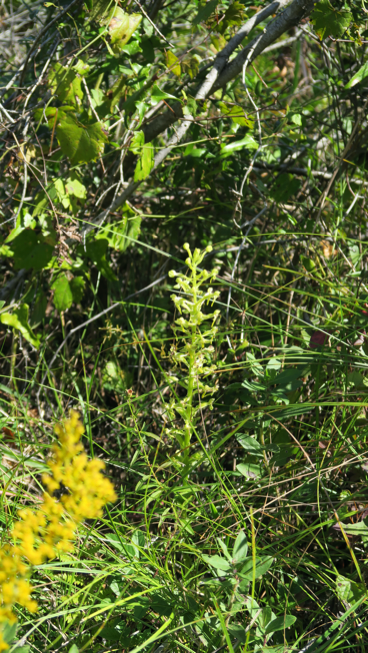
Toothpetal Orchid (Habenaria odontopetala Reichenbach f.)
During my Tishomingo days, I collected three species of Habenaria: H. clavellata, H. cristata, and H. flava.213 All of these were more showy than this species.
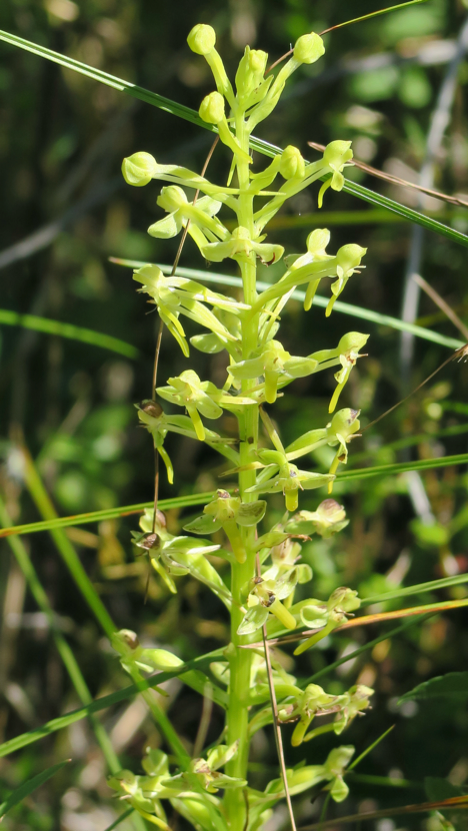 Toothpetal Orchid (Habenaria odontopetala Reichenbach f.)
Toothpetal Orchid (Habenaria odontopetala Reichenbach f.)
The Habenaria I collected were also very colorful - flowers were mostly purple or pink. This one is yellow-green. However, the delicate nature of the flowers makes it interesting. Notice the long spurs on the petals.
This species is restricted to Florida.214
This was photographed at Myaaka River State Park near Sarasota, Florida.
Aplectrum hyemale (Muhlenburg ex Willdenow) Nuttall

Putty Root (Aplectrum hyemale (Muhlenberg ex Willdenow) Nuttall)
There is only one species in North America and it is mostly found in the middle-eastern U.S.215
I almost didn’t see this - it blended in so well with the surroundings. It was also hard to get a photo of an open flower since they hang downward naturally.
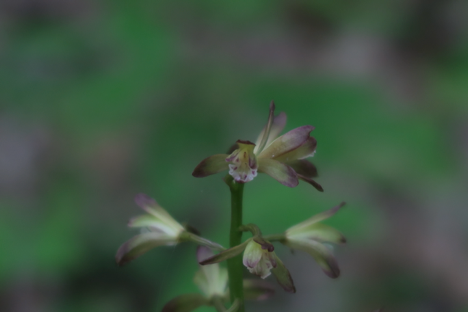
Putty Root (Aplectrum hyemale (Muhlenberg ex Willdenow) Nuttall)
You can just see some purple spots on the petal and the other petals tinged with purple.
This was on the Deep Creek Trail of the Smokies.
Corallorhiza mertensiana Bongard
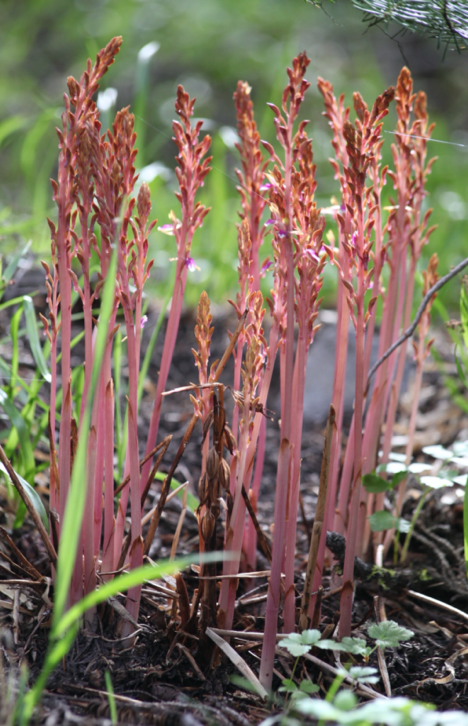 Western Coralroot (Coralorrhiza mertensiana Bongard)
Western Coralroot (Coralorrhiza mertensiana Bongard)
It’s hard to believe this is even an orchid. There were a few blooms on it but I wasn’t able to zoom in for a better view on this one. Over the years, I’ve run into Coralorrhiza several times, just not this species. The ones I generally find are bronze in color and blend in with the surroundings. This one stuck out like a sore thumb.
This was another Castle Crest Nature Trail find at Crater Lake.
Species/Location
Cypripedium acaule
Wonderland Trail, Acadia National Park
Spiranthes romanzoffiana
Upper Geyser Basin, Yellowstone National Park
Galearis spectabilis
Smokemont Loop Trail, Great Smoky Mountains National Park
Platanthera dilatata
Lake Louise, Yoho National Park, Alberta
Bugaboo Lodge, The Bugaboos, British Columbia
Platanthera stricta
Castle Crest Wildflower Trail, Crater Lake National Park
Platanthera psycodes
Mount Mitchell State Park, Burnsville, North Carolina
Habenaria odontopetala
Myakka Hiking Trail, Myakka River State Park, Sarasota, Florida
Aplectrum hyemale
Deep Creek Trail, Great Smoky Mountains National Park
Coralorrhiza mertensiana
Castle Crest Wildflower Trail, Crater Lake National Park
Chapter 20
References cited
1Flora of North America North of Mexico. Vol 19. 2006. Oxford University Press: New York. p. 3.
2Ibid. p. xx.
3Flora of North America North of Mexico. Vol 19. 2006. Oxford University Press: New York. p. 95.
4Ibid. p. 109.
5Ibid. pp. 109-110.
6Ibid. pp. 154-159.
7Ibid. p.189.
8Searcy, Jr. F.T. A Floristic Study of Tishomingo State Park. 1977. University of Mississippi: Oxford. p. 43.
9Flora of North America North of Mexico. Vol 19. 2006. Oxford University Press: New York. pp. 244-245.
10Ibid. p. 274.
11Ibid. p. 275.
12Ibid. pp. 278-294.
13Ibid. p. 305.
14Ibid. pp. 310-321.
15Ibid. pp. 326-334.
16Searcy, Jr. F.T. A Floristic Study of Tishomingo State Park. 1977. University of Mississippi: Oxford. p. 45.
17Ibid. p. 42.
18Flora of North America North of Mexico. Vol 19. 2006. Oxford University Press: New York. p. 389.
19Ibid. p. 406.
20Ibid. pp. 408-410.
21Ibid. p. 427.
22Ibid. p. 427.
23Searcy, Jr. F.T. A Floristic Study of Tishomingo State Park. 1977. University of Mississippi: Oxford. p. 45.
24Flora of North America North of Mexico. Vol 19. 2006. Oxford University Press: New York. p. 481.
25Ibid. p. 492.
26Ibid. p. 503.
27Ibid. p. 516.
28Ibid. p. 524.
29Ibid. p. 558.
30Flora of North America North of Mexico. Vol 20. 2006. Oxford University Press: New York. p. 23.
31Ibid. p. 24.
32Ibid. pp. 50-77.
33Ibid. p. 62.
34Ibid. pp. 87-88.
35Ajilvsgi G. 2003. Wildflowers of Texas. Shearer Publishing, Fredericksburg, Texas. p. 135.
36Gleason H.A. 1952. The New Britton and Brown Illustrated Flora of the Northeastern United States and Adjacent Canada. Hafner, New York. pp.440-467.
37Searcy, Jr. F.T. A Floristic Study of Tishomingo State Park. 1977. University of Mississippi: Oxford. p. 42.
38Flora of North America North of Mexico. Vol 20. 2006. Oxford University Press: New York. p. 20.
39Flora of North America North of Mexico. Vol 20. 2006. Oxford University Press: New York. p. 108.
40Searcy, Jr. F.T. A Floristic Study of Tishomingo State Park. 1977. University of Mississippi: Oxford. p. 46.
41Flora of North America North of Mexico. Vol 20. 2006. Oxford University Press: New York. p. 110.
42Ibid. p. 175.
43Ibid. p. 189.
44Ibid. pp. 206-209.
45Ibid. p. 208.
46Ibid. pp. 230-256.
47Ibid. pp. 249-254.
48Searcy, Jr. F.T. A Floristic Study of Tishomingo State Park. 1977. University of Mississippi: Oxford. p. 44.
49Flora of North America North of Mexico. Vol 20. 2006. Oxford University Press: New York. p. 257.
50Ibid. p. 289.
51Ibid. pp. 311-313.
52Ibid. pp. 256-348.
53Ibid. p. 320.
54Ibid. pp. 327-328.
55Ibid. pp. 327-328.
56Ibid. p. 329.
57Searcy, Jr. F.T. A Floristic Study of Tishomingo State Park. 1977. University of Mississippi: Oxford. p. 43.
58Flora of North America North of Mexico. Vol 20. 2006. Oxford University Press: New York. p. 343.
59Ibid. p. 398.
60Ibid. pp. 424-436.
61Ibid. pp. 488-489.
62Ibid. pp. 494-495.
63Searcy, Jr. F.T. A Floristic Study of Tishomingo State Park. 1977. University of Mississippi: Oxford. p. 45.
64Flora of North America North of Mexico. Vol 20. 2006. Oxford University Press: New York. p. 579.
65Ibid. p. 606.
66Ibid. pp. 606-607.
67Ibid. pp.622-625.
68Ibid. pp. 629-632.
69Ibid. pp. 635-640.
70Flora of North America North of Mexico. Vol 21. 2006. Oxford University Press: New York. p. 60.
71Searcy, Jr. F.T. A Floristic Study of Tishomingo State Park. 1977. University of Mississippi: Oxford. p. 45.
72Flora of North America North of Mexico. Vol 21. 2006. Oxford University Press: New York. pp. 44-60.
73Ibid. pp. 60-63.
74Ibid. pp. 72-74.
75Ibid. p. 85.
76Ibid. p. 89.
77Ibid. pp. 93-99.
78Searcy, Jr. F.T. A Floristic Study of Tishomingo State Park. 1977. University of Mississippi: Oxford. p. 46.
79Flora of North America North of Mexico. Vol 21. 2006. Oxford University Press: New York. pp. 113-114.
80Ibid. p. 119.
81Ibid. pp. 121-122.
82Ibid. p. 121.
83Ibid. p. 122.
84Ibid. 124-125.
85Ibid. 124-125.
86Ibid. p. 126.
87Searcy, Jr. F.T. A Floristic Study of Tishomingo State Park. 1977. University of Mississippi: Oxford. p. 43.
88Flora of North America North of Mexico. Vol 21. 2006. Oxford University Press: New York. p. 128.
89Ibid. p. 128-129.
90Ibid. p. 130.
91Ibid. p. 130.
92Ibid. p. 133.
93Ibid. p. 141.
94Searcy, Jr. F.T. A Floristic Study of Tishomingo State Park. 1977. University of Mississippi: Oxford. p. 44.
95Flora of North America North of Mexico. Vol 21. 2006. Oxford University Press: New York. p. 149.
96Ibid. pp. 178-179.
97Ibid. p. 187.
98Ibid. pp. 184, 186.
99Ibid. pp. 196-197.
100Ibid. p. 206.
101Ibid. p. 247.
102Ibid. pp. 262-269.
103Ibid. p. 267.
104Ibid. pp. 366-377.
105Ibid. p. 372.
106Ibid. pp. 372-373.
107Ibid. pp. 400-414.
108Ibid. pp. 405-406.
109Ibid. pp.451-453.
110Searcy, Jr. F.T. A Floristic Study of Tishomingo State Park. 1977. University of Mississippi: Oxford. pp. 43-44.
111Flora of North America North of Mexico. Vol 22. 2000. Oxford University Press: New York. pp. 462-474.95-
112Ibid. p. 465.
113Ibid. p. 480.
114Ibid. p. 479.
115Ibid. p. 495.
116Ibid. pp. 512-535.
117Ibid. p. 538.
118Ibid pp. 545-547.
119Ibid. p. 549.
120Share G and Sharpe W. 1959. 101 Wildflowers of Crater Lake National Park. University of Washington, Seattle. p. 30.
121Flora of North America North of Mexico. Vol 22. 2000. Oxford University Press: New York. pp. 95-123.
122Uhl NW and Dransfield J. 1987. Genera Palmarum: A Classification of Palms Based on the Work of Harold E. Moore, Jr. Allen Press: Lawrence, Kansas. flyleaf.
123Flora of North America North of Mexico. Vol 22. 2000. Oxford University Press: New York. pp. 108-109.
124Ibid. p. 128.
125Ibid. p. 170.
126Ibid. p. 173.
127Ibid. p. 186.
128Ibid. p. 192.
129Ibid. p. 192.
130Ibid. p. 198.
131Ibid. p. 211.
132Ibid. p. 212.
133Searcy, Jr. F.T. A Floristic Study of Tishomingo State Park. 1977. University of Mississippi: Oxford. pp. 20-21.
134Ibid. p. 21.
135Flora of North America North of Mexico. Vol 22. 2000. Oxford University Press: New York. pp. 286, 288.
136Ibid. p. 286.
137Ibid. pp. 292-293.
138Flora of North America North of Mexico. Vol 23. 2002. Oxford University Press: New York. p. 3.
139Searcy, Jr. F.T. A Floristic Study of Tishomingo State Park. 1977. University of Mississippi: Oxford. p. 19.
140Small, J K. 1972. Manual of the Southeastern Flora. Hafner: New York. pp. 173-174.
141Flora of North America North of Mexico. Vol 23. 2002. Oxford University Press: New York. p. 203.
142Ibid. p. 203.
143Flora of North America North of Mexico. Vol 24. 2007. Oxford University Press: New York. p. 4.
144Ibid. p. 4.
145Ibid. p. 226.
146Ibid. p. 245.
147Ibid. p. 250.
148Ibid. p. 279.
149Ibid. p. 614.
150Ibid. p. 670.
151Gleason H.A. 1952. The New Britton and Brown Illustrated Flora of the Northeastern United States and Adjacent Canada. Vol. 1. Hafner, New York. p.210.
152Flora of North America North of Mexico. Vol 25. 2003. Oxford University Press: New York. pp. 451-488.
153Ibid. p. 406.
154Ibid. pp. 649-664.
155Flora of North America North of Mexico. Vol 26. 2002. Oxford University Press: New York. p. 37.
156Ibid. pp. 37-41.
157Ibid. p. 40.
158Ibid. p. 50.
159Searcy, Jr. F.T. A Floristic Study of Tishomingo State Park. 1977. University of Mississippi: Oxford. pp. 21-22.
160Flora of North America North of Mexico. Vol 26. 2002. Oxford University Press: New York. pp. 64-66.
161Ibid. pp. 74-75.
162Ibid. p. 90.
163Searcy, Jr. F.T. A Floristic Study of Tishomingo State Park. 1977. University of Mississippi: Oxford. p. 21.
164Flora of North America North of Mexico. Vol 26. 2002. Oxford University Press: New York. p. 91.
165Ibid. p. 98.
166Ibid. pp. 102-103.
167Ibid. pp. 119-141
168Ibid. p. 142.
169Ibid pp. 142-145.
170Ibid. p. 143.
171Ibid. p. 144.
172Searcy, Jr. F.T. A Floristic Study of Tishomingo State Park. 1977. University of Mississippi: Oxford. p. 22.
173Flora of North America North of Mexico. Vol 26. 2002. Oxford University Press: New York. pp. 91-151.
174Ibid. pp. 153-164.
175Ibid. p. 204.
176Ibid. pp. 206-210.
177Ibid pp. 208-209.
178Ibid. p. 209.
179Ibid pp. 209-210.
180Ibid. pp. 210-212.
181Ibid. pp. 217-218.
182Ibid. p. 225.
183Ibid. p. 246.
184Ibid. p. 246.
185Ibid. pp. 257-258.
186Ibid. pp. 278-279.
187Ibid. pp. 278-279.
188Ibid. p. 283.
189Ibid. p. 316.
190Ibid p. 318.
191Ibid. p. 319.
192Ibid. p. 319.
193Ibid. p. 348.
194Ibid. p. 361.
195Ibid. p. 366.
196Ibid. p. 366.
197Ibid. p. 372.
198Ibid. pp. 402-403.
199Ibid. p. 413.
200Ibid p. 424.
201Ibid. p. 437.
202Ibid. p. 442.
203Ibid. pp. 450-451.
204Ibid. p. 468.
205Searcy, Jr. F.T. A Floristic Study of Tishomingo State Park. 1977. University of Mississippi: Oxford. p. 21.
206Flora of North America North of Mexico. Vol 26. 2002. Oxford University Press: New York. p. 482.
207Ibid. pp. 480-485.
208Ibid. p. 491.
209Ibid. p. 491.
210Searcy, Jr. F.T. A Floristic Study of Tishomingo State Park. 1977. University of Mississippi: Oxford. p. 22.
211Flora of North America North of Mexico. Vol 26. 2002. Oxford University Press: New York. p. 499.
212Ibid. pp. 551-571.
213Searcy, Jr. F.T. A Floristic Study of Tishomingo State Park. 1977. University of Mississippi: Oxford. p. 22.
214Flora of North America North of Mexico. Vol 26. 2002. Oxford University Press: New York. p. 583.
215Ibid. p. 632.
